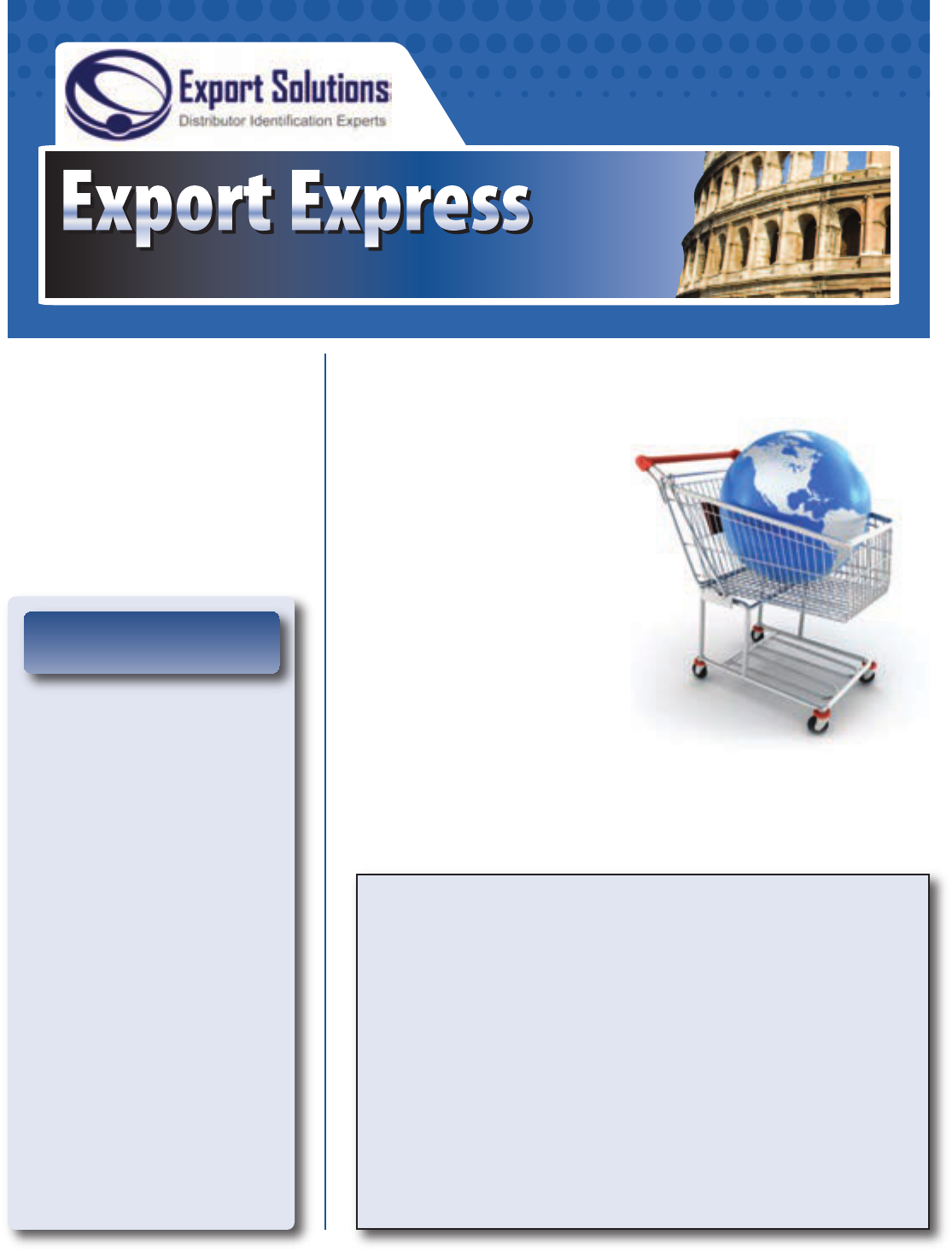
Insights to Accelerate International Expansion
Export Handbook
Our Mission: Help Manufacturers “Spend time Selling to Distributors versus Searching for Distributors”
Export is not easy. Demanding
retailers, overworked distributors,
and limited funds for marketing
investment create a tough
environment for international
development. Export Solutions goal
is to make life a little easier for
export managers.
This Export Handbook features the
most popular articles published in
our Export Express newsletter. More
than 400,000 industry professionals
have visited our web site to read our
strategies and suggestions for
building brands in overseas markets.
Inspiration for this Export Handbook
can be credited to the export manager
of a world famous brand. He stated
“It is important that Export Solutions
has compiled all the strategies and
techniques that we know about export,
but sometimes forget. Your articles
help refresh my memory plus provide
new ideas.” The industry’s future
growth will be determined by our
ability to expand beyond our home
markets. Export Solutions can help!
Greg’s Ten Tips
1. Good news travels fast and bad
news travels slowly
2. If you want to know what’s
really going on, spend a day
visiting stores
3. Pick up the phone and call a friend
or business partner versus email
4. Be positive. Think, “why not?”
5. Results are directly proportionate
to your investment: Marketing,
People, Focus, Time
6. A distributor (or Broker) “respects”
what the Brand owner “inspects”
7. Shipment numbers rarely lie
8. Put it in writing
9. If two people agree on the
principle of a deal, you can usually
work out the financial terms
10. There is more in common with
industry practices across the globe
than differences. Brand owners
everywhere desire more shelf
presence and retailers demand
more discounts. Recognize the
differences, but focus on the
universal requirement for superior
products, marketed at a fair price.
In This Issue
Sell to 96 Countries
Looking for new customers and
distributors in international markets?
Export Solutions’ distributor database
covers more than 9,200 distributors in
96 countries. Our database features
extensive coverage of leading food,
confectionery, and beverage distributors.
New! Export Solutions’ retailer database
now tracks 2,700 retailers in 96 countries.
Order now at www.exportsolutions.com.
Page 2
Making Babies Versus Babysitting
Page 15
A New Export Road Map
Page 17
The World in 2025
Page 29
Some BRIC’s are Broken
Page 33
Ten Tips –
Sourcing New Sales from Old Markets
Page 46
What Distributors Want to Know ?
Page 61
Ten Tips –
Increased Distributor Focus on Your Brands
Page 91
Ten Tips: Distributor Interview
Preparation and Insights
Page 100
What is the Plan?
Export Handbook –
Tips for International Success

2
I learned a lot in 2021 through projects completed in 31 countries on five
continents. One of the important issues revealed is human resource allocation in
the world of export. Our function appears anchored to the title of regional export
manager. This export manager is expected to achieve their assigned objectives
through a combination of managing existing businesses and expansion into new
countries. In many cases, there is one export manager assigned to handle a huge
geography like Asia or Latin America. My observation is that most export
managers dedicate the majority of their time “babysitting” existing businesses
that deliver their annual sales quota. This shortchanges time available to “making
babies,” the process of new market development.
Our feature article “The World in 2025” unveils a snapshot of the world in
10 years. Most exporters jam their annual plans with futuristic projections for dynamic
business potential of China, Brazil, or the USA (European Brands). How can we ever expect
to take these businesses to the next level with one person allocated per region, perhaps even
located in corporate headquarters, thousands of miles away from the “action?”
Listed below are Export Solutions ideas for “Making More Babies” in 2022.
1. Shift Team From Mature Markets to Developing Markets
Most companies feature sizable sales teams managing, large, mature businesses growing at
5 percent or less. Then, they’ll have one person managing Asia’s 4 billion people and one
person allocated to Latin America’s almost 600 million people. The result is usually tiny niche
businesses growing by high percentages, but miniscule in terms of scale. There is a delicate
balance, but in general the shifting of some head count from the base business to international
can pay out plus supply a meaningful new career opportunity for your team members.
2. Create New Country Development Role
This business incubation position could focus on business start-up in a small number of
priority countries. The person should have access to corporate functional resources and work
closely with the area export managers. I know several companies that use this model with
exceptional results.
3. Redefine Export Manager Work Allocation
Split workload to provide more time for Making Babies versus Babysitting. Don’t worry,
markets like Puerto Rico, Belgium, UAE,and Singapore will be fine if you spend more time
in Colombia, Poland, Saudi Arabia, and Indonesia.
4. David Against Goliath Won’t Work in Top 5 Countries
A one person team working with a distributor will not allow you to optimize your business
in enormous, complex countries like China, Mexico, or the USA (Europeans). Game changing
results can be obtained through a three-five year plan including local production, multi-
functional teams, regional activities, and serious investments in trade activities and marketing
support. Consider acquisition of a local brand in your core category.
5. Boots On the Ground
Brands with regional employees based in foreign countries are gaining more than their fair
share of distributor time and focus. These managers are closer to market conditions and
distributor sales teams than export managers based in distant USA or European headquarters.
Consider offices in Shanghai, Sao Paolo, Mexico City, Jakarta and Jeddah to make a difference.
Other choices include Singapore, Panama, and Dubai. USA managers are typically centrally
located in Chicago, Atlanta or Dallas, close to major customers and airports.
We are the “Brand Parents.” Making Babies and creating new businesses will provide a solid
home base for the future. Time is always required for babysitting and brand development in
existing markets. However, need to spend more time on activities to “expand the family.”
www.exportsolutions.com
“Spend Time Selling to Distributors versus Searching for Distributors”
Making Babies Versus Babysitting
Greg Seminara
gseminara@exportsolutions.com
404-255-8387
Strategic Services
Contact Us for
Export Solutions
1. Identify Best in Class
Distributors: 96 Countries
2. Best Practices
Export Strategy
3. Distributor Management
Workshops
4. Export 101:
Let’s Get Started
5. New Market
Prioritization
and Launch Plan
6. Personal Distributor
Introductions:
96 Countries
7. Walmart International
8. Distributor Contracts,
Margins, and Fees
9. Meeting Speaker
10. International
Strategy Expert
Strategic Services
Contact Us for
Export Solutions
1. Identify Best in Class
Distributors: 96 Countries
2. Best Practices
Export Strategy
3. Distributor Management
Workshops
4. Export 101:
Let’s Get Started
5. New Market
Prioritization
and Launch Plan
6. Personal Distributor
Introductions:
96 Countries
7. Walmart International
8. Distributor Contracts,
Margins, and Fees
9. Meeting Speaker
10. International
Strategy Expert
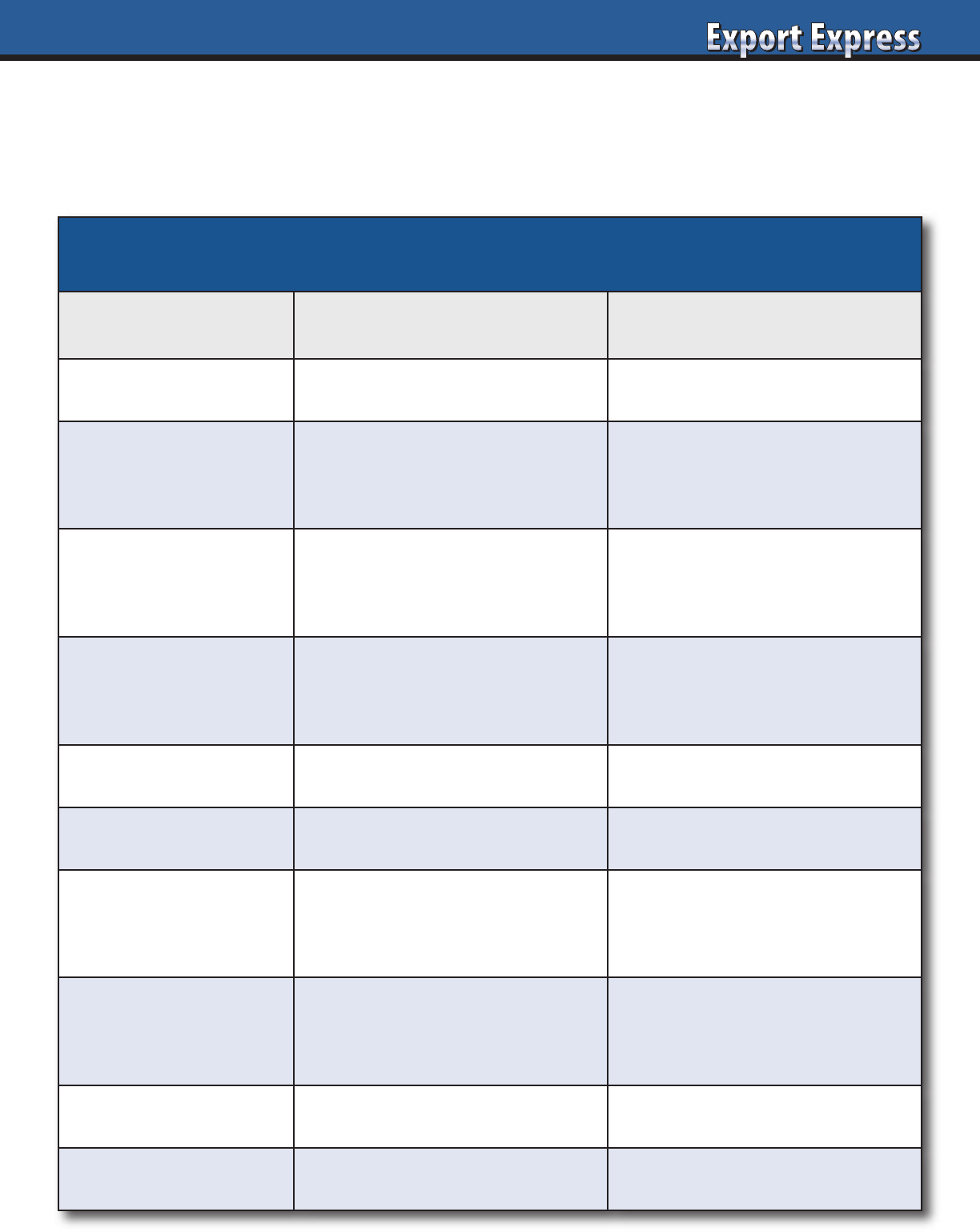
3
Retail buyers are challenged to maximize profits and sales from every available inch of shelf space. Every new item accepted must
improve on the performance of the brand currently occupying that space. Buyers are overwhelmed by new product offerings, all with
ambitious promises. Improve your chances of success by incorporating Export Solutions’ 10 point check list on how to excite your
category buyer about your new product.
How to Excite Buyers – New Product Checklist
Buyers: New Product Assessment
High Interest Low Interest
Category Opportunity Large or high growth Declining or niche
Brand Owner
Multinational or proven local.
Category expert
New foreign supplier
or start-up
Innovation
Something new, supported
by consumer research
“Me too” product
Profit Margin
Enhance current
category margin
Equal to or less than
current category margin
Sales Generates incremental sales Cannibalizes existing sales
Marketing Investment Sampling, social media, PR None
Trade Programs Invests in retailer “push” programs Periodic discounts/rebates
Brand Track Record Successful at other local retailers Unproven in the country
Terms/Conditions Attractive deal structure Typical terms/conditions
Representation Dependable local distributor Small, niche entrepreneur
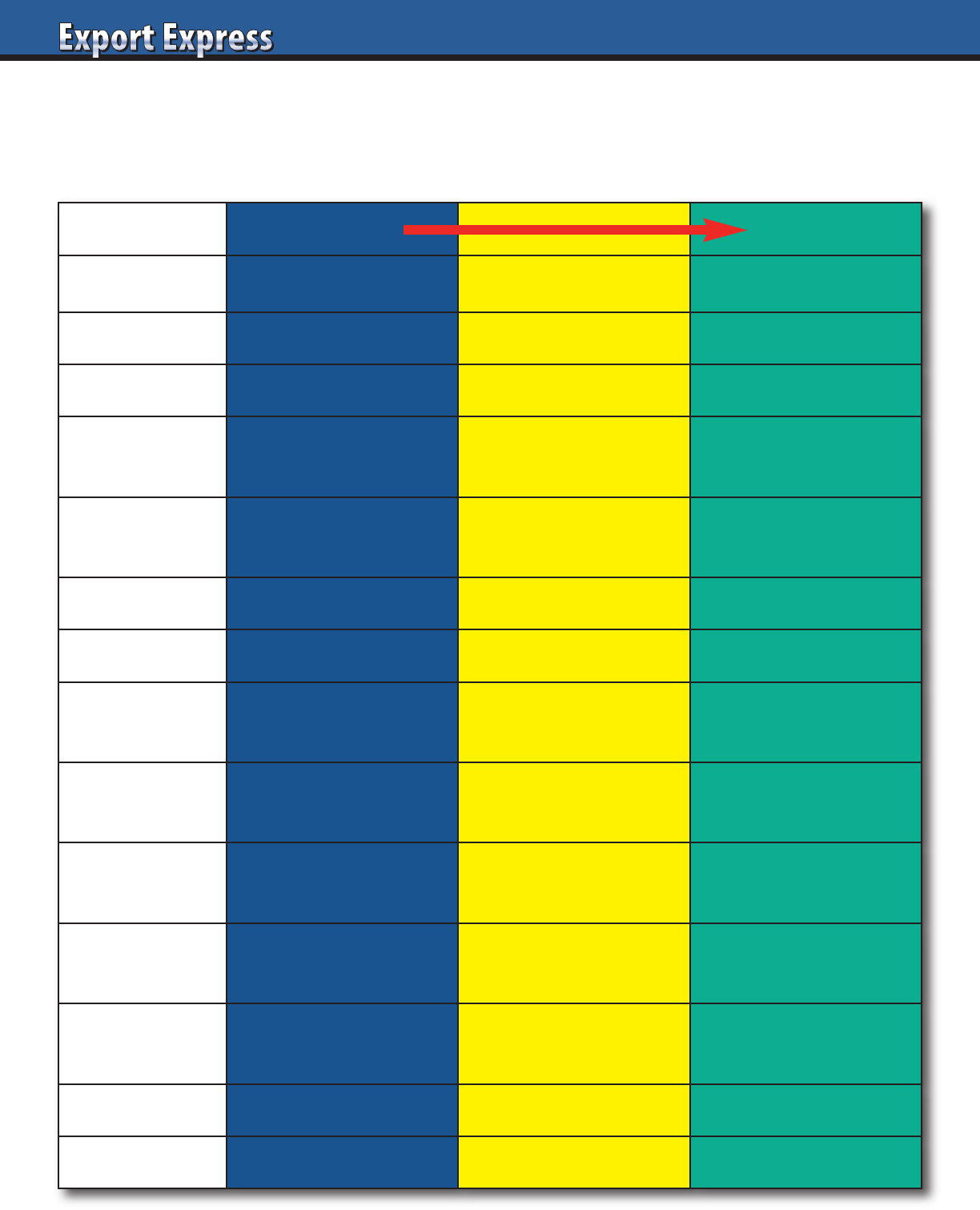
4
A big difference exists in export strategy for SMCG (Slow Moving Consumer Goods) and companies committed
to FMCG Brand Building (Fast Moving Consumer Goods). Either model is okay. Many companies are en route
between SMCG and FMCG. Alignment between aspiration, investment, and perspiration drives realistic outcomes.
Export Journey: SMCG to FMCG
SMCG FMCG
Aspirations Niche Participant Mass/Leader
Consumer
Homesick Upscale Local
Research
None Nielsen Consumer
Portfolio
Best sellers from
home market
Best sellers from
home market
Tailored to region
or country
Packaging
Standard packs stickered Multilingual
Local language label
and pack size
Factory
Corporate HQ Corporate HQ Offshore
Pricing
Super Premium Premium Competitive
Marketing
None Sampling, Digital
360 Plans
TV, Digital
Trade Spend
None 10-20% Discount
Ad, Display
20-30% Discount
Route to Market
Niche distributor Mid -size distributor
Mass distributor or
subsidiary
Country Focus
Adjacent
Homesick Expats
Mid-size countries
plus USA
All countries
USA, China, Brasil
Channels
E-Commerce
Homesick Expats
Supermarket
E-Commerce
All channels
Oversight
1 visit/year from HQ Regional manager Dedicated country manager
Complexity
Low Moderate High
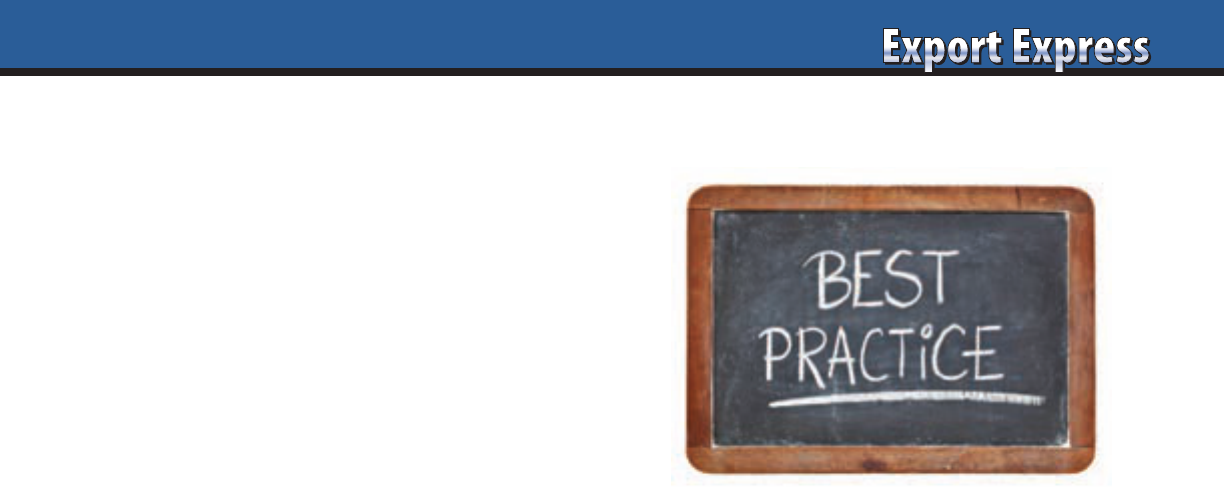
5
How much do you pay for a display or special promotion at
your top customer? Retailers from Argentina to Vietnam capture
manufacturers’ promotion money to drive sales and profits.
Brand development and market share are frequently
proportional to investment level. In the world of export, you
must “pay to play.” However, different models exist to fund
trade activities. Leading distributors confirm that they work
with a variety of different structures. “It’s all money” and the
key question remains: under which cost line do you want this
investment to sit in your price calculation?
Manufacturer Funded Promotion Budget
The classic approach is for the brand owner to develop a joint
business promotion plan with the distributor. A spending budget
is developed, funded 100% by the manufacturer. The overseas
distributor pays the local retailer and sends a billback to the
producer, with proof of performance. The rationale for this
practice is that the supplier owns the brand equity and can
change distributors. Distributors are reluctant to invest their
own margin into another companies brand.
Split Fund – “Skin in the Game”
In some cases, the brand owner and distributor split the
marketing plan costs, usually “50-50.” A further variation exists
where the brand owner covers the cost of consumer marketing
and the distributor pays for the periodic trade promotion
discounts. The philosophy is that the distributor will benefit
from higher sales and will also be motivated to execute
successful promotions if their own money is invested. This
structure appears most frequently with an existing brand, with
a minimum three year history of shipments. In reality, the
distributor calculates the expected investment and builds it into
his cost structure. A “50-50” shared model will usually not be
accepted with a new brand pioneered for the first time.
Best Price – Dead Net
Dead net pricing is the third model. In this scenario, a
manufacturer provides a distributor with his very best price.
The distributor builds in all promotional support and his margin
into his calculation. In this case, the manufacturer does not
receive a constant stream of requests for more promotion
funding. However, the brand may lose control of their pricing
model or be under supported if the distributor fails to promote
at adequate levels.
10% of Sales – $1/Case
Another common model is for a manufacturer to establish a fixed
funding rate per case sold which the distributor invests to build
the brand. Normal funding begins at 10% of case cost, but can
accelerate to 20% or more for a competitive category. Some
manufacturers offer a flat rate per case or amount per container.
As mentioned before, it ultimately converts to a pile of money
to invest in brand building. This approach functions best with
a brand with a current sales history, as percentages don’t mean
much when the brand has zero sales.
Listing Fees
These one time payments are primarily covered by the brand
owner as part of upfront launch costs. Sometimes these fees can
be rolled into introductory promotions, spread out over twelve
months, or paid via free goods. Please check out Export
Solutions’ article Ten Tips: How to Minimize Listing Fee Payments
for more ideas on how to reduce these payments.
Most Effective Promotion Vehicles
Every key account manager should know the best promotion
vehicles to drive incremental sales at their customer. At some
supermarkets, promotional leaflets drive tonnage. At others,
deep discounts (30% +) or displays are winners. Distributor
sales teams are market experts and can source best practices
from their other brands.
Post Promotion Analysis
Tools are available to measure promotion effectiveness. These
evaluate sales lift, boost in baseline consumption, and cost per
incremental case. A good idea is to analyze mutiple scenarios
such as different price points, seasonality, and display support.
Creativity Counts
Many of the best trade promotion success stories involve
field activated promotions. This allows a brand to break
through the clutter of too many “me too” events. The sales team
maintains ownership and enthusiasm to drive support. Another
positive strategy is aligning with a retailer’s favorite charity
to contribute to the community while building your brand.
Manufacturers must avoid the dull routine of repetitive
15% trade promotions. Boring!
Key Issue – Distributor Underspends
Distributors are businesses, aimed at achieving a fair profit, just
like your company. A risk occurs whenever distributors claim
responsibility for managing the trade discount plan for their
country. At times, these trade discounts can be under spent
versus category and brand requirements. For example: when a
distributor says that he will fund four promotions per year, does
that mean at a 10% level or 30% level? Will the distributor funded
promotions be for all channels and retailers or just a few
customers? How do you know?
Compliance and Audit
Most distributor contracts include provisions for audit of trade
promotion payments. Larger suppliers include trade promotion
payment software. Good practices are complex and require piles
of paperwork. A core message is that the “distributor respects
what the manufacturer inspects.”
Export Trade Promotion Funding
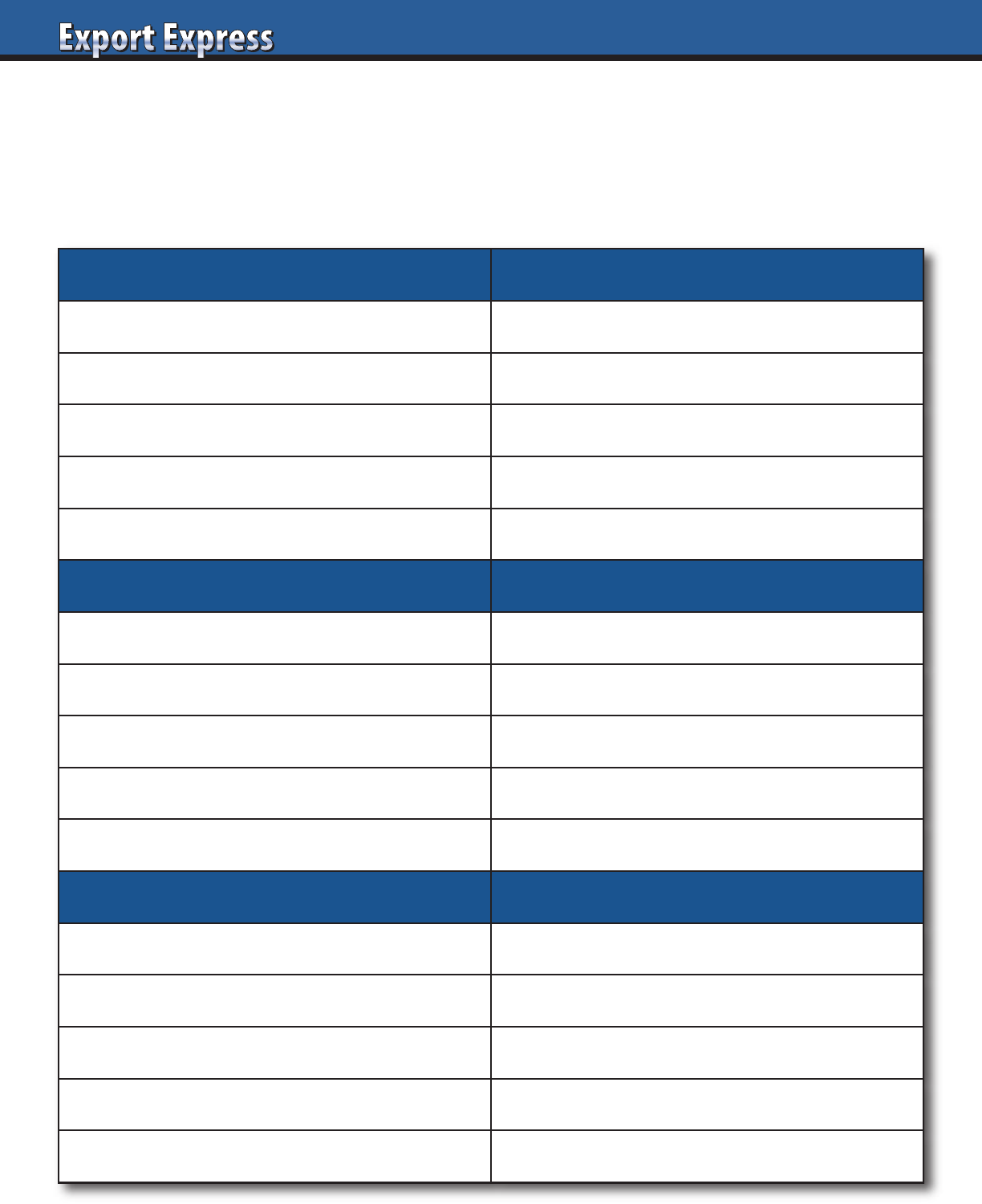
“The Right Way” – New Country Launch
Retail buyers and distributors are receptive to brand launches from multinationals. Why?
Multinationals succeed, as they introduce new products “The Right Way.” Export Solutions recaps
30 components of launching “The Right Way.” Exporters create magic with limited budgets!
Winners check as many boxes as possible on “The Right Way” scorecard.
Product Retailer
o Meaningful innovation – not “me too” o Boost category sales, margin, and profit
o Consumer market research insights o Syndicated data (Nielsen) – category facts
o Technical confirmation of product differentiation o Invest in retailer “push” programs
o Reasonable retail price – premium (not sky high) o 4-6 high value promotional events per year
o Test market results – similar country or retailer o Retailer VP, distributor CEO at intro call
Marketing Excitement
o 360 marketing plan: TV, in-store, social, PR o Launch party – memorable location
o Sampling o PR, social media, trade press
o Social media o Celebrity endorsement
o Displays: end of aisle and shelf blocks o Distributor sales contest
o Special offers – retailer fliers o Donation to local charity
Team Scorecard
o Distributor – best in class, category expert o Year 1: invest; year 2: break even; year 3: profit
o Local manager – launch oversight o Sales volume (retail sell-out)
o Marketing, social media, PR agencies o Market share
o Brand/technical resource from headquarters o Retail availability (weighted distribution)
o Total distributor engagement: reps. to CEO o Year 2 commitment and enthusiasm
6
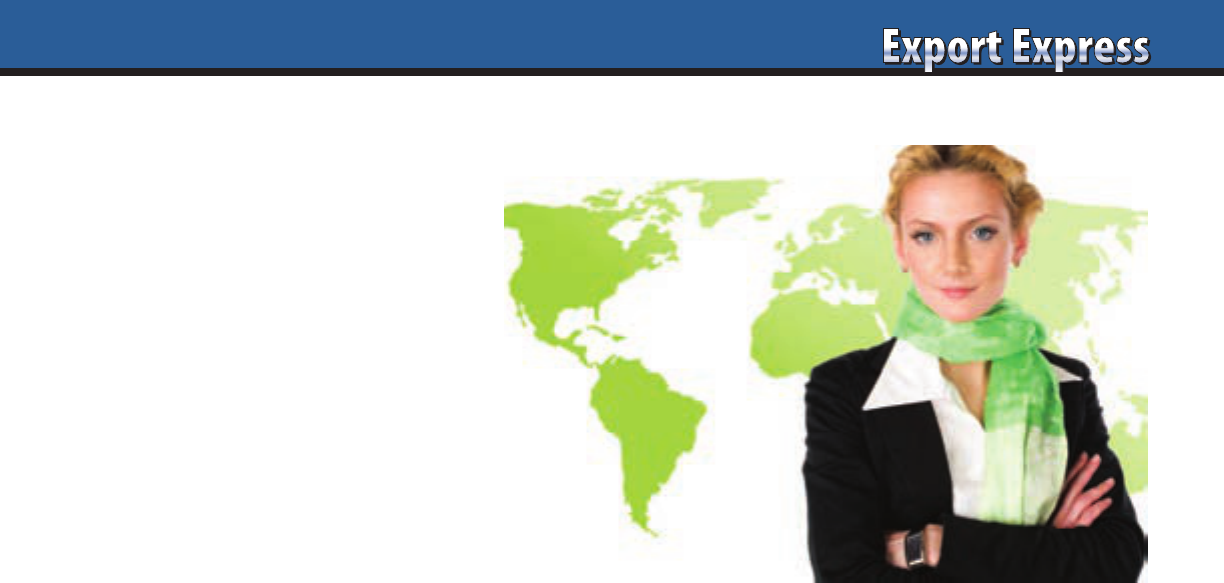
7
How big will your international business be
in 2025? A successful global strategy reflects
a realistic mix of aspiration and investment.
The road to 2025 contains speed bumps, with a
probablity of recessions, currency fluctuations,
and a precipitous decline in sales through
conventional supermarkets. The good news
remains that more of the world’s 8 billion
consumers will live better and eat healthier.
This will stimulate demand for the added
value food, beverage and personal care brands
we produce. One fact remains indisputable:
international development will dominate as the
primary growth engine for allmid- to large-sized
consumer focused companies.
E-Commerce Disruption
How large will e-commerce become? Can you
envision a world where e-commerce accounts
for twenty percent of sales and that Amazon
appears as your top customer? How will you
restructure your business to optimize sales through online
retailers? A logical first step is to select an e-commerce
channel champion and treat Amazon as a major global key
account like Walmart or Carrefour. Another initiative involves
rethinking your packaging strategy to supply selling units
that are “post friendly” and can be mailed cost effectively.
Companies will hire armies of data analysts to research online
purchasing habits and apply the insights to products sold
through brick & mortar. No physical space limitations appear
in cyberspace, encouraging brands to expand their product
portfolio and test options without the physical handcuffs
of shelf space and listing fees. Hire young people to lead
the cultural shift from marketing through supermarket
showrooms to menu based marketing choices from Amazon.
China Syndrome
The food industry spent the last ten years chasing futile
BRIC dreams in China and India. The expensive conclusion
indicates that it is difficult to convince Asian consumers to
change their meal habits to incorporate western staples like
breakfast cereal and pasta. The reality reveals that Asians
achieved better success at exporting their Chinese, Thai,
Japanese, Indian, and Korean food to us than we have in
converting them. Credit confectionery and snack, personal
care, and Starbucks as rare examples of western categories
achieving success. Asia will account for sixty percent of the
world’s mouths in 2025, including 2.8 billion people in China
and India. The Asian solution is to adapt our product recipes
to meet Asian taste profiles or to acquire Asian companies as
a platform to build critical mass.
Established, Developing, Pioneer
A critical decision revolves around resource allocation
between three market clusters.
Established markets represent the historical base business,
accounting for the bulk of sales and “paying the light bills.”
In these countries growth rates exceeding five percent are
challenging without buying market share in flat categories.
Developing countries are attractive green sprouts where you
have planted seeds of presence and are beginning to gain
traction. These countries may offer the largest potential
source of new revenue. However, brand owners must
acknowledge the initial progress and transition your route
to market model and thinking from “niche exports” to mass
market player to optimize results.
Pioneer countries emerge as large markets like the USA
(for Europeans), China, or Brasil where your company claims
sales, but fails to register meaningful market share. Success
in pioneer countries requires significant investment to build
your brand “The Right Way” (see page 6 chart).
Boots on the Ground
How many members of your export team are based outside
your home country? In the 2000’s, exporters managed from
headquarters, with roving missionaries swooping in for a
distributor meet and greet, store check, collect your frequent
flier miles, and off to the next stop. In the 2010’s, producers
established regional hubs in comfortable expat locations such
as Dubai, Singapore, and Miami for Latin America. Today,
success in important countries like Mexico, Saudi Arabia,
and Indonesia will be directly proportional to the size of
your market based team. Best in class distributor’s energy
is focused against brands with local management oversight,
leaving little bandwith for companies that show up once
a year.
Digital Distributor
Winning distributors will invest to create deep capabilities
serving e-commerce customers and facilitate the transition
to digital marketing. Owners will need to source new logistics
solutions for e-commerce and redefine the brand manager
role to pursue excellence in deploying social media strategies.
If they cannot adapt, old school distributors may retain
responsibility for the shrinking supermarket channel, while
a new modern breed of distributors handles the high growth,
e-commerce business.
Plan to Thrive in 2025
continued on next page
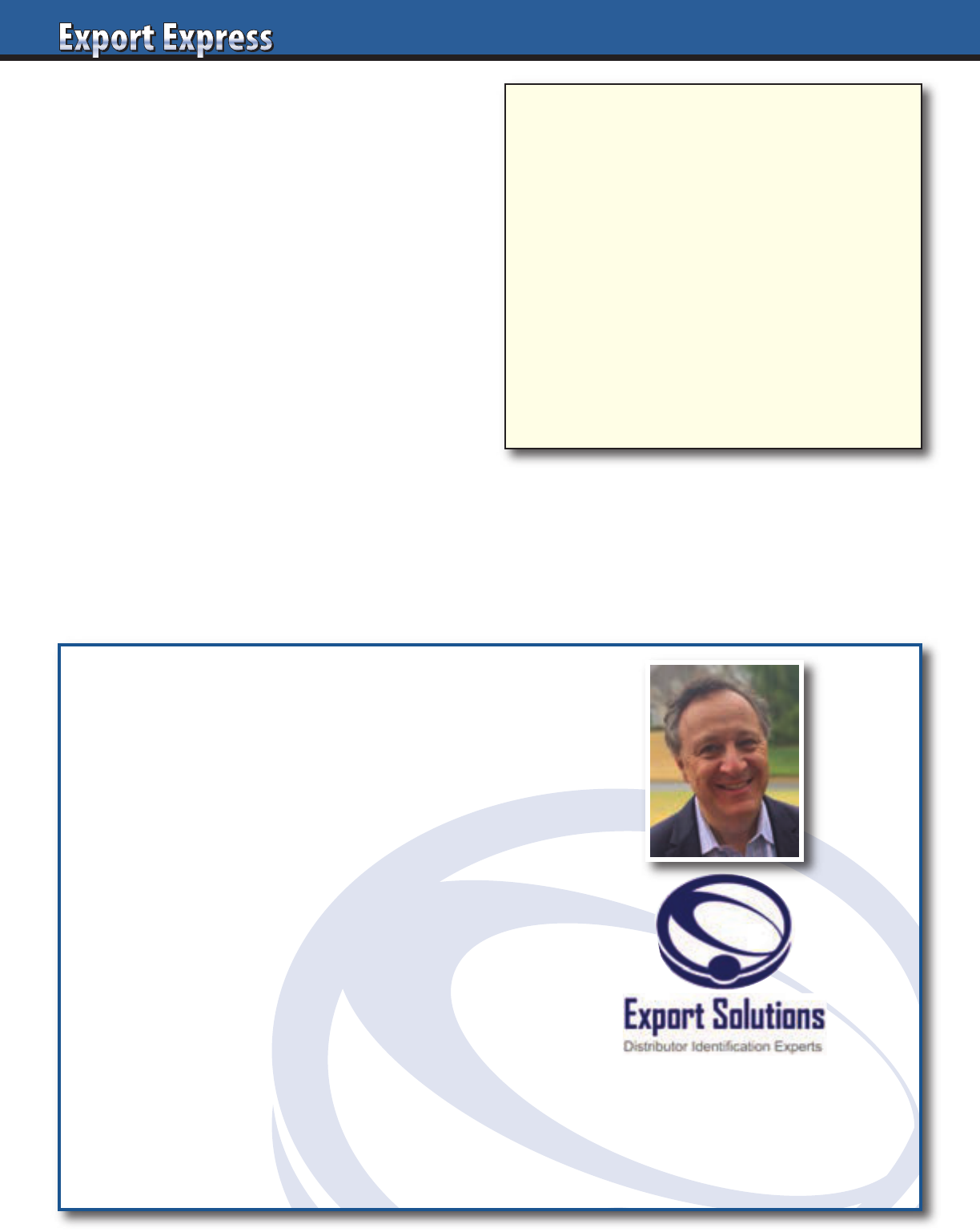
8
ESG Strategy
New consumers will support brands with a well articulated
Environmental, Social, and Governance (ESG) strategy.
Walmart recently shared a ninety four page update on their
scorecard progress. Unilever reported that their purpose led,
sustainable living brands were growing 69% faster than the
rest of the business and delivering 75% of company growth.
“Better for you, better for the environment” brands will enjoy
bright prospects for international expansion. New data
transparency tools will allow consumers to compare labels
and ingredients instantly online or in-store.
Private Label vs. Personal Label
European and Northern American retailers boosted profit
margins while sacrificing sales per unit through aggressive
private label expansion strategies. For many reasons, private
label development remains low in new markets of Asia,
Middle East, Africa, and Latin America. The explosion of
e-commerce presents further challenges to private label,
as consumers will appreciate a broader selection of
competitively priced brands to choose from. A new initiative
could be the development of “Personal Label” products
where a consumer may enjoy more options in adapting
a product to meet their individual specifications.
Road Ahead
What changes will you make to your 2025 road map? Smart
exporters source clues from global trends and apply to their
planning model. Looking for strategies to thrive in 2025?
Export Solutions can help!
Plan to Thrive in 2025
5 Critical Questions to Thrive in 2025
1. Are we willing to pursue international acquisitions?
2. Would your company consider overseas contract
packing (versus export)?
3. Can we test a high spend investment plan
(“The Right Way”) in a strategic country?
4. Would your company invest aggressively
in offshore head count in advance of sales?
5. Europeans: can we develop the USA market
implementing the USA playbook? USA factory,
broker network, competitive pricing, USA team,
channel strategy, 30-50% trade promotions?
continued from previous page
Talk to an Expert
• International Strategy Road Map
• Fix Problem Markets
• Entry Plans
• Find Distributors in 96 Countries
• Export Workshops
• Motivational Meeting Speaker
Contact Greg Seminara at (001)-404-255-8387
to discuss your business development project.
www.exportsolutions.com
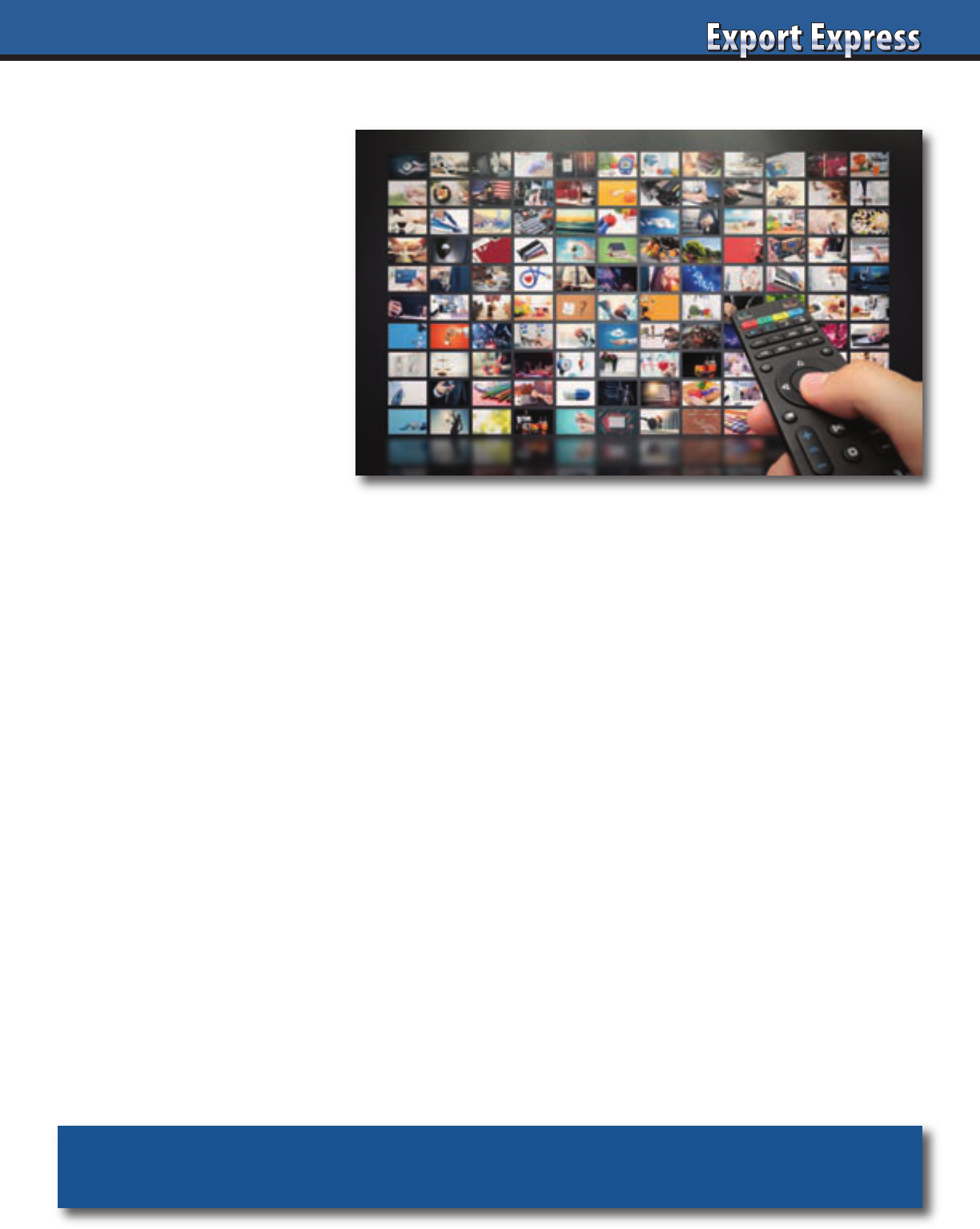
If you launched a premium new brand,
would your first customer be Walmart
or a chain of upscale supermarkets?
Export managers frequently target the
largest overseas retailers, forgetting the
high cost and activation requirements
to develop a meaningful level of repeat
sales. A viable route to market exists in
every country for those with a rational
alignment of ambition and investment.
A key to success is an approach based
upon channel specific, retailer profiling.
Retailer Profiling
Every country contains similar channel
dynamics: value supermarkets, mass
grocers, upscale supermarkets,
e-commerce, hypermarkets, discounters,
convenience, gourmet, ethnic, natural
foods, drug stores, and specialty
retailers. Foodservice is dominated
by wholesale distributors and cash and
carry outlets. Bigger countries feature
well evolved channels with clear lines.
In smaller countries, channel blurring
exists, with conventional retailers
striving to serve as a “one stop”
shopping destinations.
A worthwhile exercise is to conduct an
analysis to segment your overseas sales
by channel and supermarket type. This
learning could supply a best practice
road map when entering new countries
or implementing a business
improvement initiative.
On-Ramp
Prime prospects normally lead us to
upscale supermarkets, ethnic stores,
e-commerce, and gourmet outlets. These
channels tend to cater to consumers that
are more adventurous and affluent.
Their shoppers are less price sensitive
and search for brands not stocked by
mass supermarkets. Frequently, buyers
at these retailers study category
dynamics and seek to be first in the
country to support an innovation from
overseas. Listing fees continue to soar
and spread across emerging markets.
Many “on-ramp” retailers appear more
concerned with product attributes than
up front payments.
Upscale Supermarkets
High end stores serve as showrooms
for international brands. Other local
retailers look to them for inspiration and
execution. These special supermarkets
create a pleasant shopping environment
with well established programs for
product tastings and consumer
education. Your first stop in any country.
E-Commerce
In the past, homesick expatriates would
lug big suitcases from home or scan
their adopted city for treats from home.
Now, it’s possible to log in to Amazon or
other e-commerce players and find your
favorite brands from home in a few
clicks. For example, I just searched
Amazon UK’s grocery store for USA
food and discovered more than 1,000
results from Jif peanut butter to Jiffy
corn muffin mix to the beloved Jelly
Belly. Other online specialists like
americanfood4U.de exist in Germany.
Ethnic Stores
These are stores dedicated to products
from overseas. In the USA you can find
stores dedicated to Italian, Mexican,
Asian, British, and German food
products. In Europe, there are fantastic
stores like Taste of America in Spain,
featuring all your favorites from back
home. These retailers are all about
“availability” and are anxious to partner
with leading brands from the home
country or successful innovations.
Priorities
Discounters, small shops, and value
oriented supermarket chains tend to be
tough channels to penetrate in the initial
stages of your export development. Most
brands plan to sell to all retailers. This is
a logical ambition in your home country
where your brand owns critical mass. In
new countries, expanding too fast creates
risks. Where does your target consumer
shop? Support these retailers with
marketing investments. Your brand will
“die” on the shelf without high impact
promotional activity.
From High Class to Mass
The head of India’s distributor association
described export development as the
journey from “high class to mass.” Look
for clues in the requirements to gain shelf
access at target retailers in your home
country. Remember that you are the
premium newcomer from overseas, not
the local incumbent. “Crawl, walk, run.”
Channel Your Exports
Need more information? Visit www.exportsolutions.com.
9
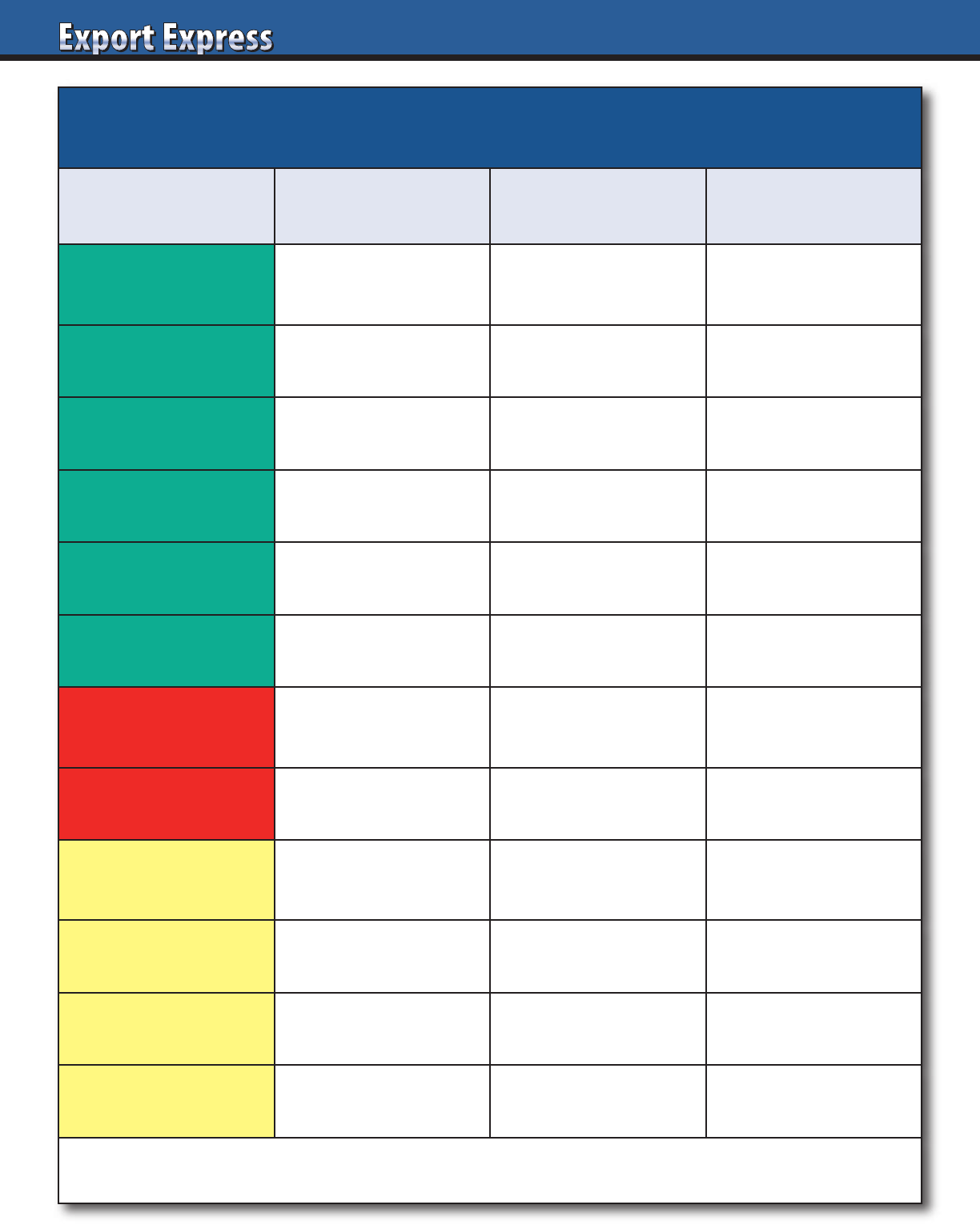
1010
New Country: Retailer Segmentation & Prioritization
Priority* Channel USA Example New Country
Phase 1
Upscale
Supermarket
Harris Teeter
Phase 1 Ethnic 99 Ranch Market
Phase 1 E-Commerce Amazon
Phase 1 Gourmet Whole Foods
Phase 1 Specialty World Market
Phase 1 Natural Food* Natural Grocers
Phase 2
Mass
Supermarket
Kroger
Phase 2 Hypermarket Meijer
Phase 3
Value
Supermarket
Food Lion
Phase 3 Convenience* 7-Eleven
Phase 3 Foodservice Sysco
Phase 3 Discount Aldi
*May vary by supplier
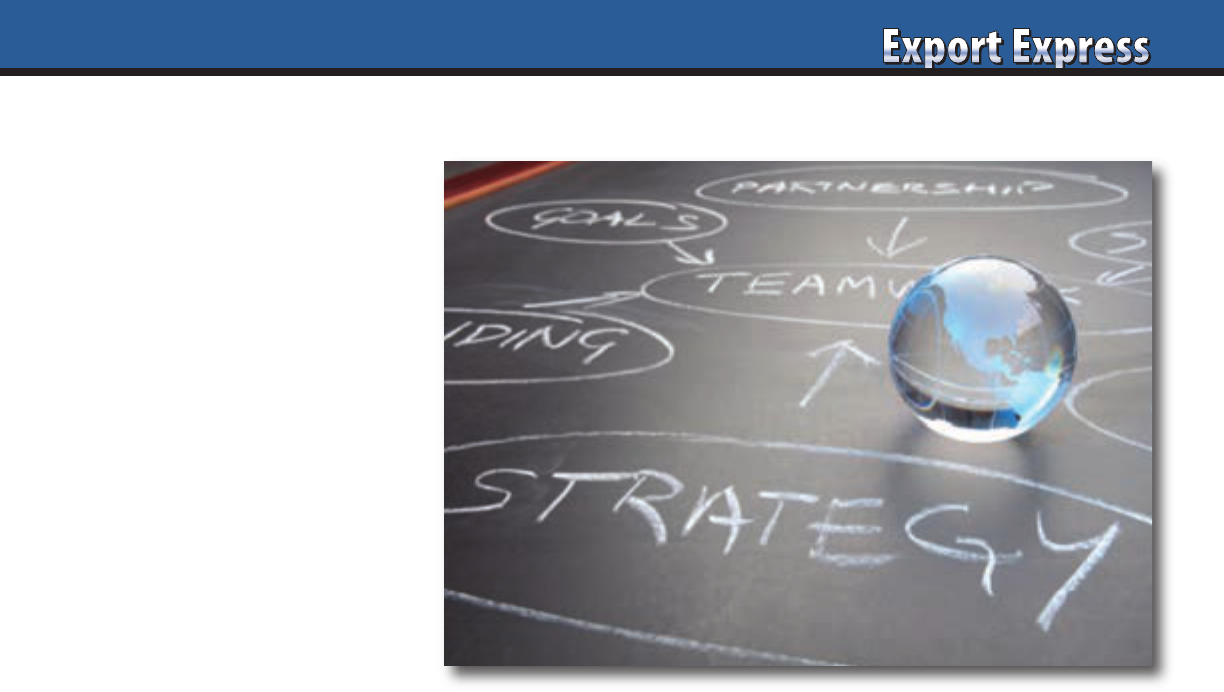
1111
Export Strategy Road Map
Export strategy is frequently mistaken
as a race to plant flags in as many
countries as possible. Top management
spends too much time reading economic
reports pushing the export department in
the uncertain direction of BRIC countries
while ignoring opportunities on their
doorstep. Exhibitors at Anuga or ISM act
as traders at a Turkish Bazaar negotiating
over terms and conditions without focus
on requirements for “brand building.”
The reality is that export development
is about creating a sustainable, long
term strategy that can deliver
consistent results.
Map to Future
A good strategic plan should be visionary,
conceptual, directional, and compatible
with the company’s overall business
goals for a 3-5 year period. This contrasts
with your annual business plan which
represents a short term operational plan
focused on measurable tactics. A viable
long term strategy identifies megatrends,
addresses important challenges, and
creates new sources of advantage.
Strategy requires making business
choices, including tough decisions
on which countries to enter, the right
brands to support, and where to allocate
company resources.
Lessons Learned
The first step is to conduct a “Lessons
Learned” analysis. This fact based study
should detail current metrics by country.
Evaluate sales per capita, market share,
profit margin, and three year sales history.
Results should be segmented by country
size and distance from your producing
facility as well as “route to market”
model. Export Solutions recommends
a second stage “20/20” analysis where
you look at all market metrics and you
separate the “Top 20%” performers
versus the “Bottom 20%” performers.
What are common characteristics in
the countries where you are winning?
Are there similarities in markets where
your company is “under- performing?”
A solid Lessons Learned analysis guides
our strategic choices for your new
export strategy.
Core Competencies
What does your company do well? Which
product categories, services, or regions do
you outperform your competitors and
drive category value? What factors
distinguish your company from other
category performers? Your strategy
should sync with segments where you
maintain a sustainable advantage.
Investment
Export strategies can be doomed from
the start when lofty business ambitions
are not matched by realistic investment
levels to meet desired objectives.
Investment comes in many forms:
research, marketing, trade promotion
and most importantly, human resources
dedicated to a project.
Strategy – OGSM
One approach that encompasses both
the strategic and operational aspects of
the business is “OGSM.” OGSM stands
for the process of developing a document
outlining “Objectives, Goals, Strategies,
& Measures.” This “plan on a page”
provides a clear and concise guide to
your expectations. OGSM serves as a vital
link between long term strategy and short
term business demands.
Focus
Successful international development
strategies reflect a focus on a narrow
band of countries and activities. Industry
leaders such as P & G, Nestlé, Kraft Heinz
and Barilla typically dedicate substantial
resources to the ten countries that account
for 60% of their business. This approach
must cultivate a mix of established
markets with “new frontier” markets
which offer exceptional potential. This
does not advocate ignoring smaller
markets and opportunities. It signals
a message that not all markets should
be treated alike with similar programs
and resource allocation. I remember a
client whose Latin America business
had been stagnant. My analysis revealed
that his area manager devoted his time
to customers in Central America and
Caribbean with minimum energy
dedicated to Mexico, a market with
130 million people, but tough to
penetrate. The new strategy committed
to exponential growth in Mexico, with
the manager spending 50% of his time
in Mexico. End result was Mexico
business doubling!
Export Solutions Can Help!
Export Solutions has participated in more
than 400 international development
projects on five continents. We frequently
provide guidance for export strategy
development as well as validating
proposed plans. Our export strategy
templates can be rapidly adapted to fit
brands for any supermarket category.
Customer feedback suggests that Export
Solutions strategy insights can save you
time, money, and “wasted” effort.
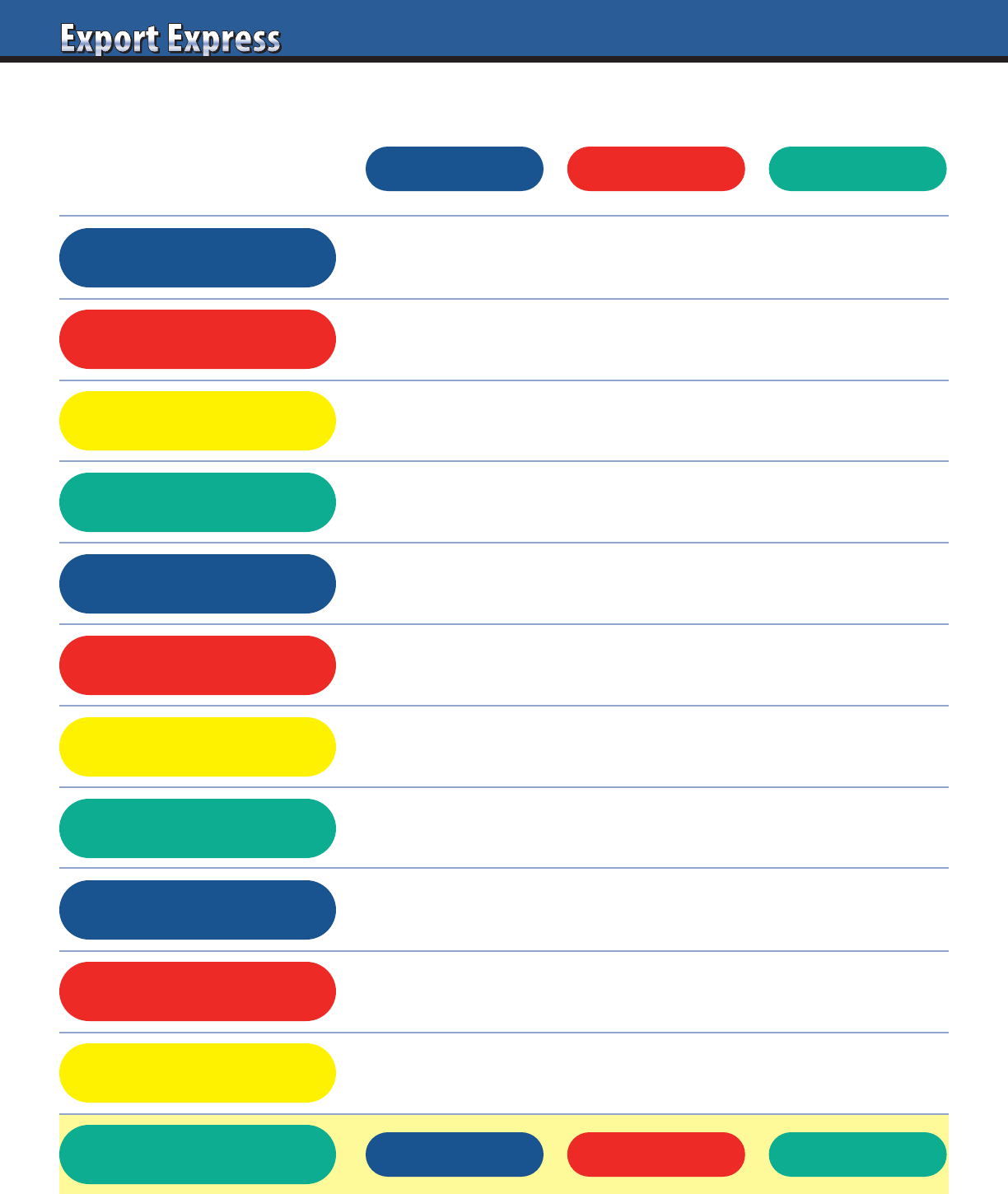
1212
Export Strategy Road Map Template
What are your business ambitions for the time period?
What factors have contributed to export success?
What situations have led to export disappointments?
What countries represent your top 20% performers? Why?
What countries represent your bottom 20% performers? Why?
What is your competitive advantage?
Why is your brand unique versus international competitors?
What are the biggest export opportunities for your company?
What represent high percentage, profitable opportunities?
What is your investment model? Marketing, Promotion, People.
What alternatives are available?
One page plan defining Objectives, Goals, Strategy, Measures
What activities are required to achieve desired results?
What are realistic measures and benchmarks?
Countries Brands Partners
Strategic Priority Opportunistic
Mission
Lessons Learned
20/20 Analysis
Core Competencies
Big Opportunities
Low Hanging Fruit
Investment
Strategic Options
Strategic Plan
Tactics
Measures
Markets
Strategy questions? Contact Greg Seminara at Export Solutions (001)-404-255-8387
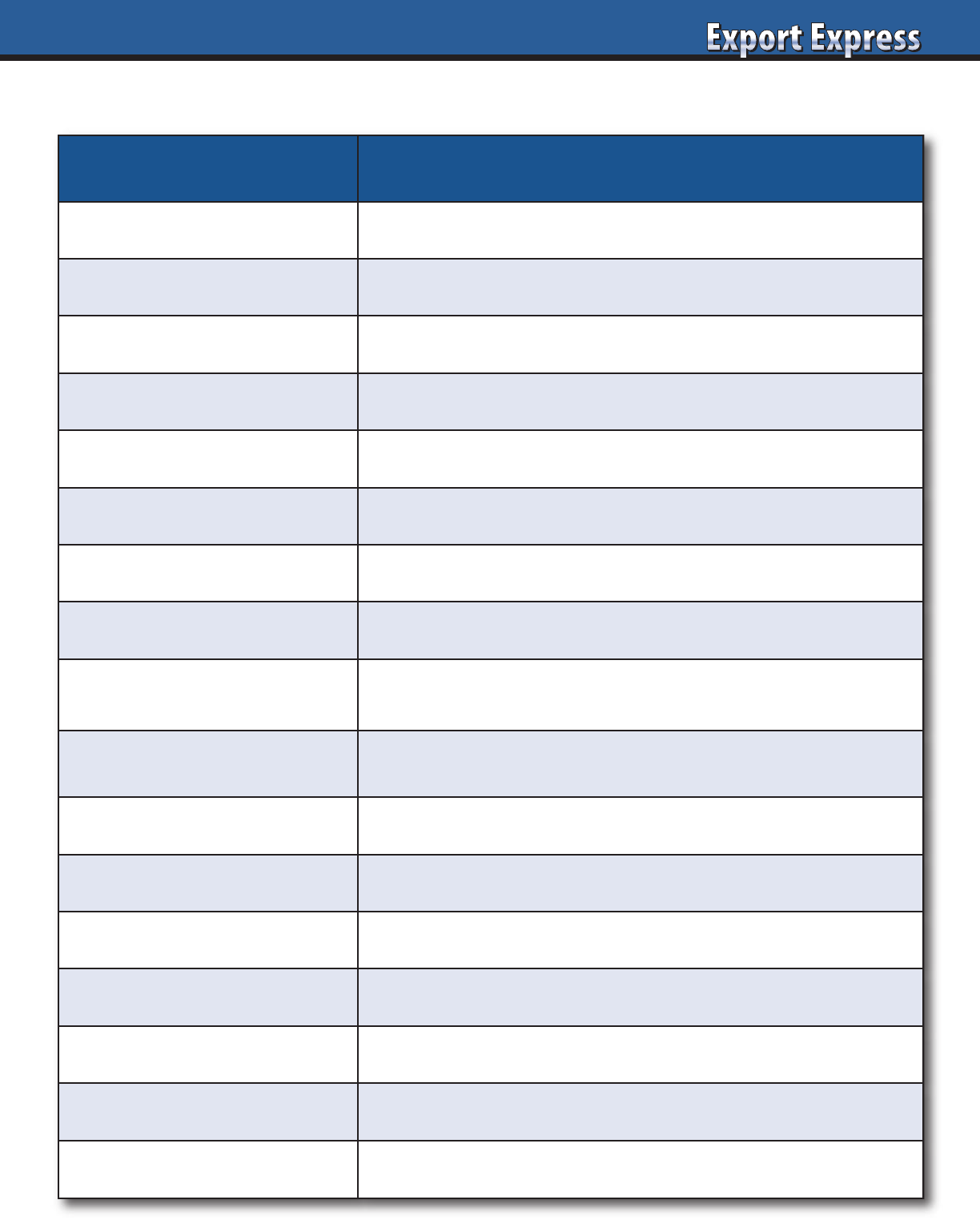
13
Distributor 2022: New Skills for New Times
Priority Comments
E-Commerce
Treat as major channel, not niche.
Social Media
Hire digital marketing team, link with local influencers.
CEO Engagement
Regular Zoom calls with overseas brand owners.
Culture
Promote young, energetic spirit. Embrace change and new channels.
Category Specialization
Laser focus on core categories vs. products in every aisle of the store.
Training
Use Zoom tools for regular training events with brand owners.
Team
Hire under 30's for social media and e-commerce sales roles.
IT Investment
Upgrade platform: E-commerce, retail reporting, sell out data.
Cost to Serve
Measure profitability by brand and customer.
Realign based upon 2022 reality.
Market Your Distributor Brand
Promote your distributor brand to leading
companies in your core categories. Export Solutions can help!
Sampling
Aggressive investment in this A+ tool. Explore new sampling vehicles.
Brandscaping
Invest in a “Best in Class” web site. Create modern company profile.
Scorecard
Incorporate e-commerce metrics: Page 1 results, consumer feedback, etc.
Brand Managers
Reward creativity and marketing excellence, not paperwork completed.
Recipe
Promote meal solutions, not just brands.
Optimism
Be positive. Think, “why not?”
Results Exceed expectations everyday.
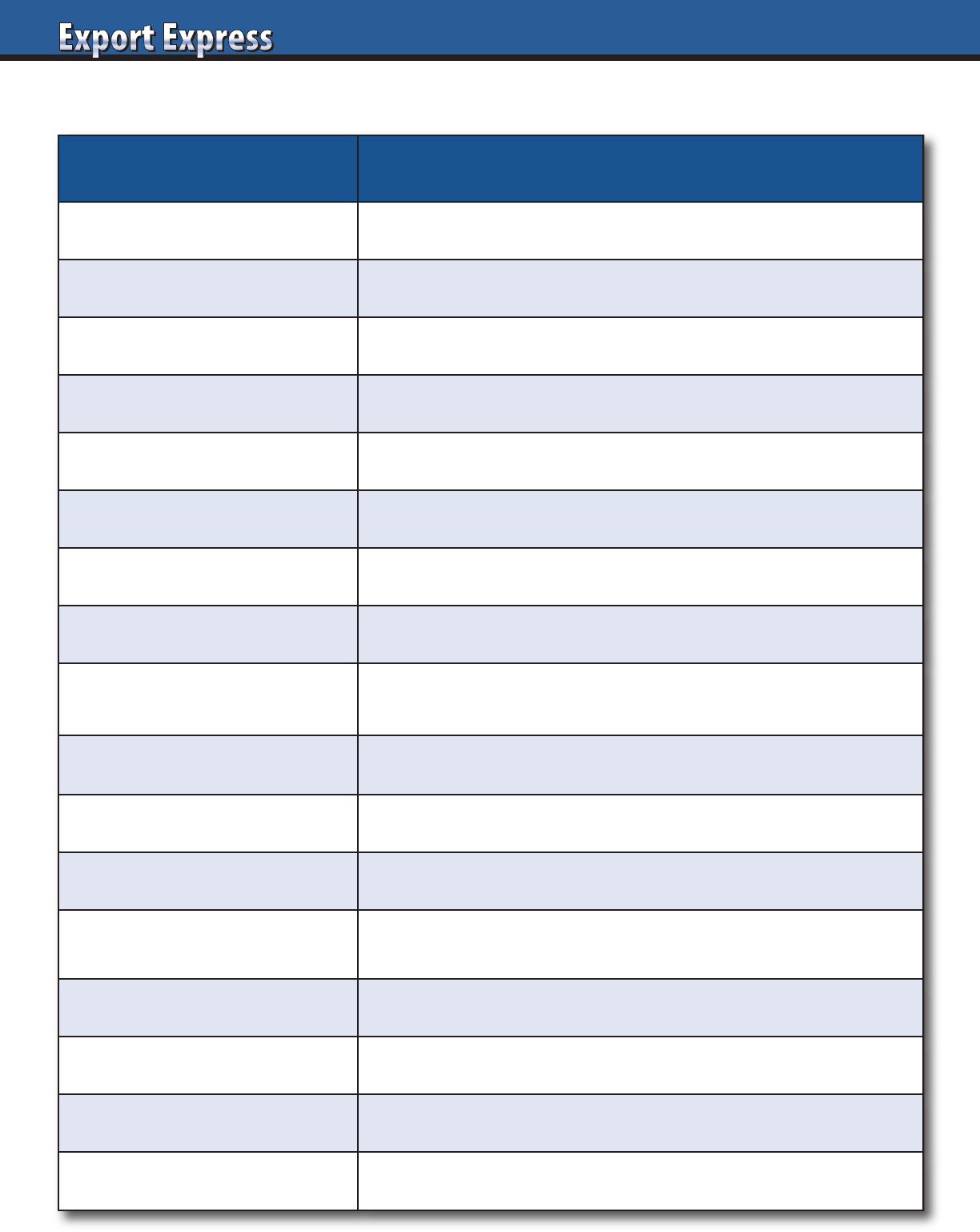
14
Export Manager 2022: New Skills for New Times
Priority Comments
E-Commerce
Treat as major channel, not niche.
Social Media
Create content library for distributors to “plug and play.”
Management Engagement
Zoom with distributor leadership team: CEO, CFO, VP Sales, etc.
Culture
Promote young, energetic spirit. Embrace change and new channels.
Category Specialization
Share category trends. Deliver product innovation, not “me too.”
Training
Use Zoom tools for regular distributor training events.
Team
Make your corporate functional experts available to your distributor team.
IT Investment
Upgrade platform: Brand portal, syndicated data, shipment status.
Cost to Serve
Measure contribution to distributor profit.
Look at pricing and margin vs. agreement.
Marketing Your Brand
Invest to adapt your global marketing plan to local conditions.
Sampling
Aggressive investment in this A+ tool. Explore new sampling vehicles.
Brandscaping
Invest in a “Best in Class” web site. Robust export resource page.
Scorecard
Monitor pricing/assortment at retailer web shops.
Incorporate e-commerce metrics in your distributor scorecard.
Brand Managers
Demand young digitally savvy brand managers.
Recipe
Promote meal solutions, not just brands. Look for co-promotion partners.
Optimism
Be positive. Think, “why not?”
Results Exceed expectations everyday.
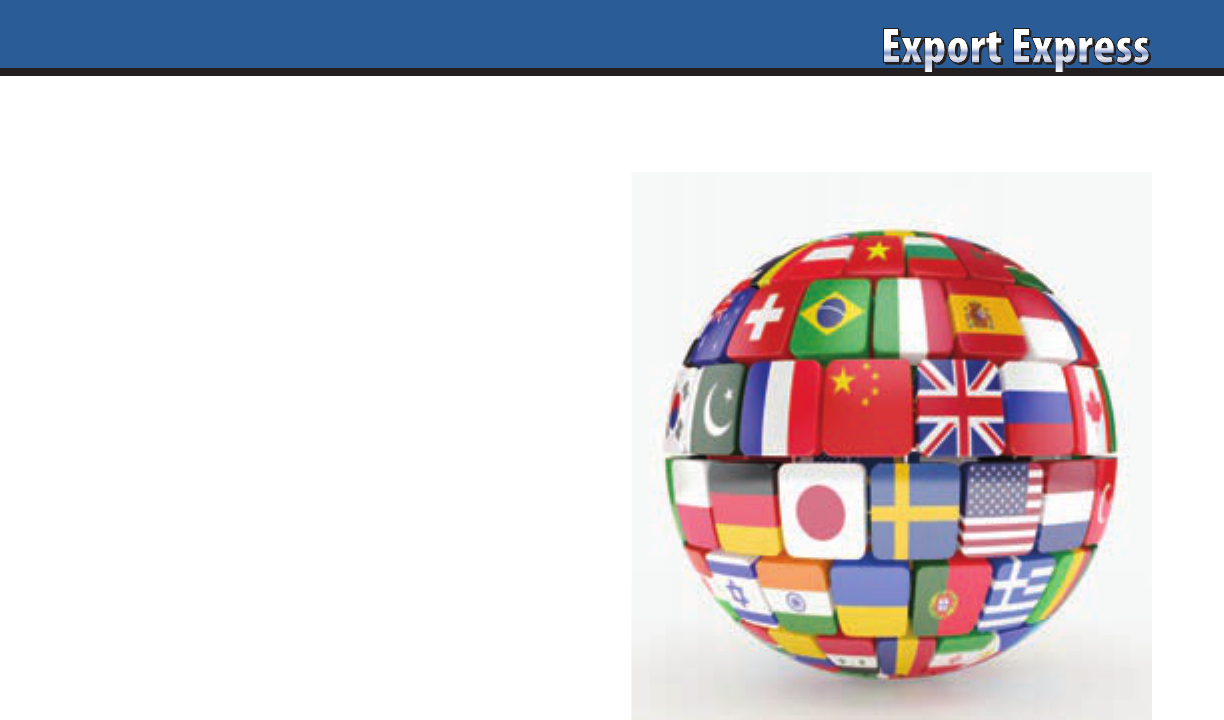
15
Consider a revision to your country prioritization map as
your 2022 New Year’s resolution. All industry players identify
international expansion as a primary growth engine. However,
most companies remain anchored to the past, with resources
devoted to managing “old businesses in mature countries.”
Real progress can be achieved through research and
investment to multiply your sprouting sales in flourishing
regions of Asia, Latin America, and the Middle East. This
requires a tricky balancing act of maintaining your existing
business base while shifting focus to far flung markets.
Move From Your Backyard
Most USA companies count on neighboring Canada, the
Caribbean, and Central America for the bulk of their export
sales. This is natural, given the proximity to producing plants
and familiarity with “Made in the USA” products. Similarly,
experienced European exporters have cultivated strong
businesses in adjacent European countries. “Border”
businesses are a logical first export step. Nearby countries
tend to be easier to manage and may share comparable eating
and lifestyle habits. In many cases, these businesses were
optimized many years ago. Committed companies must place
serious new stakes in the ground in distant markets outside
your comfort zone if you desire to obtain more than your fair
share of future industry expansion.
Export vs. Strategic Brand Building?
I frequently raise the question of “What does it take to build a
brand in your home country?” during my export speeches and
workshops. The consistent responses focus on the fundamentals
of research, adaption to local tastes, in-country production, well
connected sales team, and investments in consumer marketing
and trade activities. This approach is often at conflict with
export reality. Export tactics involve shipping a standard
package from your home plant with a modest investment and
hoping for brand acceptance in a foreign country. Winners have
the ability to bridge the gap between strategic brand building
and opportunistic exports.
Regional Hub Model
Successful companies understand that you need to get close
to the consumer and your customers. Advanced suppliers
have already established regional sales offices in places like
Singapore, Panama, or Dubai. One model is to extend this
concept to create regional manufacturing centers. This can be
achieved through a new factory, contract packer, or acquisition
of a local category competitor. These regional hubs can export
to adjacent countries. General Mills and Heinz are two of the
most successful multinationals in Brazil. Both acquired local
food companies and leveraged this platform to sell their
international product portfolio. Recently, Pringles opened
a new plant in Malaysia.
New Flavors, Small Packs
Eating habits and practices are different in emerging markets.
Portion sizes are smaller and a meal may feature many dishes.
How well does your product pair with rice (or beans)? Candy
and Snack products are the exception, with a universal
acceptance for most “sweet segments.” In every country, upscale
shoppers exist, hungry for foreign brands at any price. While
this is your initial target market, you ultimately need to reach
the masses with products in sync with their cuisine. Affluent
western shoppers fill shopping carts with large sizes to store
in kitchen pantries. Emerging market consumers shop daily,
allocating limited funds to purchase essential food items.
International marketers need to consider small sizes with
affordable price points to be relevant in low GDP countries
like the VIP’s (Vietnam, Indonesia, & Philippines).
Commit to One Country
Too many export programs aim to plant small flags everywhere.
This does not impress anyone if you’ve created a handful of
minor businesses, particularly in large, high potential countries.
Better idea is to identify one country with superior growth
prospects. Study the market and commit financial and “human
capital” to the country. Encourage senior management and
functional team leadership visibility to the project. Set 3, 5, and
10 year objectives, as these investments will not pay out in the
short term. I recently helped one of my forward thinking clients
study 17 potential expansion countries. “Crawl, Walk, Run.”
2022 Hot Markets
Many global citizens continue to live better and eat better. This
expanding middle class creates new potential consumers for our
brands. Asia contains 4.5 billion people, more than 61% of the
world’s mouths. China and the VIPs represent the best potential,
with India a target for those further along the development
curve. Latin America population now exceeds 600 million with
GDP larger than the UK, Japan, and India combined. Brazil,
Mexico, and Colombia are strategic countries where all brands
should be performing at much higher levels. The Middle East
reflects a dynamic marketplace, particularly in the oil rich
nations of Saudia Arabia, UAE, Qatar, and Kuwait. Population
A New Export Road Map
continued on next page
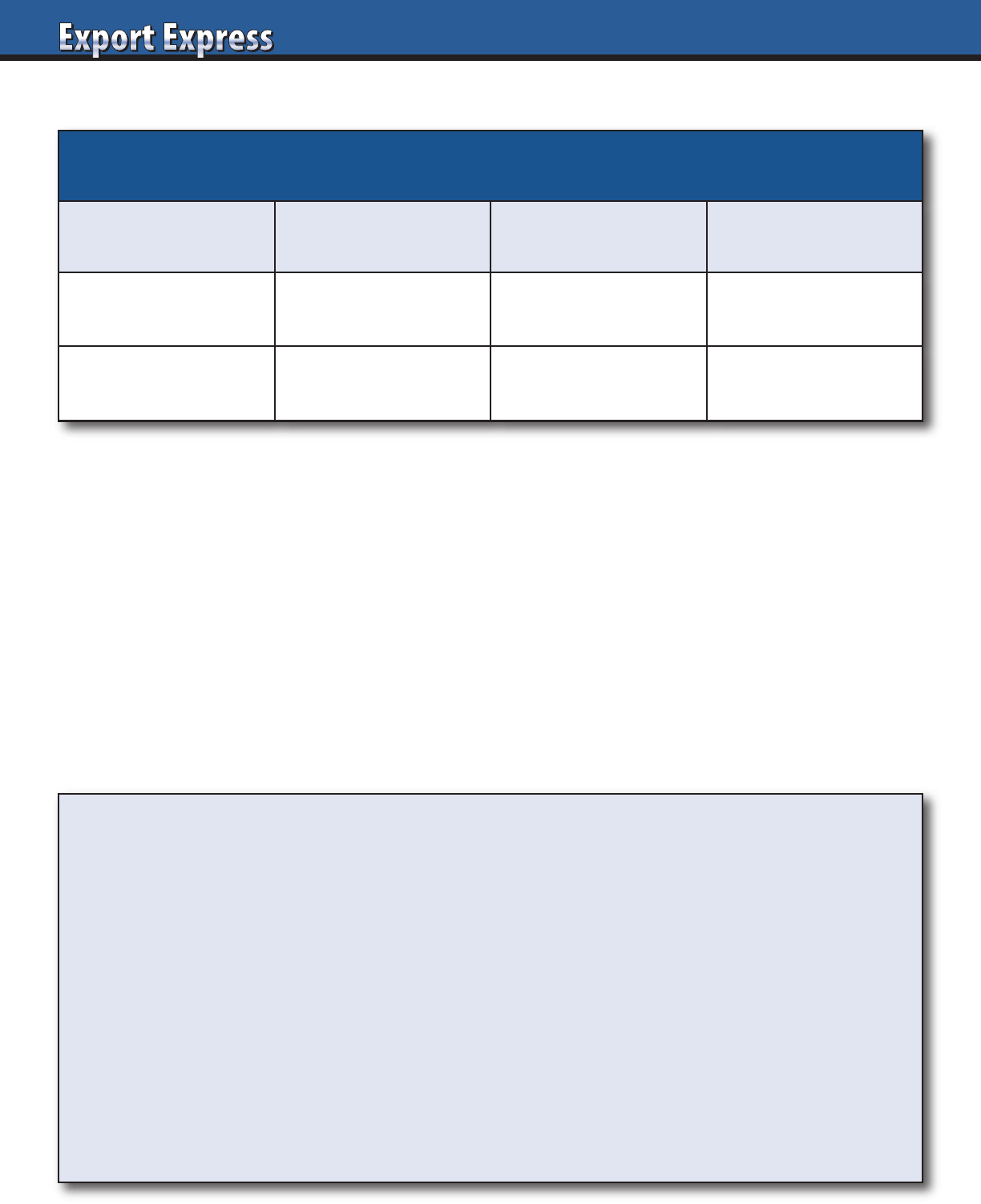
16
New Export Road Map
Current Top
Export Markets
New Export Focus Hot Countries
USA Brands
Canada
Caribbean
Central America
Latin America
China, SE Asia
Middle East
Mexico, Colombia
China plus VIPs
Saudi Arabia UAE
European Brands
Europe
Russia
North Africa
USA China, SE Asia
Middle East
USA, Mexico
China plus VIPs
Saudia Arabia, UAE
A New Export Road Map
totals more than 300 million and is growing exponentially
through birth rates and expatriate workers. These markets offer
attractive long term return on investment versus trying to mine
new sales from declining countries.
USA – Bigger than BRIC’s
The USA features a population of 333 million relatively affluent
consumers. USA citizens are open to cuisines from around the
world. A typical American diet would include Italian, Asian,
and Mexican food. Most international companies sell in the USA,
but per capita sales levels are small relative to potential. The
issue relates to the practice of treating the USA as another
“export market.” Success requires a USA based manager and a
hybrid organization including channel specific “Food Brokers.”
Consider construction of a small factory or a contract packer.
Be prepared to invest in consumer and trade programs, just
as you would in your home market.
Export Solutions Can Help
Our distributor identification services completed more than
300 distributor search projects on five continents. This year,
we’ve helped brands find distributors in tough to access
countries like Brazil, Mexico, Indonesia, and the Philippines.
Export Solutions has the unique ability to leverage the power of
our distributor database with prospective distributor candidates.
Our leading distributor database covers 96 countries and more
than 9,200 distributors and importers of supermarket products.
This includes more than 2,713 confectionery and snack
distributors. Our database has been recognized for excellent
coverage of emerging markets such as India, Brazil, and Mexico.
Contact us to learn more about how Export Solutions can
leverage our distributor contacts for your benefit in 2022.
continued from previous page
Greg’s Guidance: Export Strategy 2025
3 What are your Lessons Learned?
3 What are your Core Competencies?
3 Which countries offer exceptional growth for your category?
3 How much is your company willing to invest? Marketing, People, Promotion
3 What will our organization need to do differently?
3 What are realistic measures and benchmarks?
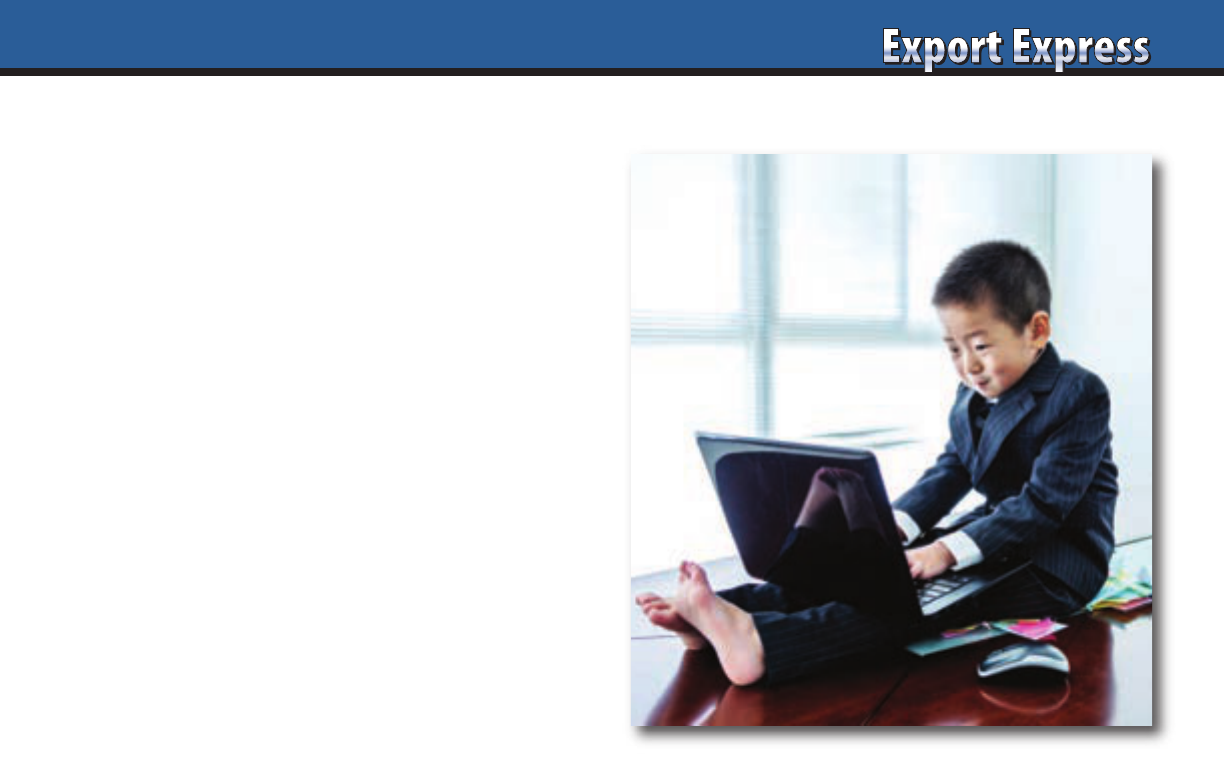
17
2025 is five short years away. The world will add another
billion citizens, with over 80% of them born in Asia and Africa.
Consumer marketers will likely focus on the “next billion”
consumers, a group of one billion middle class citizens living
in developing nations. Everywhere people will eat healthier
and live better with more access to the brands we produce.
Technology will revolutionize our business, with tools that are
waiting to be invented tomorrow. It is easy to foresee a future
which includes more online purchases, home delivery, product
info sharing, and brand personalization. As the countdown to
2025 begins, now is a good time to evaluate our strategies and
brainstorm about the road ahead.
Asia Pivot
Asia will contain almost 2/3 of the world’s population and
“mouths.” Global GDP will shift, with Asia’s share surging
towards 40%, equivalent to the USA and Western Europe
combined. A key industry challenge will be the number of
marketers willing to invest to build new eating habits with Asian
consumers. Currently, there are success stories with Coca Cola
and Starbucks leading the way in the beverage category. There
is also strong acceptance of European and USA confectionery
and snack products. Other categories are undeveloped, with
companies choosing a path of opportunistic exports versus
required investments in market research, adapted products,
and local factories. Asia will evolve from just another export
region to the key to future growth and profits.
India & China: Dynamic Duo?
Tough to underestimate the 2025 importance of two countries
that may total almost 3 billion people. It’s doubtful that India
will leapfrog China as an economic power. However, their
population gap will narrow significantly, with the stage set
for India to emerge as the world’s most populous country by
2035. China will be viewed as an established market, with more
national brands, retailers, and commercial structure. India is
the world’s great enigma. Will it finally break free from its
protectionist handcuffs and emerge as the ultimate growth
market? Or remain glued to its current path of country
development in their own independent manner? A broader
question could relate to a China-India alliance that could shift
dominance of global economic policy from the West to the East.
Meet the VIP’s
Vietnam, Indonesia, and Philippines represent high growth
countries with population exceeding half a billion people by
2025. This decade will likely see these southeast Asian “tigers”
graduate from emerging market status to more significant
sources of growth. Malaysia also fits in this cluster, with a
projected population increase to 42 million. I like Myanmar
as a new market. 54 million people, low cost of entry, and
very early in the development cycle.
Middle East: All About the Oil
2025 population will exceed 500 million in the region, with
population growth maintaining its positive upward trajectory.
Egypt’s population will approach 110 million and Iran’s may
surpass 90 million. Stability in Iraq would result in an important
new market with a population increase from 35 million today
to 46 million. As always, countries with oil like Saudi Arabia
and GCC nations will surpass countries without the mineral
resources. A big question is the evolution of alternate supplies
and sources of energy. Current oil pricing levels are creating
short term problems. Longer term, higher prices are required
to sustain development.
What About Africa?
Will Africa’s fragmented market of one billion citizens be “too big
to ignore?” Will the next 10 years represent the era when global
marketers finally aim their budgets at the last frontier? Partially.
I think that multinationals and forward thinking Chinese and
Brazilian companies have identified Africa as a high priority
region. Companies with long term horizons will find rewards
in Africa. My guess is that some exporters will discover Africa
by 2025, but businesses will remain in their infancy by 2025.
USA: Discover the Americas
The world’s number 2 economy will be a vibrant force in 2025,
with population growth of 20 million to 350 million people. The
USA’s Latino population will exceed 70 million people, 20% of
the population. Mexico and Brazil will remain giants, validating
the need to commit to serious plans for these countries. Other
Latin American countries such as Colombia, Chile, Peru,
Ecuador, and Central America are all expected to enjoy positive
momentum. These markets are especially attractive for Made
in the USA and brands from Spain.
Europe = Flat
Experts predict that European population will be flat, with
ambitious targets stretching to 1% growth over the ten year
period. Importantly, existing population is aging, with marketers
forced to grapple with consequences of dealing with a consumer
base at retirement age. European brands are viewed as high
quality and desirable by increasingly affluent consumers in
developing markets. Successful European companies will be
those that can shift balance of their business dependency from
the declining “continent” to new Asian markets.
The World in 2025
continued on next page
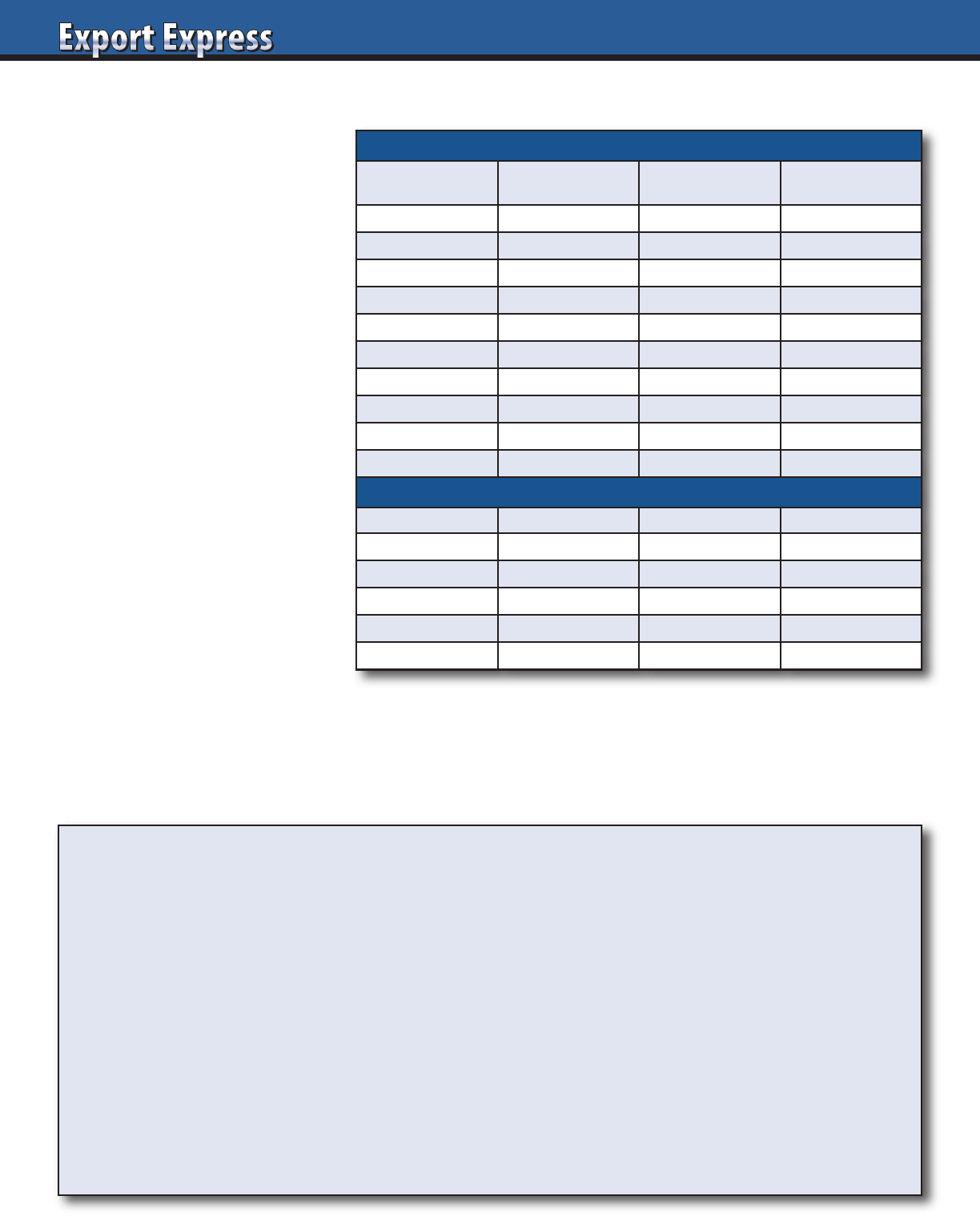
18
Pakistan, Bangladesh, Nigeria, Congo, and Iran
These countries are not for novice
exporters. For most companies, allocation
of resources to accomplish more in China,
USA, Mexico, and Brazil is a better
decision than rushing to plant small
flags in these risky countries. On the other
hand, multinationals with deep pockets
and long term horizons should consider
these markets. Send a company
missionary, hire a local team, expect
the worst and appear pleasantly
surprised when it works out.
21st Century Distributors
Outsourcing will continue as a preferred
route to market option for international
manufacturers. At the end of the day,
companies want to own the brand equity
and are content to outsource distribution
and in some cases production. This
allows them to focus on investments
in brand building versus infrastructure,
particularly in new markets. Successful
distributors will emerge as category/
sector experts versus generalists involved
in many aisles. Distributors must expand
their added value services, leveraging
their unique ability to serve as custodians
of your brand from port of entry to
supermarket shelf. Challenge your
distributors to refine their models to
accommodate exponential growth in the
online retail channel. Today’s distributor
model may be extinct. However, the 2025
distributor service organization can thrive
as an outsourcing solution.
2025 Strategy – Export Solutions
In 2021, I completed projects in 25 countries
across five continents. This provides a
unique, “close to supermarket shelf”
perspective on international development.
In addition, each year, we choose to work
with 1-2 strong European companies on
taking their USA business to the next level.
Looking to create your 2025 international
development strategy? Export Solutions can
help! Contact Greg Seminara in Atlanta,
Georgia. gseminara@exportsolutions.com.
continued from previous page
The World in 2025
10 Growing Countries
Country 2022 Population 2025 Population Increase
Brazil 215 230 +15
China 1,448 1,468 +20
Ethiopia 115 125 +10
India 1,402 1,450 +48
Indonesia 278 292 +14
Mexico 135 145 +10
Nigeria 214 230 +24
Pakistan 227 240 +13
Philippines 112 120 +8
USA 333 344 +11
5 Countries: Flat/Declining Population
Country 2022 Population 2025 Population Decrease
Germany 84 84 0
Italy 60 60 0
Japan 125 123 -2
Russia 146 144 -2
Ukraine 44 41 -3
3 7 Billion people live outside Europe and North America! Everyone eats!
3 Follow Global Retailers: Walmart, Carrefour, Costco, Metro
3 USA Opportunity is “Bigger than BRIC” for most international brands
3 How do you win in your home market? Apply the same principles to large foreign markets:
Research, international factories, local teams, plus investment in Marketing and Trade support
3 Best way to predict distributor success is to evaluate in store visibility for his current brands
3 Big difference between having “any distributor” and a “Best in Class” partner
Greg's Guidance: New World – New Business
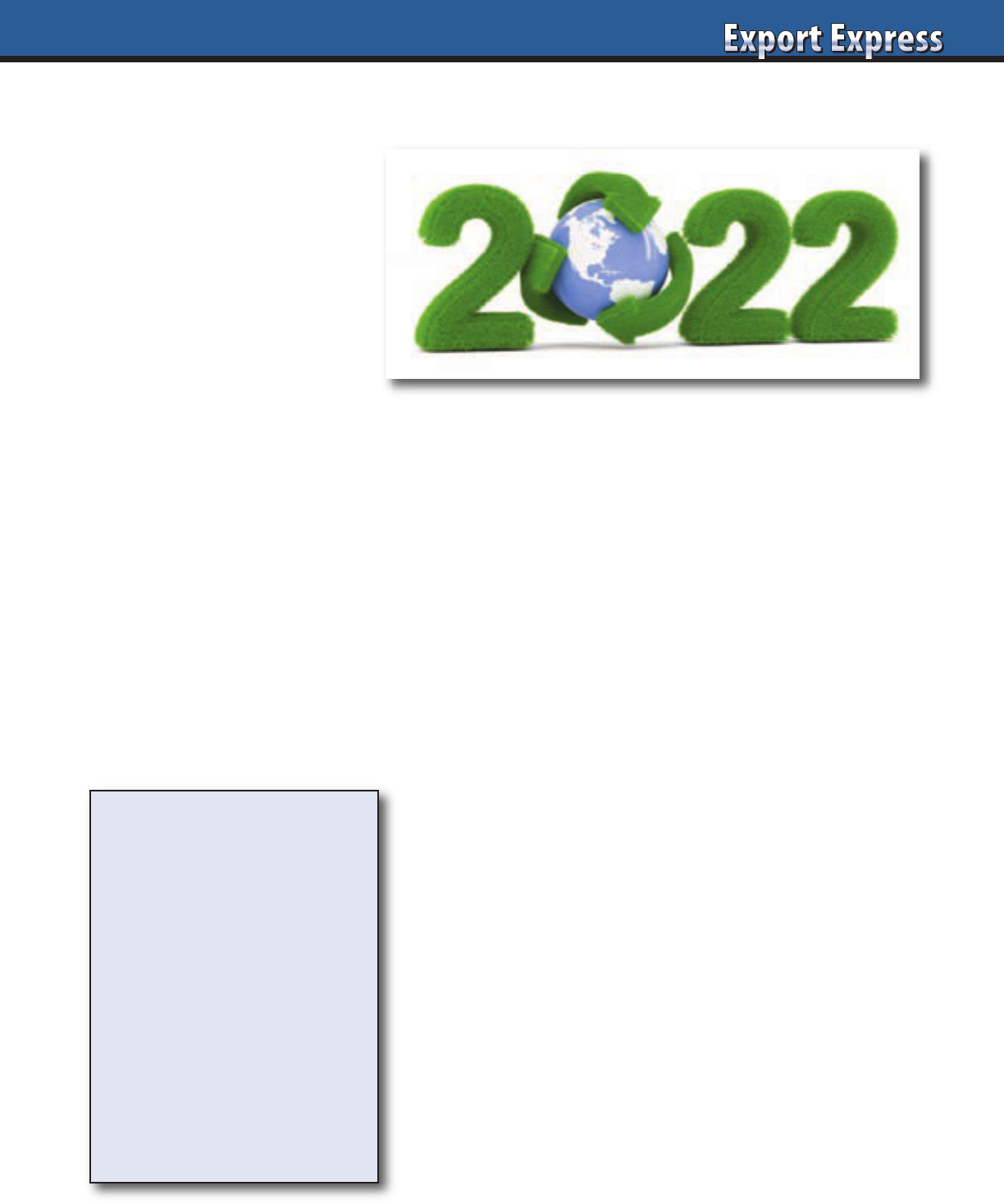
19
How do you forecast for 2022? Most
companies approach cautiously, anxious
to accelerate international expansion, but
hesitant to over commit until it’s safe.
Fortunately, it’s a good time to be in the
food and consumer goods industry. Our
retail customers captured sales lifts averaging
+10% versus 2020. As the vaccination line
creeps forward, we all face the core question
of where to play and how to win in 2022.
Green = Gold
Retailers looking to refresh their assortment
seek brands that demonstrate credible
environmental benefits. Aligning with your
customers’ ESG (Environmental, Social, and Governance) platform
is good for the planet and positive for your business prospects. A
key initiative is to translate your company’s strong commitment to
ESG in your home country to your global partners.
Digital Marketer: #1 Hire
Social media is an effective and efficient way to market to
overseas consumers. Influencers, Facebook marketing, and
YouTube videos are now standard tactics. Exporters’ top hires
should boost your international digital marketing team.
Distributors need help with proven strategies and content to
execute locally. Distributors must also join the digital party,
hiring young people to lead their efforts.
No Copy/Paste: Trade Promotion
Exporters repeat the same boring “price off” trade promotions
year after year. The world has changed, with supermarket chains
looking for creative special offers tailored to their customers, not
the general market. Try something new!
USA: Bigger than BRICs
Most international brands claim sales to USA, but market share
is always tiny compared to potential. USA is wide open to world
food. Our retailer database tracks 370 USA customers, all looking
for unique new food items. The path forward requires that
brands play by USA rules with brokers, slotting fees, and
promotion discounts, supported by a country manager. Don’t
forget Canada – an attractive country with 38 million people.
Middle East is Hot
The price of oil surged in the last twelve months and could
move higher with a post pandemic recovery – good news for
oil rich nations such as Saudi Arabia, Kuwait, UAE, and Qatar.
These countries were proactive and obtained vaccines early.
Saudi Arabia is always the big prize with a population of 35
million, bigger than the other GCC countries combined. Regional
tourism outlook is favorable with Expo Dubai and World Cup in
Qatar in 2022.
Meet the VIPs
Vietnam, Indonesia, and the Philippines contain 500 million
people. Vietnam is a top performer, as companies shift
production from China to a lower-cost production location
and avoid the China-USA trade war. The Philippines maintains
strong ties to the USA. Japan appears attractive for exporters
due to the emergence of a gourmet channel featuring 10 chains
with more than 1,000 outlets featuring wide selections of
international brands.
Tackle a Tough Country
The time has come for some ambitious companies to tackle either
Mexico or Poland. Both countries offer exceptional potential for
those willing to invest in developing a brand the “Right Way.”
This includes consumer research, significant marketing, and
local oversight.
Big Wins: Small Markets
Consider Qatar, Ireland, Panama, and Israel. Small countries
import a higher percentage of their food and most use
distributors. This creates a level playing field for retail pricing
competitiveness. Export Solutions’ database tracks an average
of 84 distributors per country.
continued on next page
Hot Countries
1. USA
2. Saudi Arabia
3. China
4. Poland
5. Mexico
6. Japan
7. Vietnam
8. South Korea
9. Philippines
10. Qatar
Where to Play, How to Win 2022
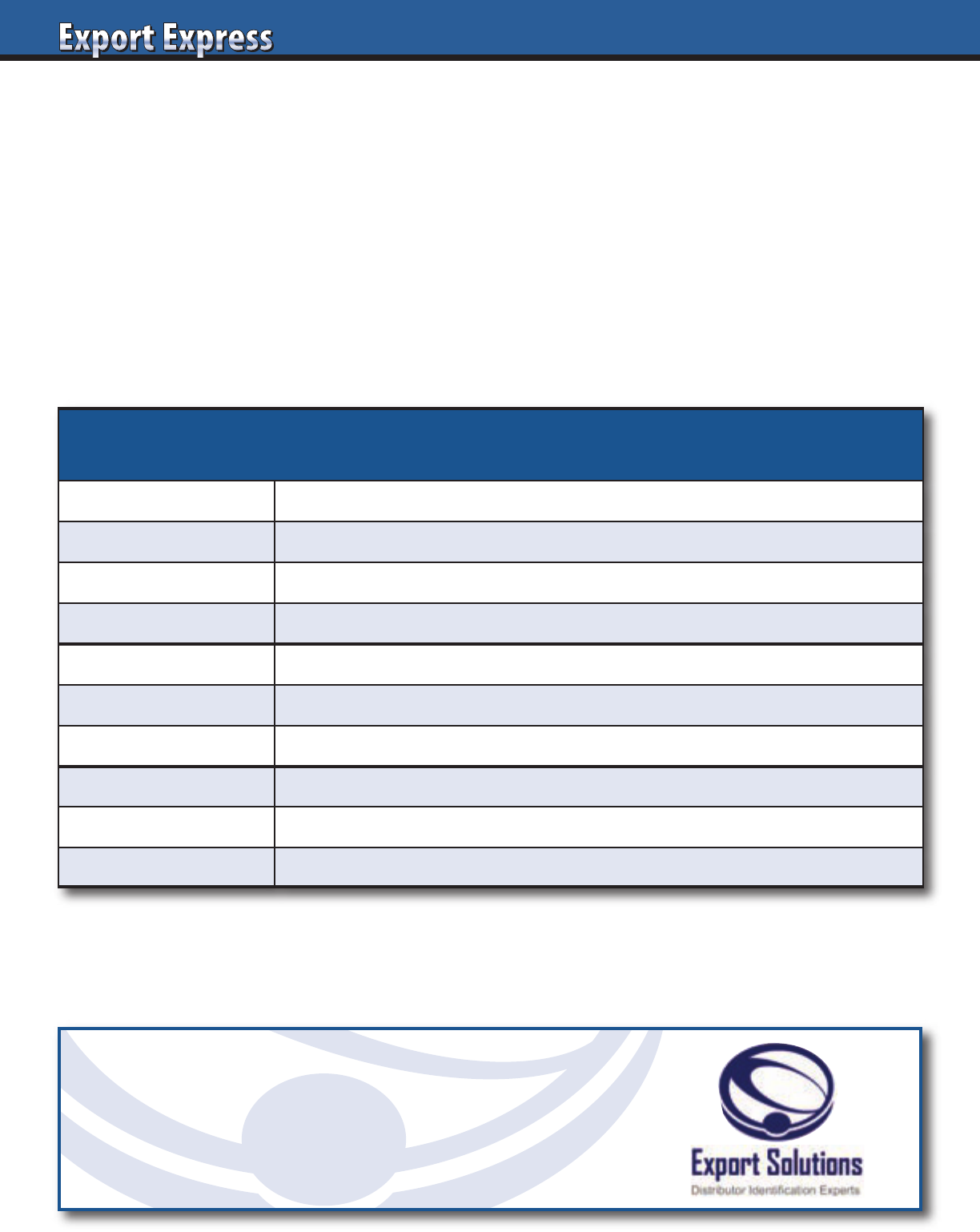
20
E-commerce: 20% of sales?
E-commerce has emerged from niche to mainstream status.
Winning organizations have redesigned their route to market
strategies to incorporate e-commerce and digital marketing for
each element of the business. E-commerce is more than Amazon.
Strategies should incorporate unique requirements to service
“supermarket click and collect,” TMall, Ocado style, and other
platforms. For exporters, it is worthwhile to consider an
e-commerce “first” launch, particularly in Asia.
Export Solutions Can Help
Our distributor database covers 96 countries and more than
9,200 distributors and 2,700 retailers. The current environment
provides a unique window where it’s easier to contact distributors
regarding new business opportunities. Export Solutions has
launched several new programs which allows us to supply
distributor search services via Zoom/Teams meetings.
Where to Play, How to Win 2022
continued from previous page
2022 Winning Stategies
Geographic Accelerate USA Development for Overseas Brands
Saudi Arabia
Mexico or Poland
Vietnam, Indonesia, Philippines (VIPs)
Sales Execution E-Commerce KPIs
Listing Maps – Every Country
In-store Visibility Guidelines. What is a Good Store (vs Bad Store)?
Team Upgrade Underperforming Distributors
Hire Digital Marketing Manager
USA Country Manager (Overseas Brands)
Looking for Good Distributors?
Export Solutions’ database covers
9,200 distributors in 96 countries.
www.exportsolutions.com
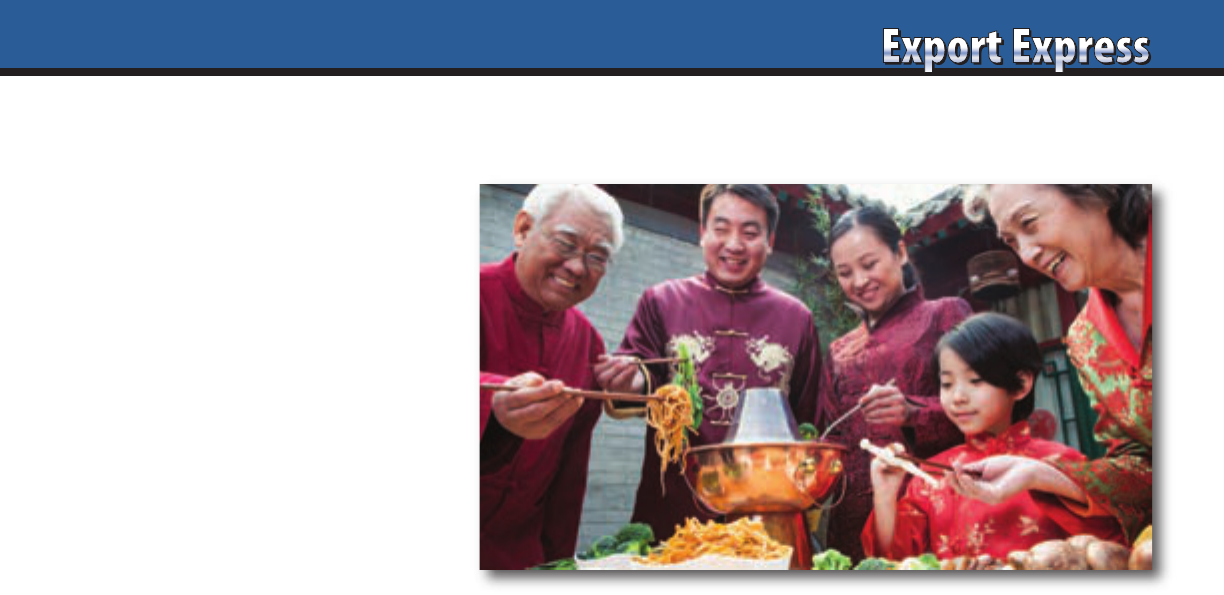
21
Asia’s population exceeds 4.6 billion people,
59% of the global total. “Mouths plus money
equals opportunity.” During the last ten years,
export departments participated in the China
Gold Rush with disappointing results. The
majority of branded food companies sell more
to adjacent markets like Puerto Rico, Ireland,
and Malta than they do to China or India.
The China Syndrome reveals that Asian food
companies have achieved more success
marketing their food to Europe and the USA
than western companies have gained in Asia.
Meal Traditions
Asians enjoy different meal traditions, with
little overlap with western practices such as
cereal at breakfast. Confectionery and snack
products are the exception, as everyone loves
a sweet treat. Asia features multiple cuisines,
with clear differentiations between Chinese, Japanese, Thai,
Indian, Korean, and Filipino food. We learn to appreciate these
geographic specialties through restaurants sprinkled across most
USA and European cities. In Asia, the most common western
restaurants are fast food options like McDonalds, KFC, and Pizza
Hut. These chains do not inspire Asians about our premium
product ranges featured at every supermarket.
Too Big to Ignore
Asia’s population is young and too big to ignore! China and
India are the worlds two most populous countries, with around
1.4 billion citizens each. Indonesia, Japan, Philippines, Pakistan,
Bangladesh, and now Vietnam all boast populations surpassing
100 million. For most companies, it is time to admit that the current
approach to marketing to Asia has not created significant and
sustainable business relative to the enormous potential. Now is
the time to consider new strategies to tap into the most attractive
growth opportunity on the planet.
Asia Best Practices – Local Flavors
Brands like Oreo and Pringles succeed by adapting to meet
preferred taste profiles. Would you be open to trying Pringles
Crab, Seaweed or Raemen Noodle options? How about Oreo
flavors such as Wasabi, Red Bean Cake, or Lychee? Andros
extended their Bonne Maman category knowledge in preserves
to a new brand called GuoLeShi fruit purée. Market research
and consumer testing can reveal innovations more suitable for
appealing to Chinese consumers taste palates. Another source
of revenue may be introducing Asian variants of your product to
your home market. This creates product news and may position
your company as on trend to young consumers looking for more
adventurous food choices.
E-Commerce
China e-commerce represents twenty percent of total retail sales
of consumer goods according to Fung Business Intelligence. This
figure surged sixteen percent in 2020 and is expected to further
accelerate in 2022 due to reaction to the corona virus outbreak.
South Korea and other countries are leaders in e-commerce
development. Brand owners may elect to execute an e-commerce
only strategy in Asia, skipping expensive listing fees and in-store
marketing requirements. Today, there are sales organizations and
marketing agencies dedicated to the e-commerce channel.
M & A Beachhead
“If you can’t beat them, buy them.” One strategy is to acquire
a local participant in your category. Leverage their existing
infrastructure, route to market, and production facility to launch
your own premium brand. An interesting alternative is to
purchase (or invest) in a manufacturer in Malaysia or Philippines
and use that as a launch pad into other Asian countries. Inter-
Asia trade in the food business is booming, significantly
outperforming European and USA exporters. Warning! We all
recognize the perils of acquiring companies in China and India.
Foodservice – Window to the World
Western brands normally focus market entry on modern trade
retail channels, especially supermarkets. Consideration should be
given to early marketing activation in the foodservice segment.
This creates awareness of your brand and food pairings in an
authentic environment. This plan may include promotions at
restaurants specializing in your cuisine or five star hotels that
feature special nights dedicated to world food.
Asia Success Recipes
continued on next page

22
Help Wanted – Your Team
CEOs speak of the importance of Asia, then assign one
manager from the head office to manage the entire region.
Winning requires advance investment in local teams, even
when working with distributors. Regional managers in expat
friendly spots like Singapore, are now supplemented by country
managers in more affordable locations like the Philippines
and Indonesia. China success is directly proportional to your
investment in multi-functional professionals based in Shanghai,
the primary commercial hub for our industry.
Costco Success Story
Costco appears as an important market factor in Japan, S. Korea,
and Taiwan. Costco maintains 26 clubs in Japan, 16 in Korea,
and 13 in Taiwan, representing some of the top performers
systemwide. Costco’s Shanghai store surpassed optimistic
expectations, with more than 240,000 paid members in the first
six months of operation. USA brands may consider a partnership
with Costco International as a new source of revenue. This
minimizes complexity, but may provide retailer pricing issues
later, if you decide to expand to other market customers.
Good Morning Vietnam
Vietnam’s population should exceed 100 million this year. GDP
is projected to continue to grow around seven percent. Many
industrials are shifting production to Vietnam due to lower labor
costs and to avoid tariffs associated with the USA-China trade
war. The Vietnam retail environment is evolving quickly. Start
now, before it’s too late!
Japan Gourmet Channel
A gourmet and specialty retailer channel has emerged in Japan
featuring more than 2,000 stores. These retailers specialize in
premium food brands, many from overseas. Their marketing
position is to offer high quality European and USA brands not
available at traditional supermarkets. These chains include Kaldi,
Seiju Ishi, and Meidi-Ya. Japan is receiving new attention in 2022
due to the popularity of this channel which serves as a gateway
to Japan’s population of 126 million affluent citizens.
Think Malaysia & Taiwan
Historically, exporters targeted wealthy expat bases such as Hong
Kong and Singapore. Today, these are considered small, mature
markets, with heart stopping cost of entry and brand building fees.
As an alternate, consider Malaysia with 32 million people and
Taiwan with 24 million.
India – Co-Pack?
India is difficult to penetrate for all exported brands. Regulations,
tariffs, and supply chains designed to protect 10 million small shop
owners all appear as significant barriers to entry. One solution is to
pursue an Indian co-pack operation or partner. This allows you to
localize input costs and offer more competitive price points. Your
manufacturing partnership must include direct technical oversight
to insure compliance with your company standards. India is not
easy, but following the traditional export model will not allow
you to capitalize on this enormous opportunity.
South Korea – Often Bigger than BRICs
2021 USA confectionery exports to South Korea ranked fourth
in the world, exceeding China and India combined. South Korea
is open for business, with strong retailers such as E Mart and
Lotte. Export Solutions tracks 134 distributors in our South
Korea database.
Export Solutions Can Help!
Export Solutions is active in Asia, with distributor search
projects across every major country in the region. Our
distributor database covers 1,948 distributors across 17 Asia
Pacific countries from Australia to Vietnam. Contact Greg
Seminara at gseminara@exportsolutions.com to discuss your
Asia development plans.
Asia Success Recipes
continued from previous page
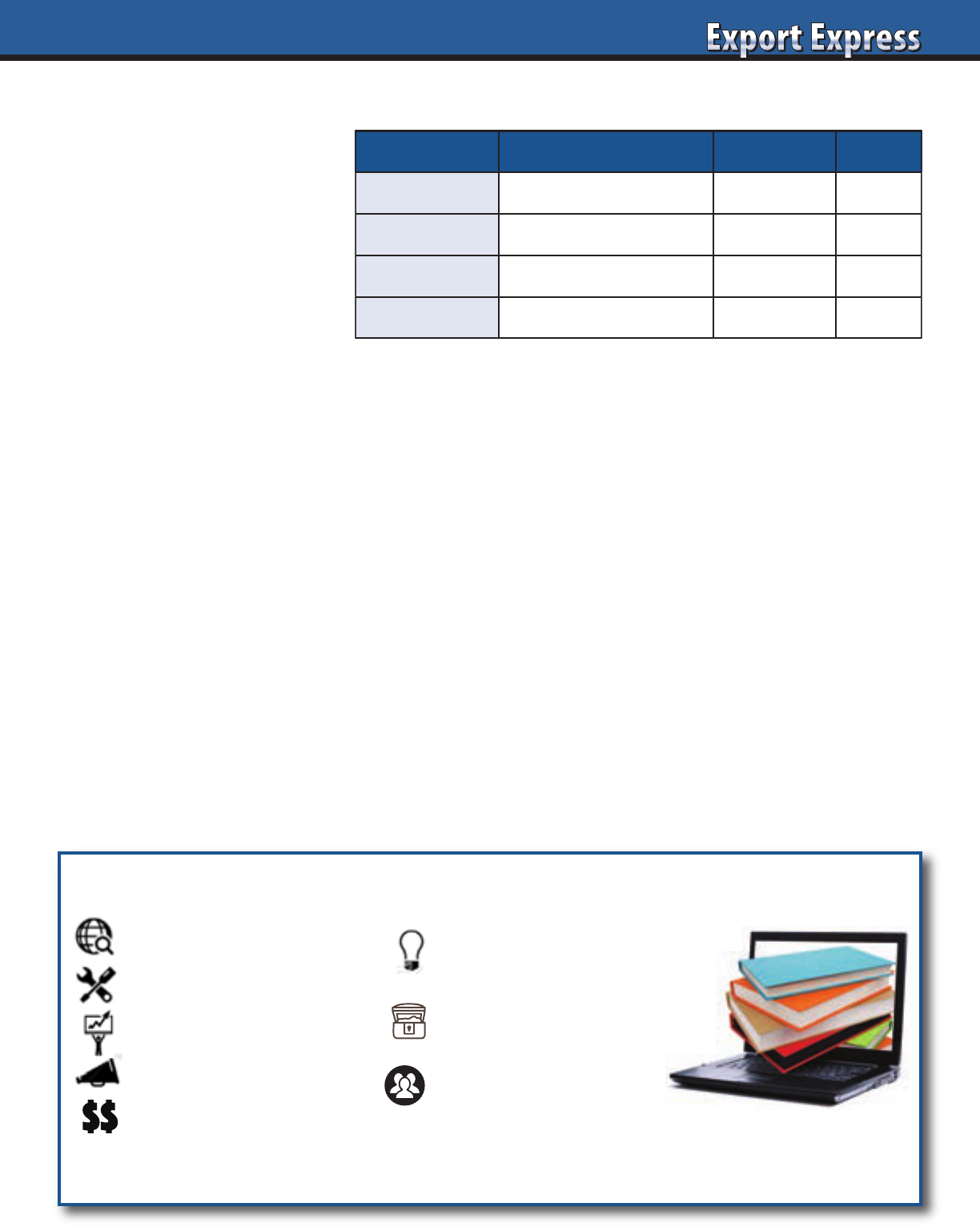
23
Spotlight on the Caribbean
Would you be surprised to learn that
most USA companies sell more to
Puerto Rico than Brasil or China? Our
neighbors in the Caribbean serve as
important customers for USA brands.
These tourist destinations depend on
USA imports for essential food, beverage,
and personal care products. These
markets are easy to access with USA
packages universally accepted.
Country Segmentation: Core 4
The Caribbean consists of more than
700 islands across 28 nations. However,
80% of sales are concentrated in Puerto
Rico, Dominican Republic, Trinidad, and
Jamaica. Puerto Rico is the “big prize,”
accounting for around one percent of total
USA volume for most manufacturers.
Puerto Rico and the Dominican Republic
feature large supermarkets bursting
with a mix of America’s favorites and
local brands.
Foodservice: Small Packs
Tourism appears as an important
component of the economy for many
of our favorite islands. This causes
populations to surge during peak
vacation months. Your foodservice
business could be larger than your retail
business in popular holiday spots like the
Dominican Republic or Jamaica. Consider
small sizes to capture lower price points
and short-term renters who need only
one week’s supply.
Powerful Distributor Options
Some of the largest and most
sophisticated distributors in the world
are based in Puerto Rico. Distributors
serve as the top suppliers to the trade.
Few companies maintain subsidiaries
in these small countries. As a result,
distributors may represent companies
like P&G, Unilever, and Mondelez. These
distributors are trained by these global
leaders, adopting many of their operating
practices and philosophies.
Miami Consolidation Hub
A common practice is to ship to Miami
for regular freight service or distributor
pick up. Pricing is a key issue. Most
offer export pricing to avoid burdening
the value chain with USA overheads
that need to be replicated overseas.
Careful oversight must be exercised
to avoid diverting temptation. A simple
metric is to track sales per capita versus
mainland USA levels. Do not believe
stories about cruise ships, duty free, and
the infamous San Andres islands with
two supermarkets.
Winter = Peak Season
Caribbean sales surge during the winter
tourist season. This requires inventory
build up in September and October.
Normally, summer months are slower
and dedicated to planning.
Export Solutions Can Help
Export Solutions’ distributor database
covers nine top island markets and
around 300 distributors of supermarket-
type products. Export Solutions
completed six distributor search projects
in the Caribbean. Brands work with us to
quickly partner with leading distributors
and begin profitable shipments to these
“low hanging fruit” countries. Contact us
to learn more about how Export Solutions
can leverage our distributor contacts for
your benefit in 2022.
Cluster Islands Population Focus
Core 4
Puerto Rico, Dominican Rep.,
Trinidad, Jamaica
18 million 80%
3 B's
Bahamas, Bermuda, Barbados 750,000 15%
Tiny Paradise
Aruba, Martinique, St.Lucia,
20 Total
1.8 million 5%
Populated/Poor
Cuba, Haiti 23 million ?
Create Your Own Export Library
Distributor Search Guide
Export Handbook
Selling to USA Handbook
Distributor Management Guide
Finance & Logistics
All guides available free at www.exportsolutions.com in the Export Tips section.
Idea Guide:
New World – New Business
Export Treasure Chest
My Favorite Templates & Forms
People Power
Strong Teams Build Great Brands
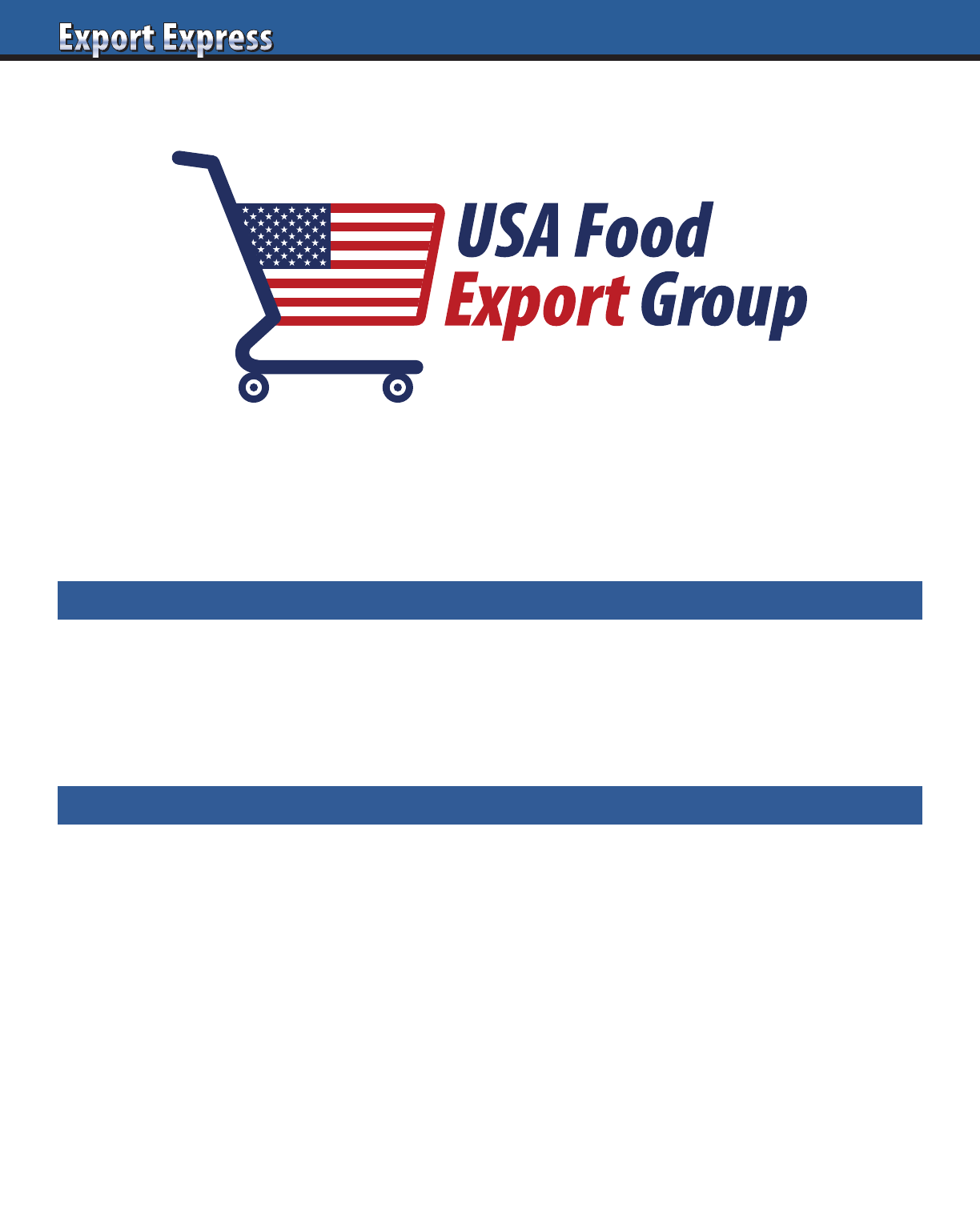
24
Introducing
America’s Favorite Brands
Executive Board
Export Solutions Smucker’s Tabasco
Greg Seminara, CEO Danny Berrios, President Megan Lopez, Vice-President
General Mills Sun-Maid
Eric Saint-Marc Carsten Tietjen
Advisory Board
Bazooka Candy Blue Diamond Bob’s Red Mill
Santiago Ricaurte Dale Tipple Jan Chernus
Bush Beans Campbells Church & Dwight
Dave Bauman Julio Gomez Arun Hiranandani
Ferarra Candy Heartland Idahoan
Daniel Michelena Tom Theobald Ryan Ellis
Johnsonville Sausage Kao USA Keurig Dr. Pepper
Cory Bouck Julie Toole Billy Menendez
Mizkan Reynolds Welch’s
Noel David Chris Corey Marc Rosen
19 Companies | 200+ Top Brands | $80 Billion Combined
View our activities for export managers – www.usafoodexport.com
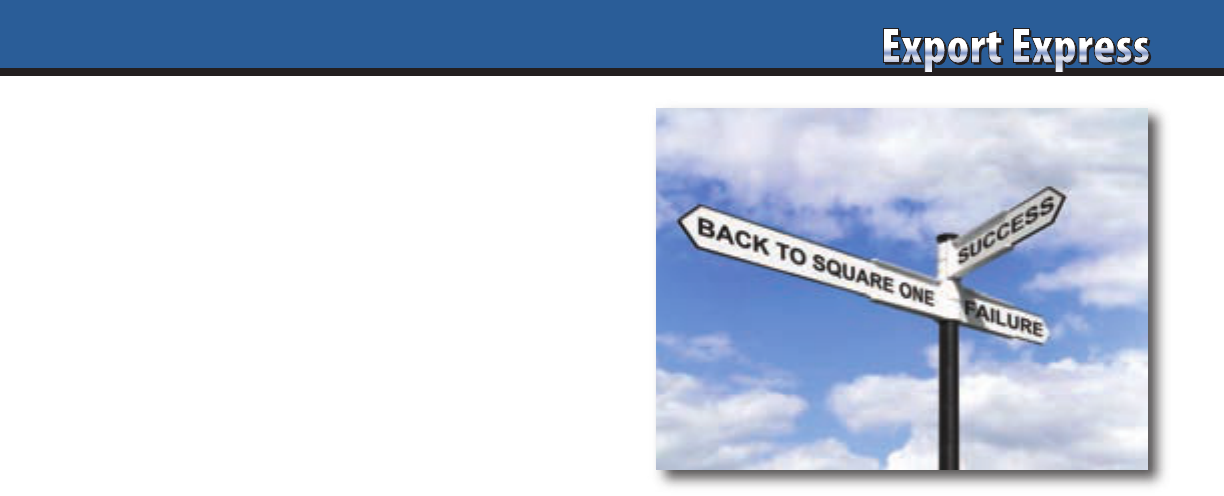
25
Export represents a dynamic growth
opportunity for most companies.
However, most companies make
mistakes, particularly in the early cycles
of their export development. Listed below
are some common mistakes:
1. No Category Research
Some companies assume that their
category development is consistent
everywhere. They fail to conduct basic
research on competitive dynamics and
pricing. This research can be as simple
as a day of store checks in your target
market. I remember having an argument
with a leading producer of branded
Indian Food about export opportunities
to Latin America. He refused to believe
that the market for Indian food was so
small, because he had not conducted
research or visited the market. Do
your homework!
2. Limited Investment
in Marketing & Trade Spending
Few brands are so innovative and exciting
that they will sell without investments in
consumer awareness activities and trade
incentives. Yet, many exporters believe
that they can offer a “net price” and
a distributor will create a significant
business, without support. There is
a cost of doing business in every
market. Ultimately, your results will
be directly proportional to your
marketing investment.
3. Another “Me-Too” Product
Innovation sweeps the world at a rapid
pace. Manufacturers fail when they do
not create a unique selling proposition
(USP) for their brand. Why is your
product different versus current options?
Is the differentiation meaningful? A
better price (value) or heavy marketing
investment can also differentiate your
brand. I recently visited Europe’s largest
food trade show. I saw a “lonely”
exhibitor from the USA with little interest
in his commodity food products. Why
would a European retailer or distributor
want to import a product that can be
sourced locally at a better price?
4. Pricing is Too High
On many export projects, the price to
the consumer can be twice the price from
your home market, by the time that you
add in logistics costs, duties, distributor
margins, and taxes. Yet, much of export
growth is sourced
from emerging
markets, where
spending power is
low. So, the result is
high priced product
being marketed to
people with limited
funds. In many cases,
the consumer will pay
a premium (10-30%)
for a quality, imported
product. However,
once your product
is priced 50% or
higher than the local
competition, you are just appealing the
top 10% of the population in most cases.
5. Product not Labeled in the Local Language
English is a global language, but
obviously your brand will obtain a better
reception if it is labeled in the local
language. Many countries have laws
requiring labels or at least nutritional
information in the local language.
Another similar issue is that some brand
names do not translate on a global basis.
What does your brand name mean in the
local language? Does it sound similar to
something else which has no correlation
to your brand?
6. Insufficient Due Diligence during the
Distributor/Partner Selection Process
I am amazed at the number of
relationships based upon only a short
meeting at a trade show. I love trade
shows and believe they are a great
place to meet prospective distributors.
However, you must conduct due
diligence on your prospective partner
in their home country, before beginning
your relationship. This includes
interviewing the distributor as well as
other candidates at their local offices.
Visit the stores to see their performance
for their current brands. Conduct
reference checks and run financial checks
with Dun & Bradstreet or similar credit
check agencies.
7. Diverting – New Customer
Pick Up at your Plant
Export managers are flooded with
requests by distributors/buyers wishing
to purchase well known brands. Many
of these inquiries are legitimate, but a
significant percentage are from diverters.
I’ve written a separate article on this
subject, so I’ll only share a few comments
here. If your export price is less than your
standard price, display extreme caution
in dealing with new distributors/buyers.
Complete the required “Due Diligence”
referred to in point 6, including a visit to
the distributors warehouse. Do not allow
pick up at your plant or at a local port by
a new distributor, if your price is lower
than your standard price. Ship to the
distributor product labeled in his native
language and be cautious about promises
to sticker the product at the port.
8. No Focus on the Shelf
Too many exporter/distributor
discussions concentrate only on container
shipments and orders. A critical element
is the need to focus on activities to
generate consumption. Some export
projects fail, because the exporter does
not dig deep to track progress against
fundamentals of acceptance at major
retailers, assortment, pricing, shelving,
and merchandising at store level.
9. Exporter Fails to Visit the Market
The internet has facilitated global
communication. However, there
is no replacement for a periodic, face
to face, market visit to discuss issues
and measure progress. “Out of sight…
out of mind.”
10. Unrealistic Expectations
Exporters are optimistic by nature.
Launch plans project volumes based upon
category size and the famous statement
“If we secure only a 10% market share…”
You know the rest of the story. Reality is
that the 10% market share is possible, if
you focus on avoiding the mistakes
discussed in points 1-9 above. Good luck!
Ten Tips – Common Export Mistakes
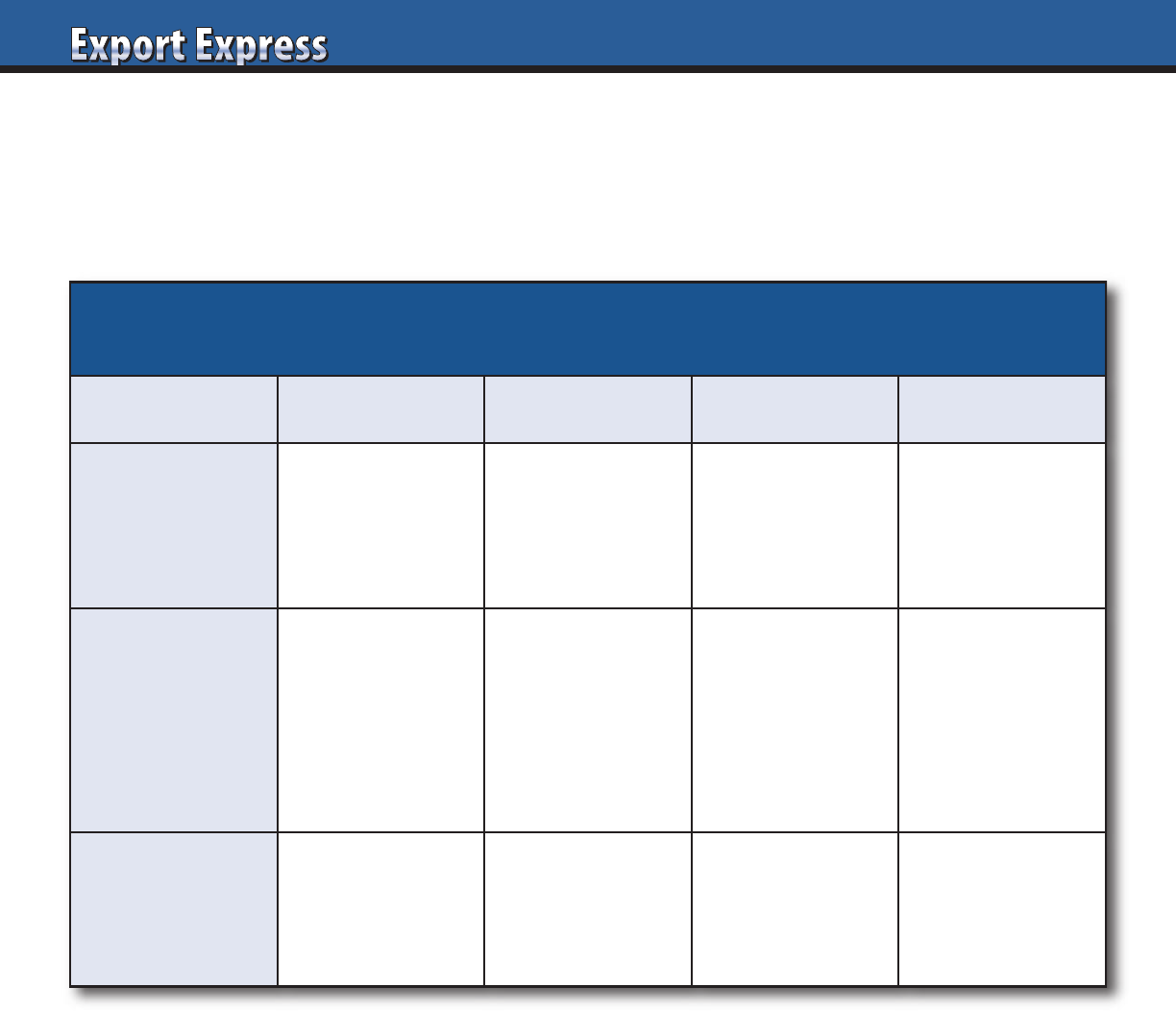
2626
Segmentation Factors
Segmentation analytics will vary by company. Absolute
population is just one factor warranting consideration. Other
criteria include size of the category, proximity to your producing
plant, as well as per capita spending power. For example, most
USA based exporters sell far more to Puerto Rico, an island with
3.1 million people, than they do to China or Brasil. As a result,
some USA brand owners place a strategic focus on the Caribbean
Basin countries adjacent to the USA and process only occasional
opportunistic shipments to complex countries such as China.
Mix of Countries
Most companies can dedicate focus on a strategic launch into
only one or two “strategic” countries at a time. It’s appropriate
to create a growth plan aimed at a mix of Strategic, Priority,
and Opportunistic countries.
Market Share Expectations
Your export road map should also be adjusted based upon your
market share expectations for a select market. Generally, there
are three scenarios for a brand to pursue.
Leader: Brand investment and innovation to become #1 in
the category.
Player: Brand plans to compete effectively, obtaining a market
share of 5% -20%.
Participant: Niche. Brand objective is incremental shipments
with little/no investment.
Lessons Learned
Calibrate expectations to investments in brand support and
management oversight. Everyone wants to be a category leader
or player. To achieve this lofty status, you need to conduct local
market research, innovate, maintain competitive pricing, invest
in marketing, and align with a strong sales team just as you do
in your home market. Projects fail as certain brands want
category leadership but invest only to “niche” levels.
Strategic segmentation of export opportunities is “Job One” for export managers. Export Solutions divides countries into three gr
oups:
Strategic, Priority, and Opportunistic. This approach filters countries by “size of the prize” and investments required to win. The basic
rationale is that a company should allocate different resources to develop a large country like Brasil, compared to a medium size
country like Belgium versus the Bahamas or Bermuda. Too frequently, we see companies handcuff all markets to one export program,
with common strategy, pricing, and investment models for all countries.
Country Segmentation – One Size Does Not Fit All
Country Segmentation
Country Profile Investment Required Business Model Examples
Strategic
(Focus)
Large Country
(pop. 50mm +)
High GDP
High Category BDI
Global Retailers
High Complexity
Significant Investment
in Brand support.
Market Research
Management Visibility
Local Office or
Distributor or
Joint Venture
Mexico
China
Brasil
United Kingdom
USA
Turkey
Priority
(Manage)
Mid size Country
(pop. 10 mm+)
High GDP
High Category BDI
Mid Complexity
Moderate investment in
brand support.
Managed by Export
Manager
Distributor
Chile
Australia
Canada
S. Korea/Thailand
South Africa
Spain
Saudi Arabia
Opportunistic
(Profit)
Profitable
Opportunities.
Low GDP Countries
Low Complexity
Minimal/no investment
in brand support
Distributor or
Direct to Retailer
Caribbean
Central America
Middle East
Africa
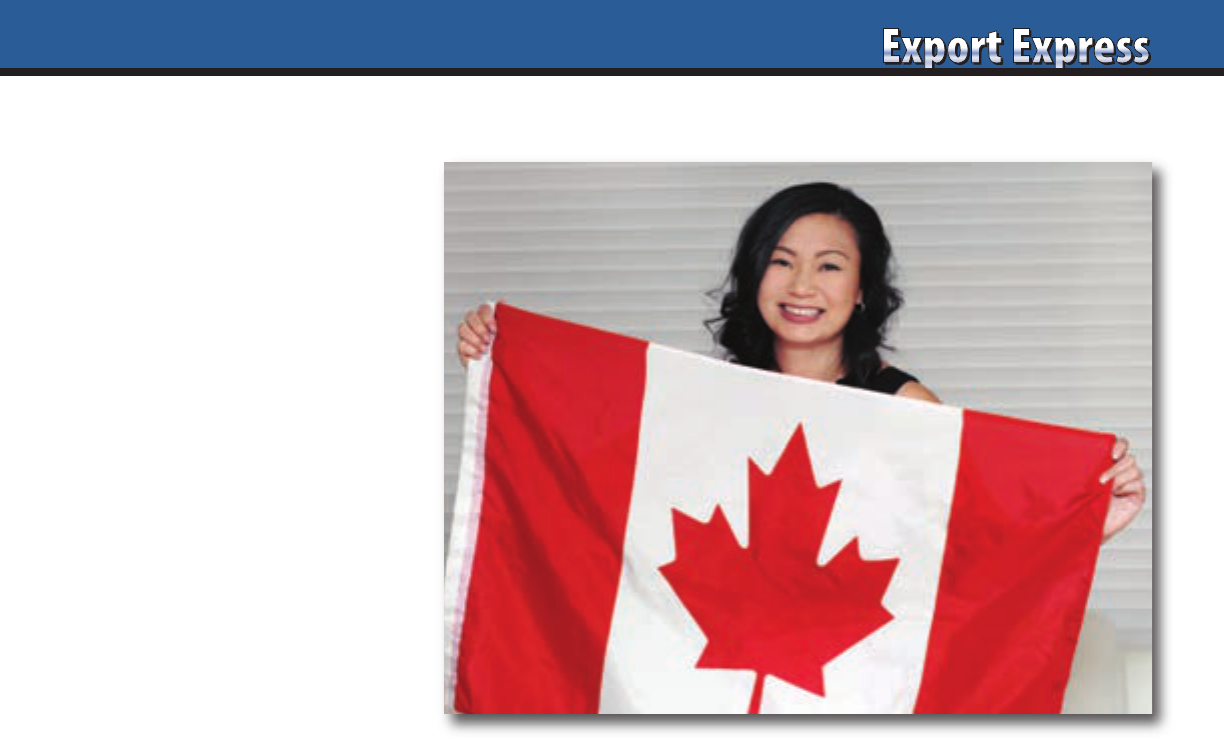
27
Are you selling more to China or Canada?
China and the BRICs represent a big
disappointment for most exporters. Ten
years ago, a gold rush started, with brand
owners dreaming of selling to just one
percent of China’s 1.4 billion population.
Veteran export managers long ago deleted
those optimistic presentations with
ambitious volume targets for China,
India, Russia, and Brasil. The stark
reality reveals that eating habits remain
dramatically different in China (and
India). BRIC countries like China are
complex and largely self sufficient,
feeding their own nations. This leaves
little shelf space for premium foreign
brands with different taste profiles
unless they are supported by massive
advertising budgets.
Fab 5
Exporters enjoy greater success targeting
mid-size countries more dependent on
imports for their food requirements.
Export Solutions recommends 2022 focus
and expansion in Canada, Malaysia,
Morocco, Peru, and Saudi Arabia. 2022
represents the year to adjust resource
allocation to our Fab 5 countries. These
five countries all maintain populations
between 30-40 million people and a
history of openness to international
products. Many companies claim sales
to Fab 5 countries. However, my
experience suggests that sales levels
usually lag significantly below potential.
Fab 5 appear as strong candidates to
contribute a good return on your
incremental investment and focus.
Canada – Melting Pot
Canada’s GDP ranks tenth in the world,
larger than Russia, Spain, or Australia.
Canada’s population surpassed
38 million, + 10% in the last ten
years. Canada’s growth is fueled by
immigration from Asia and Europe
(Italy). Asian and European brands
perform well, as Canadian newcomers
are often “first generation,” still homesick
for their favorite brands. Most exporters
know of leading retailers such as
Loblaws, Sobeys, and Metro. The “big 3”
supermarket chains operate multiple
formats competing across far flung
provinces of Canada, supplying many
places to get started with your bilingual
package. Export Solutions databases offer
excellent coverage of Canada, including
86 retail customers and 205 international
food distributors. Canada: worth a fresh
look in 2022!
Malaysia – Land of Gold
There may be riches to be discovered in
Malaysia’s supermarket shelves, although
gold is no longer mined in the country.
Malaysia is a bright spot in Southeast
Asia, with a population of 33 million and
GDP growth averaging 5% percent since
2012. Malaysia benefits from its proximity
to Singapore, its small but prosperous
neighbor. Malaysia’s retail segment is
dominated by multinationals such as
Tesco and Cold Storage (Dairy Farm).
A strong distributor community exists,
with 128 distributors of all sizes and
specializations, ready to serve as your
route to market partner.
Morocco – Magnet
Over 11 million tourists arrive each year
to the experience the magic of Morocco.
Morocco is a peaceful country, hugging
the northwest African coast, close to
Spain. Population exceeds 37 million
people, with stable GDP growth
averaging 4 percent. I visited last year,
and checked impressive hypermarkets
from Carrefour and Marjane, a chain
owned by the king. The Morocco
opportunity is amplified by the
foodservice channel, catering to the
tourists as well as a local population
familiar with nearby European brands.
Peru – Latam Star
Peru stands out as a star in Latin America
business development, approaching
Chilean status as an outpost of
dependability. This appears as a
refreshing alternative in a continent
dominated by the political and financial
turbulence of its bigger neighbors in
Brasil, Colombia, and Argentina. Peru
will host 4.5 million tourists this year,
lured by Machu Picchu. Lima has
emerged as a gastronomic capital, with
three of the world’s top fifty restaurants.
Export Solutions maintains good
familiarity in Peru, through three recent
distributor search projects and coverage
of 82 distributors in our database.
Saudi Arabia – 50% of the Gulf
Most companies sell to Saudi Arabia, but
few approach their true potential in the
richest country in the Gulf. Normally,
Saudi Arabia should represent 50 percent
of your total Mid East business, if your
sales are proportionate to population
and the opportunity. This tends to be
Hot Countries 2022: China or Canada?
continued on next page
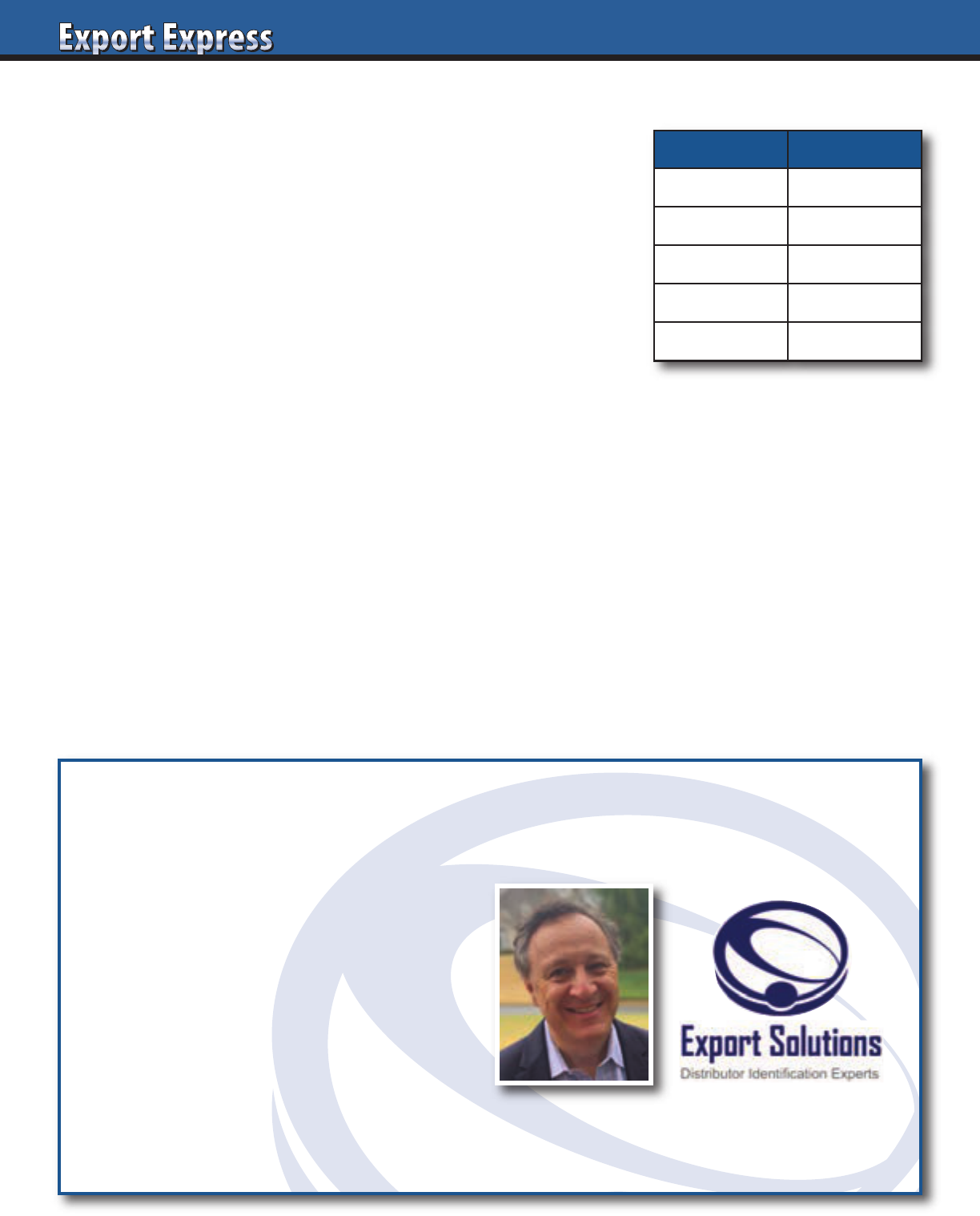
2828
Hot Countries 2022: China or Canada?
three times the level of tourist friendly
Dubai. Why Saudi? Saudi boosts a
population of 36 million and the worlds
second largest oil reserves. Saudi Arabia
is an affluent country, with the
government providing jobs, education,
and other subsidies for their citizens. 2022
outlook is mixed, based upon the plunge
in oil prices. Still, tremendous upside
exists for most brand owners. I am always
fond of Saudi Arabia, as I worked there
for three years for a large FMCG and met
my Irish wife at a wine tasting party!
USA – Bigger than BRICs
The USA development opportunity is
the largest single priority for European
brands. All European brands sell to the
USA, but volumes are usually quite
modest relative to the potential. USA
features ten different trade channels and
more than 300 retailers. Many chains are
open to innovative products from
overseas, as long as the manufacturer
“does his homework” by supplying true
category innovation. Trade promotion
investments and payment of listing fees
are mandatory in most cases. Normally,
I urge my European clients to “start
small” in the USA, focusing initially on
ten northeast USA chains with 30-150
stores each. Hire your own USA business
manager to work with local brokers and
optimize your investments in critical
trade promotion activity. Initial success
validates the phase two investment levels
required to compete effectively on the
shelves of larger retailers such as Kroger,
Ahold, or Publix.
China – Lessons Learned
Multinationals like Coca Cola, Starbucks,
Nestlé, Ferrero and Procter and Gamble
can point to China as their top global
priority. Unfortunately, I struggle to list
many (any?) smaller companies that are
generating important tonnage in China
on an export basis, even after ten years
or more of trying. Factors limiting
development include a strong
preference for local foods (except
Confectionery/Snacks), lack of strong
distributor options and requirements
to have large teams of people in country
to attack the opportunity. Emarketer
estimates that e-commerce represented
52% of sales in 2021, with brick and
morter retailers declining by 18%.
This also changes the playing field
beyond the capabilities of most overseas
based brand owners.
2022 Guidance
There are no easy answers in the world
of export. If export was easy, they
wouldn’t need us! Export Solutions
advocates consideration for business
improvement in attractive Fab 5 countries
which offer good upside with more
limited investment and complexity than
China and India. The USA appears as a
high priority for many in the 2022 post-
Brexit world. USA winners must play
the USA game, with USA factories (or
copackers) paired with local brokers and
a channel specific strategy. Export
Solutions can help!
Talk to an Expert
• International Strategy Road Map
• Fix Problem Markets
• Entry Plans
• Find Distributors in 96 Countries
• Export Workshops
• Motivational Meeting Speaker
Contact Greg Seminara at (001)-404-255-8387 to discuss your business development project.
www.exportsolutions.com
continued from previous page
Population (millions)
Canada 38
Malaysia 33
Morocco 37
Peru 34
Saudi Arabia 36

29
Oops. Companies that targeted
BRIC countries as the cornerstone
of their international strategy suffer
disappointing results. Brazil and Russia
appear deep in recession, India is labeled
as a persistent underachiever and the
China Express has slowed. The mid-term
outlook does not improve.
Brazil’s structural complexities represent a significant barrier to entry and
the currency devaluation versus the dollar places the price of imported
brands now out of reach for most. Russia was a “borderline BRIC” to begin
with. Russia should recover somewhat with the price of oil, but the fundamental fact is
that Russia’s population will decline by 4 million people by 2025. India remains tough
to conquer, except for multinationals with bundles of money. However, the Nestlé Maggi
noodle scare sent shock waves, causing big investors to think twice.
China is the big prize, with millions moving permanently into the middle class and
shopping at modern supermarkets filled with international brands. The Chinese love
imported Confectionery, Snacks and Beverages, but have been slow to embrace other
“Western” Foods. Marketers need to teach Chinese consumers about their categories
and conduct research to learn to adapt their brands to Chinese taste profiles.
Listed below are Export Solutions’ insights to reduce dependency on “Broken BRIC’s”
to new sources of future growth.
1. USA opportunity is “bigger than BRIC’s” for European exporters.
With the dollar trading near parity vs. the Euro, this is the time for Europeans to
develop the USA. Treating the USA as another export market will result in failure.
Please approach the USA in the “American” way by hiring an experienced USA broker
manager based in a place like Chicago or Atlanta to navigate the system. Test your
product with mid-size chains, investing in consumer activities and trade promotions.
2. Mexico is Hot!
Mexico’s population will pass 135 million soon, passing Japan to be the 11th largest
country in the world. Mexico’s economy is a star in Latin America, as it serves as a supply
depot to the USA. Many auto and industrial manufacturers produce in north Mexico, a
short stroll to the USA market, avoiding month long shipping backlogs from Asia. This
translates to increased spending power and an expanding Mexican middle class.
3. Target the VIP’s: Vietnam, Indonesia & Philippines
These high growth countries will exceed 500 million in population by 2025. USA exporters
are discovering the Philippines due to the 107 million population with good acceptance
of USA brands. Myanmar is worth a look, with a new government and a population of
54 million. I have visited Myanmar twice and am optimistic about the future.
4. Hire a Team for China
Winning in China requires a team effort. The battle has shifted and “over achievers” place a
team of local sales, marketing, and research professionals on the ground to build the business.
This is true even when you are working with a distributor. Don’t rush to follow the pack to
“Tier 2” cities until you have completed the job in major supermarkets in Shanghai, Beijing,
and Shenzhen. China holds great potential, but you will be lost managing from home office.
Brand owners face difficult choices on where to place “big bets” on new market development.
BRIC disappointments provided expensive lessons on the long term process of changing
eating habits in emerging markets. Our island market success stories remind us that export
business contains a mix of giant countries and smaller, profitable nations. Senior management
must be willing to admit “we've failed” if you have small businesses in pivotal countries like
China, USA, and Mexico. Frequently, the answer is to treat these big countries like your home
market with investments in product innovation, local factories and fully staffed teams.
www.exportsolutions.com
Some BRIC’s are Broken
Greg Seminara
gseminara@exportsolutions.com
404-255-8387
“Spend Time Selling to Distributors versus Searching for Distributors”
Strategic Services
Contact Us for
Export Solutions
1. Identify Best in Class
Distributors: 96 Countries
2. Best Practices
Export Strategy
3. Distributor Management
Workshops
4. Export 101:
Let’s Get Started
5. New Market
Prioritization
and Launch Plan
6. Personal Distributor
Introductions:
96 Countries
7. Walmart International
8. Distributor Contracts,
Margins, and Fees
9. Meeting Speaker
10. International
Strategy Expert
Strategic Services
Contact Us for
Export Solutions
1. Identify Best in Class
Distributors: 96 Countries
2. Best Practices
Export Strategy
3. Distributor Management
Workshops
4. Export 101:
Let’s Get Started
5. New Market
Prioritization
and Launch Plan
6. Personal Distributor
Introductions:
96 Countries
7. Walmart International
8. Distributor Contracts,
Margins, and Fees
9. Meeting Speaker
10. International
Strategy Expert
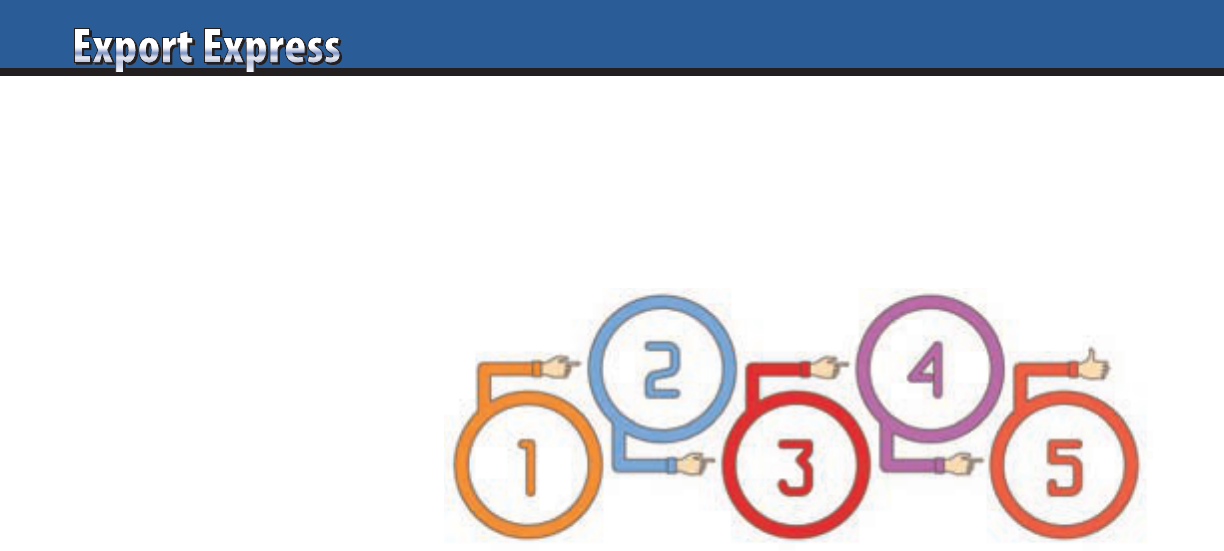
30
Can you resist the temptation to sell to
the biggest retailer in a new country
first? Multinationals armed with barrels
of money and stacks of market research
attack all retailers with a high profile
market entry plan for their new products.
More likely that your company supplies
you with a beloved local brand and a
small checkbook to invest wisely. What
is the logical route forward for exporters
of favorite brands from the USA, UK,
Germany, Brasil, Mexico, Japan, etc?
Listed below is Export Solutions’ 5 step
plan to translate your niche item to mass
market success in overseas countries.
Step 1: Sell to Homesick Consumers
There are six million USA expatriates
abroad and also 6 million UK citizens
found outside Great Britain. On a broader
basis, there are 80 million people of
Italian heritage living outside Italy,
including about 17 million in the USA,
almost equivalent to the USA’s entire
Asian population. 92 million foreigners
claim ties to Great Britain, including
17 million people living in Australia
and 12 million in Canada. These statistics
apply to almost all countries who can find
their citizens dispersed around the world.
These homesick consumers are desperate
for their favorite brands from back home.
Frequently, they will shop at stores
dedicated to treats from home such as
Taste of America in Spain or the wide
array of British delights found at Myers
of Keswick in Manhattan. Eataly is a retail
monument saluting the global popularity
of Italian foods. These retailers are logical
first customers for our products.
Step 2: Create Visibility at Restaurants
Featuring Your Cuisine
Many people first discover a new
cuisine from eating out at a restaurant.
Adventurous people like variety in their
diets. Tex-Mex brands enjoy high growth
in retailers throughout Europe, Middle
East, and Asia. Consumers first learned
about Tex-Mex food through visits to
Mexican restaurants. There are several
stories emerging from China such as
Starbucks successfully generating
significant coffee sales from tea drinking
Chinese. Other American products are
generating trial in China through
partnering with USA style restaurants.
Teach consumers about your brand
through placement and visibility at
restaurants featuring your country’s
cooking. Consumers will attempt to
recreate the food experience in their
homes with the brands that they enjoyed
at a restaurant.
Step 3: Target Regional Chains
in Expatriate Areas
California is home to 33% of the USA’s
Asian population. New England
maintains the highest concentration
of Brasilians. Chicago is home to many
Greeks. Italians are everywhere, but
primarily reside in the Northeast USA.
Over half of the USA’s Hispanic
population can be found in California,
Texas, and Florida. New York Metro is
home to people from all over the world
from UK to Israel to Russia to France to
the UK. Major cities like London, Hong
Kong, Sao Paolo and Sydney share similar
dynamics. The idea is to sell to regional
supermarket chains with existing demand
generated by people with ties to the home
country. For example, HEB in Texas is
an excellent destination for Hispanic
products. German foods target Giant
Eagle or Meijer in the central USA. Italian
food products enjoy strong visibility at
Shop Rite and Price Chopper. USA
products sell well in overseas locations
where the USA maintained military bases
such as Germany, Philippines, or Japan.
Step 4: Upscale Retailers Feature Variety
Every country features retailers catering
to high income consumers. These stores
feature extensive assortments of
international products as a strategy
to differentiate versus traditional
supermarkets. Their consumers maintain
more disposable income to purchase
premium international brands and
are more open to distinct gastronomic
experiences. Upscale supermarkets range
from Wegman’s in the USA to Waitrose
in the UK, Esselunga in Italy, Jumbo in
South America, Superama in Mexico,
Kem Chicks in Jakarta, and City Super
in China.
Step 5: Proven Track Record
Drives Mass Appeal
Exporters that have successfully
completed steps 1-4 above are now ready
for mass retailers. Success at penetrating
high end, trend setting, retailers will
make your brand more attractive to
supermarkets catering to the general
population. A patient “crawl, walk, run”
approach will also present a strong case
study for your management to validate
the larger investments in marketing and
trade programs required to support a
national brand launch.
Lessons Learned
Calibrate sales expectations to your own
investment in research, marketing, and
trade development funding. It’s perfectly
acceptable to pursue listings at leading
supermarket chains, if you maintain
adequate brand support budgets. If initial
marketing spend is limited, a better
option is to make “lower risk” bets on
homesick consumers or upscale families
which may form a small,but appreciative
consumer base. Success and learning from
early markets provide a logical on ramp
to broader market success.
5 Steps: From Niche Status to Mass Market Success
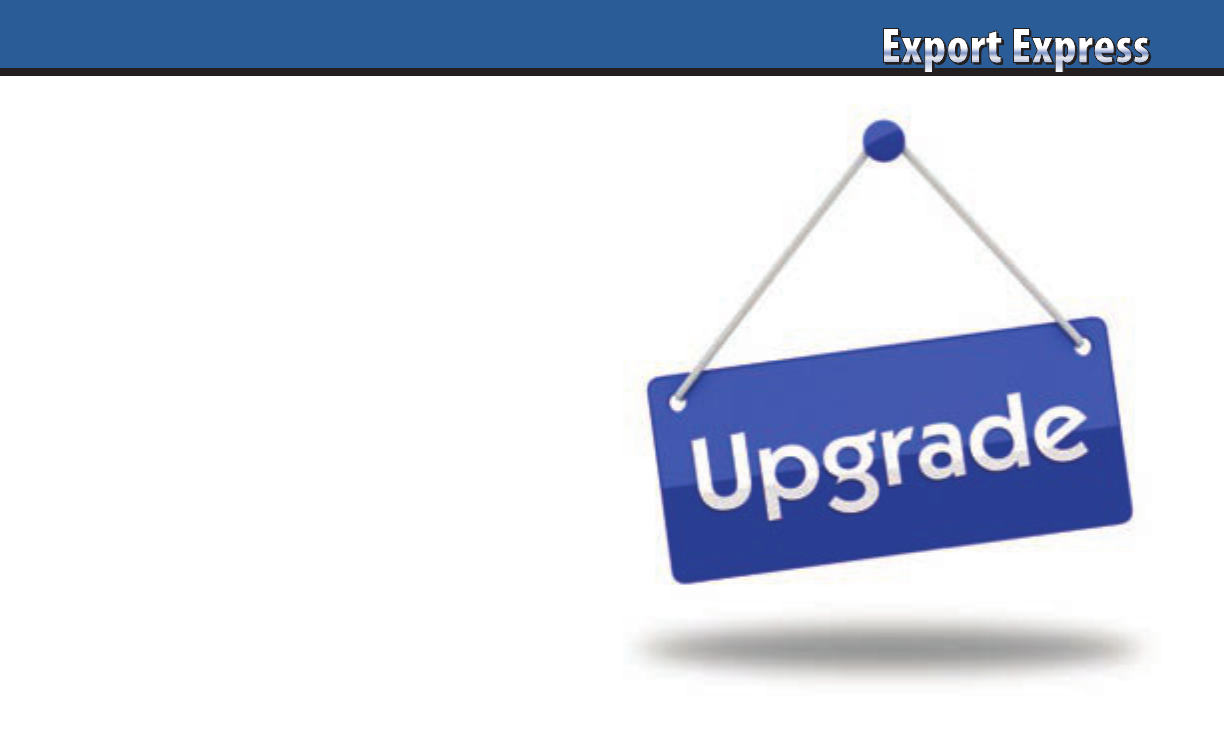
31
A Gentle Approach
Changing distributors is never easy, because we usually like the people involved. Best approach is
to accept part of the blame for the failed relationship. Provide the old distributor a believable sound
byte that he can repeat to maintain dignity in the marketplace: i.e. brand owner was looking for a
distributor with more foodservice or small shop coverage. In the case of a long term partner (5 years or
more), it may be appropriate to offer a lump sum goodwill payment, payable 90 days after transition
in return for their cooperation. The good news is that a new distributor will emerge as motivated
partner, anxious to take a “fresh look at old challenges” and deliver on their commitment to you.
Every company includes distributors
that appear as chronic under-performers.
Year after year, management listens
to excuses and we patiently “give them
a little bit more time.” 2021 results are
in and it’s easy to spot the problems:
big country, small shipments. The new
year is the right time to implement a
process of upgrading your distributor
network to a partner more aligned with
your business goals. Listed below are
key action steps.
New Year’s Resolution -–
Preparing for a Distributor Change
3 Secure agreement from management to change distributors
3 Review your original distributor contract
3 Send official letter to distributor recapping disappointing results
3 Obtain current distributor price calculation
3 Document and monitor inventory in the system, by SKU
3 Watch account receivables and bill-backs
3 Confirm in writing 2022 spending and promotion plan
3 Interview and pre-select an alternate distributor
3 Establish realistic transition timeline with new distributor
3 Advise old distributor of change in person
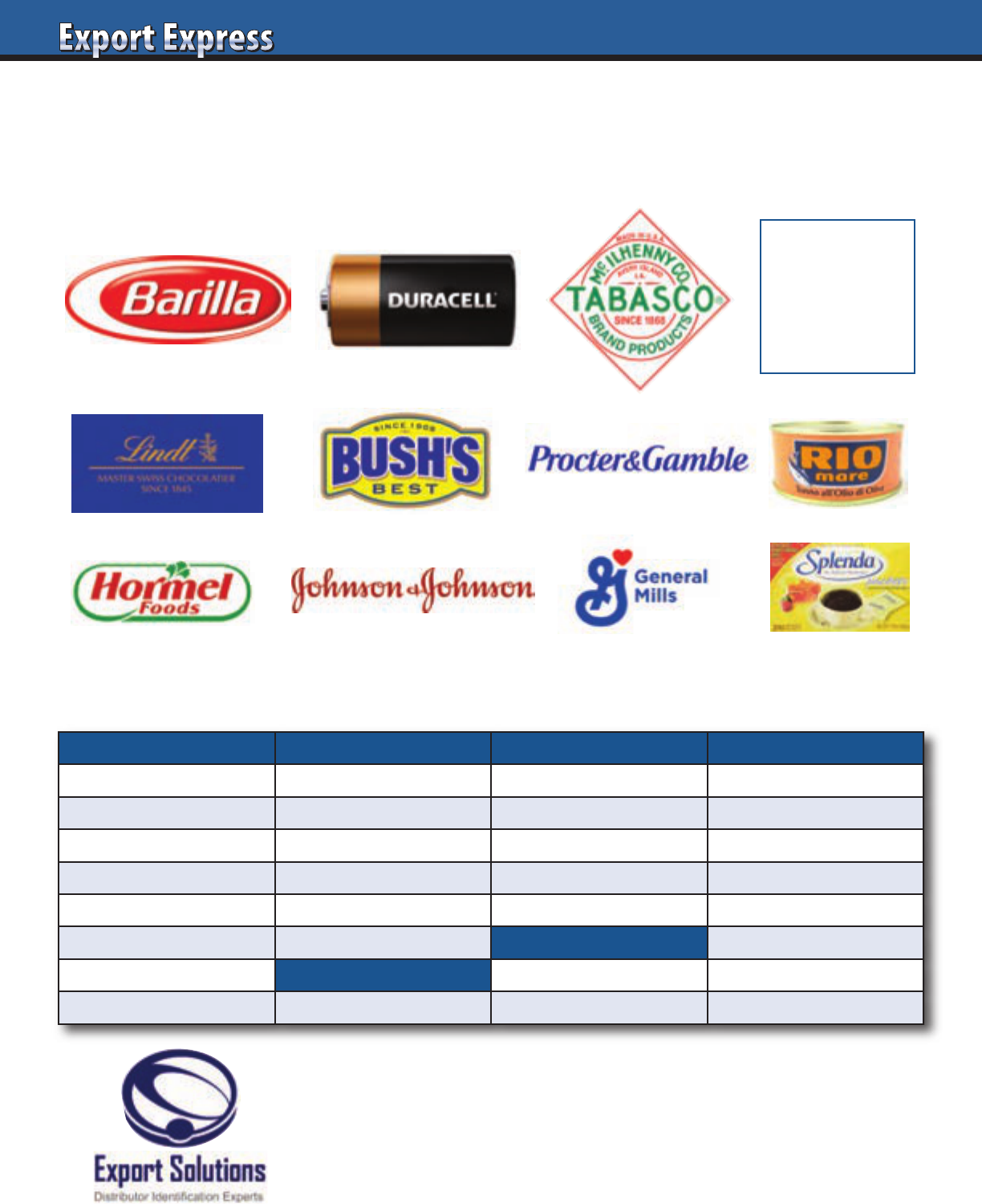
3232
Distributor Search Helper for:
Your
Logo
Here
Can We Help You?
Recent Distributor Search Projects
Asia Europe Middle East Latin America
Australia Germany Israel Argentina
China Ireland Kuwait Brazil
Indonesia Netherlands Qatar Colombia
Japan Nordics Saudi Arabia Costa Rica
Malaysia Spain UAE Ecuador
Philippines United Kingdom North America Mexico
Singapore Africa Canada Panama
South Korea South Africa United States Peru
Call the Export Accelerator!
Contact Greg Seminara at greg@exportsolutions.com
to discuss your business development project.
www.exportsolutions.com
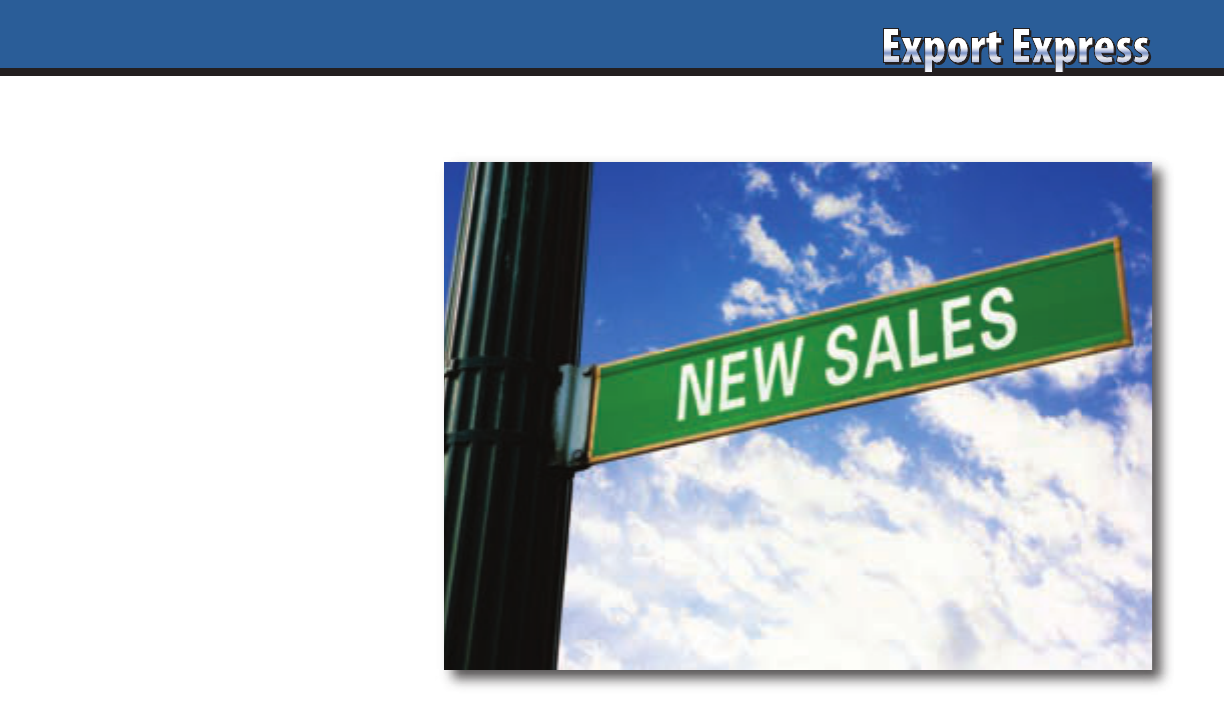
33
Exporters love the thrill of creating plans
to conquer new markets. The reality is
that our annual sales quota is dependent
on driving new sales from our existing
markets and distributors. This appears
as a challenge in a low growth country
or mature category, particularly if you
are not blessed with baskets of money to
invest in brand support activities. Listed
below are our ten tips for sourcing new
sales from existing markets.
1. Fill in White Spaces on your Listing Map
Most manufacturers focus their energy
on the total sales number for a country.
The one template I recommend for each
market is a Listing Map. This grid lists top
10 customers in the first column and your
brand SKU assortment in a horizontal
row. Where are the distribution voids?
Which new listings will generate the most
cases? What resources are needed to fill
the white spaces? What is the plan?
2. 10% Challenge
Trade spending may be a wise investment
if it drives profitable, incremental sales.
This is a good time of year to challenge
distributors with the question: “What
type of spend levels would be necessary
to secure a 10% increase in shipments
(consumption) in the next 90 days?”
Of course, in emerging markets you
may want to challenge the distributor
for a 20-40% increase or higher.
3. Retail Sales Contest
Competitive sales representatives love
contests. Everyone enjoys winning a prize
or supplementing their income. Brand
owners should consider a sales contest
that is tied to “Pay for Performance.”
Measure incremental pallet displays for
volume brands or most creative display
for smaller brands. Sync your competition
with your peak seasonality or a new
product launch. Awards such as iPads or
weekend trips are motivational. Structure
the contest to maximize winners. Create
a theme and “have fun.”
4. Senior Management Visit
Schedule a visit for your company
president or other senior executive to visit
an underperforming market. Arrange
for the visit 2-3 months in advance. You
would be surprised at the serious market
issues that are resolved prior to your
bosses arrival. The executive’s visit is
boosted by new ideas and a commitment
for future performance.
5. Evaluate Your Pricing Model
Pricing drives volume. Most pricing
models were designed at the beginning
of a relationship and rarely revisited
except for the periodic price increase.
Conduct a retail pricing survey. What is
your price gap versus your competition?
What would happen if you adopted an
“every day low price” approach? If you
took a price decline of 10%, would the
incremental volume compensate for
the price reduction?
6. Co-Promotion:
Leverage Distributors Portfolio
Many of the most successful distributors
run quarterly or annual promotional
events featuring all their brands. Normally,
there is a charity tie-in or special theme
overlay. The beauty is that each of the
distributors brands pays only their share
of the event. These Co-Promotion events
turn out to be a big win for the distributor
and each of their brands.
7. Annual Customer Business Review
It’s appropriate for a formal review
of your business at each major customer.
This could be a data intensive review at
a key customer in a developed market
or a “two pager” in an emerging market.
The process is the key. Focusing each
sales representative to analyze their
business results and identify their
largest opportunities adds visibility
to your priorities.
8. Spend Time at Retail
Most market visits program the export
manager from hotel to office to
customer followed by dinner.
Periodically, we’ll squeeze in a store
visit or two before a customer call or
flight departure. Why not dedicate a
day at retail with the retail manager
during a market visit? You’ll get a good
pulse of market conditions and
communicate your brand insights
directly with the retail sales manager.
Brands that are obsessed with in store
performance win incremental retail
sales team focus.
9. Offer a Bonus Pack or On-Pack Promotion
Most brands source 90% of their sales
from the shelf. Generate some excite-
ment everyday with a bonus pack or
other special pack promotion. Many
distributors can manually apply
small gifts or premiums at their
own warehouses.
10. Distributor Change
Organizational change is a last resort.
However, if a distributor continues
to deliver uninspiring performance,
you may be forced to look at market
alternatives. How is the distributor sales
growth versus overall category and
market growth? A new distributor
typically brings a boost of energy and a
renewed sense of commitment to a brand.
Ten Tips – Sourcing New Sales from Old Markets
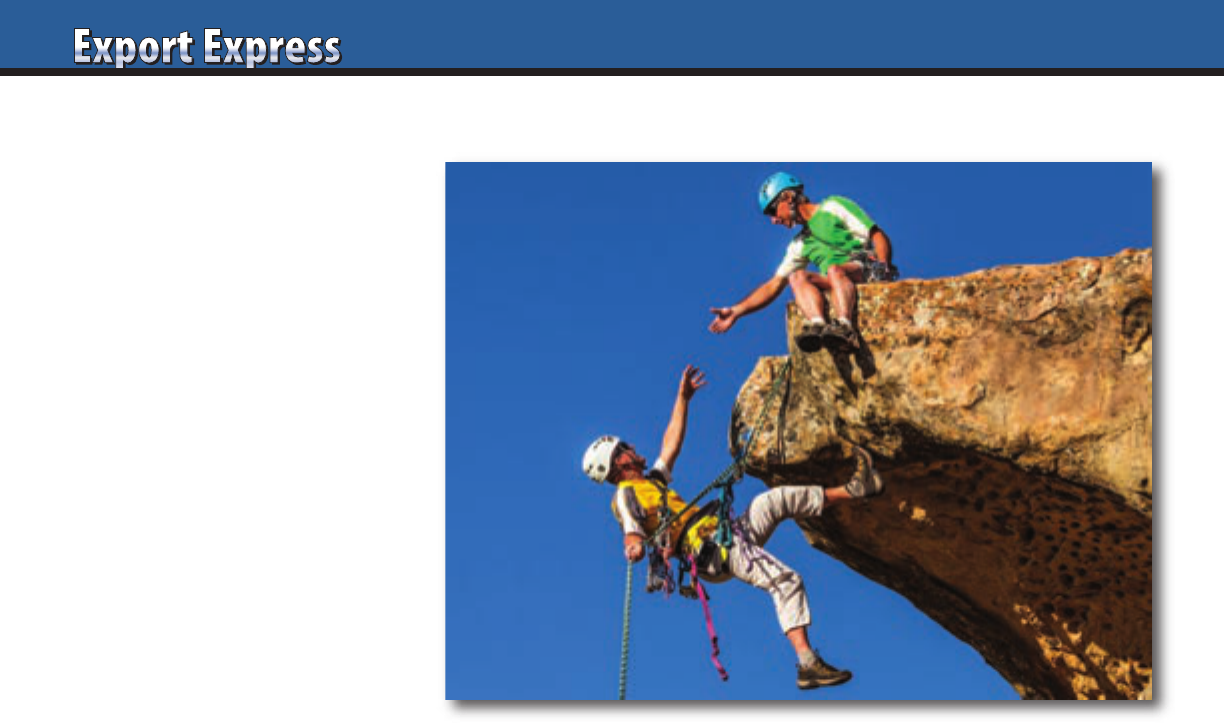
3434
Brand owners express frustration at the
lack of response from distributors to their
representation inquiries. Qualified
distributors are flooded with emails from
companies looking for new distributors
to handle their unknown brands. It’s
difficult to convince massive retailers to
take a chance on a new brand without
a proven track record. It’s even tougher
to persuade the owner of a mid-size
distributor to write a check for the first
order of your product, particularly if
you are not committed to a significant
marketing campaign. Brand building
from ground zero requires one-two years.
Research reveals that approximately
20 percent of new products are still on the
shelves two years later. Listed below are
Export Solutions’ tips on increasing your
chances that your new brand will be a
“Gold Mine” for a successful distributor.
Distributors: Always Looking for New Brands
Every distributor is looking for new
brands. Distributor profitability rises
exponentially when they add new
business. New business allows them to
leverage their fixed costs of warehouse
space and sales teams. Most distributors
search for adjacent brands that
complement their existing portfolio.
For example, confectionery specialists
look for other snack items that may be
purchased by the same buyer and are
located in the same aisle as their current
brands. Distributors need new
companies, as all distributors (even
the good ones), lose brands due to
acquisition, performance, or direct
models. The key is to position your
new brand opportunity as an attractive
addition to the distributor’s portfolio.
What Every Distributor Wants to Know
While you rave about your brands
superior taste, the distributor has
three thoughts on his mind :
1. How much money can he make
representing your brand?
2. Will it be tough to secure
market acceptance?
3. What will the brand owner commit
to in marketing investment?
Manufacturers that position their
proposition in these terms have a better
chance of gaining market acceptance.
Review Export Solutions’ article “How
to Excite Buyers, New Product Checklist”
for an independent product assessment.
Resistance to Pioneering
New product launch cycles require up
to one year from time of first distributor
meeting until he receives retailer payment
for his first order. During this incubation
period, the distributor must allocate his
sales and marketing resources to your
company without compensation. This
time dedicated to your company is
sourced from their other brands that are
currently generating income. Access to
the shelf does not guarantee consumer
trial and repeat purchase. A distributor
may buy your brand, capture shelf space,
and suffer disappointment when the
product does not sell. Unfortunately,
these pessimistic comments reflect reality
and provide insights on why best in class
distributors are hesitant to pioneer.
On the Road to Gold Mine
How can brand owners overcome
distributor resistance to pioneering?
Distributors are impressed by large
companies and brands that have been
successful in adjacent countries. Some
distributors will accept a product that
offers some existing market penetration
with the belief that their stronger team
can drive the business to the next level.
Manufacturer commitment to a powerful
marketing program sends a loud
message that you are serious. For mid-
size manufacturers, offering a small
monthly pioneering fee ($3,000 - $7,000)
demonstrates that you are a patient
partner, willing to co-fund the launch
preparation until distributor sales begin.
At the end of the day, distributors look for
a strong partner, with a good track record,
and a firm financial commitment to
support youir mutual marketing efforts.
How to Find an Enthusiastic Partner?
Export Solutions compiled an extensive
Distributor Search guide covering all
aspects of the distributor search process.
In pioneering scenarios, it is critical
to consider a wide variety of potential
partners. Schedule a one week trip
to a country. Plan to visit at least
5 distributors. Most distributors will
be open to an introductory meeting
with an overseas principal if you are
professional in your approach. Referrals
from your local government trade
support contact or another one of their
current brand owners helps pave the way.
Trade Shows also generate leads from
interested distributors. Post a large sign
saying: Distributors Wanted, listing
countries of interest. This will encourage
visitors to stop and chat.
Pioneering is tough but not impossible.
In reality, creating new brand sales from
a zero base is the essence of the Export
Manager’s job responsibility. Fortunately,
Export Solutions’ database covers more
than 9,200 distributors looking for
opportunities. Good luck!
Pioneering: A Gamble, Not a Guaranteed Gold Mine
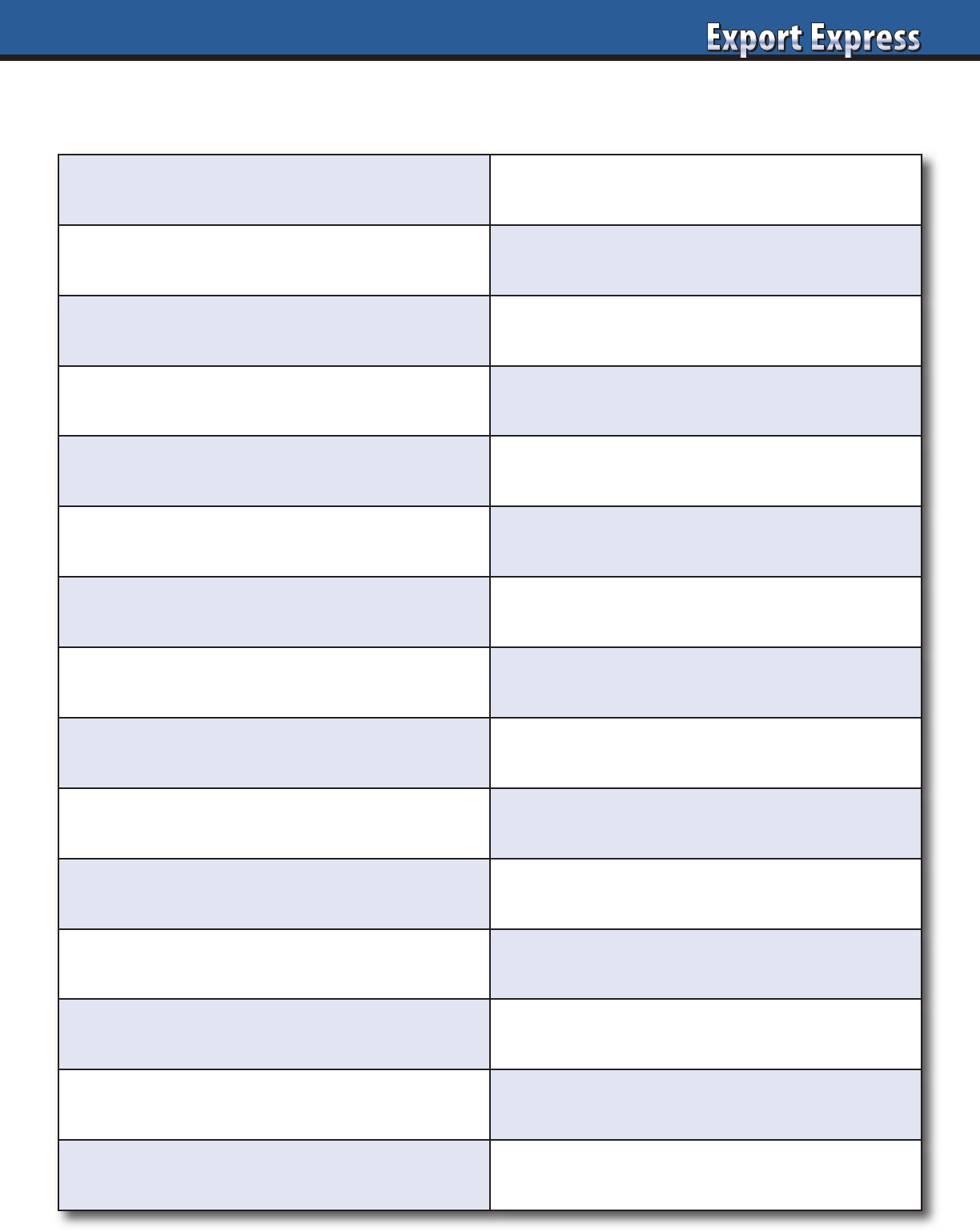
35
30 Ideas to Help your Distributors
1. Trade Promotion
Share Best Practice Trade Promotion concepts
16. Innovation
Launch new items with successful track record
2. Celebrate Success
Distributor of the Year Awards
17. Sales Contest
Fund contest to incent and motivate distributor team
3. Category Expert
Provide fact based trend updates
18. Thank You Letter
Letter of recognition for team to distributor CEO
4. Logistics Service Level
Target 98% on time, complete orders
19. Event Sponsorship
Support distributor events, especially retailers’ charities
5. Store Check
Periodic visits to understand “retail reality”
20. Distributor Workload
Work proportional to distributor income
6. Billback Reimbursement
Prompt (30 days?) payment of distributor invoices
21. Price Increase
Provide fair lead time for price increases
7. Distributor CEO
Regular (quarterly?) checkpoint web meetings
22. Reference
Write testimonial or volunteer to serve as reference
8. Response Time
Earn reputation as “quick responder”
23. Training
Create Zoom training session for sales team
9. Marketing
Support distributor’s ideas. Invests in creative programs.
24. Portal
Create Portal with presentations, brand facts, digital tools
10. Customers
Do not deal directly with distributor’s customers
25. Social Media
Corporate experts available to help/share content
11. Reports
Stick to basics: sales, forecast, inventory, listing maps
26. VIP Trip Your Headquarters
Introduce distributor to your senior executives
12. Market Visits
Visit, but not too often
27. Samples
Support large sampling programs
13. Team Building
Create team relationship: finance, logistics, administration
28. Corporate Functional Experts
Provide distributor access to your corporate experts
14. Distributor Profit
Respect that a profitable distributor is a healthy distributor
29. Consumer Research
Conduct local research for consumer insights
15. Syndicated Data
Invest in Nielsen data
30. Create Culture of Success
Achieve joint business targets
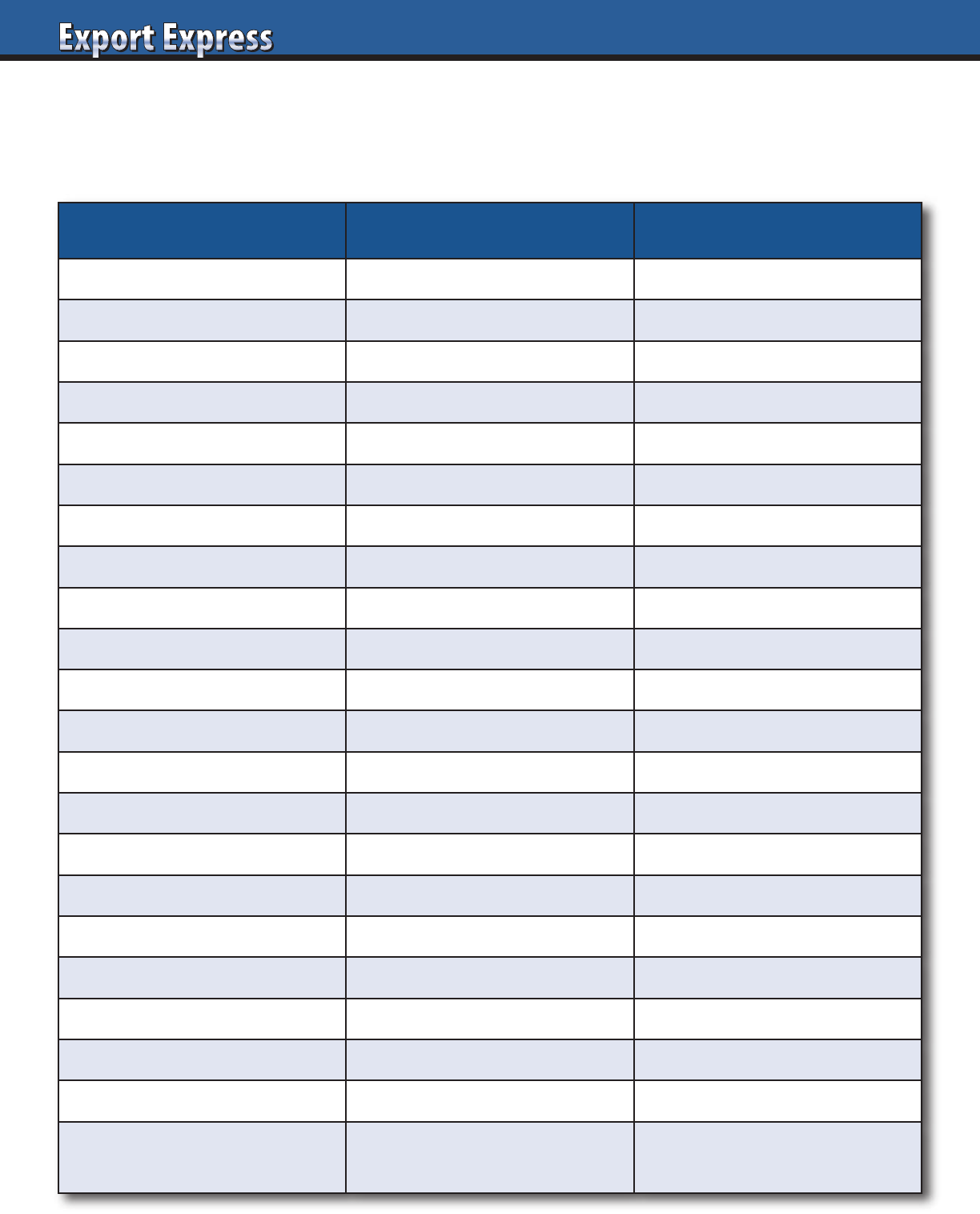
36
Distributor Supplier Relations
Managing the New Normal
Actitivity Old School New School
Customers Mass Supermarkets Omni Channel
Mom: Whats for? Dinner Breakfast, Lunch
Sales Team Over 50’s Under 30’s
E-Commerce Channel Niche Mass
Assortment Limited (supermarkets) Unlimited (e-com.)
Retail Conditions Store visits Web shop checks
Business Management Sales targets Profit targets
Distributor Expertise Generalists Specialists Category, Channel
Business Manager Brand Manager Idea Generator
Check Point Conferences Telephone calls Teams/Zoom
Overseas Supplier Visits Monthly/Quarterly Quarterly/Annually
Brand Presence Shelf Visibility Page 1 results (e-com.)
Distributor Logistics Delivery by case Delivery by unit (e-com.)
Recipe Ideas Your brand only Total meal solutions
Training Annual meeting Webinar (anytime)
Consumer Marketing Mass via multi media Targeted and digital
Brand Information Email to distributors Online portal
Pricing: Distributor Calculation “Closed Book” “Open Book”
Trade Shows Visit in person Hybrid:Virtual and in person
Foodservice Restaurants Home Delivery
Forecasts/Reports Monthly “Live,” real time
Results-Expectations Achieve your Objective Achieve your Objective
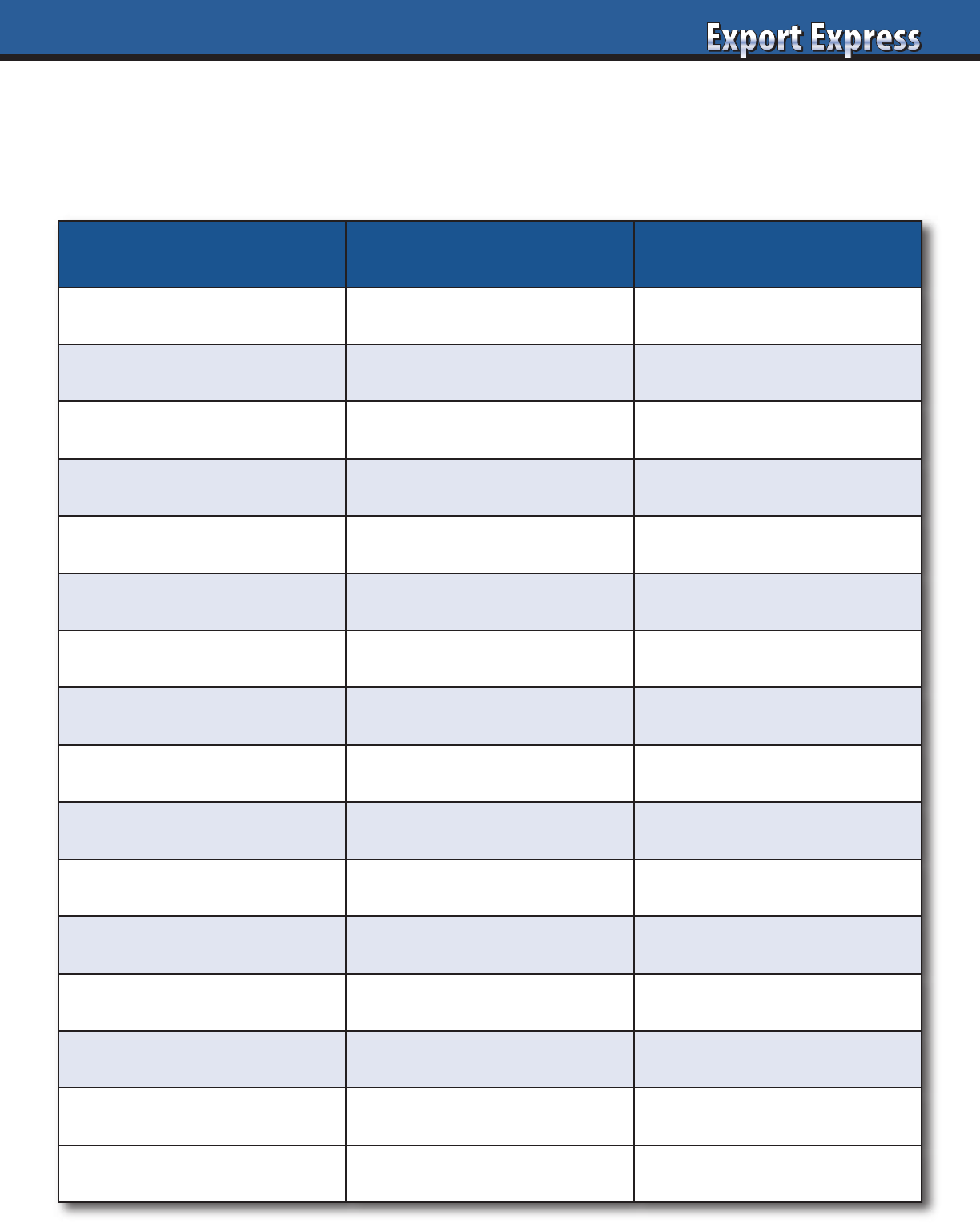
37
Are Distributors Interested in Your Brand?
High Interest Low Interest
Email Response
Immediate reply Delayed or no reply
CEO Engagement
Active participation Delegated to middle management
Scheduling Meeting
Flexible and easy Difficult. Conflicts.
Airport/Hotel Pick-Up
Offers to pick you up Take a taxi!
Meeting Presentation
Tailored. Prepared for you. Standard presentation
Category Research
Obtains data None
Competitive Review
Shares photos: store sets Informal comments
Store Visits
Organized/led by CEO Office meeting only
Samples
Obtains and tries samples Waits for you
Team Participation
3-6 people at meeting One person
Cell Phone
Shares private number Email address only
Questions
Addresses key issues No questions
Timeline
Meets due dates Delays
Post Meeting Follow-up
Immediate and frequent None
Proposed Plan
Detailed and fact based Brief topline
Results Winner Second place?
I have conducted hundreds of distributor interviews for multinational companies: P&G, Nestle, General Mills,
Duracell, Lindt, Tabasco, Barilla, J&J, etc. Distributor candidates all claim enthusiasm and high interest in your
brand. See Export Solutions’ checklist of clues to measure true distributor interest level.
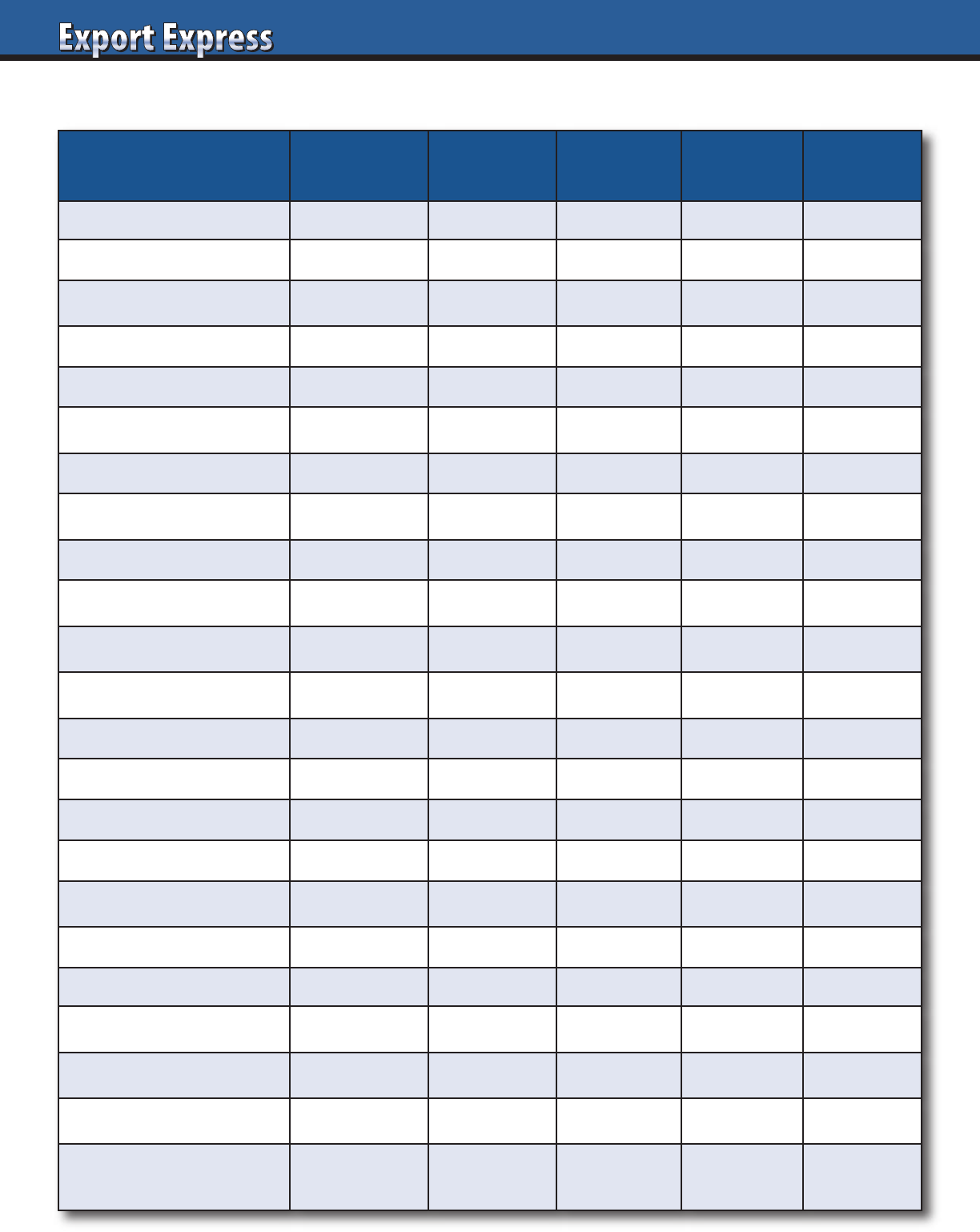
38
Channel Confectionery
Gourmet
Food
Food/Grocery Beverage Non Food
E-commerce x x x x x
Meal Kits x x x
Ethnic – “Homesick” x x x x
Gift Basket x x x
Natural Food x x x
Gourmet, Deli x x x
Liquor x x
Farmers Markets x x
Gift Channel x x
Toy, Party Stores x x
Movie Theaters x
Hardware, DIY, Office x x x
Duty Free x x x
Fundraising x x
Theme Parks, Stadiums x x
Airlines x
Butchers, Fishmongers x x x
Coffee Shops x x
Military x x x x x
Department Stores x x
Kitchen Supplies x x x
Dollar, Close Out x x x x x
Discount Clothing
(Marshalls, TJ/TK Maxx)
x x
New Channels: Prime Prospects, By Category
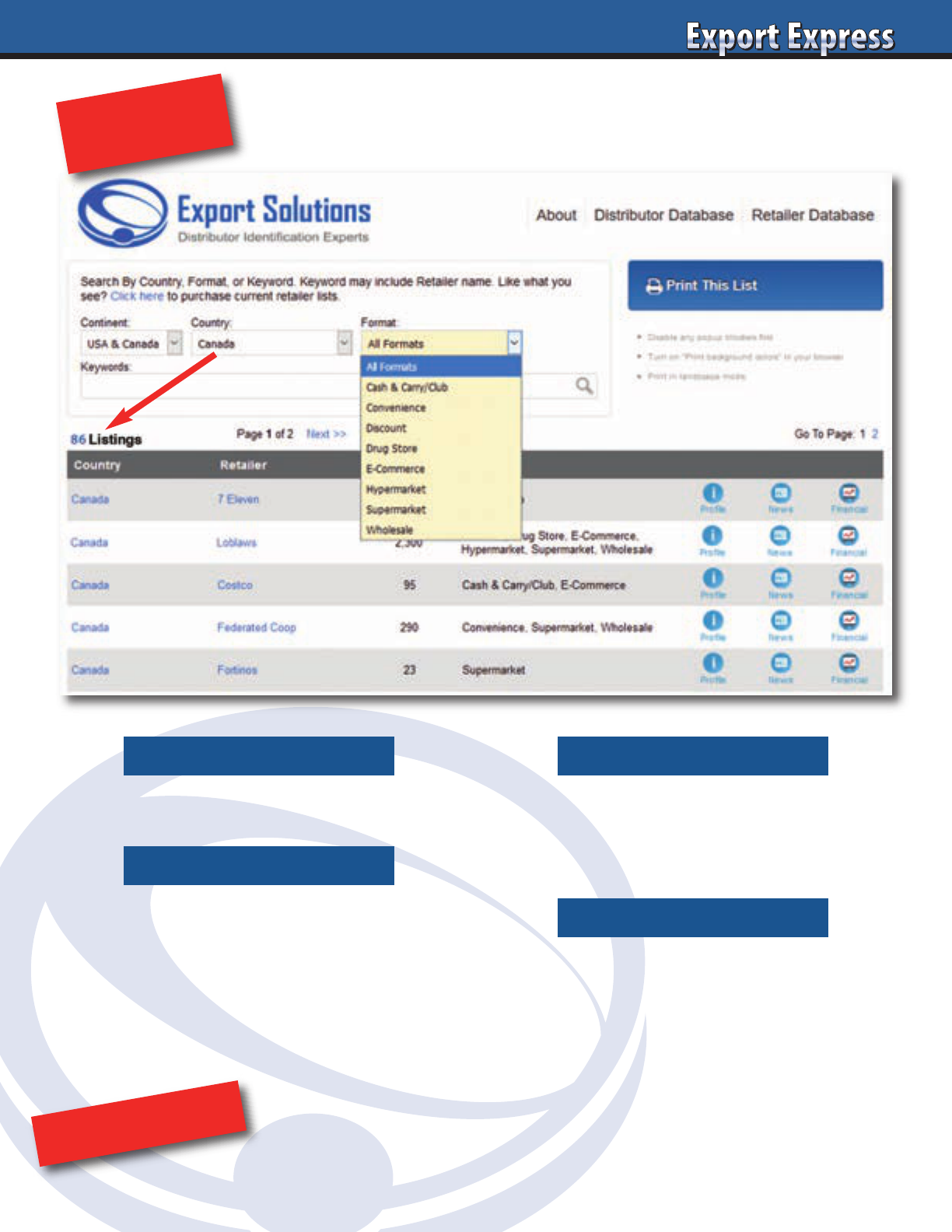
Coverage: 96 countries and 2,700 retailers
Supermarket
Convenience
Drug Store
Natural Food
Club, Cash & Carry
Supplying profiles, store counts, formats,
news and info for Top 100 international
retailers plus all overseas branches
Example 1: Who are supermarket
retailers in Canada?
Example 2: How many stores does Loblaws
operate by banner, in Canada?
NEW!
ORDER NOW!
39
Search by Retailer NameSearch by Country
Combo Search
www.exportsolutions.com
Search By Format
Retailer Search Made Simple
Canada Example
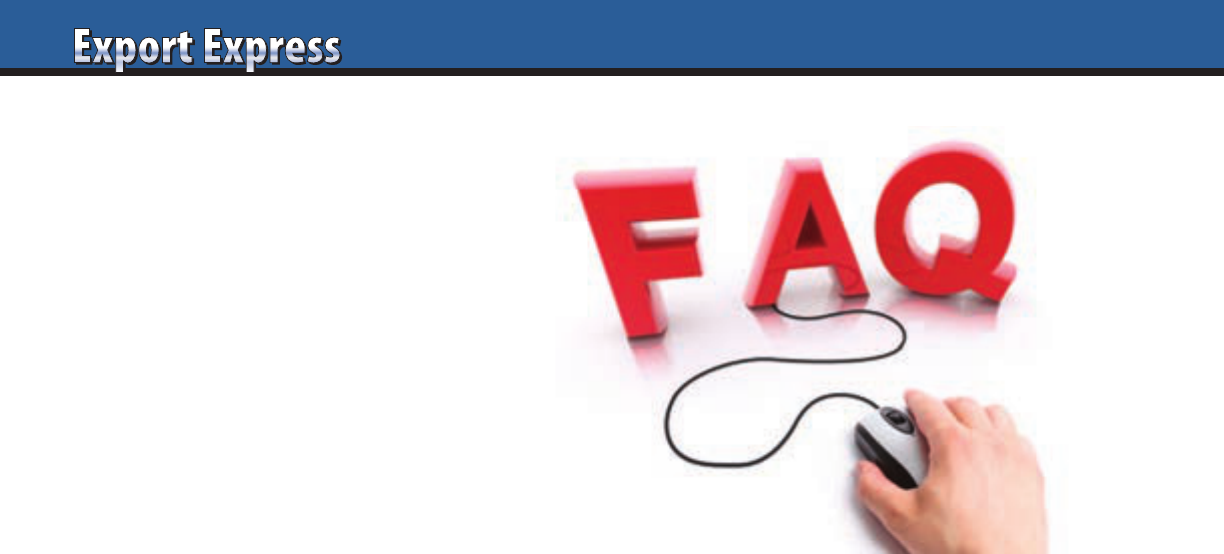
40
Why did you create the retailer database?
Export managers dedicate a lot of time
to researching countries, retailers and
preparing business plans. A standard
KPI measure is tracking product listings
for key customers. I believe that our
industry could benefit from a global
retailer database to instantly locate
retailers and their store counts in
96 countries. The retailer database
is a logical extension of our leading
distributor database which has helped
more than 3,000 companies build export
sales during the last 10 years.
What is your geographic coverage?
96 of top 100 GDP countries worldwide.
This includes most Asian, Middle Eastern,
and European countries. Our database
covers every country in the Americas.
In Africa, we cover South Africa.
What is your format coverage?
Excellent coverage of chain supermarkets,
hypermarkets, clubs, cash and carry,
and convenience formats. Solid initial
coverage of drug stores, natural food
stores, and e-commerce channels.
Our database does not cover
DIY/hardware, toy, office, liquor,
or sporting goods channels.
Retailer database: featured info
Profile – Retailers profile and link to their
internet home page.
Formats – Retailer’s stores segmented
by format and banner.
We track supermarkets, hypermarkets,
cash and carry, convenience stores,
discounters, drug stores, natural food
stores, and e-commerce retailers.
News – Latest retailers’ news. In some
cases (Asia), we substitute a link to the
retailer’s latest promotional flyer.
Financial – Many leading retailers are
publicly traded. A link is provided to
their latest financial results. We do not
offer estimated financial information for
privately held or family owned retailers.
How is your coverage of global retailers?
We offer total coverage for top 100 global
retailers. This includes all of their
branches and banners. Searchable!
Use filters to research Walmart, Costco,
Carrefour, Tesco, Metro, Casino presence
by country. Database covers retailer’s
total store outlets as well as a breakout
by banner and format.
What can I use the retailer database info for?
• Obtain an instant snapshot of an
average of 24 retailers per country
for 96 countries.
• Track presence of global retailers like
Walmart, Carrefour, and Metro AG.
• Create country specific listing maps
where distributors measure brand
authorization by retailer.
• Conduct home office based
international category reviews and price
checks from retailers’ e-commerce sites
(not all retailers).
• Prepare annual reviews and reports
with up-to-date information on leading
retailers and channels.
Searchable
The database offers filters allowing you to
search by country, format, or retailer name.
You can also use a combination of filters for
your research.
Can I get a free sample of the retailer database?
Sure! Check www.exportsolutions.com for a
complete profile of United Kingdom retailers.
Do you provide retailer’s annual sales
or market share information?
Accurate annual sales information is
available through the financial link for
publicly traded companies. We do not
provide estimated financial information
for privately held and family owned
retailers. Channel blurring occurs between
supermarket, convenience, e-commerce,
and even natural food operators. We do not
provide market share due to difficulty to
accurately isolate and define channel
market share information, particularly with
so many privately held retailers.
How accurate is the retailer data?
Export Solutions’ retailer database is
updated weekly, so information is highly
accurate. Retailer names, web sites, and
formats rarely change. This makes the
database 99% accurate at the company
level. New stores open every day,
resulting in store counts that may be
95% accurate. We intend to update store
counts on a regular basis.
How much does retailer database access cost?
An annual subscription to the retailer
database is $975. This supplies one year,
unlimited access to more than 2,700
retailers in 96 countries. Special offers
available for our distributor database
customers. Note: special pricing for
government trade organizations.
How do I access the retailer database?
Visit www.exportsolutions.com and click
the retailer database page. You can place
a subscription or individual continent
(i.e., Europe) into a shopping cart.
Register and check out via credit card.
The process takes two minutes and we
automatically send you an invoice.
About Export Solutions
Export Solutions was founded in 2004
and is based in Atlanta, Georgia in the
USA. Export Solutions serves as a leading
provider of business intelligence to the
food and consumer goods industries.
Our distributor database covers 9,200
distributors in 96 countries and has been
used by more than 3,000 clients. Our
Export Express newsletter has a circulation
of 9,900 and is viewed as an important
source of insights, strategies, and
templates for international development.
www.exportsolutions.com.
FAQ’s – Retailer Database
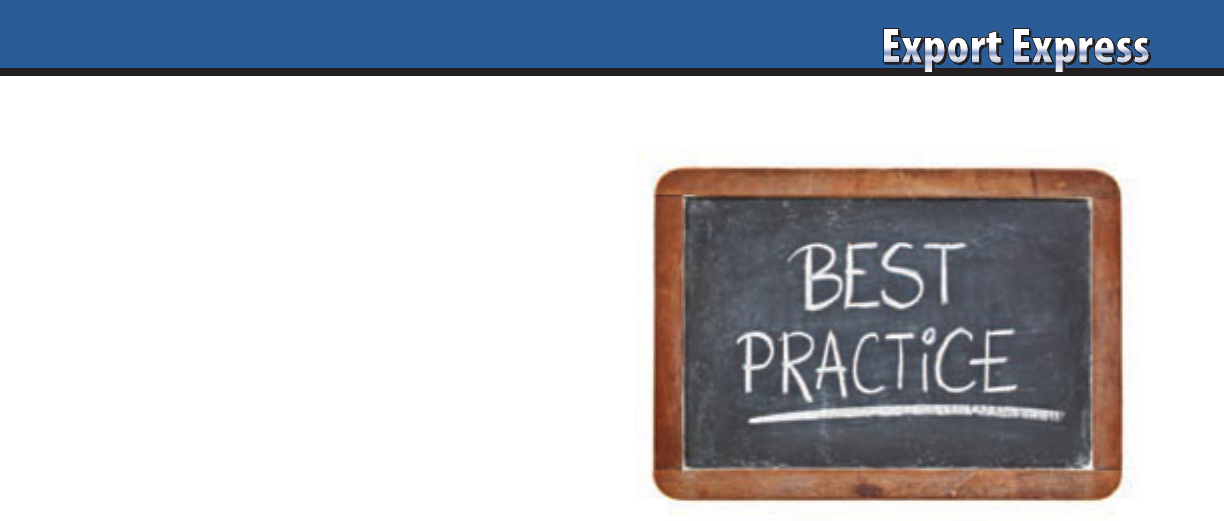
41
E-commerce now accounts for five percent of USA omnichannel
sales, up forty percent in the last year according to Nielsen. This
includes almost 12 billion dollars sold through online grocers.
No one can accurately gauge how big e-commerce will become,
but it is safe to predict that it will be much, much bigger in
the next five years. Billion dollar multinationals and scrappy
start-ups are attacking this channel with vigor, widening the
performance gap versus successful national brands. In China
and India, e-commerce accounts for a majority of the sales for
many imported products. Read Export Solutions’ ten tips for
capturing your fair share of the growth in this strategic channel.
1. Conduct E-Commerce Survey for Core Countries
Create a one page template capturing local e-commerce
customers, online grocery trends and current distributor
engagement. Calibrate where each country is on a development
curve. Source best practices from distributors in China, India,
United Kingdom, and the USA where e-commerce maintains
highest acceptance levels.
2. Speak to Millennials
Spend time with young people, learning how they shop and
blaze through digital marketing messages. Learn why millennials
avoid “their mothers brands” and how many rarely make a
“stock up shop” at a neighborhood supermarket. Another
revelation is the trust that they place in online reviews and
key influencer recommendations.
3. Create a Global E-Commerce Strategy
Align with your company’s overall e-commerce strategy.
Establish benchmarks and toolkits to share with your
distributors. Acknowledge the fast pace of development,
allowing flexibility to pivot fast.
4. Distributors: E-Commerce Business Plan
Request each distributor to create a 2022 e-commerce business
plan. Include new distribution targets, marketing plans, and
shipment objectives for e-commerce customers. Challenge
distributors to hire a young person to serve as a dedicated
e-commerce key account manager. Review each distributor’s
e-commerce marketing plan early and often in 2022.
“A distributor respects, what the brand owner inspects.”
5. Learn Online Marketing Tactics
Goodbye end caps and slotting allowances. Hello “pay per click”
and first page search results. Unlimited shelf space exists in
cyberspace, with room for every sku that you (and your
competitors) produce. Face-to-face buyer meetings are replaced
by online marketing menu programs and transparent sales
ranking information. Learn the new rules or you will fail the
e-commerce test.
6. Treat Amazon and Alibaba as Global Customers
Amazon revenue will exceed $500 billion in 2022, including
more than $400 billion sourced from sales of goods. Amazon
will comfortably rank as the world’s number two retailer, far
exceeding sales by Carrefour or Costco. Multinational category
leaders have established customer teams to service Amazon.
Many place their best, young talent against this high growth
customer. Multifunctional team roles may share the same titles
in Finance, Supply Chain and Marketing, but the “work” is much
different. What dedicated resources are assigned to Amazon and
Alibaba today at your company?
7. Consider a Web Shop
Direct to consumer represented a complex route to market in the
past. Today, new brands and leading companies are jumping at
the opportunity to showcase their innovation and share in depth
product knowledge through their own proprietary web shop.
Outsourced supply chain experts exist to provide fulfillment
solutions. Tangible profits may be elusive today, but there is
valuable, inexpensive learning to be gained from pioneering
in this area.
8. Hire an International E-Commerce Expert
Appear as a preferred supplier by your distributors by providing
leadership insights into this new trade channel. Distributors in
emerging markets are hungry for best practices in establishing
e-commerce brand building models. Send your e-commerce
expert to core markets to conduct workshop training sessions.
Your investment in an e-commerce strategy and guru positions
your company as a preferred partner helping to build the
distributor’s entire business.
9. Appoint E-Commerce Distributors – Asia
Selling through the e-commerce channel requires different routes
to market capabilities and skill sets than marketing through
brick and mortar supermarkets. Consider appointing a separate
e-commerce distributor in advanced countries like China and
South Korea. A key issue is managing pricing equilibrium
between your conventional distributor and e-commerce partner.
10. Track E-Commerce Results
Establish KPI’s and measure performance at key customers such
as Amazon. Are you getting your fair share of the growth?
E-commerce development is a top 2022 priority for every brand
and distributor. Some may say that e-commerce is evolving
slowly in their country or too complex and unprofitable to
allocate resources. These are the same people whose parents
were probably in the horse and buggy or fax businesses.
Enhanced focus on e-commerce will position you as a leader
(or survivor) for 2025.
Ten Tips: Ex-Selling at E-Commerce
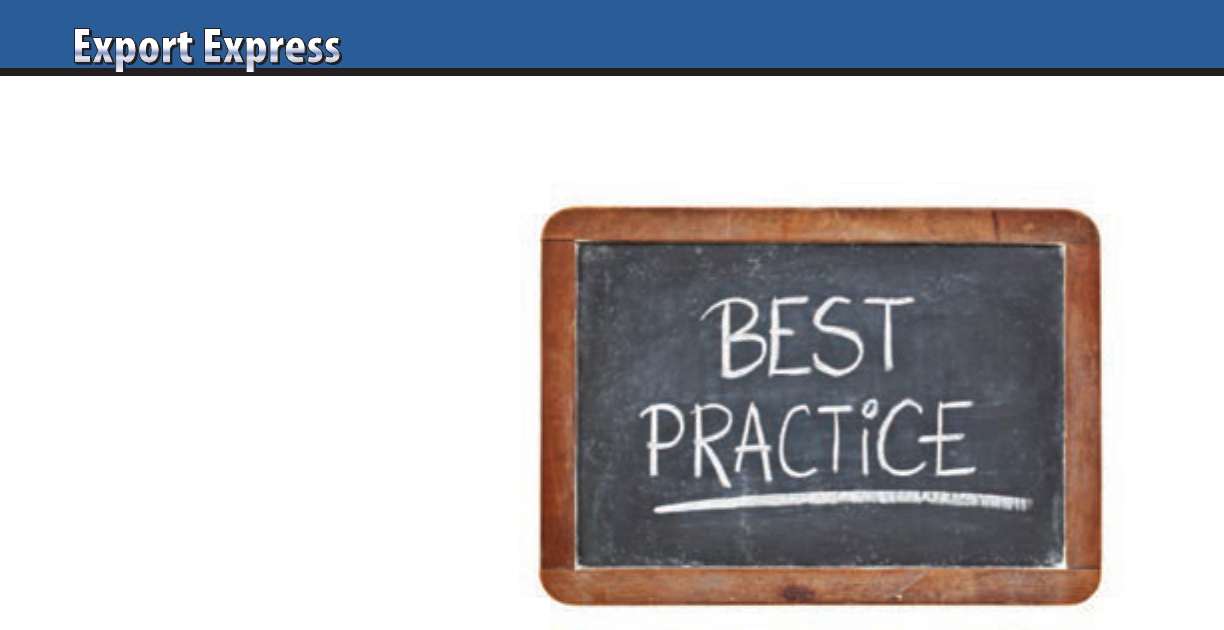
42
Are you selling more to Ireland, Iceland
or India? To the Bahamas, Baltics, or Brasil?
UAE or United Kingdom? Small countries
offer solid business opportunities, with lower
complexity and investment required. All
companies export development plans should
include a mix of strategic countries like China
and the USA (Europeans) plus revenue
generators with fewer than ten million
people. Listed below are Export Solutions’
ten tips on why small countries deliver
big business.
1. Limited Local Production
Small countries are highly dependent on
food imports. Even multinationals tend to
locate factories in larger hub countries. This
creates the opportunity for exporters to fill
a high percentage of a small countries food
supply requirements.
2. Distributor Model – Primary Route to Market
Most companies partner with distributors
in these countries. Leaders like Nestlé
and Unilever may find it more productive
and efficient to use distributors versus
establishing a local subsidiary. For example, Export Solutions’
distributor database supplies information on 63 distributors
in Panama, 87 in Kuwait, and 78 distributors in Croatia.
3. Value Chain – Level Playing Field
Brands are frequently able to compete on a level playing field in
smaller countries. Most products maintain similar cost structures
with importation fees, distributor margins, and retailer margins.
International brands do not suffer the same type of price gap
problems versus homegrown brands as they encounter in large
countries with local plants.
4. Low Complexity – Ship and Sell
In many cases, you are able to sell existing Made in the USA
or Europacks. Compliance may be achieved with a small,
distributor applied sticker. Many countries in this cluster do
not require a lengthy registration process accepting USA or
European standards.
5. Brand Awareness Exists
Surprise! Some consumers in an adjacent small country will
already be aware of your brand. This could result from cable
TV advertising or visits from their citizens to your country.
Costa Rica, Malta, and the Caribbean represent tourist hubs.
These popular hosts feed seasonal residents from the mainland
and boatloads of visitors hungry for their favorite brands.
6. Reasonable Cost of Entry
Launching a new brand is economical. Retailers are frequently
happy with a “free fill” of the first order versus an excessive
listing fee. Demos in a handful of high profile stores will
create visibility. Distributors appreciate your existing point
of sale materials.
7. Best in Class Distributors
Some of the best distributors of the world are based in small
countries. The reason is that even enormous multinationals
partner with distributors in these regions. This propels the
leading players to top ten suppliers to the retail trade. These
distributors implement the best practice models from companies
like Procter & Gamble and apply them to all the brands in their
portfolio. I witness many examples where a powerful distributor
creates a huge success story for a smaller brand based upon their
marketplace clout.
8. Currency and Freight Impact
Many countries consider the USA dollar or Euro as legal tender.
This reduces the impact of currency fluctuation and perhaps
some financing charges. Small countries that depend on imports
across all industries enjoy frequent freight service. This creates
competitive rates and potentially lower logistics costs.
9. Distributors: Excellent Relationships and Coverage
Everyone knows everyone in these countries. Distributor owners
emerge as respected community leaders. They know how to get
things done. Distributors are forced to be generalists, selling to
all customers across all channels and all regions within a small
geography.
10. International Brands: Affordable Luxury
Consumers take pride in offering their families the best food
treats from overseas. These world class brands may only be
a few cents more expensive versus private label type options
which face similar cost structures.
Export Solutions serves as a distributor search “helper,” with
400+ projects completed for more than 50 companies of all sizes.
Contact us to leverage our distributor database and strong
relationships with distributors in 96 countries.
Ten Tips: Small Countries Deliver Big Business
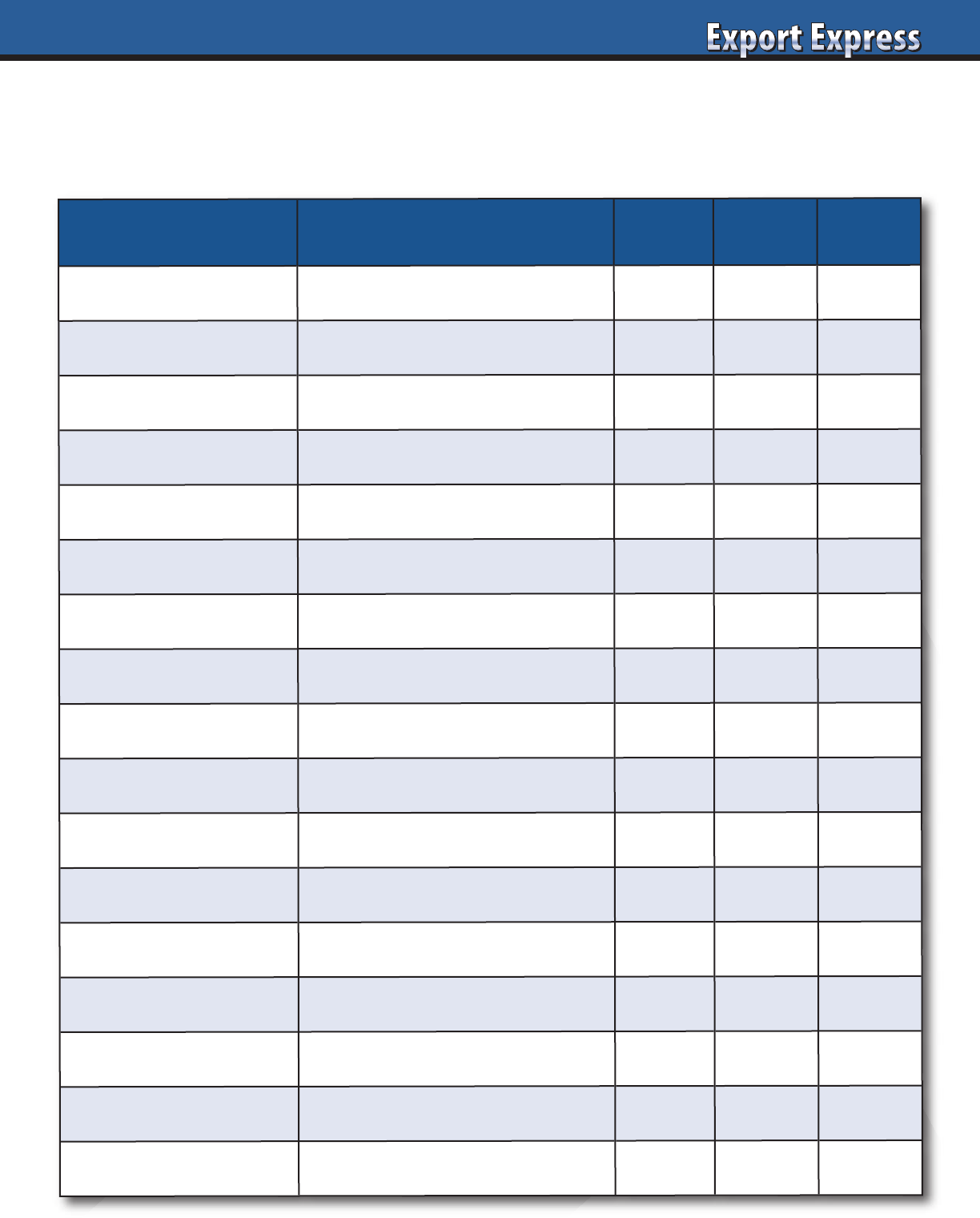
43
Export Reports: Format and Frequency
Every exporter requires certain reports to manage the business.
Productivity is enhanced when distributor focuses on selling activities versus compiling a stack of reports.
Everything functions better when reports are filed on a regular schedule.
Report
Description
Monthly
Quarterly
Annually
Distributor “Sell Out”
Distributor sales to customers
x
Sales Forecast
Rolling 90-180 days
x
Distributor Inventory
Weeks supply on hand, by sku
x
Sales Versus Budget
Progress vs. annual objective
x
KPI Dashboard
Coverage, Displays, Distribution, etc.
x
Listing Map/Plans
Brand/sku authorization,by customer
x
Sales Promotion Calendar
Capture adjustments, and payout
x
New Product Launch Status
Acceptance by key customer
x
Category Review (Nielsen ?)
Category trends
x
Retail Price Survey
Top 10 customers
x
Competitive Activty
New launches, innovation
x
Distributor Credentials
Distributor "standard" presentation
x
Credit Report
Financial update
x
Distributor Value Chain
Factory gate to store shelf
x
Annual Business Plan
Agreed road map to achieve objectives
x
Retailer Business Review
Top 5 retailers
x
List of Top 10 Customers
Plus your buyers name
x
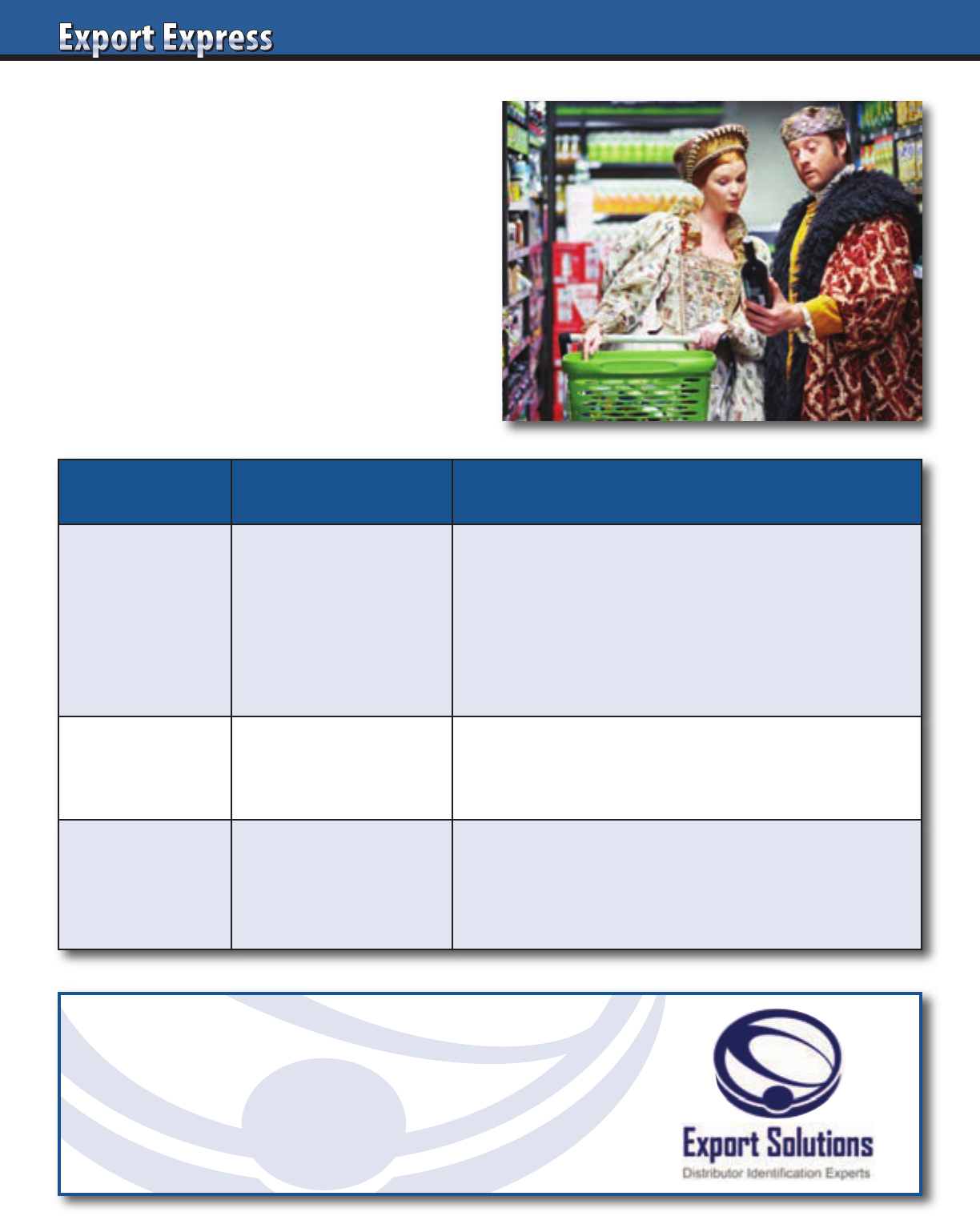
44
From High Class to Mass
International brand builders may validate a logical progression
to market entry. Most export brands deliver unique products, but
at a premium price. It’s a natural first step to target “gourmet”
food stores and supermarkets patronized by upscale shoppers
first. E-commerce is an excellent channel to gain early visibility
for an overseas entrant. Many exporters should focus on success
in these channels prior to targeting mainstream supermarkets
supplying middle class shoppers. These chains tend to offer
larger store counts, but higher cost of entry and promotion.
Phase three retailers represent a final challenge once your brand
has achieved a respectable market share. These retailers tend to
be “value oriented” and demand lower price points to gain
acceptance by shoppers on a more limited budget.
Export Solutions recommends conducting a retailer
segmentation exercise for each country. Align customer
demographic characteristics with the market development
trajectory for your brand.
Sequence Demographic Retail Targets
Phase One High Class • High end supermarkets
• Gourmet deli’s
• “Homesick” expat shops
• Specialty retailers
• E-commerce
Phase Two Mainstream • Conventional supermarkets targeting
“suburban” shoppers
Phase Three Mass • Value oriented supermarket and
hypermarket chains
• Convenience – “small shops”
Looking for Good Distributors?
Export Solutions’ database covers
9,200 distributors in 96 countries.
www.exportsolutions.com

45
“The shelf doesn’t lie!” Why are you
surprised when a distributor misses their
sales numbers and you perform a few
random retail checks and the stores look
awful? Or your “star” distributor proudly
brings you to supermarkets where your
brand’s presence looks better than the
sample display you built in your
headquarter office?
A classic question is “how do you
determine a good store from a bad store?”
Some multinational leaders feature well defined shelf guidelines for positioning and
placement and the pursuit of a “perfect store.” A more common practice is for an export
manager to share a pretty photo of a sample shelf layout, created by the marketing
department. A few general objectives are supplied, but no formal training, sales rationale
or KPI measures.
“Is the Store a 10?” is a tailored program from Export Solutions that succeeds in
providing simple shelf standards and a methodology so that every member of a
distributor organization will be crystal clear on store level performance expectations.
Basically, each store is graded with points awarded for assortment, shelf space, shelf
positioning, pricing, and off-shelf display.
Listed below are key elements of developing a “Is the Store a Ten?” program for your
distributor teams.
1. Develop Clear Standards
Award points based upon a “physical count” of authorized items or shelf facings
or answers to a “yes or no” question. Example: Is there a secondary display?
Create a simple 10 point scale, where a “1” is poor and a “10” is the best.
2. Align With Key Account and Retail Sales Teams
This initiative is best explained to key influencers in the distributor organization in-store.
Meet with them at a supermarket and discuss program execution for their customer or
market. The program will fail if you only discuss it with a brand manager or distributor
CEO at the office.
3. Conduct Training Session
Share the program with the entire retail team. Provide a rationale and sales facts for our
objectives. Provide FAQs on common questions or issues. Role play. Launch a “Is the
Store a 10?” shelf drive with prizes. Establish clear KPIs.
4. Measure Improvement: Today a “5”…Tomorrow?
It is likely that early scores may be closer to a 5 than a perfect 10. This is okay
in most cases. The goal is to incorporate a cultural shift in evaluating stores and
capture improvement
5. Planogram Serves as the Official Record
I love the distributors that flood us with photos of great store layouts. I swear
that sometimes the image is the same display taken from several different angles.
Validate performance with a copy of the approved planogram or schematic.
A 2022 objective for all is to escape the boredom of hot conference rooms to spend
more time witnessing retail reality. Export managers are paid on container sales, but this
represents only warehouse inventory. A store shelf is where export dreams are translated to
retail revenues. Contact me to discuss implementing “Is the Store a 10?” for your company.
www.exportsolutions.com
Greg Seminara
gseminara@exportsolutions.com
404-255-8387
“Spend Time Selling to Distributors versus Searching for Distributors”
Is the Store a 10?
Strategic Services
Contact Us for
Export Solutions
1. Identify Best in Class
Distributors: 96 Countries
2. Best Practices
Export Strategy
3. Distributor Management
Workshops
4. Export 101:
Let’s Get Started
5. New Market
Prioritization
and Launch Plan
6. Personal Distributor
Introductions:
96 Countries
7. Walmart International
8. Distributor Contracts,
Margins, and Fees
9. Meeting Speaker
10. International
Strategy Expert
Strategic Services
Contact Us for
Export Solutions
1. Identify Best in Class
Distributors: 96 Countries
2. Best Practices
Export Strategy
3. Distributor Management
Workshops
4. Export 101:
Let’s Get Started
5. New Market
Prioritization
and Launch Plan
6. Personal Distributor
Introductions:
96 Countries
7. Walmart International
8. Distributor Contracts,
Margins, and Fees
9. Meeting Speaker
10. International
Strategy Expert
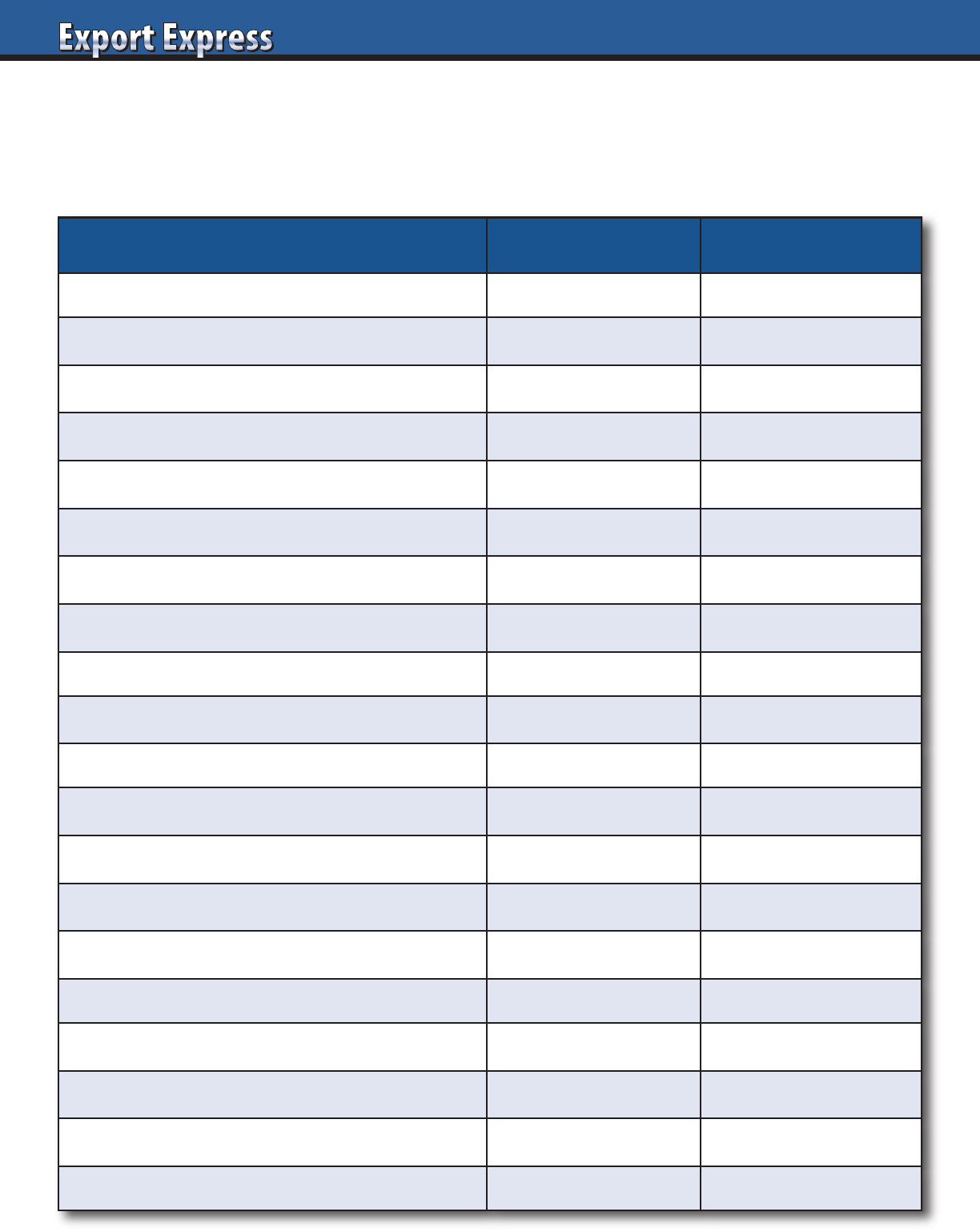
46
What Distributors Want to Know?
Strong distributors are overwhelmed by calls from brand owners looking for new partners. Distributors assess
each opportunity carefully, as any new brand must add incremental sales and profits and not distract from
priorities from existing brands handled. What is the “size of the prize” for the distributor?
Assessment Criteria Facts Rating (10 = Best)
Your company: size/ reputation
Existing business: sales in distributors country?
If zero “current sales,” what is realistic expectation?
Brand’s USP…your point of difference/innovation?
Size of investment plan: Marketing and Trade?
Potential distributor revenues?margin?
How does the product taste? (or peform)
How attractive/compliant is the packaging?
Pricing relative to category?
Brand success story in an adjacent country?
Competition intensity in category?
Brand range complexity?Product shelf life?
Local market research? Syndicated data?
Will brand invest in marketing and social media?
Will this be a tough product to launch?
Can we grow with the brand owner?
Your brand: core distributor category or adjacency?
Will the export manager be good to work with?
Will we be proud/excited to represent this brand?
What is the “size of the prize?”
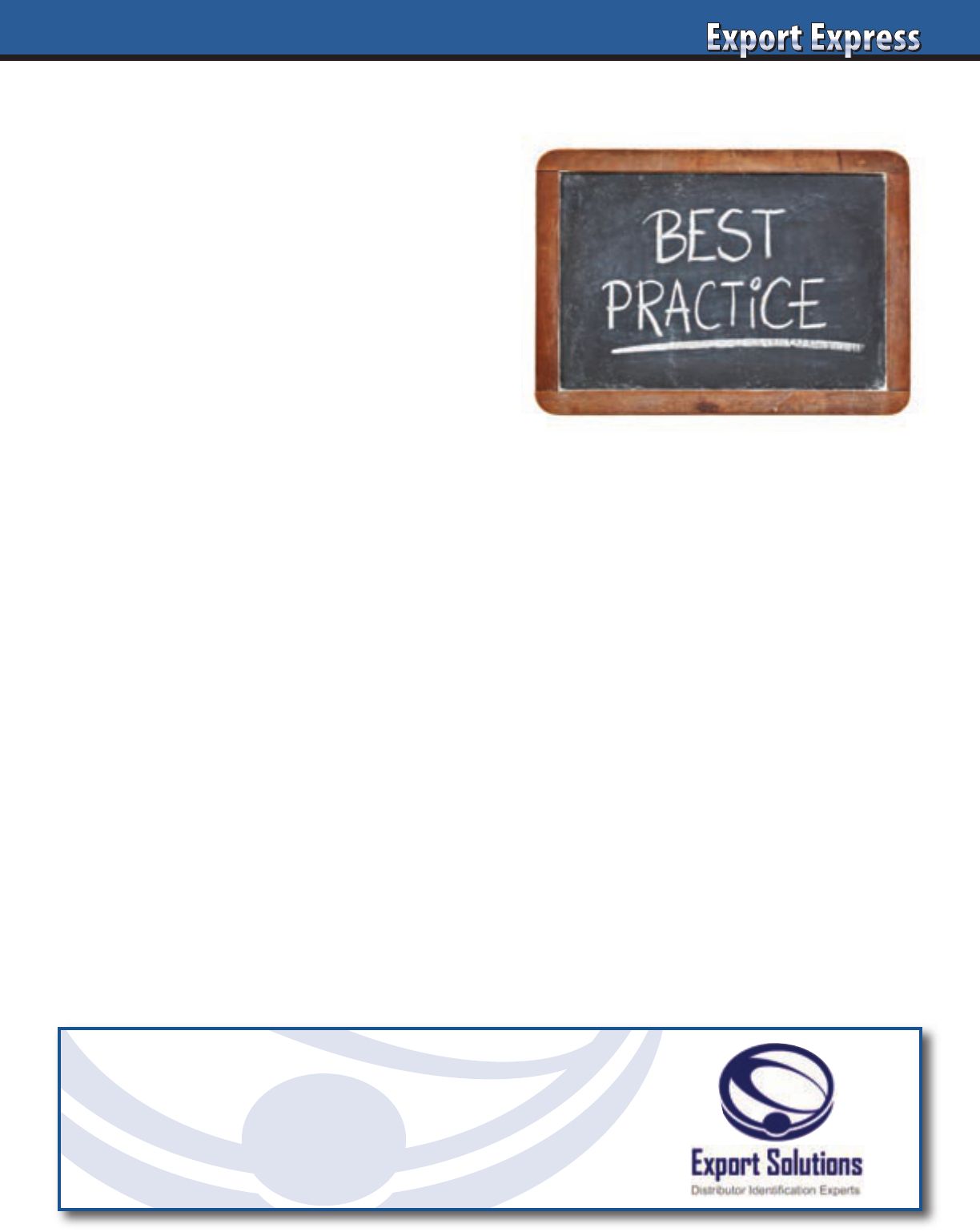
How can you take your business to the next level? Export is not
easy and managers are constantly challenged to create miracles.
Game-changing results demonstrated by sales increases of
20 percent, 50 percent or more require aggressive strategies,
not just a repetition of last year’s promotion program.
Read Export Solutions’ 12 tips (20 percent more than 10 tips!)
for driving exceptional results.
1. Big Bet – Focus Country
Pick one mid-size country where you have a decent business,
but significant potential to grow. Test a “heavy-up” marketing
investment program. Invite the distributor to visit your headquarters
to meet senior management and secure commitment for delivering
the “stretch” plan.
2. Dedicated Brand Manager at Distributor
Fund a dedicated brand manager “in house” at your distributor. This
person should maintain a dual reporting relationship to the distributor
and you. Your exclusive manager will immediately identify issues
(and solutions) and supply laser focus against priorities. Allocating
a budget for a “junior” brand manager may pay out.
3. Mergers and Acquisition
Consider buying a local category competitor. This may increase your
scale and provide access to resources such as factory or a direct sales
team. “If you can’t beat them, buy them.”
4. E-Commerce Focus
E-commerce represents a different sales channel. We’ve viewed
cases where a brand is a “sales hero” in e-commerce, but not
available through conventional supermarkets or pharmacies.
E-commerce sales may be highly incremental.
5. Costco Global Deal
Costco ranks as a global retailer, with 2022 sales expected to reach
around $150 billion. Costco operates 770 stores, including 245 high
volume outlets outside the USA. Costco loves exclusive, “mega
pack” offers and can purchase large quantities centrally for the
USA or certain international regions.
6. Celebrity Endorsement
Millennials are glued to their phones, waiting for the latest news
to cross their Instagram feed. Hire a local agency to snare celebrity
endorsements or mentions from popular bloggers.
7. Drop Your Price
How much incremental volume would you generate with a 20
percent price drop? 30 percent? In some cases, your distributor will
share or co-fund a meaningful price reduction. The incremental sales
and fatter market share may represent a good return on investment.
8. Co-Promotion
Link with a famous local brand in an adjacent category.
Challenge your distributor to offer a group promotion with
several of his brands. I have observed promotions where you
buy one brand with a higher price point and another brand
(could be yours) is given away free and the other manufacturer
reimburses you for your wholesale cost.
9. Sales Contest
Everyone loves a sales contest! Feature an expensive prize like
a trip to a resort destination or a big screen television and watch
your reps sell like crazy.
10. Local Co-Packer
In-country production may translate to more competitive prices
by avoiding duties and dealing with local cost inputs. In other
cases, consider shipping in bulk and packing finished goods
on site.
11. LTO – Limited Time Offer Pack
Create a special pack with vintage labeling or celebrating a local
sports event. I thought that the “Share a Coke” campaign with
personalized bottles was outstanding.
12. Monthly Market Visit
Most export managers rely on periodic visits to measure
distributor progress. This prevents a “deep dive” into the issues
and familiarity with your brands performance outside the capital
city. Select a country like Saudi Arabia, Peru, Philippines or
Malaysia where visit frequency can impact results. “A distributor
respects what the brand owner inspects.”
Twelve Tips: Generating Game-Changing Results
Looking for Good Distributors?
Export Solutions’ database covers
9,200 distributors in 96 countries.
www.exportsolutions.com
47
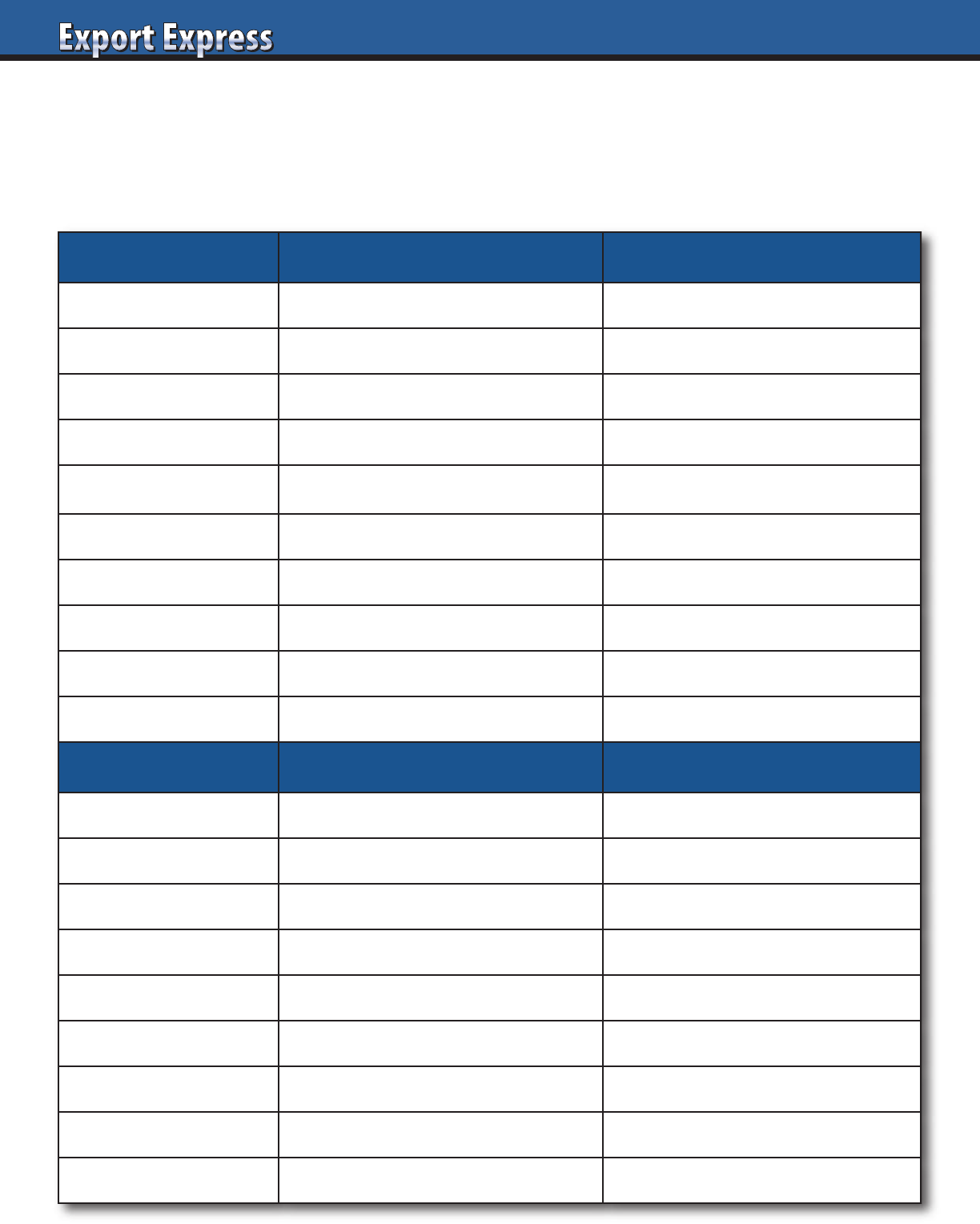
48
Tactical Exports vs. International Brand Building
What are your realistic aspirations for a country? There is a big difference between tactical exports and
strategic brand building. Companies can win in smaller countries with an “export only” strategy.
Brand building requires a financial commitment. Either option works. Companies need to align market
ambitions with their investment plans.
Export Brand Building
Market Research None Local consumption habits
Product portfolio Best sellers from home market Tailored to country/region
Packaging Standard packs stickered Native language
Factory Corporate headquarter based Offshore
Marketing Investment
Trade marketing only (10 percent of sales?) TV, 360 marketing 20-30 percent of sales
Retail Pricing Premium to super premium Equal to competitors
Route to Market Distributor Direct team or distributor
Oversight Periodic visits Dedicated country manager
Market Share Ambitions Niche Player
Complexity Low High
Export Countries Brand Building Countries
Caribbean USA
Malta, Cyprus, Portugal Western Europe
Central America Mexico
Middle East China
Hong Kong/Singapore Japan
Taiwan India
Nordics Russia
Baltics Turkey
Chile, Peru, Ecuador Brasil

Searching for New Distributors?
Export Solutions makes life a little easier for more than 3,000 export managers.
Our time saving distributor database serves as a “helper” for identifying more
than 9,200 qualified, local brand builders in 96 countries.
“Select Your Distributors,
Do Not Let Your Distributors Select You”
www.exportsolutions.com
Local Experts
Distributor Coverage
Asia: 2,030
Europe: 3,139
Latin America: 1,574
Middle East: 937
USA/Canada: 1,464
Category Experts
Distributor Coverage
Beverage: 1,691
Candy/Snack: 2,713
International Food: 3,276
Health & Beauty: 1,800
Natural Food: 837
Country Experts
Distributor Coverage
German Brands: 648
Italian Brands: 1,397
UK Brands: 682
USA Brands: 1,189
Search by Country, Category, or Country of Origin
49
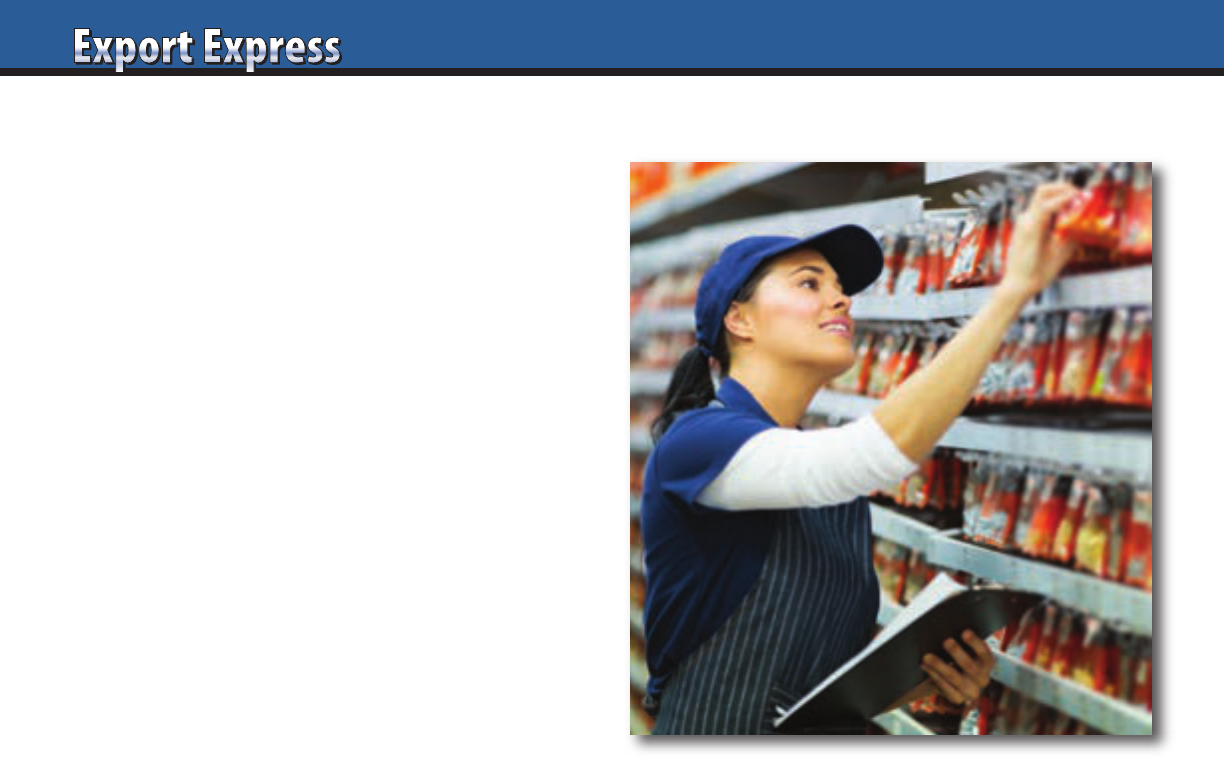
50
I just returned from Central America where retailers such as
Walmart, Auto Mercado (Costa Rica), and Super 99 (Panama)
suffer from out of stock conditions due to direct import practices.
A retailer’s primary objective is to maximize sales, which is
tough to achieve if there are gaps on your shelf as you await the
next container from the USA. “Service” defines best-in-class
manufacturers like Coca Cola and distributors which maintain
local inventory and strong commitments to keeping in store
product showrooms “looking good.” Listed below are Export
Solutions’ Ten Tips why an international retailer should source
your brand from a local distributor versus waiting for a direct
shipment from your central factory.
1. Local Inventory: 24-48 Hour Delivery
Local distributors promise 24-48 hour delivery, instantly
correcting costly out of stocks. Direct import supply chains may
take up to six weeks for inventory replenishment. We have all
witnessed situations where a retailer allows 1-2 items to run out
of stock for weeks to wait to place a consolidated order or to
encourage sales of a size where they are overstocked.
2. Brand Building vs. Availability
Direct import brands look lonely on the shelf, without any
activation or promotion. I remember the case of Hidden Valley
Ranch, the leading USA salad dressing from Clorox. I was
thrilled when it showed up on the shelf of my Walmart in Buenos
Aires. However, I was one of a few homesick expats who knew
about Hidden Valley. Without support, the brand gathered dust
and was discontinued.
3. In-Store Merchandisers: Emerging Markets
In-store merchandisers or distributor appointed “shelf stockers”
represent an essential function across Latin America, Asia,
and the Middle East. Large distributors maintain armies of
merchandisers to fight for shelf space and brand presence for the
brands that they represent. Retailers typically offer “prefunctory”
stocking for direct import brands, with low level of compliance
versus agreed to terms. I recall a situation in Mexico for a leading
USA beverage brand. The retailer had complained about slow
rotation of the direct import brand. We checked stores and saw
that only 2 of 4 sizes were typically cut in on the shelf, with
items relegated to the bottom or top shelf, nowhere near
“planogram promises.”
4. Distributors: Local Category Advisors
Distributors understand local taste preferences and share trends
from other market customers. In emerging countries, normally
there is a preference for smaller sizes than the family packs
offered in USA or European supermarkets.
5. Problem Solving: Pricing, Shelf Tags and More
Success in the consumer goods industry requires focus on the
myriad of details from the factory to the store shelf. Without a
distributor, difficult to identify and correct routine problems like
incorrect pricing, missing shelf tags , and misshelved goods.
6. Promotions Drive Trial and Tonnage
Local distributors offer periodic promotions to stimulate sales.
Typically, this translates to price discounts, but can also include
sampling, banded packs, and joint displays. Direct import brands
usually sit on the shelf without the benefit of local activation.
7. Point of Sale Material and Stock Rotation
Emerging markets permit point of sale materials which
encourage sales. Distributors provide special display pieces
or trial size shippers. Merchandisers rotate stock regularly
to facilitate “first in, first out” movement.
8. Damaged, Expired Goods or Product Recall
Local distributors provide a valuable service on returned goods.
This allows a retailer to remove out of date or damaged products
for a credit. With direct imports, the sub-prime product lags
unattractively on the shelf, with no one focused on replacement.
9. Payment Terms
Distributors offer retailers 30-60 day payment terms. Smart
retailers fund their inventory from the “float,” buying and selling
goods before the payment is due. On direct imports, retailer
needs to tie up his money in inventory, in some cases paying in
advance and then storing goods until the unsupported brands
sell. Is this the best use of capital?
10. Retailers: Support Your Local Distributor Community
Distributors represent small/mid-size local businesses which
provide jobs to members of the community. Distributor
employees are shoppers too, likely to shop at customers that
are supporting their company.
Success: Create Total Country Customer Strategy
Export Solutions recommends dealing with a local partner
(distributor) who is capable of serving all market customers.
This allows you to optimize sales and maintain pricing
equilibrium. Retailers attempting to buy direct offer the
temptation of short term volume, but rarely translate to
long term brand building for the supplier.
Retailer Benefits: Purchase from Local Distributors
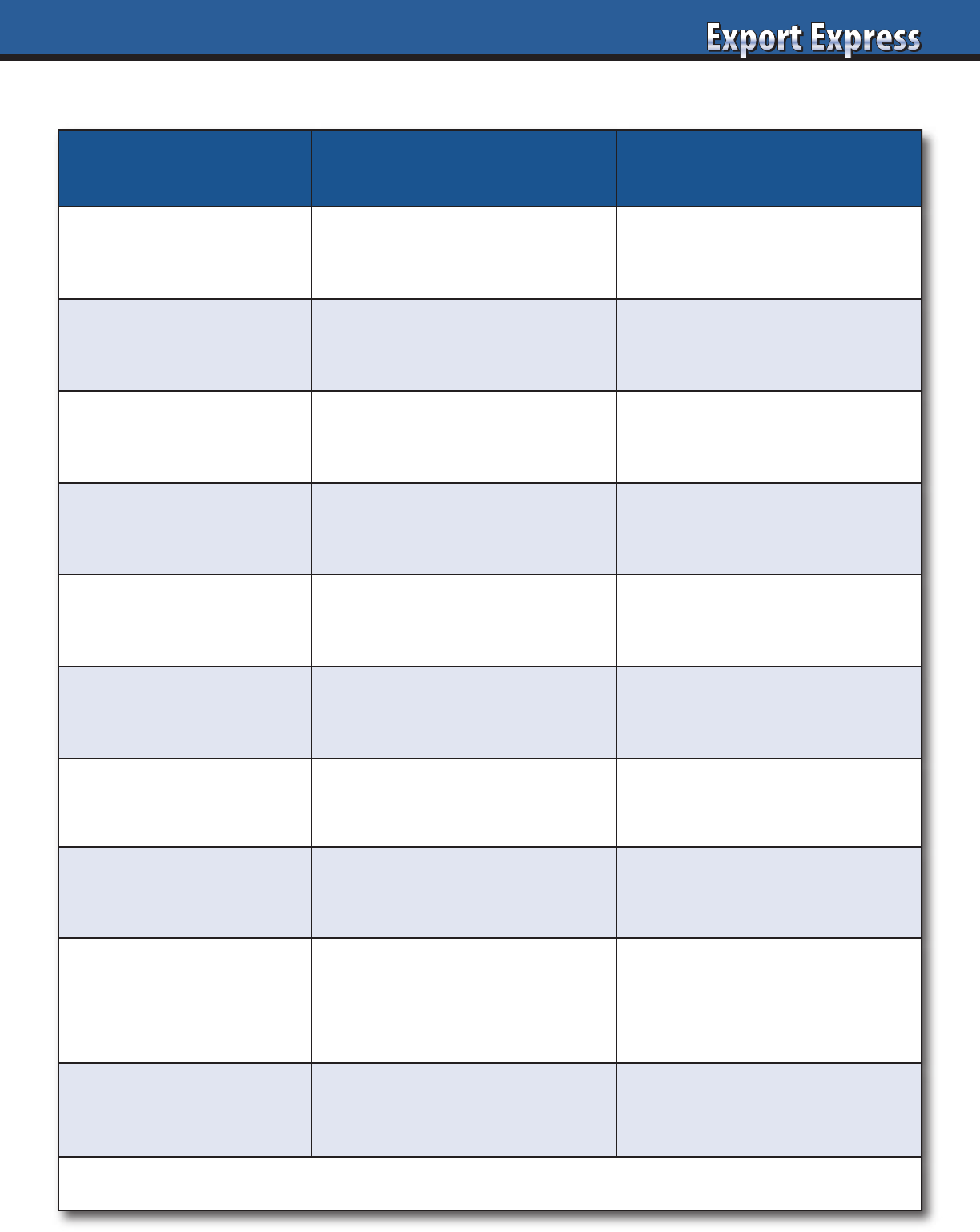
Reduce Export Diverting
Activity Bad Practice Best Practice
Logistics
Allow factory pickup or
delivery to USA* port
Ship directly to distributor
Label USA* pack, 100% English
Translated to distributor’s
language
Distributor Profile
Small company with no
web site or brand references
Well known local distributor
handling other global brands
Pricing
Low price combined with
USA* port pickup
Export pricing model,
ship directly to distributor
Partner Due Diligence Start partnership without visit
Extensive evaluation,
including in market visit
Pack Size Standard USA* package
Special “multi language” pack,
labeled “Export Only”
Store Check No trip to check stores
Annual visit to document store
conditions and warehouse stock
Listing Map No customer level information
Report local product
authorization, by retailer
Syndicated Data No data
Obtain data to compare
purchase levels with
market consumption
Reference Check
No financial
or commercial checks
Check current principals plus
financial institutions (D & B)
* For Made in USA brands
51

52
A few years ago, I described a
multinational’s “Big, Big, Big” strategy.
This company focused on Big Brands,
Big Countries, and Big Customers. This
approach may function well for billion
dollar giants, capable of building local
factories, hiring large teams, and investing
millions in brand support. However, many
exporters have been disappointed the last
five years when “BRIC dreams turned into
Export nightmares.”
Exporters: consider a “Small, Small, Small” strategy as a route to profitable growth.
Small Channels – E-commerce, Gourmet, Ethnic.
Small Countries – South Korea, Chile, Saudi Arabia, Spain, etc.
Small Investments – Trade/marketing costs everywhere, but total spend is lower
in emerging channels and small/mid-size countries.
Listed below are considerations for developing your “Small, Small, Small” strategy.
1. Massive Supermarket Chains: Demanding & Declining
Traditional supermarket chains are losing share. To sell to them today, you “spend more
to sell less!” Smaller chains and channels may be more open to innovation and feature
lower cost of participation.
2. Limited Local Production: Small/Mid-Size Countries
Big countries feature well established local producers, guarding their shelf space.
Smaller countries frequently do not contain many local manufacturers and remain
dependent on adjacent countries or USA, UK, Germany, Italy, etc. for many of their
brands. Examples include USA companies selling far more to Puerto Rico than they
do to Brazil. UK companies export more to Ireland than to Russia or Italy.
3. Lower Investment Levels
Brand investments are relatively proportional to country population and per capita
income. A $10,000 – $100,000 investment drives significant presence and funds solid
marketing activities in many small/mid-size countries. This allows your brand to
capture market share versus serving as a niche player in a large country.
4. Distributor Capability: Inversely Proportional to Country Size
Some of the world’s best distributors are based in Panama, Norway, UAE, or Singapore.
Why? In these countries, even multinationals like P & G, Kellogg’s, and Barilla may
partner with national distributors. In large countries like the USA, China, India,
distributors usually handle only niche brands, regional coverage, or small shops.
5. Make Multi-Channel Bets
There is incremental business available through attacking new trade channel opportunities.
This may require distributors to expand coverage and “attack something new.”
Manufacturers should conduct a “Lessons Learned” exercise. What countries are
delivering superior growth and highest market shares? Which new channels and
customers are recording double digit sales increases? What are channel success stories
from other countries? Which markets do not demand mandatory listing fees and deliver
superior results for your investment? What is your global e-commerce strategy?
In many cases you can deliver “big” increases from thinking “small.” Good luck!
www.exportsolutions.com
Greg Seminara
gseminara@exportsolutions.com
404-255-8387
“Spend Time Selling to Distributors versus Searching for Distributors”
Small, Small, Small Strategy
Strategic Services
Contact Us for
Export Solutions
1. Identify Best in Class
Distributors: 96 Countries
2. Best Practices
Export Strategy
3. Distributor Management
Workshops
4. Export 101:
Let’s Get Started
5. New Market
Prioritization
and Launch Plan
6. Personal Distributor
Introductions:
96 Countries
7. Walmart International
8. Distributor Contracts,
Margins, and Fees
9. Meeting Speaker
10. International
Strategy Expert
Strategic Services
Contact Us for
Export Solutions
1. Identify Best in Class
Distributors: 96 Countries
2. Best Practices
Export Strategy
3. Distributor Management
Workshops
4. Export 101:
Let’s Get Started
5. New Market
Prioritization
and Launch Plan
6. Personal Distributor
Introductions:
96 Countries
7. Walmart International
8. Distributor Contracts,
Margins, and Fees
9. Meeting Speaker
10. International
Strategy Expert
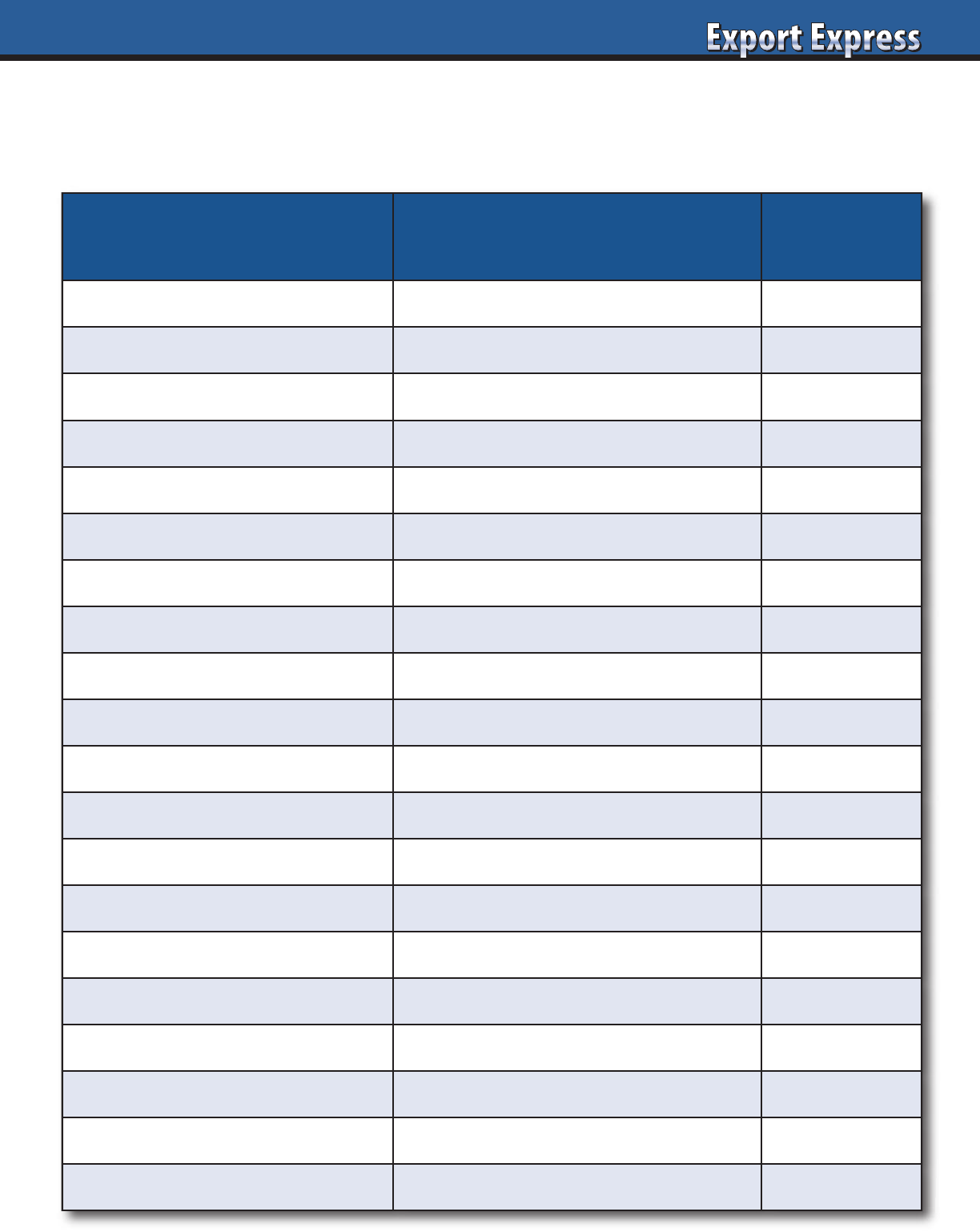
53
Preferred Supplier Scorecard
Distributors deliver their best results for their favorite principals. How do you rank?
Supplier Assessment Considerations
Rating:
(10 = Best)
Annual Sales Revenue • Percent of total distributor sales
Annual Profit Generated ($)
• Net sales times gross margin
Years of Service • New to 20 years or more
Compound Annual Growth Rate
• Flat to 10% or more
Supplier Investment Level • Zero to 25% of sales
Celebrates Success
• Awards, dinner, thank you notes
Shares Best Practices
• Serves as category expert
Logistics Service Level
• Target 98% on time, complete orders
Visits Retail Stores
• Never to full day every visit
Reimbursement of Billbacks • 2 weeks to 3 months
Senior Management Relationship • None to long term partners
Export Manager Experience • New hire to 10 years or more
Response Time • Same day to one month
Supports Distributor’s Ideas
• Invests in local ideas
Good on Customer Calls
• Avoids calls to customer favorite
Admin Requirements • Orders only to multiple reports
Supplier Visit Frequency • Never to weekly
Relationship: Entire Team • Finance, logistics, administration
Respects Fair Profit for Distributor • Healthy distributor is profitable
Achieves Joint Business Targets • Creates culture of success
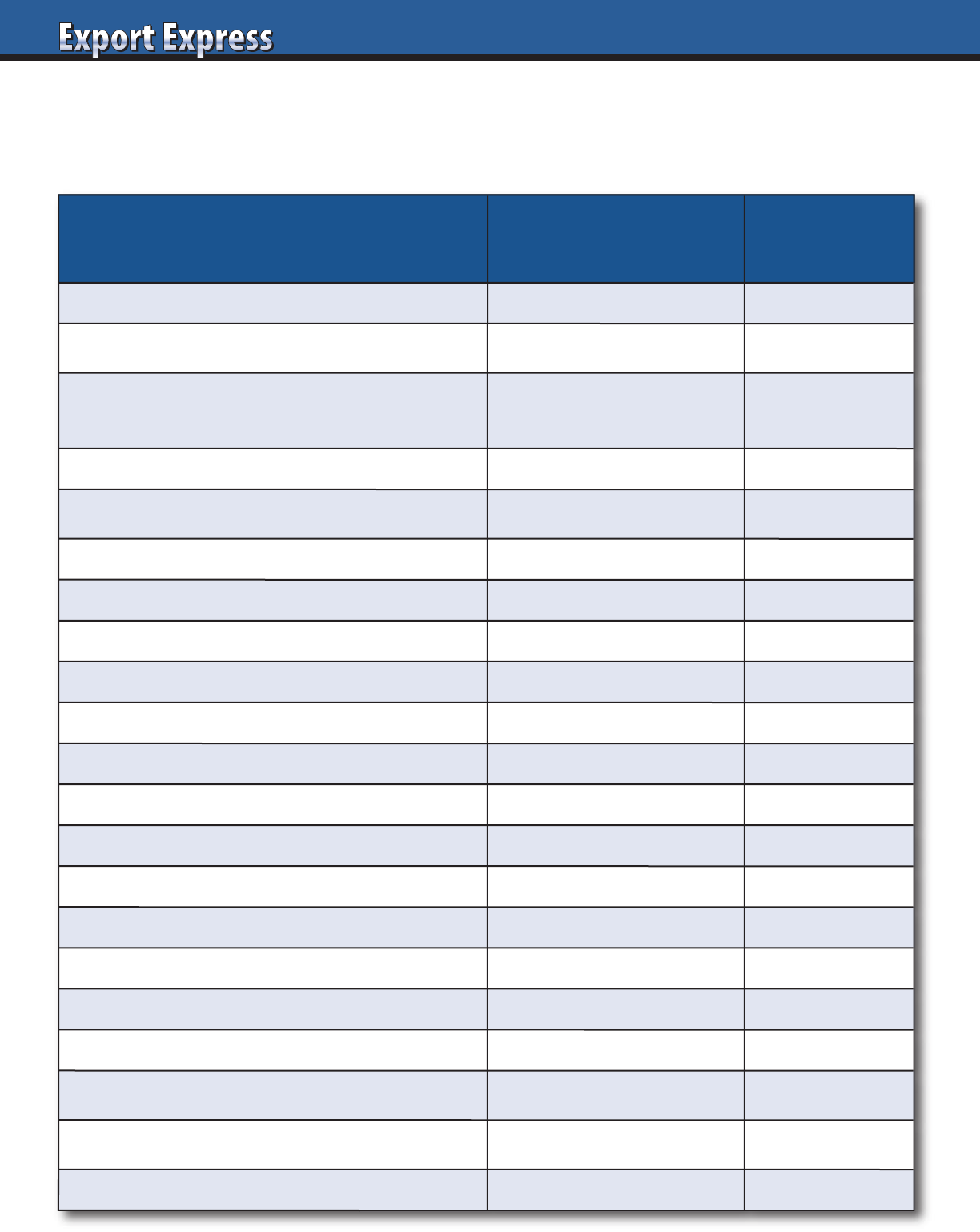
54
Cost Calculation Assessment*
*Ambient grocery example: Higher margins – Chilled and Health & Beauty products
Assessment Criteria
Global
Benchmark
Actual
Retailer: Everyday margin
20-35%
Retailer: Back margin (rebates,discounts)
0-10%
Retailer: Other margin
(Damage, merchandising, central warehouse)
0-5%
Total Retailer Gross Margin
25-40%
Trade Promotion (Manufacturer)
5-20% of net sales
Total Distributor Margin
15-35%
Warehouse/Stickering
2-4%
Delivery
2-5%
Total Distributor Logistics
3-7%
Key Account Sales
1-3%
Brand Management
1-2%
Merchandisers/Field Force
0-4%
Total Distributor Sales Team
4-6%
Administration
1-2%
Finance and Collections
2-5%
Overheads (office, IT, corporate)
2-5%
Distributor Promotion Investment
0-10%
Distributor Net Profit
2-5%
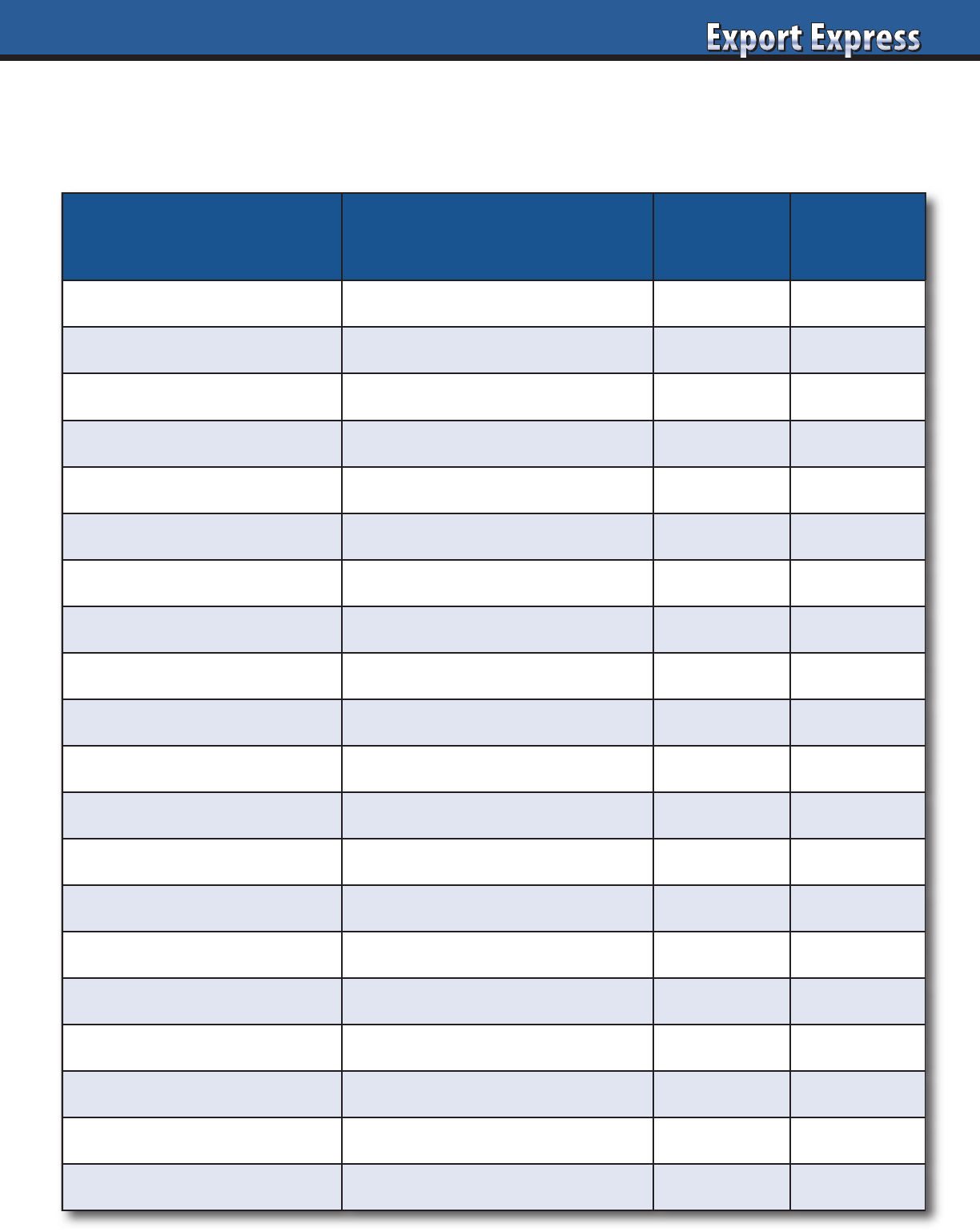
55
Analyze: Your Contribution to Distributor Profit
Export Solutions: 20 Factors Driving Distributor Profitability
Assessment Criteria
Considerations
Result
Rating:
(10 = Best)
Annual Sales Revenue • Percent total distributor sales
Annual Margin Generated ($) • Net sales times gross margin
Distributor Percent Margin
• 10 percent to 50 percent
Brand Owner Investment Level
• Percent of distributor purchases
Distributor Margin Re-Investment
• Distributor promotion spending
Category Adjacency • Distributor portfolio synergies
Brand Market Share
• Niche versus market leader
Payment Terms
• Pre-pay versus 120 day terms
Safety Stock Requirements • Two weeks to four months
Typical Customer Order • One case to full truck
Shelf Life • Two weeks to five years
Case Cube/Case Cost • “Low cube, high case cost best”
# Brands/Items in Range
• “High sales, fewer items valued”
Logistics/Storage: Temp?
• Ambient versus chilled
Damage/Expired Goods • None to 20% of sales
Category Competition
• Niche to highly competitive
Labor: Battle for Shelf Space
• None to intense fight
Brand Manager
• Shared or dedicated
Admin Requirements • Orders only to multiple reports
Manufacturer Visit Frequency
• Never to weekly
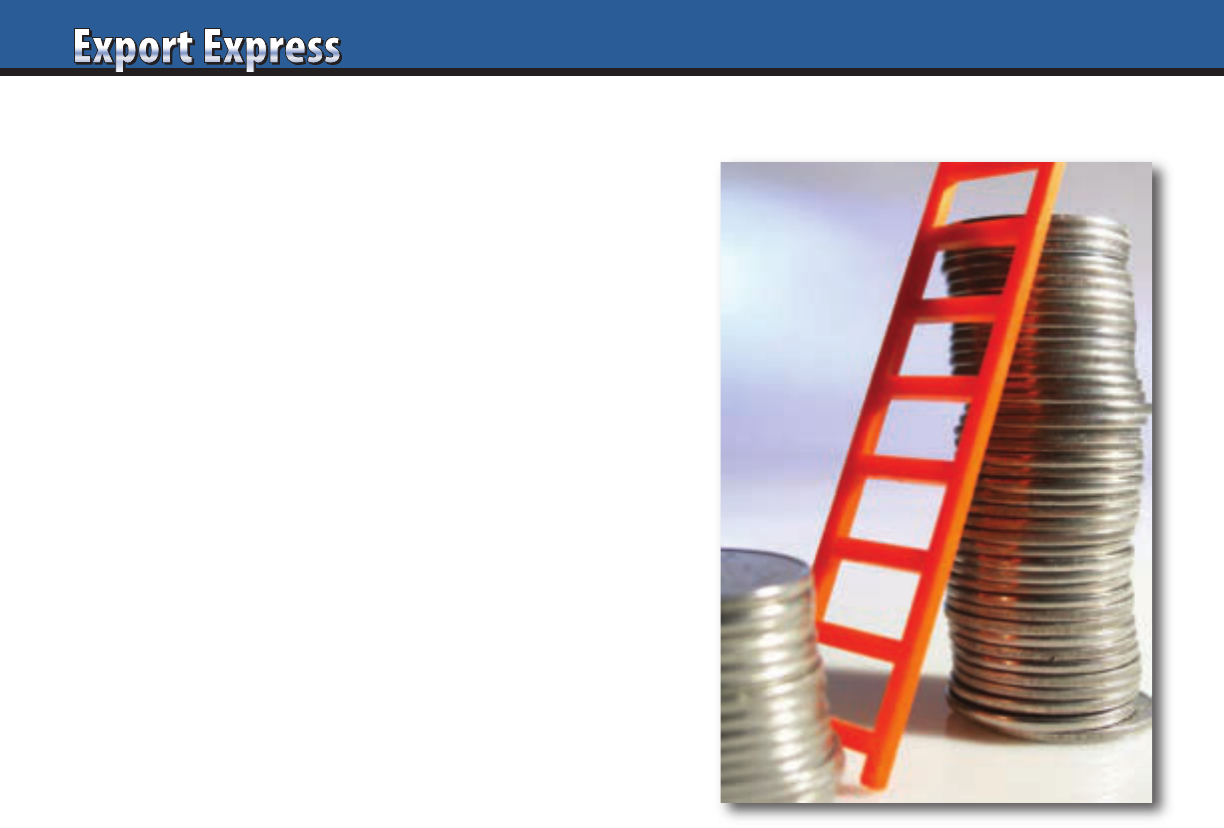
56
Everyone knows their own salary.
But have you given much thought
to the compensation structure for
your distributor partners? Distributor
compensation is often a “murky” issue,
buried in a calculation created years ago
focused on a combination of distributor
margin plus other income for services
rendered. Brand leaders periodically
review their distributor compensation
structure and compare it to the
requirements to service their business in
2022. Listed below are Export Solutions
“Ten Tips” for analyzing your distributor
compensation model.
1. Convert Distributor Margin
to Gross Dollars Earned
Margin percentages are important,
but another critical measure is absolute
income derived from representing your
brand. This simple calculation of gross
margin multiplied by invoiced sales
provides a baseline number. If applicable,
manufacturers should add bonuses or
subtract retailer rebates.This is the first
step to understanding your true
distributor compensation.
2. Shared Service Model
Typical distributor services may include
importation, warehousing, delivery,
selling, merchandising, invoicing, and
collections. In some cases distributors
reinvest a portion of their margin in trade
discounts or in store marketing activities.
Another major distributor expense is
people, including senior management and
a brand management team. Income from
your brand margin buys your company
a share of total distributor resources.
3. Value Equation:
Distributor vs. Local Subsidiary
An important exercise is to evaluate the
services received from the distributor
relative to what they would cost if you
needed to create your own independent
subsidiary in a country. Your analysis
should include subsidiary allocations
for buildings, information technology,
telecommunications, travel, and
entertainment. Normally, the result
demonstrates that the distributor model
is an efficient outsourcing alternative.
The key is to balance your many company
objectives versus the requirement to
function in a “shared services”
environment where you are “buying”
only part of the distributors time.
4. Pay For Performance
Most food and consumer
goods industry executives
operate in a compensation
structure which includes a
bonus incentive for achieving
and exceeding assigned goals.
Some brand owners have
extended this approach to
distributors so that the entire
team is aligned on a common
plan. All distributor bonus
schemes should reward cases
moved into consumption
versus warehouse inventory.
5. Price Increases mean
Distributor Pay Raise
Many suppliers were fortunate
enough to execute price
increases. In a margin driven
structure, this often translates
to a pay raise for the
distributor, with little
incremental effort other
than implementing the price
increase. On the other hand,
a price decline means a
reduction in distributor
compensation and the
distributor needs to execute
his own “salary” reduction!
6. Contracts and Margins from the 1990’s
Many distributor contracts and margin
calculations date back to the 1990’s or
many years earlier. These agreements are
rarely revised or reviewed based upon
the realities of competing in today’s
marketplace. When was the last time that
you reviewed your Distributor contract,
margin, and service requirements? Does
it still make sense?
7. I don’t know my distributor’s margin
This happens more frequently than you
might imagine. In many arrangements,
the distributor buys your brand at a dead
net price and applies their own internal
methodology for margin development.
Some distributors are protective of this
practice with a rationale that manufacturers
should not “pry” as long as shipments
maintain a positive trajectory.
8. Best in Class Distributor Compensation
Leading Distributors offer an open book
approach based upon a cost to serve
model. Financially astute distributors
provide new suppliers a detailed
template identifying key services and
manufacturers requirements to operate
the business. Smart manufacturers will
benchmark their distributor margin
versus similar brands in the market.
Key inputs include complexity of your
product line, logistics inputs (temperature
requirements, case weight) and size of
your business.
9. Total Compensation:
More than Gross Margin
Examine every line item in your market
price calculation to understand total
distributor revenue sourced from your
brand. Distributors may increase their
income through promotional funds,
added margin for logistics services,
or periodic bill-backs.
10. Distributors have Profit Targets Too!
Distributors are in business to make
money too! It is quite reasonable to
expect that the distributor should
realize a net profit of 3-5 percent.
Everyone hopes to grow their salary
base and receive bonuses for excellent
performance. Winning long term
relationships exist when both parties
profit from business success.
Ten Tips – Distributor Compensation Analysis
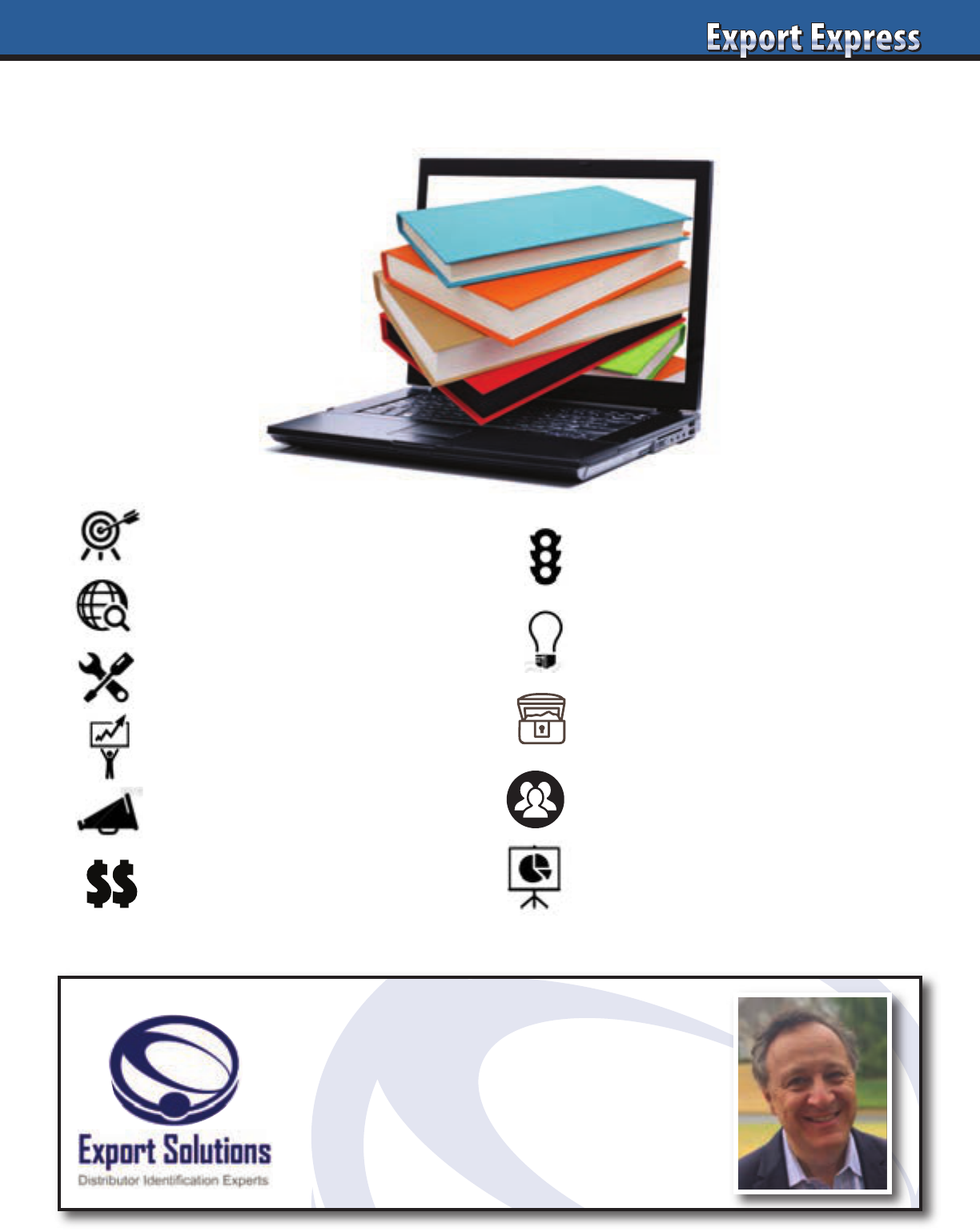
57
Create Your Own Export Library
Looking for a fresh point of view for your
next event or training workshop?
Contact Greg Seminara at
greg@exportsolutions.com
All guides available free at www.exportsolutions.com.
Export Strategy Guide
Distributor Search Guide
Export Handbook
Selling to USA Handbook
Distributor Management Guide
Finance & Logistics
300 Tips for
Export Managers
Idea Guide:
New World – New Business
Export Treasure Chest
My Favorite Templates & Forms
People Power
Strong Teams Build Great Brands
New Distributor
Cooperation Model
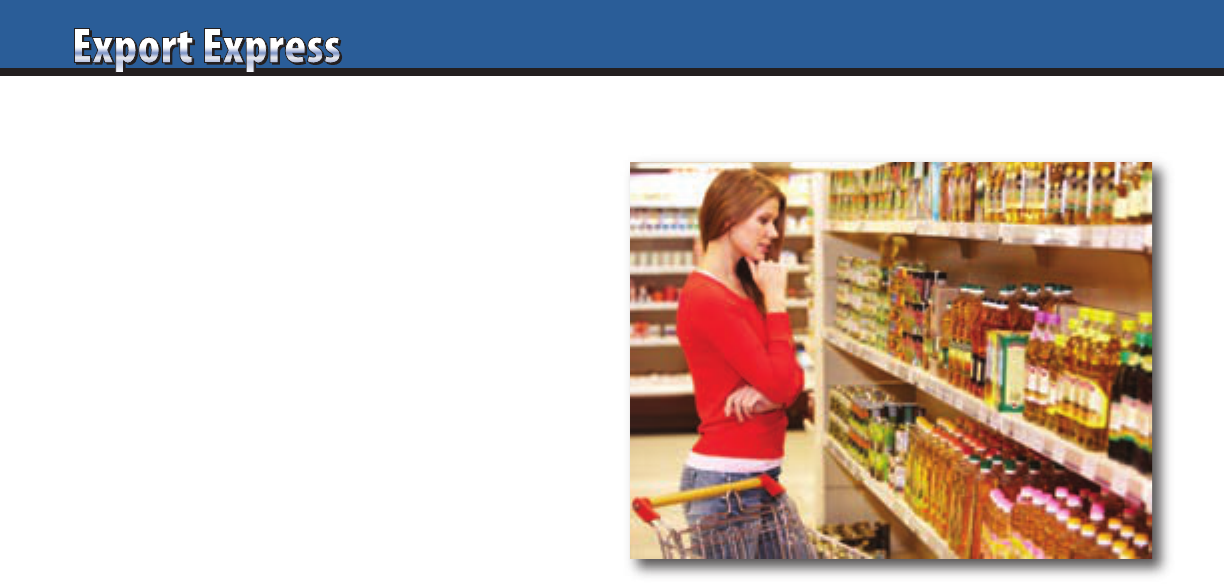
58
Retail stores serve as showcases for our products. This is
the point of sale where inventory is translated to a consumer
purchase. However, many manufacturers spend the bulk of
their energy against securing the headquarter listings, chasing
shipments, while store conditions flounder at the middle of
the priority list.
Increased focus on in-store conditions is critical because it
delivers benefits every single day. Listed below are Export
Solutions’ tips for winning the battle at the retail shelf.
1. Define and Publicize Your Shelf Objectives
The first step is to insure that each member of your sales team
is “crystal clear” on your brands in-store objectives. Create a
shelf conditions standards book, including photos that can be
distributed or shared online. I’ll always remember a store visit
in Cordoba, Argentina when I was a manager for Clorox. The
distributor representative proudly brought me to his “best” store.
The store was not bad, but below objective because our brand
only owned 50% of shelf space versus our 65% market share.
When I mentioned my disappointment, the representative
accurately claimed that “no one had ever shared” this shelf
objective with him before.
2. Create an Objective Mechanism to Evaluate Every Store
How did your brand look in the last store visited? Was it
an “A,B,C, D, E, or an F”? Why? Establishment of a grading
system allows you to provide an objective report card for each
store. Normally, a system of awarding points for share of shelf
space, retail availability, and off-shelf merchandising is simple
to execute.
3. Focus on Basics: Distribution, Availability, Shelf Space,
Shelf Position, and Off-Shelf Merchandising
All authorized brand sizes should be tagged and in stock. Brand
should maintain share of category space equivalent to or greater
than market share and placed next to the targeted competitor.
Incremental points should be awarded for off-shelf displays or
secondary locations. Fair pricing is also important, but normally
tightly controlled by central buying.
4. Establish a Baseline for Store Conditions
Introducing new store conditions tracking metrics can be a
shock to your retail sales team, as existing conditions are likely
far below minimum acceptable standards. The idea is to create
a baseline of performance and measure monthly or quarterly
progress towards objective.
5. A Market Wide Retail Audit Creates an Accurate Benchmark
This requires the participation of 2-4 people (depending on
market size) from your company matched by an equivalent
number of people from your distributor/retail sales team.
Each two person team is committed to spend a full day at retail
and is assigned a certain city or section of town. Teams can
usually visit 10-15 stores per day giving you a broad spectrum
of results across the market. Each store should be measured by
the same criteria. Ideally, the entire group should meet at the
end of the day to share observations and next steps. Audits can
be tied into a major sales drive such as a new item rollout, peak
seasonality etc. A good distributor will work hard to fix problems
in advance of a previously scheduled market wide retail audit.
6. Sponsor a Retail Sales Contest
This retail contest can be tied to the launch of new retail sales
objectives or a “grading” system. Structure the contest for
maximum number of winners. Reward most improved from
a pre-contest baseline. Contest should be one-two months in
duration to optimize excitement and focus. Get creative with a
theme such as “A Room with a View” with first prize being an
overnight stay at a 5 star hotel room with a view for the sales
representatives stores have the best “view” for your brand.
7. Retailers Schematic/Planogram Serves as the Official Record
Request that each distributor forward the planogram for each
of the 2-4 largest retailers for each market. Reward key account
sales people for implementing changes in the official planogram.
8. Provide at Least One Shelf Objective for Every Month
A monthly objective for your brand or company forces the retail
team to look at your brand on every store visit. The objective
can be oriented against moving your brand to an eye level shelf,
improved shelf space allocation for a particular size/flavor, or
against reduced out of stocks. Track the objective with a question
that can be answered by “yes/no” or a numeric response. This
will allow you to participate with software on handheld retail
reporting devices.
9. Focus Against Accounts With Problems With Retail Execution
My experience tells me that some retailers are better at maintain-
ing attractive category showcases and in stock conditions. Other
high volume hypermarkets are plagued by frequent “wiped out”
categories. Certain accounts prevent representatives from
touching the shelf due to union policy. Persistent out of stocks
may reflect insufficient shelf space, low warehouse inventory,
or problems with automatic replenishment systems.
10. Visit Stores on Every Trip to the Market
Schedule time to work with the retail sales manager. Your
attention to store conditions will linger after your plane departs.
“Retail is detail” and the “distributor respects what the brand
owner inspects” are well known comments on retail. Send a
signal that you are focused on your retail showcase and watch
your brand presence improve!
Ten Tips – Winning the Battle for Retail Shelf Space
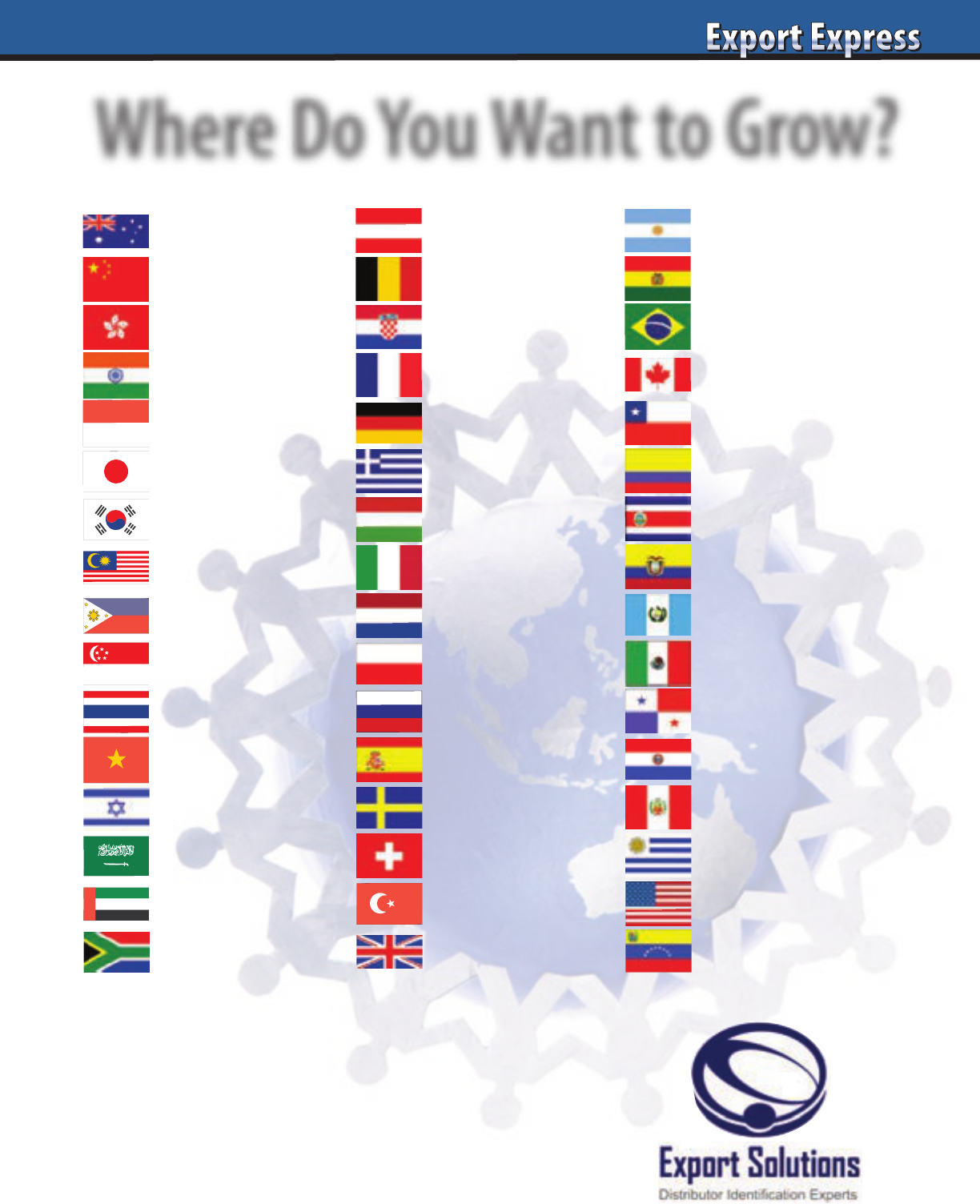
59
Where Do You Want to Grow?
Asia/Africa/Middle East
Europe Americas
Use Export Solutions Database
to fill in the Gaps in your
Export Coverage Map
Australia – 274 Distributors
China – 160 Distributors
Hong Kong – 177 Distributors
India – 109 Distributors
Indonesia – 78 Distributors
Japan – 176 Distributors
Korea – 146 Distributors
Malaysia – 128 Distributors
Philippines – 109 Distributors
Singapore – 163 Distributors
Thailand – 94 Distributors
Vietnam – 49 Distributors
Israel – 61 Distributors
Saudi Arabia – 115 Distributors
U.A.E. – 195 Distributors
South Africa – 106 Distributors
Plus 14 more countries
Austria – 68 Distributors
Belgium – 85 Distributors
Croatia – 78 Distributors
France – 125 Distributors
Germany – 188 Distributors
Greece – 90 Distributors
Hungary – 68 Distributors
Italy – 105 Distributors
Netherlands – 155 Distributors
Poland – 90 Distributors
Russia – 108 Distributors
Spain – 157 Distributors
Sweden – 103 Distributors
Switzerland – 100 Distributors
Turkey – 82 Distributors
U.K. – 274 Distributors
Plus 19 more countries
Argentina – 61 Distributors
Bolivia – 52 Distributors
Brazil – 135 Distributors
Canada – 205 Distributors
Chile – 92 Distributors
Colombia – 82 Distributors
Costa Rica – 73 Distributors
Ecuador – 55 Distributors
Guatemala – 61 Distributors
Mexico – 193 Distributors
Panama – 63 Distributors
Paraguay – 57 Distributors
Peru – 82 Distributors
Uruguay – 52 Distributors
USA – 598 Distributors
Venezuela – 38 Distributors
Plus 14 more countries
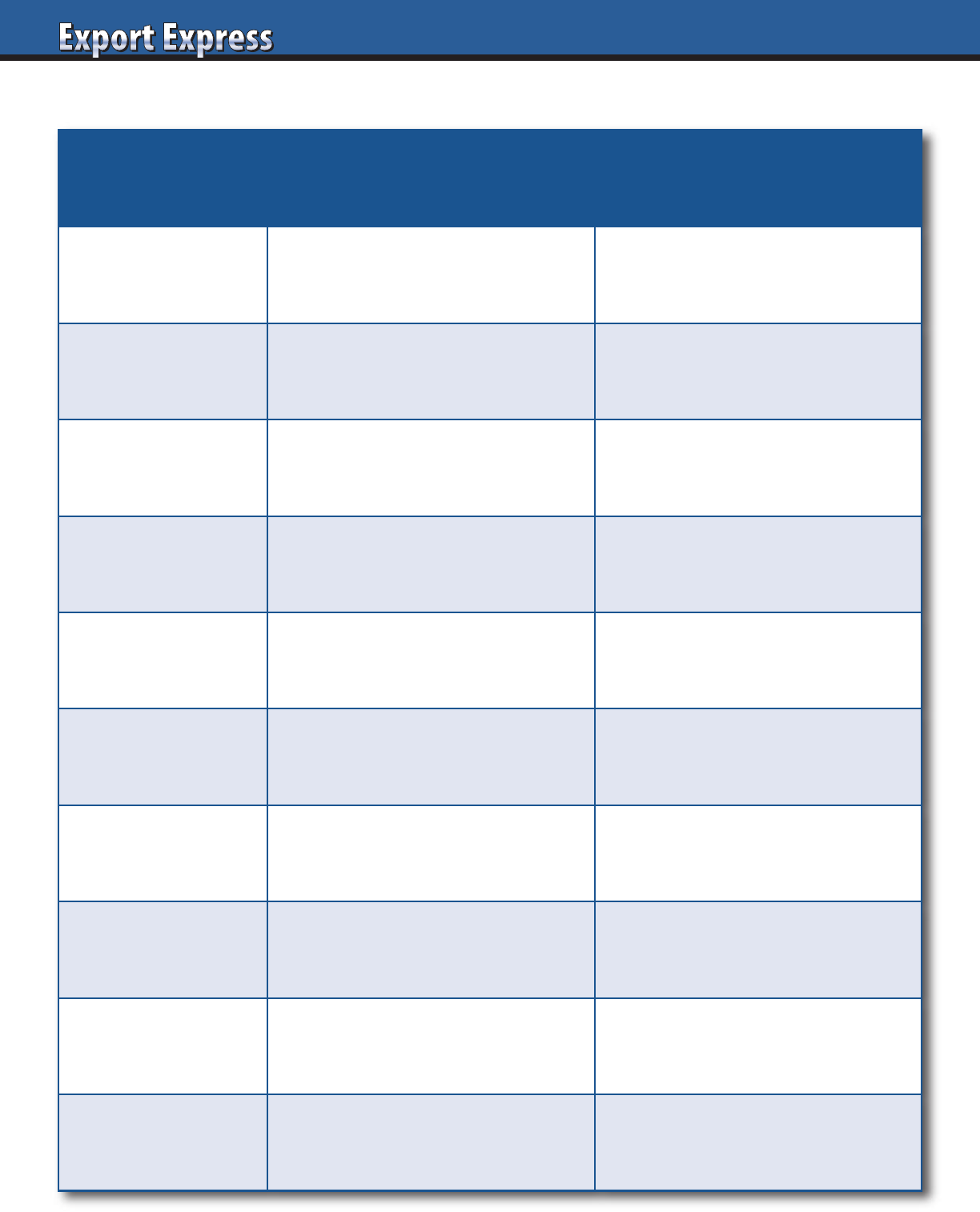
60
Is Your Distributor Best In Class?
Best in Class Distributor Average Distributor
Size Top 10 Supplier to Retailers. Top 100 Supplier to Retailers.
Coverage
Countrywide.
Offices outside Capital.
Major retailers only.
Technology
EDI, Web Portal,
Handhelds for sales reps.
Basic desktop capabilities.
Talent
Management:
Multi-national expertise.
“Home grown” talent.
Channel
Covers all channels
and small shops.
Major retailers only.
Marketing Full Brand Management services. Trade promotion only.
Retail Presence
Dominant presence at retail for
distributors brands.
Mixed presence at point of sale.
Cost to Serve Competitive, transparent model. Average cost to serve.
Logistics
Multiple warehouses.
24 hour delivery.
1 warehouse, 48 hour delivery.
Results Results exceed market growth. Results = market growth.

Ten Tips – Increased Distributor Focus on Your Brands
1. Quarterly MBO Meeting with Distributor
Senior Management
One of the most effective tools for
increased focus is to create a regular
process for Distributor senior
management engagement in your
business. The Management By Objective
(MBO) system (or similar approaches)
allows you to meet quarterly on a pre-
planned schedule to review past quarter
performance on key initiatives and firm
up plans and commitment for the new
quarter. Discussions should focus on
key business metrics and account specific
results. Meetings can be held via
teleconference if you can not visit
personally 4 times per year.
2. International Distributor
Network Conference
This can include all your global
distributors or those from a specific
continent/region. Program can be
1-2 days in length and can include
Corporate Business Review, New
Product Roll-Out, and requirement that
each distributor give a presentation on
a success story from their home market.
Meeting location can tie in with a major
trade fair such as SIAL or FMI to reduce
expenses. Alternatively, the meeting can
also be in a resort location to serve as an
incentive. Export Solutions is available as
a conference meeting speaker to discuss
a variety of distributor optimization
strategies and retail trends.
3. Sales Contests
Sales contests bring energy, excitement,
and focus to your brands. Sales contests
should be about six weeks in duration
and offer the opportunity for “everyone”
to win. Prizes can range from cash
incentives to trips to merchandise for
the winners. Sync contest objectives and
measures to your key initiatives for your
peak season or a new product launch.
4. Key Account Business Reviews
It is appropriate to conduct key account
business reviews with each of the
distributor’s top 3-5 accounts once per
year. Meetings should include senior level
management of the retailer. This strategy
requires distributor analysis of the
accounts business and opportunities for
mutual growth. This also provides you
with an avenue to develop a personal
relationship with local customers.
5. Retail Audit
Retail execution is critical to the success
of any brand initiative. An important
element in a new product launch or
preparation for your peak selling season
is the pre-scheduled Retail Audit across
a market. The Manufacturer would bring
2 or 3 people from their company and
match them with distributor personnel
for a day in the field checking retail
conditions. In one day, the 2-3 teams
can see 30-50 stores in the market to judge
the markets “readiness” and progress.
Distributor personnel are competitive and
will work hard to make the market “look
good” for the Retail Audit.
6. Plant Visit
Invite your distributors for a plant
visit and/or a trip to your corporate
headquarters. Distributor can be
introduced to members of your senior
management team. Distributors should
be encouraged to bring a large customer
as well. This type of trip can serve as
a “bonding” experience and create
a renewed sense of commitment to
your business .
7. Bonus Payment
Incentive pay for performance usually
works well with sales teams. Sync bonus
with your key objectives. Reward
performance on achievement of retail
distribution, profitability, as well as sales
volume objectives. Volume based objectives
alone may encourage questionable
shipments that could be diverted.
8. Distributor Sales Meeting Participation
Most distributors schedule monthly or
quarterly meetings for their entire sales
team. This is a primary format for the
distributor to communicate direction and
priorities. Most distributors allow their
manufacturers to make a presentation
on a new item or key sales drive.
Supplement your meeting presentation
with a small gift for all meeting
participants such as a pen, key chain,
or calculator with your company logo.
9. CEO Market Visit
Distributors appreciate a visit from your
CEO or other member of your senior
management team (CFO, VP International
etc.). This gives them the opportunity to
demonstrate their results and share their
input on the markets development. It is
magical to watch certain market issues
get “solved” immediately prior to a
senior management visit!
10. Share Best Practices
Create a process for sharing best practices
and success stories within your global
distributor network. These can be
communicated via a monthly newsletter
or email. Distributors are proud to share
their achievements or innovative new
strategies that they are using to build
their business. Manufacturers may elect
to reward distributors with the “best
success story” each month with a “free
dinner” or other incentive.
61
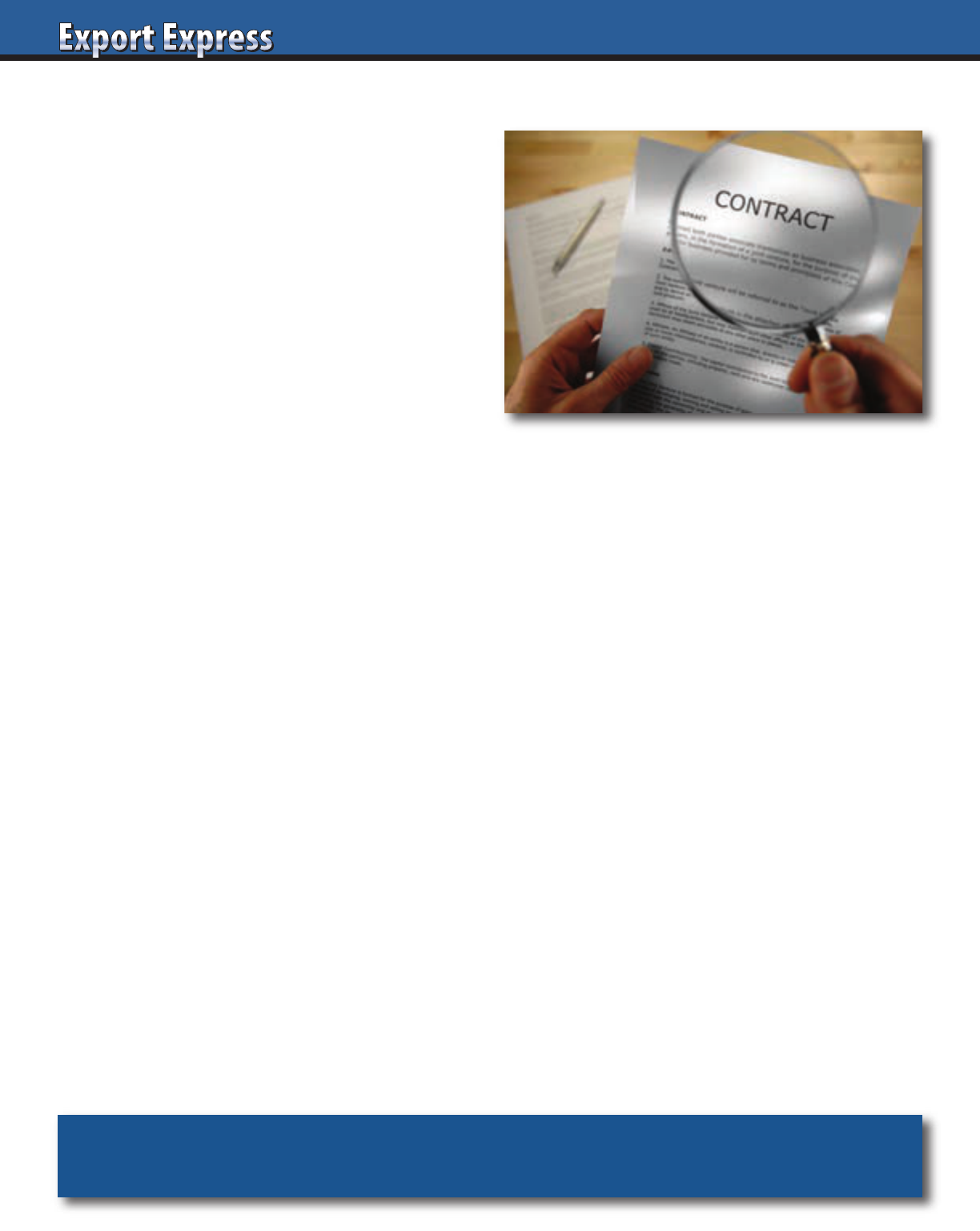
62
When was the last time you reviewed your distributor contracts?
Fortunately, both brand owners and distributors only dedicate
time to these documents at the start of a relationship or when the
end is near. View our ten tips on handling distributor contracts.
1. Contract, Letter, or Handshake Deal?
Most companies maintain a mix of these type of relationships.
This is normal, although most wish to standardize the model.
The rule of thumb is that the “more money you spend, the more
detailed the contract you need.” A simple two page letter of
understanding may be appropriate for a small business or a
handshake commitment in situations where the distributor
“buys and resells.” However, fully supported brand launches
and business management of a global brand usually requires
a detailed contract to protect both parties.
2. Sole Versus Exclusive Distributor
Most distributors demand country exclusivity. This is standard,
but may cause problems if the region is subject to inbound
shipments from global customers, e-commerce, or grey market
traders. A compromise is to offer a contract as the “sole”
distributor, providing protection from the manufacturer
appointing multiple partners in a country.
3. Distributors are Customers
At contract time, some manufacturers fail to remember that
distributors are customers, buying your product and reselling
to all local retailers. Suppliers may forward “one way” contracts
that are biased to terms favoring the manufacturer. Would you
send a contract like that to Kroger, Carrefour, or Tesco? Key is
to strike a reasonable balance favoring commercial sensibilities.
4. E-Commerce Implications
Many distributor contracts were executed before the advent
of e-commerce. Revised agreements may be necessary
incorporating e-commerce service requirements: items,
pricing, inventory, metrics, channel exclusivity.
5. Local Law Dominates
Overseas companies should have their contract reviewed by
a local law firm to guarantee compliance with local regulations.
For example, in Puerto Rico and Belgium, distributor (agent)
protection laws supercede any contract language.
6. Point of Arbitration
Normally, the brand owner automatically assigns his home
country as a point of arbitration for any disputes. In some cases,
both parties select a neutral country like Switzerland. A global
corporate counsel once taught me that ultimately any dispute
will need to be resolved in the distributor’s home country. For
example, a USA company can sue a distributor in a USA court.
It is unlikely that the distributor will hire a USA lawyer or even
show up. The USA court may enter a judgement, but the brand
owner still needs to go to the distributor’s country for enforcement.
7. Notification of Contract Termination
Standard contracts appear for two or three years with provisions
for automatic renewal. Distributors fight for long lead times;
a loss of brand can represent a major disruption. From a brand
owner’s side, would you want a terminated employee working
for you for six months or one year? I prefer three months
notification, but that can also backfire if the distributor resigns
your business.
8. Loss of Major Principal
Sadly, I have witnessed distributor bankruptcies because they
were doing “too well.” A distributor grows the brand to a size
where the manufacturer decides to take the brand back and form
a subsidiary. The distributor scrambles, but sometimes they need
to lay off more people and causes a rapid exit of other brands.
2022 contracts should require distributors to inform you within
10 days of notification (not effective date) of any loss of principal
representing ten percent or more of their business.
9. Global/Regional Customers
Large players like Walmart, Costco, Amazon, and Carrefour can
be difficult to manage. They demand best pricing system wide or
threaten to trans ship from other locations. In some cases, these
retailers may demand to “buy direct.” In this case, you can add
an “indent” clause permitting this practice while compensating
the distributor for local services such as merchandising.
10. Late Payments & Currency Exchange Rate
A distributor that pays late signals financial difficulties. Include
a clause that allows you the option to consider the contract in
default with payment delays beyond 45 days or with frequent
problem payers. The benchmark for calculating currency
exchange rates should be specified in the contract. I have seen
cases where a distributor assigns a five to ten percent benefit in
his favor to protect against the possibility of currency swings.
10 Tips: Distributor Contracts 2022
Need more information? Visit www.exportsolutions.com.
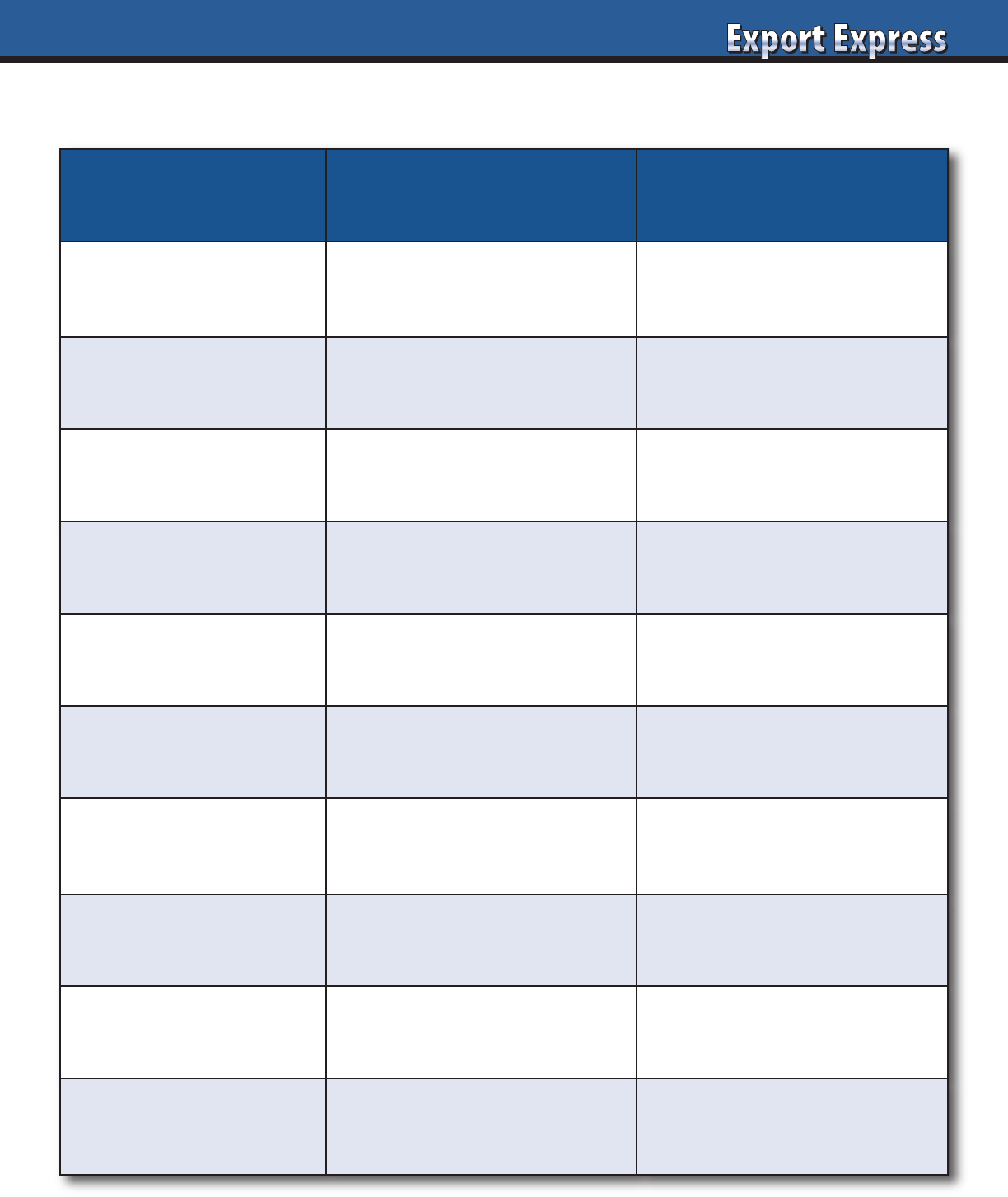
63
Recipe: Best in Class Partnerships*
Ingredient Brand Owner Distributor
Results
Realistic expectations based upon
investment/market conditions.
Achieve sales increase in excess
of overall market growth.
Category Expertise
Share knowledge, trends, and
category analysis.
Serve as local category expert.
Educate the buyer.
Innovation
Contantly deliver important
new product ideas to market.
Successfully launch new products
into the market.
Investment
Appropriate Investment levels:
marketing/trade promotion.
Optimize return on investment.
Store Presence
Create clear, realistic guidelines
for in-store presence.
Share of shelf exceeds market
share. Maximize visibility.
Ideas
Support market driven ideas to
build the business.
Relentless pursuit of new and
better ways to grow sales.
Reporting
Concentrate on Basics: Listing
Map, Pricing, Merchandising Plan.
Complete reports accurately and
on time.
Focus
Periodic market visits and “rapid
response” to issues.
Appropriate level based upon
brand size and opportunity.
Cost to Serve
Remember that distributors need
to make money too!
Fair margin based upon brand
size and complexity.
Recognition
#1 Fan. Frequent recognition of
good results by all team members.
Strong commitment to exceed
expectations everyday.
*Mix Well for Best Results
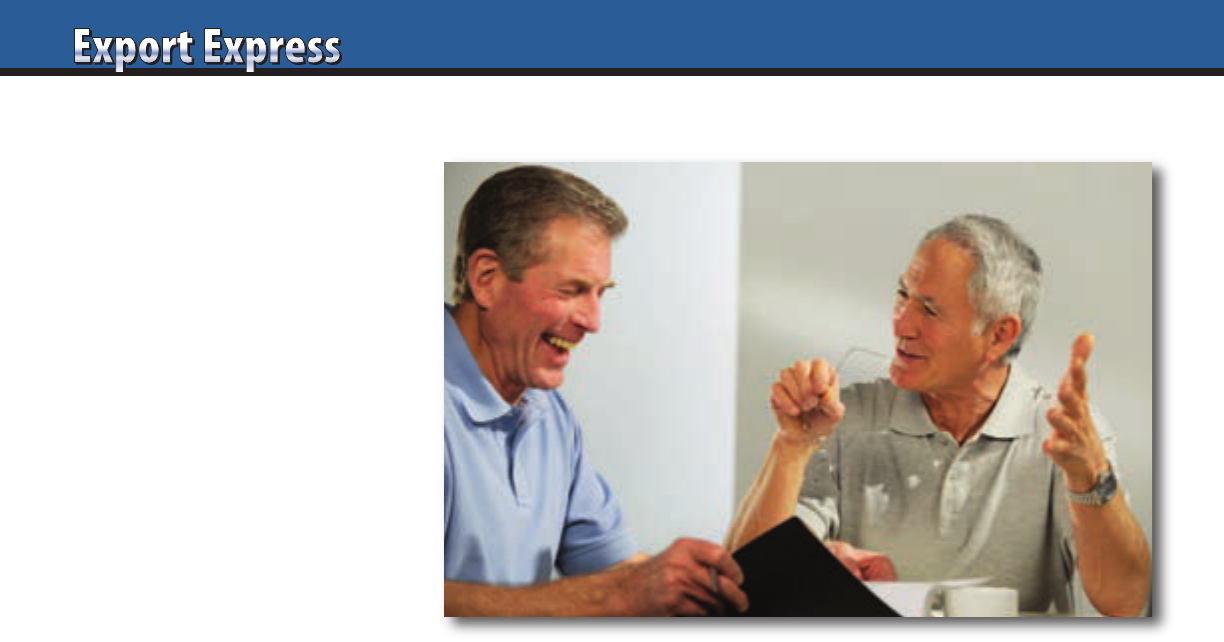
64
Many of the most successful business
deals are clinched long after 9:00 pm.
Barriers come down once your buyer
or distributor escapes the handcuffs of
an office environment. High impact
schedules filled with meetings, emails,
and deadlines leave us too little time to
cultivate relationships. Technology, travel,
and industry globalization have created
seismic shifts in our business practices.
One fundamental that hasn’t changed is
that relationships count and customers
prefer do business with people they like.
Export Solutions shares a few ideas to
build relationships to build your business
with key buyers and distributors.
Factory Tour
A well executed visit to your production
facility represents a perfect opportunity
to demonstrate your category leadership
and commitment to quality. Couple the
factory tour with a meeting with your
Research and Development team to
impress the buyer (or distributor) with
your plans for the future. Finish the
day with a dinner with your company
president or other senior executive. This
will provide an excellent opportunity
for you to serve as a “host” and create
lasting impressions of your brand beyond
numbers on a price list.
Share a Business Book
An inexpensive way to enhance your
connectivity is to mail your buyers
and distributors a recent business book.
Include a short personal note saying
“I recently read this book and thought
that you might enjoy it.” Another idea
is to provide a gift of a “coffee table style”
book of photos from your city. Inscribe
the book with a personal note and even
an invitation such as, “I hope you can
visit our city and company headquarters
one day.” You would be surprised
about how many of these books wind
up displayed in the company’s
waiting room.
Speaking Invitation
Distributor executives and senior level
buyers can share broad perspectives
on industry observations sourced from
a variety of suppliers. Most would be
flattered by an invitation to speak at your
companies annual sales meeting or local
industry conference. Suggested topics
are the retailer’s own success story, trends
and innovation or another area where the
distributor or retailer has demonstrated
a unique capability. Organizing and
hosting the speaker normally requires
significant interaction on speaking
topic and logistics, supplying further
personalized contact opportunities.
Online Networking
Linkedin counts 810 million participants
and Facebook has more than 2.5 billion
users. These tools facilitate connectivity.
I have been thrilled with invitations to
connect via Linkedin with peers from
my early career days. Now I can keep
up with their progress and rekindle
important relationships.
Road Trip
Admit it. When you go on vacation,
you always check the local supermarkets.
We are all students of the industry and
enjoy visiting international retailers to
view new formats and category trends.
Why not invite a buyer to visit an
international market with you? You
could bring the buyer or prospective new
distributor to visit a country where your
brand looks impressive at retail. The same
approach applies to an invitation to visit
an international trade show to see
innovation in a different country.
Handwritten Notes
Email, texts, and twitter have replaced
the art of a handwritten note. One of my
mentors is now the CEO of a mid-sized
company. He ordered casual note cards
to send out quick personal notes. Every
week, he invests the time to send out
multiple notes to the many people he
meets. This ranges from a buyer at a
regional retailer to a sales representative
who sold a nice display. These notes come
from the heart and often mean a great
deal to the recipient. No surprise that this
mentor is one of the best liked and most
respected people in the industry.
Recognition Plaques
Everyone likes to receive an award.
Distributors proudly display these
plaques in their office lobbies as a
statement to their achievements.
Buyers can be presented plaques for
reaching 100,000 dollars of purchases or
100 million units of purchases…you can
always find a reason to celebrate! The
plaques normally cost $100 or less but
can deliver significant intangible benefits.
Old Reliables
Golf still represents a great five hour
bonding experience unless you are a lousy
hacker like me. Dinner at a first class
restaurant with your distributor and their
spouse may be a treat. Birthday cards may
be old fashioned but send an important
message. Buy lunch for the retailers or
distributors administrative staff. You’ll
get the reputation as a person who
appreciates the team behind the scenes.
You will be pleasantly surprised
to discover that your buyers and
distributors like to have fun as much
as you do!
Build Relationships to Build Business
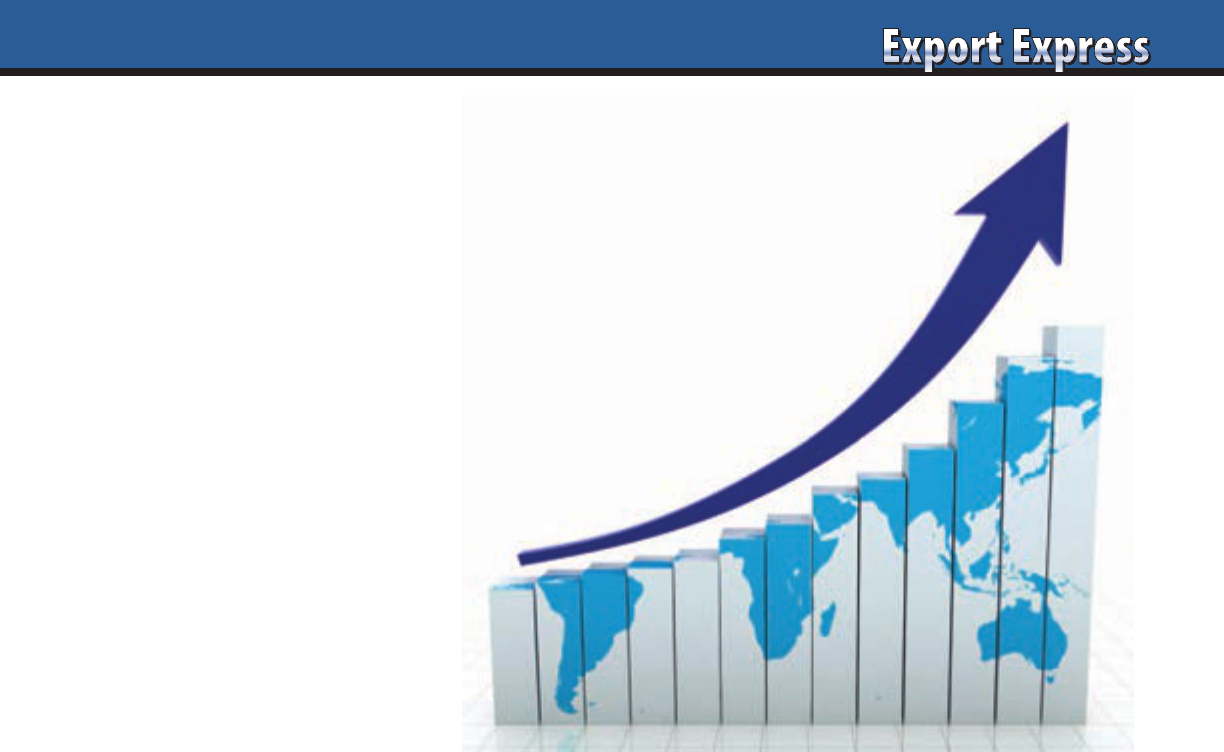
65
A client asked me a good question.
This Export Manager stated that he
always achieved his shipment objectives,
sold his brand across all countries, and
maintained a pretty good group of strong
distributors. What strategies could be
implemented to drive his business to the
next level? My immediate response was
that this company needed to adopt the
rigor and discipline employed in hitting
their sales quota and apply this approach
to metrics around the causal factors that
drove in-store purchases. At Export
Solutions we call this methodology
“Next Level Business Management.”
Factory Sales = Warehouse Inventory
We are all focused on surpassing our
shipment objectives. In many cases,
we meet these expectations by shipping
inventory to our distributor or a
customer’s warehouse. True sales are
achieved when a consumer purchases
our product and the retailer needs to
reorder to replace store inventory.
Supermarket Shelves – Product Showroom
Supermarkets and other retailers serve
as the showrooms for our brands.
An attractive showroom, with well
displayed products and an invitation
to buy, encourages purchases. How do
your store showrooms look? How do you
measure a good store versus a bad store?
Introducing MAPS Metrics
MAPS is an acronym for Merchandising,
Assortment, Pricing and Shelf
Management. The basic concept of
Next Level Business Management is
to establish clear objectives, focus,
and tracking methodology around
the fundamental drivers of in store
performance. The theory is that by
improving MAPS performance, you will
improve in store sales turnover and force
sales replenishment throughout the
supply chain.
Assortment – First Priority
In-store presence can not be tracked until
an item has been authorized for sale at a
retailer. Our first tool and step is normally
centered on managing a one page listing
map. This allows you to track your all
items’ penetration at leading retailers.
You can establish a customer weighting,
by size, and a listing percentage reflecting
total market coverage. It is important to
understand what percent of a retailer’s
stores where you are authorized. I
remember the famous story of a British
brand whose partner claimed distribution
at Walmart USA. Further investigation
revealed them selling to only 45 of 3,570
Walmart Supercenters.
Shelf Management & Pricing
What does an ideal shelf set look like for
your brand? How much space do you
have relative to your category market
share? Are you on the eye level shelf?
Are you placed next to your prime
competitor if this is desirable? Is your
brand priced at parity versus a similarly
priced competitor? Is the price gap versus
private label within the targeted range?
Has the retailer applied an equal margin
across all of your line extensions? These
are all tangible measures that may be
tracked via a numeric response or “yes”
or “no” answer.
Quality Merchandising
Incremental sales are driven by special
investments in promotional activity.
Next Level Business Management
quantifies quality merchandising drivers
and assigns measures. Did feature ad
meet targeted price point? Was there a
display? How many cases were on the
display? Was the feature ad a “major ad”
or a small line mention? What percent
of your allowance or discount did the
retailer reinvest in a lower price? Was
there a secondary display or location in
the store? These are all critical elements
that can be tracked and evaluated.
“What’s Measured is Treasured”
“The distributor respects what the brand
owner inspects.” “What gets measured
gets done.” These are all famous slogans
with the same basic message: track
something and a distributor will try to
meet expectations. The basic idea is to
measure a distributor based upon more
than just shipment numbers. In general,
begin with metrics around Assortment,
and then move to other areas such as
Shelf Management, Pricing, and Quality
Merchandising where the distributor may
have opportunities. Do not inundate the
distributor with new metrics around
every aspect of their business.
Next Steps
Export Solutions has expertise
at deploying Next Level Business
Management programs with leading
international brands. We have the
experience of designing metrics for your
brands and sharing techniques for rolling
this program out to your sales force and
distributor teams. Contact us for help in
applying our Next Level system to your
export business.
Next Level Business Management

66
Successful distributors may represent
twenty companies or more, with each
brand shouting for attention. Exporters
should identify, develop, and applaud
a Brand Champion at each of your
distributor partners. A Champion is
someone who is passionate about your
brand and values leadership results for
your company as something deeper than
just selling another case. At some point
your company and distributors made a commitment to work together. This
decision was based upon a sense of shared company values and belief that your brand could
make consumers happy and the distributor money. As time progresses, this initial enthusiasm
fades, and partners forget the fundamental reasons why they decided to work together.
Recently, I was in the Middle East for two distributor search projects. We hitched a ride back
to our hotel with the “purchaser” of imported brands for one distributor. This person had
not participated in our meeting and maintained oversight for at least 40 companies. We
exchanged pleasantries in the car, then introduced our brand. This manager immediately
exclaimed, “That’s my baby” and spouted out movement figures, category insights and
sales by store for each of our core SKUs. His spontaneous enthusiasm was based upon the
fact that he felt personally responsible for the success of our brand in his country, even
though we had never met him before.
Listed below are Export Solutions ideas for promoting the importance of Brand Champions
at each of your distributors.
1. Who is Your Brand Champion?
The champion is not just your assigned brand manager who you deal with everyday.
I prefer senior people of influence who originally supported the idea of partnering with
your company. The ideal champion is the distributor CEO or National Sales Manager. Brand
development is a “team” sport and you need someone who can inspire the entire group.
2. How Do You Develop a Champion?
As with sports, it takes years of training to support natural ability. Invite the Brand
Champion to your corporate headquarters. Organize factory tours and meetings with the
global brand managers. Introduce him to the CEO or head of international and treat him to
a meal at your home. Spend time with your Brand Champion visiting stores in his country
to secure his ideas to take your business to the next level.
3. A Champion Delivers Year After Year
A Champion is defined by leadership results. A true champion is not a “one year wonder.” It
is someone with a long term commitment and personal investment in your brand’s success.
4. How Do You Treat A Brand Champion?
Champions thrive on recognition. Give them an award as “Distributor of the Year” or for
serving as a member of your company’s Brand Champions club. Invite them to serve on
your company’s “Distributor Advisory Board,” if you have one.
5. Brand Champion Responsibility
Challenge the Champion to deliver exceptional results. The Brand Champions are “true
believers” and are aligned with your vision. Many distributor sales teams are filled with
Brand Champions. Distributors have favorite brands, based upon the prestige of the
brand and personal characteristics of the people working for the manufacturer. One of
my mid-size clients has many Brand Champions. How? They offer a great brand,
inclusive corporate culture, and some of the nicest, most genuine people you will ever
meet. Brand Champions are essential for your brand to elevate from just playing in the
export game to category leader.
www.exportsolutions.com
“Spend Time Selling to Distributors versus Searching for Distributors”
Who is Your Brand Champion?
Greg Seminara
gseminara@exportsolutions.com
404-255-8387
Strategic Services
Contact Us for
Export Solutions
1. Identify Best in Class
Distributors: 96 Countries
2. Best Practices
Export Strategy
3. Distributor Management
Workshops
4. Export 101:
Let’s Get Started
5. New Market
Prioritization
and Launch Plan
6. Personal Distributor
Introductions:
96 Countries
7. Walmart International
8. Distributor Contracts,
Margins, and Fees
9. Meeting Speaker
10. International
Strategy Expert
Strategic Services
Contact Us for
Export Solutions
1. Identify Best in Class
Distributors: 96 Countries
2. Best Practices
Export Strategy
3. Distributor Management
Workshops
4. Export 101:
Let’s Get Started
5. New Market
Prioritization
and Launch Plan
6. Personal Distributor
Introductions:
96 Countries
7. Walmart International
8. Distributor Contracts,
Margins, and Fees
9. Meeting Speaker
10. International
Strategy Expert
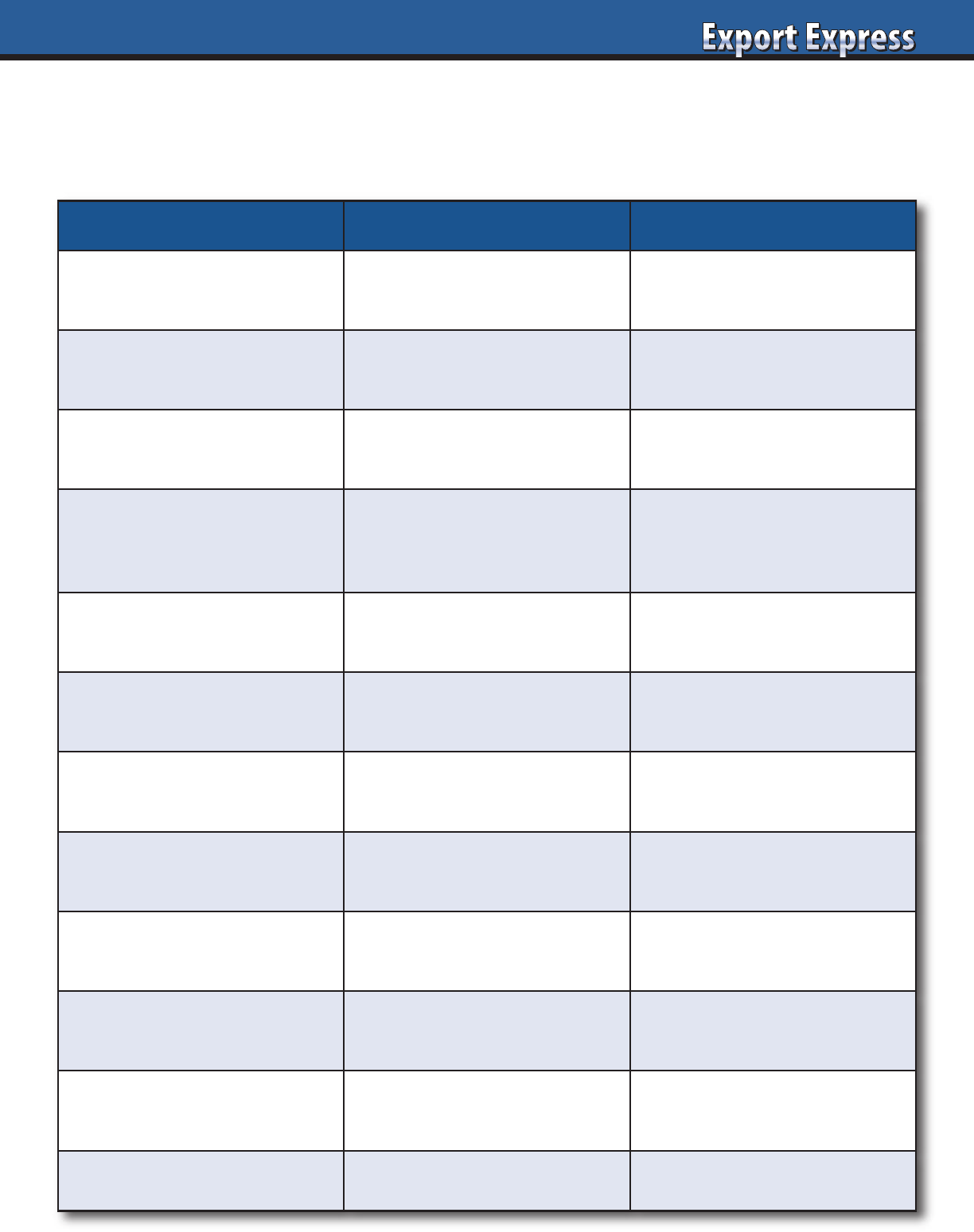
67
Driving export development requires a balance of headquarter resources and people “waking up”
in the country they are managing. Export Solutions shares 12 key roles required to partner effectively.
Noted: Export managers create miracles, with one person handling many functions!
Who, What, & Where
Role Work Location
VP/General Manager
• Develop export strategy
• Obtain resources for team
• Deliver annual results
Headquarters
New Business Development
• Prioritize expansion countries
• Due diligence on new partners
• Close new business deals
Headquarters
E-Commerce Manager
• Create e-commerce strategy
• Develop export tool kit
• Train distributor teams
Headquarters
Distributor Management
• Establish local priorities
• Train distributor teams
• Distributor customer service
• Deliver annual results
Regional
Supply Chain Manager
• Deliver distributor orders
• Manage forecast
• Distributor customer service
Headquarters
Regional
Trainer
• Share best practices
• Support new launches
• Company “missionary”
Headquarters
Digital Marketing Manager
• Develop/distribute content
• Train distributor teams
• Maintain digital portal
Headquarters
Trade Marketing Manager
• Develop local promotions
• Facilitate distributor execution
• Analyze results
Regional
Consumer Marketing Manager
• Develop global strategy
• Conduct market research
• Drive new product pipline
Headquarters
Regional
Category Analyst
• Analyze Trends
• Identify opportunities
• Calibrate “size of prize”
Headquarters
Regional
Finance Manager
• Manage risk
• Monitor receivables, f/x
• Deliver financial results
Headquarters
Compliance Coordinator
• Facilitate regulatory, registration,
trademark, and packaging
Headquarters

68
Elite teams require training. This applies
to sports, military, and the international
road warriors who manage export
departments. Many companies claim a
deep commitment to training and people
development in their mission statements.
Two years of Covid-related travel limitations
and the emergence of Zoom tools has
created an efficient new forum for training
our internal and distributor teams.
Education For All
A lot has changed in the last two years.
Everyone can benefit from an updated
course in winning requirements for
2022. This should apply to your
distributor network and international
team, as well as your own personal
development plan. Another opportunity
exists to teach colleagues in your home
office on the unique dynamics of export
and the enormous potential available
in the global market of 7.9 billion people.
Portal – 24/7 Resource
Leading companies implemented a global
export portal. This gateway provides
instant access to brand facts, digital
images, and success stories. Expanded
portals allow order placement, sales
forecasting, and other export reporting.
A must for best-in-class performance
this year.
Distributor Training
Zoom allows you to connect with large
groups instantly. I have participated in
global distributor meetings linking sales
teams from around the world. Other
export managers have used web tools
for new product launch meetings, to
kick off a retail sales contest, or to manage
a planning session with the entire key
account team. The goal is to make the
meetings entertaining and engaging
for your remote audience. One
beverage company’s web meeting
featured a surprise appearance by
a Euro Vision winner!
Functional Experts
Each company features deep functional
expertise at their headquarters. Overseas
distributors appreciate access to these
professionals. Why not schedule a web
meeting featuring your digital marketing
manager, supply chain VP, or IT guru?
Another option is to develop a session
for your global team managing a common
customer such as Carrefour, Walmart,
or Metro AG.
E-Commerce
E-commerce is the primary growth
channel for all companies. However, most
managers’ fundamental training focuses
on brick and mortar principles. Consider
hiring an external expert to speak about
“doing business with Amazon.” Focus
on the practical operational requirements
such as supply chain and search strategies
versus a speaker who tells you “how fast
e-commerce is growing.”
Personal Plan
What are your personal development
plans for 2022? The new year is a
great opportunity to allocate time to
attend a leadership development class or
a session on managing teams. Evaluate
options early and receive management
commitment before budgets are cut!
Self-Paced Programs
Frequently it is a challenge to sync
everyone’s schedule for a training event.
An alternative is to record training
webinars and share them for review
later. Multinationals frequently offer
individual training via self-paced
modules to indoctrinate new distributors
or brand managers.
Export Solutions Workshops
Each year Export Solutions offers more
than 10 export workshops throughout
Europe and the Americas.
There are eight topics offered in
45-minute sessions. Highlights include
• Distributor Sear
ch Best Practices
• How to Gain Mor
e Distributor Focus
• Distributor Economics: "How they
make money!"
• Mor
e in the Store: Shelf Tactics
• Handling 25 Critical Export Pr
oblems
• Next Level Distributor Management
• Export Strategy: A World
of Opportunity
Client References
Workshop delivery can be via Zoom or,
in many cases, on-site programs. Clients
have included Barilla, Tabasco, Church &
Dwight, Lorenz, Bolton Group, Seeberger,
Manner, and others. Contact Greg
Seminara for more information.
What is Your 2022 Training Mission?
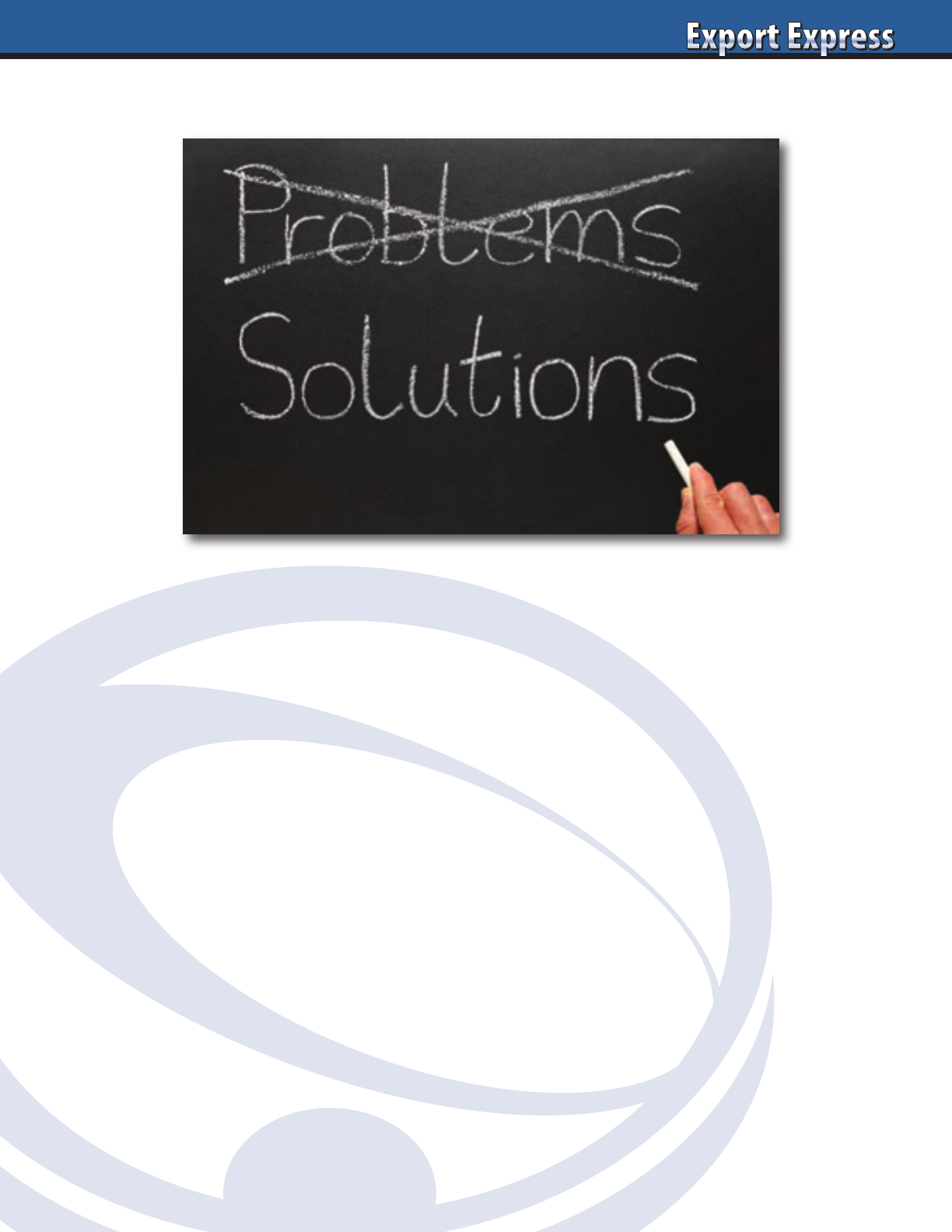
Need A Hand?
Contact Greg Seminara at gseminara@exportsolutions.com
to discuss your international development project.
We can help!
Recent Distributor Search Projects for Export Solutions
• Global distributor search across 26 countries supporting sale of 1 billion dollar food brand
• USA entry strategies and importer/broker search for 70 million dollar European ethnic food brand
• Indonesia, Malaysia, Philippines & Singapore distributor search for global snack brand
• Global strategic assessment: Europe, Asia, Middle East and Latin America for leading USA food company
• Brazil: “next level” business development for famous global food brand
• Europe and Latin America distributor search supporting spinoff of leading non-food brand
• Peru & Ecuador distributor search for 6 billion dollar food company.
• Mexico distributor search for global biscuit brand
Export Solutions serves as a phone consultant on more than 50 distributor search projects every year.
Why use Export Solutions as a distributor identification consultant?
Export Solutions has the unique ability to leverage our proprietary database of 9,200 distributors in
96 countries. Distributors everywhere respect Export Solutions as a valuable source of new business leads.
Our nine step distributor selection process is a proven system to identify and hire the best candidate to
build your brand. You provide us the brief and we facilitate the rest within 60 days!
69
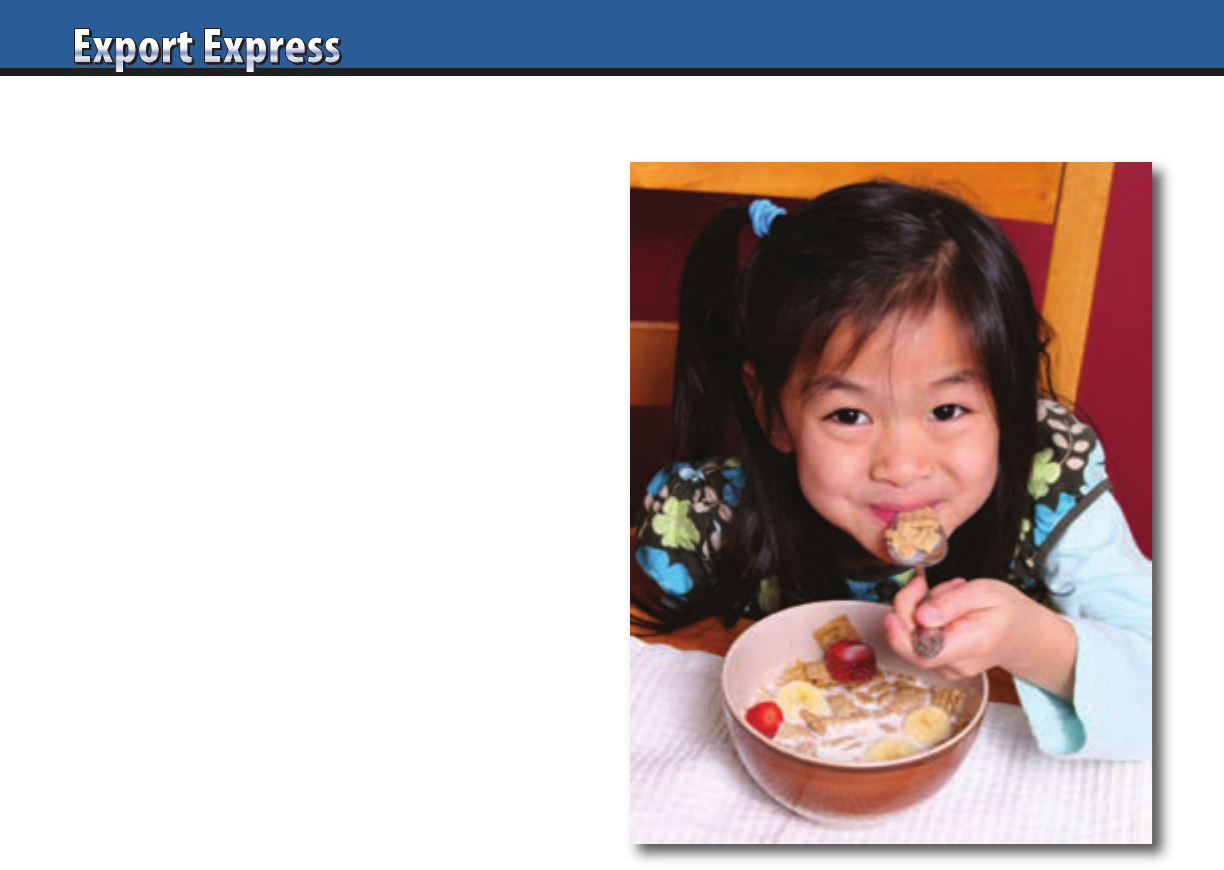
70
International brands find a
natural audience overseas with
homesick expatriates missing
their favorite Oreo cookies,
PG Tips tea or Kuchenmeister
cakes. “Ethnic” favorites must
move beyond their base
business as a niche American,
Italian, or German product
into the mainstream to achieve
ambitious growth targets.
Adoption as a local brand
rewards the manufacturer
with dramatically higher sales.
My Irish wife swore that
American icons such as Heinz
and Kellogg’s were British
brands because their labels
stated “by appointment to Her
Majesty the Queen.” It was
probably the one time in our
marriage when I was actually
right. Listed below are my
Ten Tips for Making a Global
Brand a local “hero.”
1. Manufacture in Country
Pride is generated when a
brand is produced locally. The
factory employs people from
the neighborhood and spends
money in the community.
It may be costly to open
a dedicated plant, but co-
packing is usually an option.
This approach may also
generate cost savings through
the elimination of duties and
overseas freight.
2. Label in Local Language
Frequently a manufacturer
cuts corners by placing a
sticker on a package or other
minor fine tuning to comply
with labeling laws. Producing
your brand with local labeling
sends a powerful message to
the trade and consumer about
your interest in their business.
Warning! Display care
with translations to avoid
embarrassing mistakes.
Google “Nova Spanish”
if you need an example.
3. Promote Recipes
Using Your Brand
A food scientist or market
research company could
study local food preferences
and your product portfolio.
Are there options to
incorporate your brand into
traditional recipes? Nutella
is finally gaining important
traction in the USA as a
breakfast spread, after
years of niche status.
4. Create an Anniversary Event
Many brands have been
available in foreign markets
for 10, 20, 30 years or more.
Why not design an anniversary
event commemorating
“25 years in the ______
Market.” Elements could
include special packages,
consumer contest, public
relations, charitable donations,
and a celebratory dinner for
your retail customers.
5. Sponsor a Sports Team
Fans everywhere love
their teams. Alignment and
support of a local sports team
yields dividends. A starting
place may be sponsorship of
youth leagues versus budget
busting football deals.
6. Core Brand –
Market Specific Line Extension
Consider adapting your core
product line to meet local
flavor preferences. Pringles
built exceptional sales and
excitement by launching
innovative new flavors such
as Jalapeno, Curry, Grilled
Shrimp, Ketchup, and Pizza.
7. Sponsor a Charity Event
There are many worthy
organizations looking for
financial support for their
programs. Normally, there are
chances to gain visibility for
your brand with sponsorship
of an event. Pick a group that
contains a meaningful link
to your product or target
consumer. Many supermarket
chains have a favorite
charity providing a route
to collaborate with a
trading partner for a
worthwhile cause.
8. Co-Promotion or Co-Branding
with Local Leader
Partner with a traditional
local brand that has a long
history in the market. For
example, an international
cereal brand could align
with a local milk producer.
Similarly, an international jam
or marmalade brand might
consider a joint event with a
leading bread company. Co-
branding is also a possibility,
but reflects a long term
commitment. For example,
Post cereals markets a version
of their famous Raisin Bran
cereal which includes
authentic Sun-Maid raisins.
9. Billboards and Radio
Viewed as Local Media
Advertising or public
relations agencies are experts
at creating campaigns to build
brand equity. Billboards and
radio offer local execution and
adaptation possibilities.
10. Brainstorm with
your Distributor
Distributors are local
marketing experts with
a rich understanding
of market and consumer
dynamics in their country.
Schedule an “off site”
meeting in a peaceful
location to brainstorm ideas
for raising your brands
profile with local consumers.
This approach secures
distributor participation and
ownership of the program.
The evolution of an
international brand from
niche curiosity to local
favorite requires time,
energy, and investment.
However, each activity will
bring a step change in terms
of local brand acceptance
and sales. What can you
do differently in 2022 to
increase your brands local
profile in export markets?
Ten Tips: Making a Global Brand Local
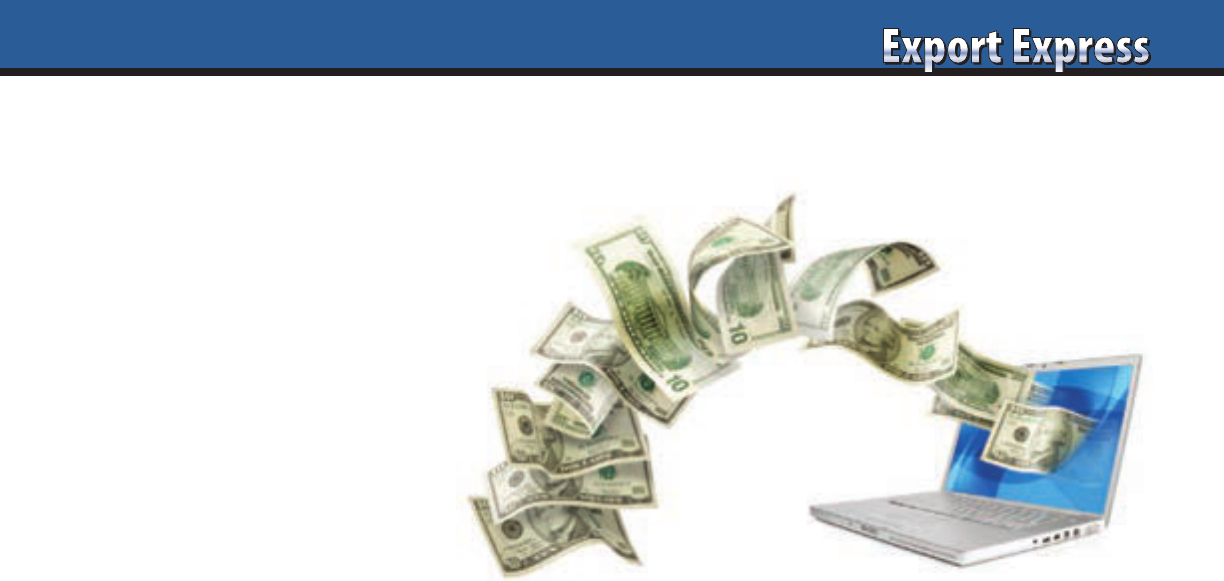
71
Export managers are overwhelmed
with phone calls and emails from
companies desiring to sell their brands.
Some proposals are worth evaluating,
as we all seek incremental sales in new
countries. Other requests originate from
diverters or “time wasters” who do not
have sufficient capabilities or financing
to commercialize your brand. Export
Solutions has completed several projects
with brands looking to streamline
the process of filtering international
representation requests. Listed below
are our ten tips for efficiently identifying
serious inquiries from potential partners.
1. List Current Distributors on your Web Site
This practice provides potential customers
and consumers a local contact for your
brand. It also discourages non productive
calls from other distributors from that
country from contacting you. Distributor
representation information is in the public domain, so web
publication does not breach any confidentiality issues.
2. Export Partner Philosophy Statement
Create a standard letter explaining your criteria for selecting new
partners. Suggested text should include comments like “Brand X
is available in 12 countries and is a leader in the Y segment. We
are looking for established local distributors in certain countries
to participate in the next chapter of our growth. Candidates
should maintain a successful track record pioneering other
international brands and offer a complete portfolio of
importation, supply chain, key account sales, and in store
coverage services.”
3. Distributor Candidate Data Sheet
A one page template captures core information from the
candidate. This template can also be web based and appear
on the “contact” section of your web site. Key inputs include
years in business, company size, web site, number of employees,
and current brands represented. Reference contacts are critical.
A sample Export Distributor Data Sheet can be located at the
bottom of the Export Tips section of the Export Solutions web site.
4. First Response: Send Philosophy Statement & Distributor Data Sheet
Send your philosophy statement and distributor data sheet as
an initial response to all unsolicited phone and email inquiries.
Instruct the candidate to review the philosophy statement and
complete the data sheet if they feel that there is a match with
their capabilities and your company’s export strategy. Inform
them that someone from your export department will contact
them once the data sheet has been 100% completed. A key
learning is that unqualified or “suspicious” candidates will
not complete a data sheet.
5. Post “Distributor Wanted” List
The export page on your web site should list countries where
you are searching for a partner. This listing will encourage
inquiries from target countries and help you “fill in the white
space” in your export coverage map.
6. Reference Check Promising Candidates
My first step is to visit a distributors web site. The second stop
is to review references supplied from other brands on his data
sheet. References listing contacts of export managers for other
leading brands is always a positive indication. A credit check
makes sense, particularly in emerging markets.
7. Watchout #1- Candidate Has No Web Site
This indicates that the distributor or entrepreneur is small or
is possibly making claims that are erroneous or misleading.
Candidates who refuse to provide references from other brands
represented also should be avoided.
8. Watchout #2- All About Low Prices
Warning bells go off from inquiries from companies urgently
focused on obtaining your export price list. I get suspicious
of international distributors volunteering to pick up product
at your factory or those who prefer English language labeled
product even when their native language is different.
9. Due Diligence Questions
What would the distributor launch plan look like if you agreed
to sell to him?
What are the local category dynamics?
What does the price calculation look like?
Can the candidate share a success story for another brand from
your country?
10. Invite Serious Candidates to Your Headquarters
The preferred option is to visit a distributor in his home market
to see his operation. This is not always possible, particularly for
small or remote countries. A visit by a pre-screened candidate
signals interest and initiative on their part.
Export Solutions database covers 9,200 distributors in 96
countries. This serves as a quick reference tool to check the
validity and credentials of a potential distributor candidate.
Ten Tips: Translating Export Inquiries into Incremental Sales
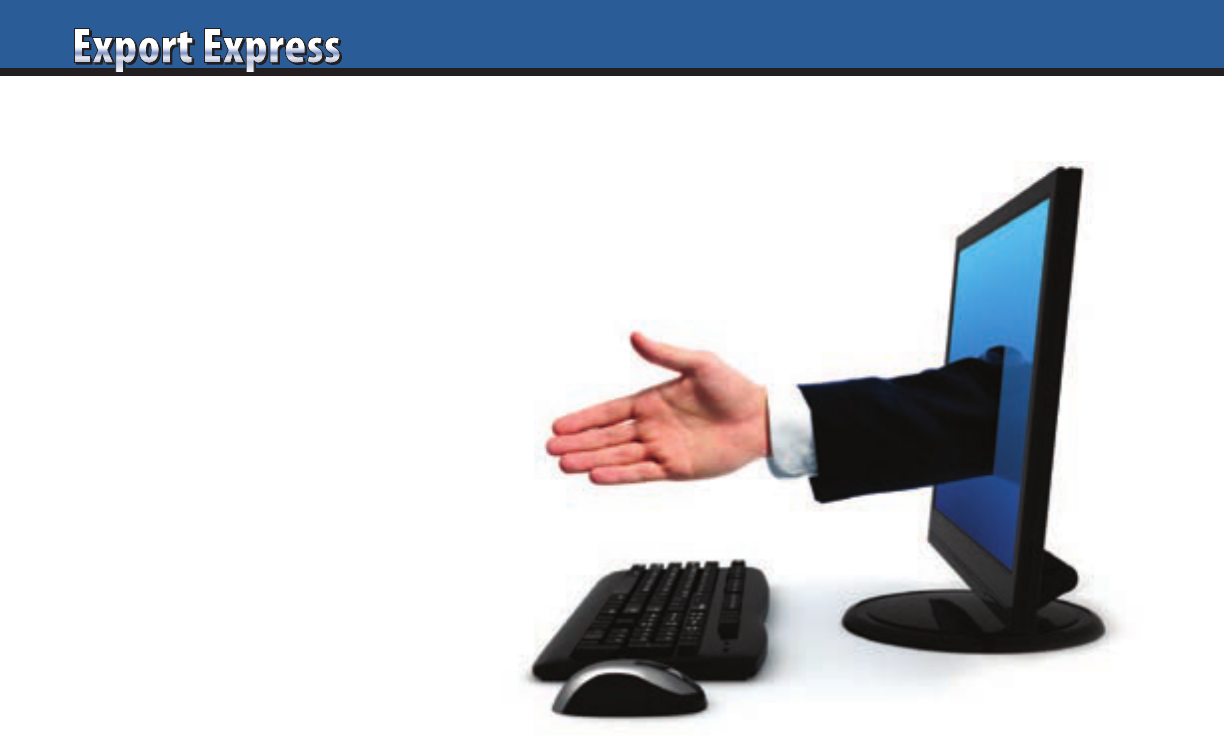
72
Savvy exporters deploy modern
web based tactics to identify new
distributors and connect with global
consumers. Most companies maintain
a basic web site featuring an
“international section,” but few sites
are designed to promote export sales.
Listed below are Export Solutions
“Ten Tips” to unleash the power of
Web 2.0 to drive new business in 2022.
1. Language Translation Software
Increases your Reach
Popular software from Babel Fish or
Google can be installed on your site
to translate your International page
to multiple languages. These tools
provide instant translations without
formal redesign of the web page.
2. Code your Site
for Tracking Analytics
Available reports measure visitors
by city/country, time spent per page,
and key search phrases driving web
traffic. Search Engine Optimization
(SEO) raises your ranking with
Google and Yahoo.
3. List Current Distributor Contacts
This makes it easier for potential customers and consumers to
locate your brand in their home country. The distributor listing
on your web page also reduces distributor inquiries from
countries where you already have a partner.
4. Distributor Wanted Postings
Define countries where you are searching for a partner. Your
“Distributor Wanted” section should sync with your Companies
Distributor Selection Criteria. A sample statement could outline
basic requirements such as “Beverage Company A seeks partners
with significant beverage category expertise and demonstrated
success marketing other international beverage brands.
Distributor candidates must be highly motivated with
countrywide coverage across all trade channels.”
5. Automate Process to Capture Distributor
Candidate Credentials
Create an online template to summarize a new distributor
candidate’s basic information: Com-pany size, current brands
represented, references, web site etc. Alternatively, you can
develop a process to auto-matically email a similar template
to interested candidates. Create an email box called
newdistributors@yourcompanyname.com.
6. Establish an Intranet Portal for Existing Distributors
This password protected gateway serves as an entry point to
a data warehouse of information. The Intranet could include
product catalog, brand images, syndicated data, presentations,
and a chat function to share ideas.
7. List Local Retailers Stocking your Product
Basic approaches include a simple drop down menu
stating now available at with names and/or logos of
leading customers. Advanced applications include ability
for consumers to search for retail stockists by postal code.
8. Product Request Form
An online product request form captures names and contacts
of consumers interested in your brand. This information can
be used to prioritize export expansion areas measured by level
of inquiries. Upon entry into a new country, the product request
data facilitates targeted marketing or to demon-strate to a
retailer a level of existing consumer interest.
9. Publish an International Newsletter
This newsletter may share new product information,
success stories, recipes, contests, or any other method
to create engagement with distributors, retailers, and
consumers. Tools such as Constant Contact make creation
and delivery of online newsletters simple and cost effective.
10. Photos Add a Personal Touch
Pictures of the Export department team members add life to the
international web page, particularly for small-mid size exporters.
Other web pages include photo’s of the “Distributor of the Year”
or senior manager visits to international markets.
Web 2.0 – Your New Export Sales Partner
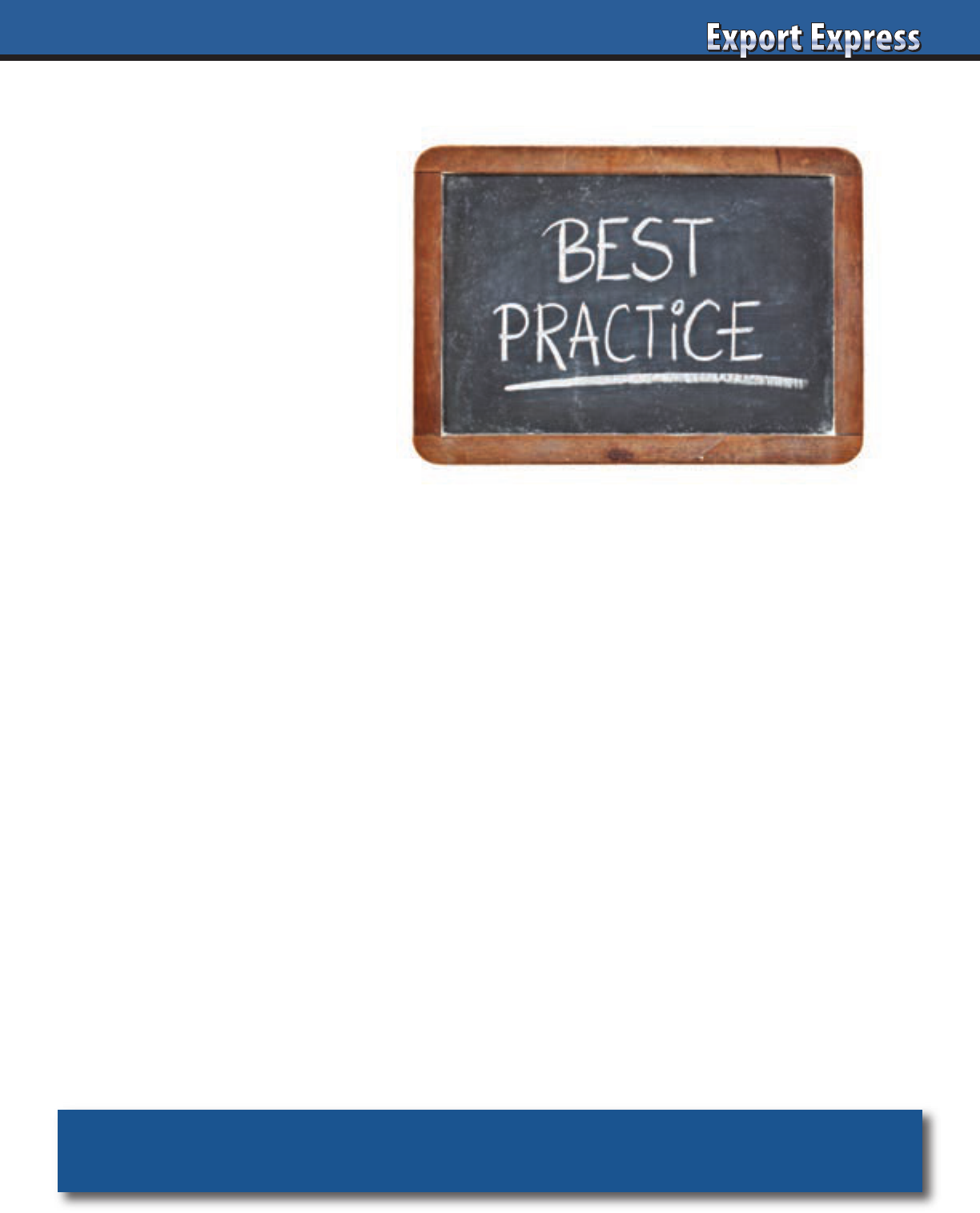
73
1. Extensive Due Diligence
on all New Distributors
Visit each new distributor’s office and
warehouse to calibrate the size of his
business with other principals. This
includes reference checks from existing
manufacturer clients as well as from
leading retailers in his home country.
Run a Dun & Bradstreet or Equifax
financial report.
2.Design a Distributor Fact Sheet
Require each potential distributor
candidate to complete a one page
template recapping their capabilities.
Pay particular attention to sales
turnover, number of employees,
and references from existing
brands handled.
3. Ship Directly to Distributor
in His Home Country
Do not allow for distributor sponsored
consolidation at a USA port such as
Jersey City, Miami, or Los Angeles
during the initial launch phase. Allow
distributor pick-up at your factory only
after your relationship and brand have
been established for a year or more.
4. Label your Product in the Local Language
Stickering is acceptable only if it is done
in the destination country or at your
own in-house contractor.
5. Sell Only to Distributors Based
in your Target Country
Avoid shipping product to foreign
distributors with offices and warehouses
in your own county. The goods have little
incentive to leave local ports. Export
Solutions Distributor Directory contains
more than 9,200 local distributors in
96 countries.
6. Create an “International Package”
This could be multilingual label or
a different size. One tactic is to label
packs “Export Only.” This reduces
the risk of it being diverted back to
the domestic market.
7. Establish an International Price Structure
A model could consist of export
base price plus freight charges. This
prevents one country from enjoying
a price advantage.
8. Don’t Believe Stories About Cruise Ships
and Mining Camps
Sophisticated diverters come up with
elaborate stories to convince you that
your product will be sold to legitimate
outlets. Is it really worth the risk?
9. Analyze Orders Versus Size of Country
Leverage technology to alert you to
unusual order patterns outside of
historical trends. Believe me, it is not
possible that Greece or Bermuda are
selling that much product! Analyze
Nielsen consumption data versus
shipments to the market, if possible.
10. Unannounced International Market Visits
Check retail outlets independently,
without a distributor “tour guide”
to confirm a problem. Visit distributor
warehouses with short lead time to
check inventory. Recently, I visited
a distributor claiming to represent
famous brands and found that many
were missing from his warehouse or
had less than 30 cases of stock.
11. Avoid Risky Countries with Low GDP
I am naturally suspicious about
distributor orders from poor African
nations, Jordan, Haiti, or Belize.
Realistically, how many consumers in
these countries can afford premium
European or USA brands?
12. Watch Out: No Web Site
Perform a Google search on a
new distributor. Virtually all serious
companies have web sites or some
internet references. A distributor
without a web site in 2022 is either
hiding something or too unsophisticated
to grow your business. Also, beware of
generic web sites that do not show basic
information like brands represented.
There are exceptions, but lack of a web
site sets off alarm bells.
Export diverting is a serious issue
at many companies causing distrust
and lack of support for export programs.
I admire producers that regularly follow
the practices described above to “weed
out” questionable distributors. When
in doubt, offer the distributor your
standard list price from your home
country. Good luck!
Twelve Tips to Derail Export Diverting
Need a hand? Visit www.exportsolutions.com.
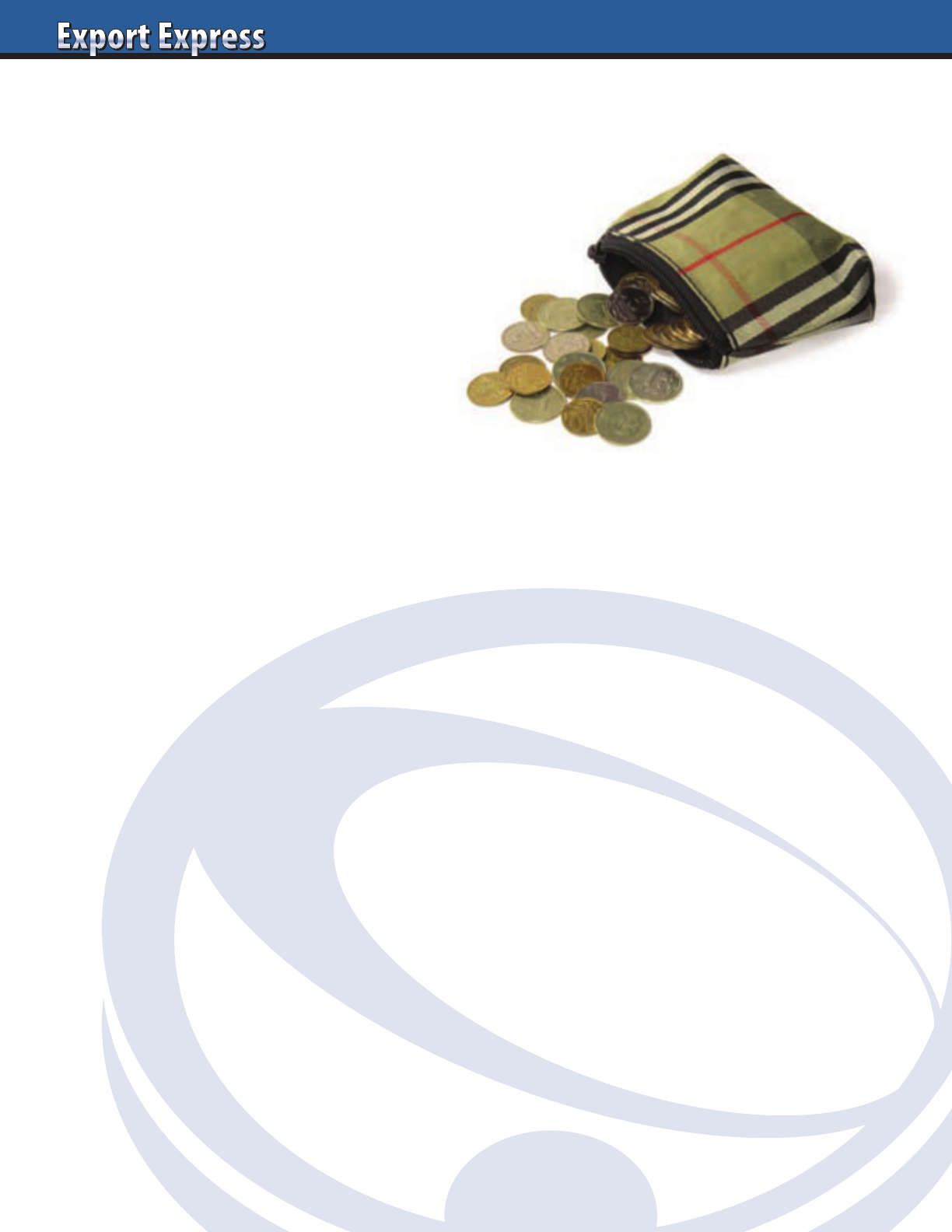
Stretching thin marketing budgets is a job
requirement for most Export Managers.
Listed below are “Ten Tips” for brand
building on a “Shoestring Budget.”
1. Tap into Government Export Programs
Many countries sponsor strong trade
organizations that can aid your export
development program. Exports translate
to jobs and most countries have well
established programs to facilitate the
sale of locally produced products. For
example, the USA Foreign Agricultural
Service will co-fund marketing
investments for small-mid size USA food
producers through their MAP programs.
German Sweets and GEFA, UBI France,
ICE (Italy), ICEX (Spain), Austrade
(Australia), and AG Canada serve as
valuable resources for local exporters.
These organizations often sponsor local
“Food Events” at leading supermarkets
in international countries. For example,
Austrade sponsored G’Day USA to
showcase Australian food producers to
USA consumers. These events are highly
publicized and normally feature a
relatively modest participation fee.
2. Leverage Relationships
with Global Retailers
Wal*Mart, Carrefour, Tesco & Costco
all maintain programs to ease the export
process for their current suppliers. This
usually involves direct consolidated
shipments with other local producers,
labeling assistance, and placement in a
special section in the international aisle
of their stores, i.e., USA Foods, France
Foods, UK Foods etc. The immediate
benefit is the streamlined route to market
without payment of upfront local
marketing fees. This allows you to “Test
the Market” prior to a traditional market
entry with a local distributor and heavy
marketing support.
3. Joint Venture with Local Manufacturer
Another idea is to locate a local player
in your category in a country targeted
for expansion. You may be able to
offer a potential partner innovation
in taste/flavor or packaging to
complement his local expertise. A joint
venture or Co-Branding agreement can
produce revenues without significant
start-up funds.
4. Build Marketing
Costs into
Distributor Margin
Many
manufacturers
build an accrual
fund into their
distributor
margin
calculation.
Normally the
funding level is
around 10% of
sales, but can
range from 5 -
20% depending
on the category.
This creates a
fund for the
local distributor
to manage. The
accrual fund is created on a “pay as you
go” basis, with fund levels proportionate
to shipments. In this scenario, the
manufacturer usually provides a small
fixed sum to create a launch budget prior
to initial shipments
5. Free Goods May Fund Trade Marketing
Free goods may be used to offset the cost
of trade marketing programs, particularly
for established brands. This can be in
form of a 1 free with 10 purchase or
similar type of promotional events.
The benefit is that your budget can be
stretched as your cost of goods produced
is less than the wholesale cost.
6. Private Label
Retailers source quality products for their
private label at the lowest possible price.
This eliminates the need for marketing
investments. However, private label is
difficult if freight expenses are too high.
7. Foodservice Channel
Foodservice/Catering offers a “low
investment” route to market versus
the supermarket channel. Foodservice
usually requires less traditional brand
marketing support. Foodservice operators
look for tailored solutions with rebates
based upon purchase levels. A small
budget for SPIF’s (SPIF- special incentive
fund) can generate purchases from
independent restaurants.
8. Specialty Retailers
Each country has specialty retailers that
serve as alternate channels for your
brands. This could include diverse
customers such as Cost Plus World
Market, Trader Joes, Big Lots or Dollar
Tree in the USA. These retailers maintain
different approaches not dependent on
heavy manufacturer spending.
Their strategy is to offer different brands
(or sizes) versus traditional supermarkets
or mass merchandisers.
9. Co-promotion with Other Brands
Retailers generate excitement through
Theme events around a group of
complimentary items or common
cause. This could involve participating
in Barbecue event with other Barbecue
related products :
Charcoal, Meat, Picnic Supplies, Drinks,
Pickles etc. Another example is a retailer
promotion celebrating their anniversary
or support of their favorite Charity
(Juvenile Diabetes etc.). In many
countries, leading distributors sponsor
an annual event for all the brands they
represent. Don’t forget the country
specific promotions (G’Day USA)
mentioned earlier. In each case,
manufacturers pay for a portion of
the event as costs are spread out among
all brand participants.
10. “In & Out” Packs/Gift Baskets
These special packs can generate
incremental business without investment
in listing fees or shelf space. Examples
could include modular displays, trail size
shippers, or bonus packs with free product
or gift. Gift Baskets are very popular
during the Christmas Holidays. This is a
good vehicle for “Fine Foods” brands to
gain exposure with gourmet consumers.
International Expansion – Shoestring Budget
74
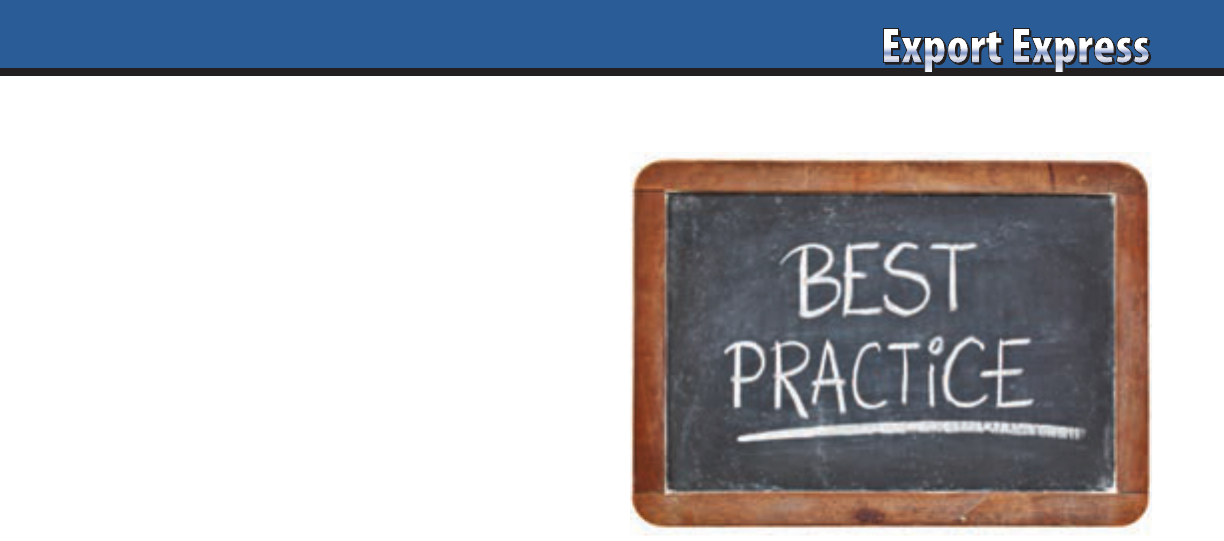
75
How often do you visit your distributor’s warehouse?
Brand owners should inspect their distributor’s warehouse
at least once per year and always before the start of a new
business partnership. Warehouses serve as the nurseries/
creches for where our precious new products are stored while
the commercial team generates sales. Warehouse managers
are custodians of our sales inventory and companies need to
insure that their brands are in good hands while awaiting sales.
Listed below are 10 Tips on productive distributor
warehouse visits.
1. Confirm Accurate Stock Levels for Your Brands
Does warehouse inventory reconcile with distributor stock
reports? How many cases are there versus agreed to weeks
supply targets? Six to eight weeks of stock is typical for
overseas brands. Walk down every aisle and check every one
of your SKU’s.
2. Identify Problems
A warehouse visit may reveal overstock or understock
conditions. Similarly, you may spot a case of poor sales rotation
or goods approaching expiration date. A common problem is
the discovery that a warehouse may not adhere to a “first in,
first out” method of stock rotation. Examine cases to look for
damaged goods.
3. Warehouse = Window Into Distributor’s Real Business
Warehouse inventory levels paint an accurate picture of
the distributor’s real business profile, not what the pretty
PowerPoint presentation tells you. What brands are stocked?
What are they selling? I remember one distributor interview
included bold claims about representation of famous companies.
The warehouse revealed one pallet of one small SKU from the
famous manufacturer. Another interview for a distributor
claimed representation of fifty world famous brands. The
warehouse check showed that 50% of business was on a local
commodity item and most of the foreign brands had only
20-30 cases of stock.
4. Outsourced Logistics Providers
In certain countries, distributors outsource logistics to another
third-party provider. This is a mixed message for a manufacturer.
From one standpoint, this frees up distributor management time
to focus on brand building. Also, there are excellent logistics
providers that specialize in “best in class” practices. On the other
hand, the distributor has sold his logistics contract, sourcing a fat
fee for his business. Also the external logistics provider needs to
make a profit, so you wind up with another margin line item in
your calculation. Request a warehouse inspection, even if it is
managed by a third party.
5. Get to Know the Warehouse Manager
Every business runs into supply chain problems at some point
in time and its positive to know the person in charge. Bring him
a shirt or other gift with your company logo and he will be your
friend for life (or at least until the next problem!).
6. What are Distributor’s Service Levels?
Most buyer’s first concern is sales rotation. Their second metric
is service levels such as stock levels, fill rate, and inventory turns.
Your distributor’s adherence to retailer’s supply chain scorecard
objectives reflects on your brand, sales performance, and
distributor’s reliability as a provider. What are the distributor’s
KPI’s? Are they tracked automatically or manually? How are
they doing?
7. Appearances Count!
Is the warehouse clean or dirty? Does it appear to be logically
organized? Is it busy or “asleep?” These clues send an
important message on the overall status and culture of your
distributor partner.
8. Understand Distributor Value Added Services
Many distributors provide value added services in their
warehouse. This may include creation of promotion packs,
stickering or special pack displays. You may discover distributor
capabilities that you were not aware of.
9. The Heat Is On?
Products require different storage conditions. Obviously
frozen and chilled items require temperature control.
Confectionery products require different climate standards.
Health and personal care items may ship in units versus cases.
In other situations products like insecticides cannot be stored
(or shipped) with food products. What is the compliance level
versus the storage standards for your products?
10. Alignment With Expectations
Ultimately, a successful warehouse visit should match
your business and expectations. If business is good, the visit
demonstrates your interest in the distributor’s total company
and team. Request a visit just to say “thanks.” If your business
is declining, the warehouse is a perfect place to dig into what
the real situation is at the distributor. Sales to the customer begin
the moment your brand leaves the distributor warehouse floor.
A periodic inspection will insure that your brand looks its best
in transit to the store shelf.
10 Tips: Mandatory Distributor Warehouse Visit
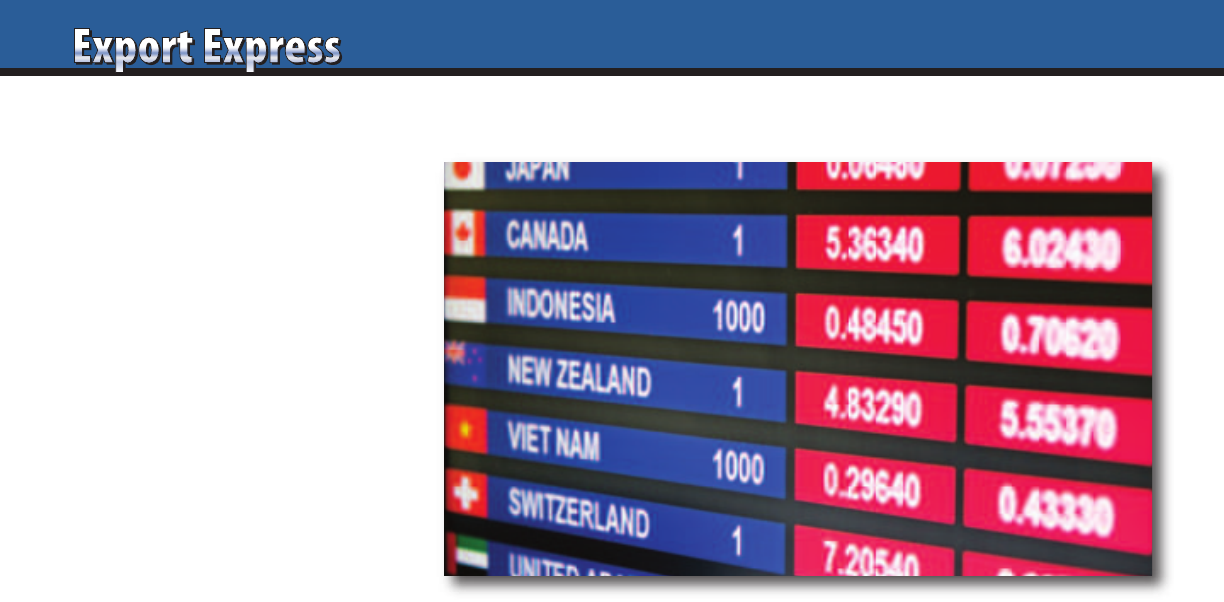
76
Dramatic currency gyrations wreak
havoc with retail pricing around the
globe. Strong USA dollar, weaker Euro,
devalued China RMB, and cratering
pound. These lightning fast moves
on currency exchange may require
six months or more to wind their
way through the supply chain. Some
distributors devote more time to serving
as f/x traders versus brand builders.
Unfortunately, most export managers
are distanced from the problem until
receiving an urgent call from a distributor
who faces passing on a 10-20 percent
price increase to his customers. Listed
below are Export Solutions’ “tough tactics
for tumultuous times.”
Higher Prices Mean Lower Volume
Emerging market currencies usually
move in a weaker direction. This
translates to higher shelf prices. Citizens
in these economies rarely experience
wage increases in parallel with inflation.
Most consumers tend to reduce purchases
of overseas products as they become
luxury items. Exporters need to calibrate
“how much pain” they are willing to
endure in terms of lower volume.
Prices Only Go Up, Never Down
Permanent price declines or rollbacks
are extraordinarily difficult to execute.
If your currency weakens, retailers and
distributors don’t pass on lower net cost.
It is common practice for them to try to
maintain retail shelf prices and capture
extra margin. Savvy brand owners skip
the price rollback and invest in heavier
promotion levels or enjoy higher profits.
Conduct Monthly Price Surveys
In countries of extreme price fluctuation,
best to schedule monthly price surveys of
your brand and the competition. Request
that distributors use the same store base
every month to avoid regional differences.
Online grocers allow us to monitor
country pricing from our desktops,
miles away from overseas markets.
Retailers: Once Per Year Price Increases
Many retailers accept price increases
only one time per year. This may occur
in conjunction with annual negotiations.
Other retailers demand ninety days
advance notice. Sometimes “borderline”
brands encounter customers who
simply refuse to accept price increases.
Ultimately, this puts tremendous pressure
on distributors who may be facing price
increases from multiple suppliers
What’s Fair? – Peg Rate
I advocate a model where currency
is pegged to an exchange rate at the
beginning of the year. Distributor
and brand owner agree to “swallow”
price swings of the five percent in either
direction of the peg. If the currency
breaches five percent threshold, then
both parties review the formula and
assess options.
Bank Rate Versus Distributor Rate
A key metric to investigate is the
distributor exchange rate in his
calculation versus the actual bank
rate. Many distributors seek to insulate
themselves by building in a five to ten
percent protective cushion. Guess what?
If the currency doesn’t move, the
distributor just made an extra five to
ten percent on your brand, starting
from the landed cost line!
Sell in Local Currency
This forces large manufacturers to accept
the risk or benefit. This insulates smaller
distributors who may not enjoy similar
capital reserves as their larger principals.
This approach works especially well with
European brands selling to the USA or
vice versa.
Competitive Activity
Frequently, all category players
experience similar input cost increases
such as raw materials. Competitors may
use the window to hold prices low to gain
market share. Others may eliminate
promotional spending. Ultimately brands
elect a certain price positioning in a
country and should strive to stay within
the desired range.
Document Price Change Rationale
Retailers provide strict challenges to those
requesting price increases. Supply them
with hard facts on costs of raw material,
currency exchange, transportation and
other factors. Retailers with substantial
private label programs face similar
pressures on their own private label,
so they are not blind to the situation.
Watch Credit/Receivables
Distributors pay their suppliers in
advance of receiving payment from local
customers. Distributors invoice in local
currency and wait for repayment.
During periods of currency fluctuation,
the typical sixty day float could result
in a five percent reduction in receivables.
Across a broad portfolio of brands, this
could spell trouble for a distributor.
Run credit reports and monitor days
outstanding trends.
“Helpers” are Heroes
A trusted distributor who has delivered
consistent results is worthy of your help!
In the past, I have witnessed the USA
dollar appreciate more than fifteen
percent versus the Mexican peso and
Canadian dollar. Best approach is for both
partners to “roll up their sleeves” and
engage in an open discussion around
transparent examination of the facts.
Distributors are entitled to a reasonable
profit. A manufacturer who helps absorb
the pain during a “currency crisis” will be
remembered as a true partner when the
situation stabilizes.
Currency Exchange – Tough Tactics for Tumultuous Times
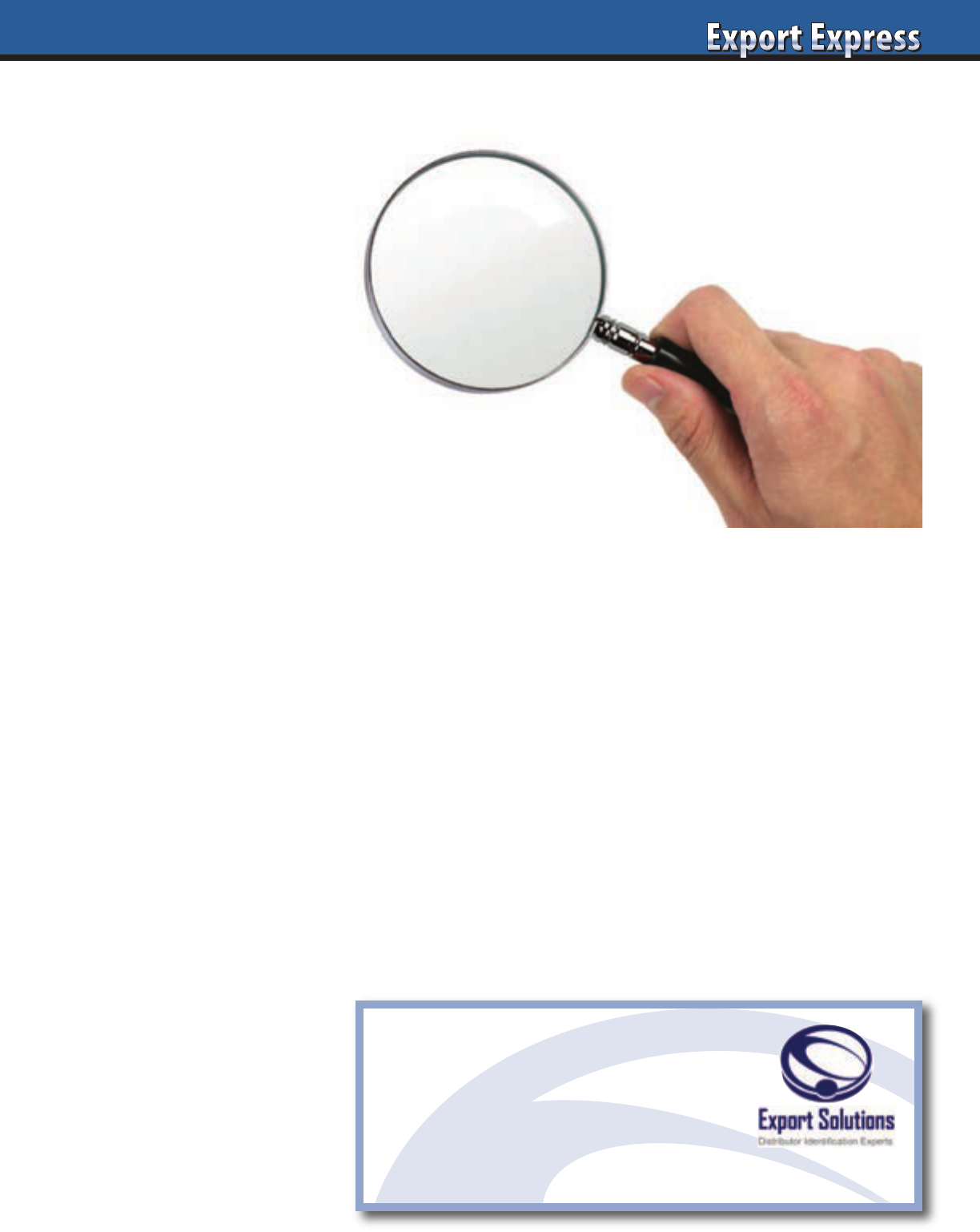
Hiring the right local partner is the third
most important step in optimizing your
sales. This follows creating a product with
a unique consumer value proposition
and willingness to invest in brand
development activities. Listed below are
some practical tips on selecting the right
company to represent your brand.
Identify a Pool of Preliminary Candidates
Create a large group of potential
candidates. This could include
distributors, importers, brokers, or local
producers of related products. Highlight
companies that are specialists in the
market sector that you are aiming at.
Export Solutions streamlines this process
with our online directory of more than
9,200 distributors, importers and brokers
for 96 countries.
Establish Partner Selection Criteria
What are the key attributes of your ideal
candidate? Product specialization?
Service portfolio? Existing results for
current brands? Choosing a Large,
“Best in Class” partner versus a “Small,
Hungry” company willing to pioneer a
new brand is an important preference.
Determine Candidates Preliminary
Interest Level
Send a brief summary of your product
proposition and company credentials
to the 5-10 most promising candidates.
A follow-up phone call to your top
candidates is an appropriate personal
connection. Distributors expressing an
interest should complete a brief company
overview recapping their corporate
capabilities: Sales, Logistics, Marketing, etc.
Schedule a Meeting in the Candidates Office
Normally, we recommend interviewing
at least three candidates depending on
the size and scope of a project. Schedule
the meeting 3-5 weeks in advance.
Provide a specific agenda at least 2 weeks
in advance, including pre-work such as
category market analysis. Meet the
distributor’s team that would work
on your business, as well as senior
management. A distributor’s office
provides clues on company culture,
scale, and capabilities.
Prepare Interview Questions and Assessment
Grid in Advance
Create a list of key questions to ask each
candidate. Topics could include local
category dynamics, cost of entry, and
Distributor success stories. Create a
standard grid to evaluate and compare
all candidates on a common platform.
See page 92 for ten sample questions
for every distributor interview.
Conduct an Independent Evaluation of
Candidates Performance for Existing Brands
Visit target outlets for your product
to observe category conditions. At the
same time, evaluate each candidate’s
performance for his existing clients.
Do his current brands maintain a strong
presence in the market? Or are his brands
hard to find? Conduct these visits to
leading retailers independently, as an
accompanied visit may lead you to select
stores which may not be representative of
marketplace reality.
Reference Checks Represent
an Important Next Step
Request references of 5 of the distributors
top 10 clients. Call at least three references
and request insights into performance
and capabilities. Acknowledge that these
are likely to be positive references, but
they always provide significant value.
Run a Dun & Bradstreet or other type
of credit report on leading candidates.
Export Solutions is often hired to
conduct independent, confidential,
reference checks.
Invite Top Choice to your
Corporate Headquarters
The visit should include meetings with
senior management, factory tour, launch
planning, and mutual commitment. The
trip serves as an important bonding and
relationship building experience between
your company and your new partner.
My Way: Finding and Selecting the Right Distributor
www.exportsolutions.com/ExportTips
300 Free Articles
Export Strategy
Distributor Management
77
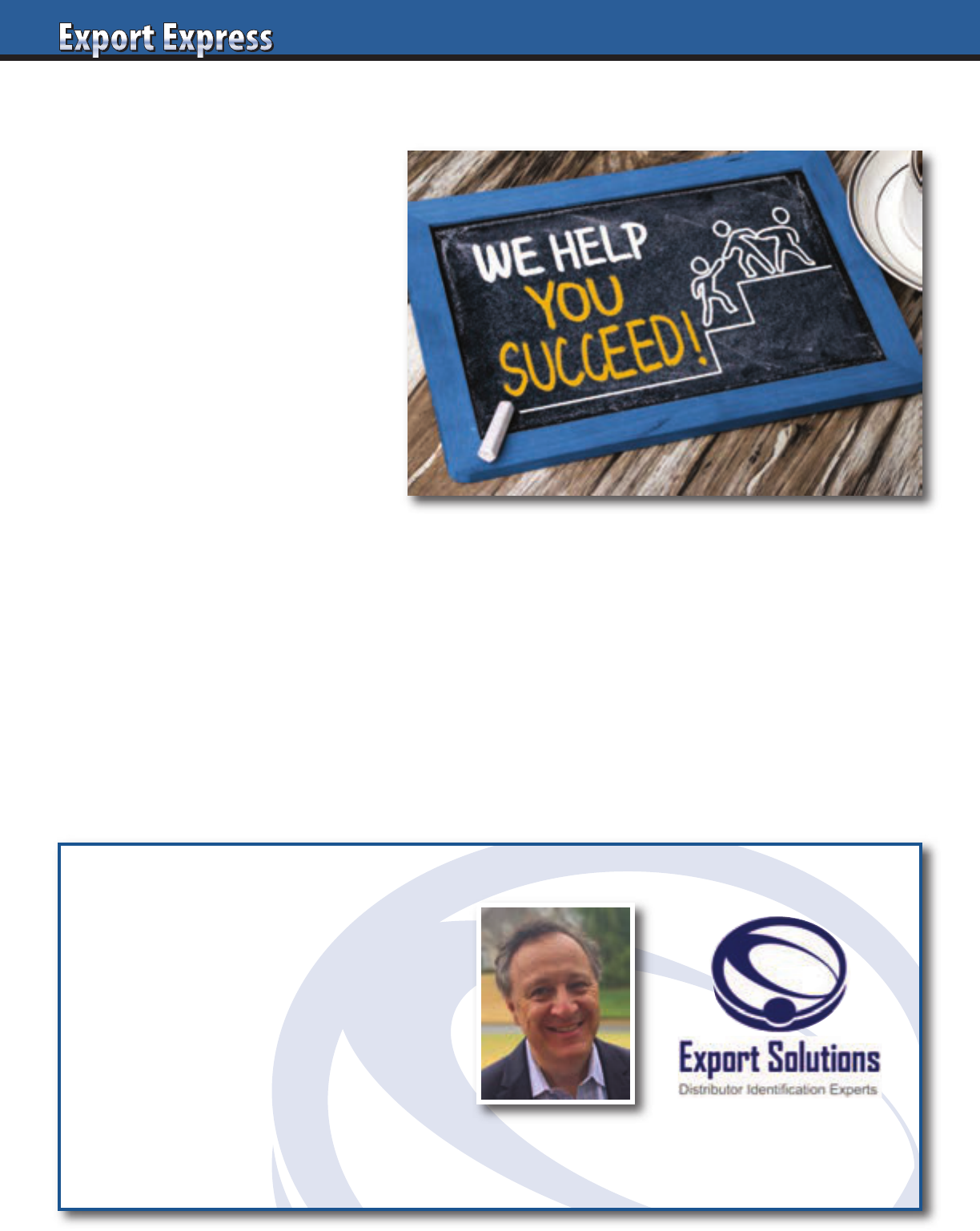
78
1. Determine Brand Ambition
for Country
Will your brand be a category leader,
player, or niche participant?
2. Establish Distributor Selection
Criteria
Big brand distributor, category specialist,
or smaller entrepreneur?
3. Create a Pool of Candidates
Export Solutions database tracks
9,200 distributors in 96 countries.
4. Determine Candidates Preliminary
Interest Level
Send introductory email, followed
by phone call within 48 hours.
5. Organize Introductory Web Interview
Key Facts: Sales turnover, # employees, companies
represented, category/channel specialization.
6. Distributor Interview in Candidates Office
4-6 weeks lead time. 2 hour meetings.
Send advance agenda.
7. Independent Store Checks
Provides category insights and “real” distributor
performance for current brands handled.
8. Interview Preparation: Scorecard, Samples,
Your Presentation, Key Questions
Export Solutions’ templates: Assessment Scorecard
& Ten Questions for every interview.
9. Distributor Interviews – Target 3 Candidates
Review capabilities, warehouse, cost to serve,
and interest in your brand.
10. Cooperation Model
What is the plan? Year one plan, pricing
calculation, and timeline.
Ten Step Distributor Search Process
Talk to an Expert
• Find Distributors in 96 Countries
• International Strategy Road Map
• Fix Problem Markets
• Entry Plans
• Export Workshops
• Motivational Meeting Speaker
Contact Greg Seminara at (001)-404-255-8387 to discuss your business development project.
www.exportsolutions.com
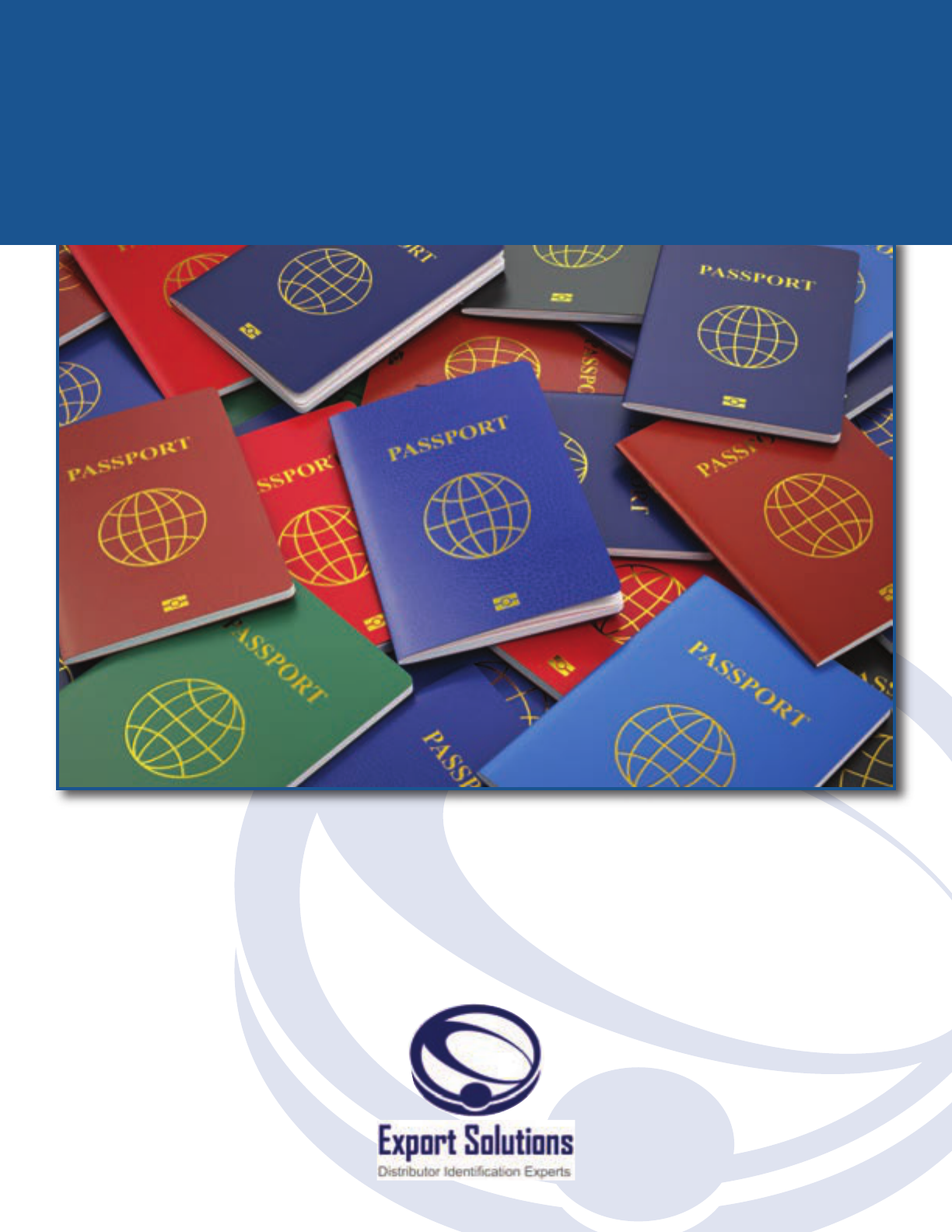
79
Strategic Export
Development Program
Export Passport
Export Passport

80
Distributor Search Challenge
• Some distributors are too big…
• Other distributors are too small!
3
Export Passport identifies
Prime Prospect distributors
that represent the Right Fit
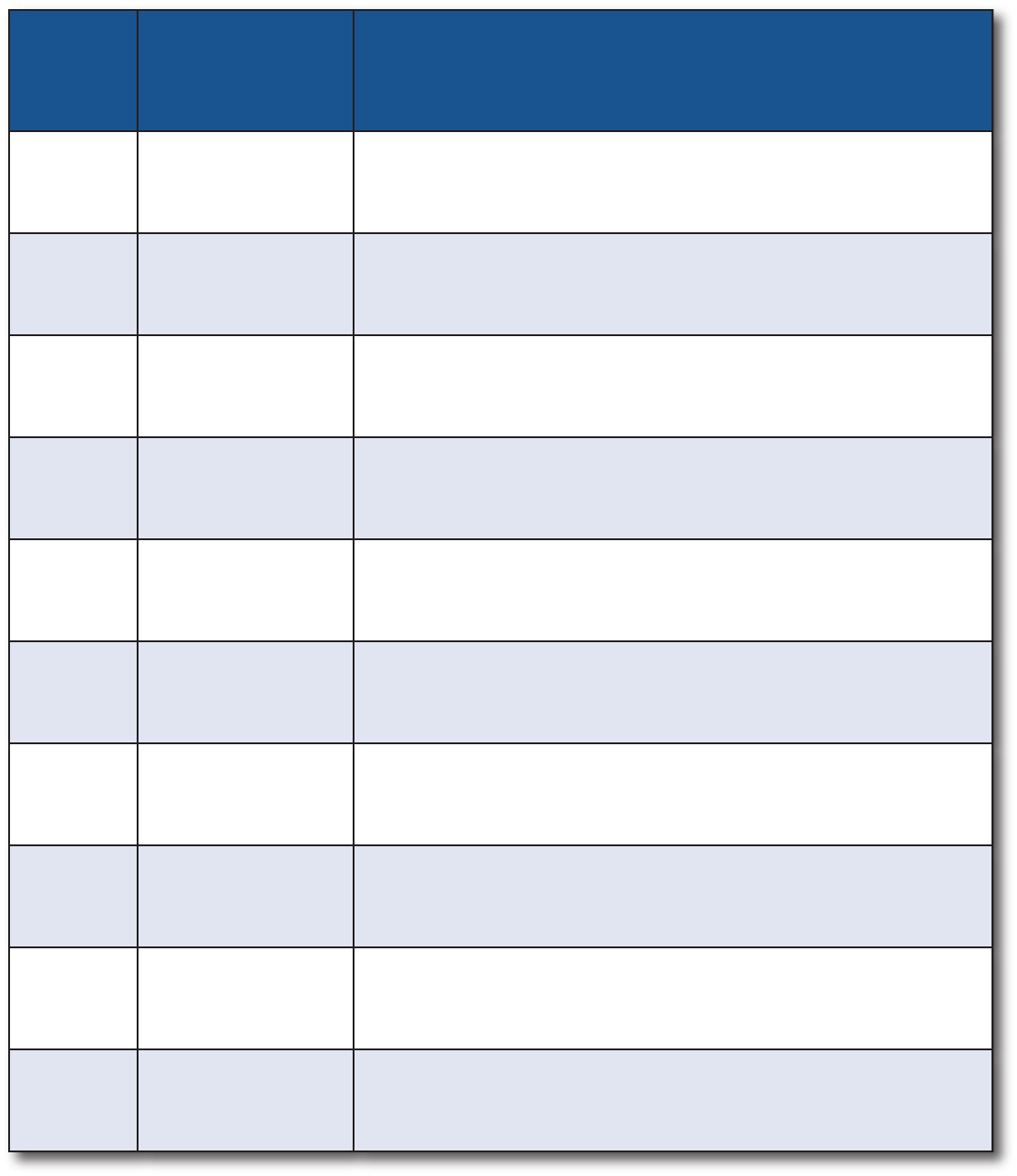
81
Exporter Classification*
Type Description
Export Profile
10 Multinational Strong market share everywhere across multiple categories.
9 Global Multinational. Mix of leading countries and niche participation.
8 Category Champion One core mass category. Strong performance globally.
7 Icon Well known, niche leader. Global availability. Example: Tabasco.
6 Regional Leader Strong share across one continent/region. Some export success.
5 National Hero National treasure, #1 brand. Exports to homesick expats, tourists.
4 Player Respectable share in home country. Opportunistic exports.
3 Participant “Me too” product. Opportunistic exports. “Trader”/private label.
2 Challenger Innovator. Some listings in home country. New to export.
1 Start-up Trying to get traction in home country. Export “dreamer.”
*Export Solutions’ classification system
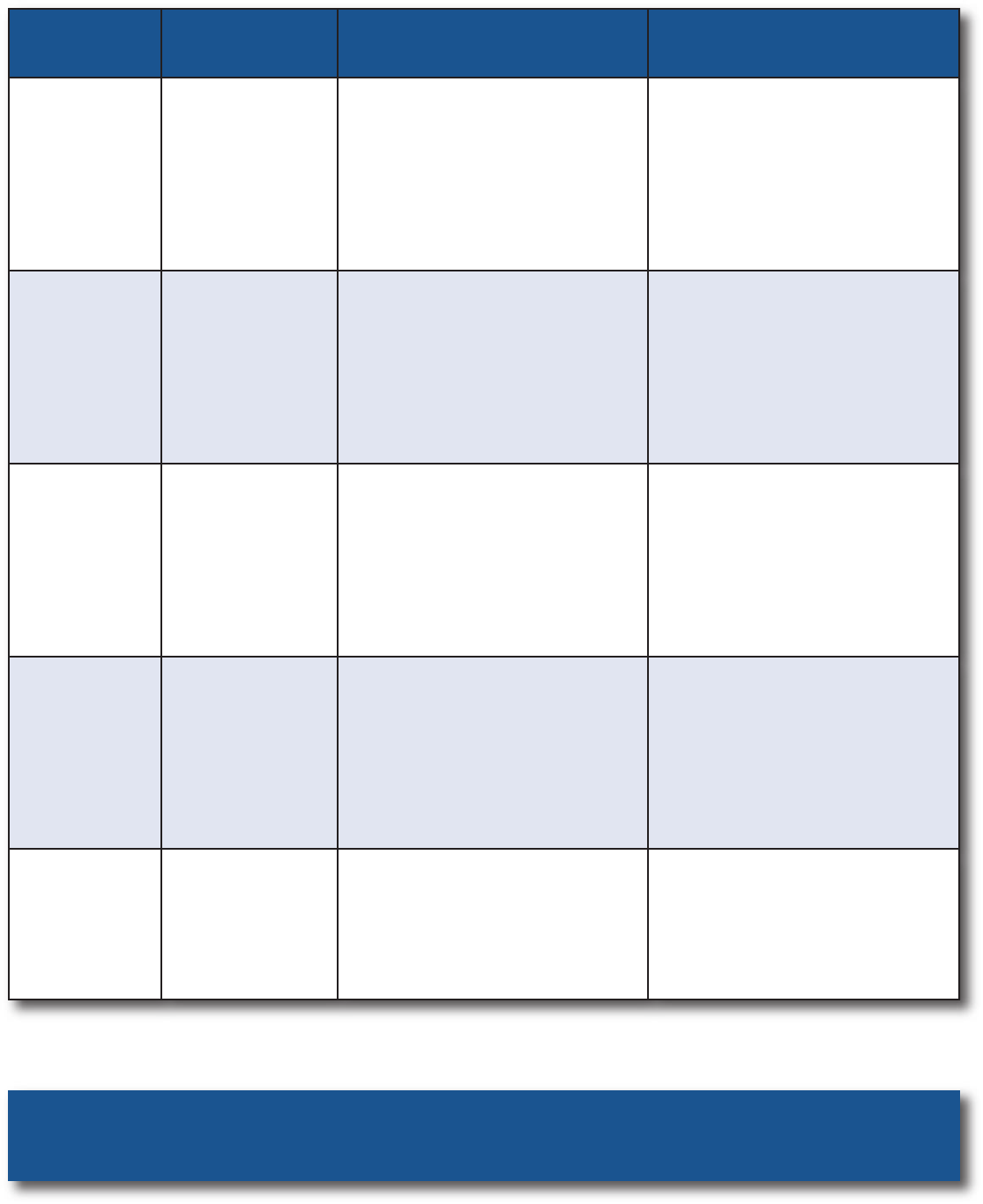
82
Distributor Classification*
Stars Title Description Prime Prospects
HHHHH
Champion
Massive distributor.
Handles multinational/#1
brands across many
categories.
Brand leaders.
$$$ marketing budgets.
Exporter types: 6-10
HHHH
Captain
Category Captain.
Handles leading brands in
one segment.
Category
innovators/leaders.
$$ marketing budgets.
Exporter types: 5-9
HHH
Player
Mid-size distributor.
Handles #2/3 brands or
niche leaders across many
categories.
Differentiated,
premium brands.
$-$$ marketing budgets.
Exporter types: 4-7
HH
Participant
Respected local.
Diversified product
portfolio.
Results equal to investment.
Flexible, challenger brands.
$ marketing budget.
Exporter types: 2-4
H
Pioneer
Small distributor.
Entrepreneurial, open to
innovative new companies.
Start-up brands.
“Pay as you go” marketing.
Exporter types: 1-3
Need more information? Visit www.exportsolutions.com.
*Export Solutions’ classification system
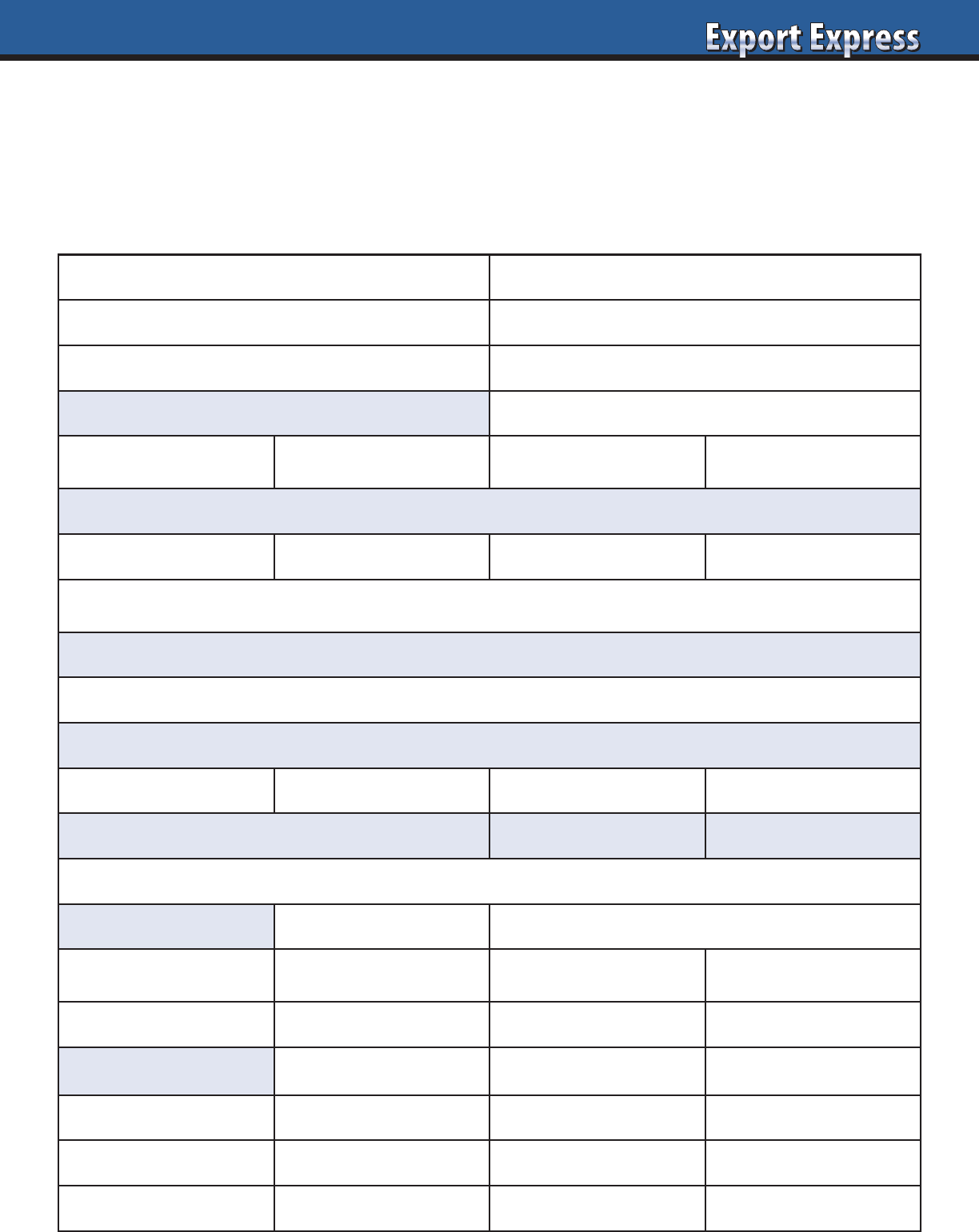
83
Exporter Data Sheet
What Distributors want to Know about Your Company
Key Contact: Telephone:
Web Site: Email:
Founding Date: Ownership:
Annual Sales: Total Employees:
0-$50 million $50 million - $250 million $250 million- $1 billion $1 billion +
% Sales International:
0-10% 10-25% 26-50% 50% +
Exporter Classification/Description:_________________________ (#1-10, based upon Export Solutions’ scale)
Core Product Range:
Unique Selling Point:
Market Share:
Home Country: Country A: Country B: Country C:
Current Business in Distributor’s Country: Yes/No: Size $:
Current Customers (Distributor’s Country):
Investment Model: Listing Fees*: Yes/No *average $35 per item,per store
Trade Promotion Budget: Dead net price: 10% of sales: Mass:
Marketing: Digital: Sampling: 360 degree:
Ambition/Size of Prize: Sales: Market Share:
Year 1
Year 2
Year 3
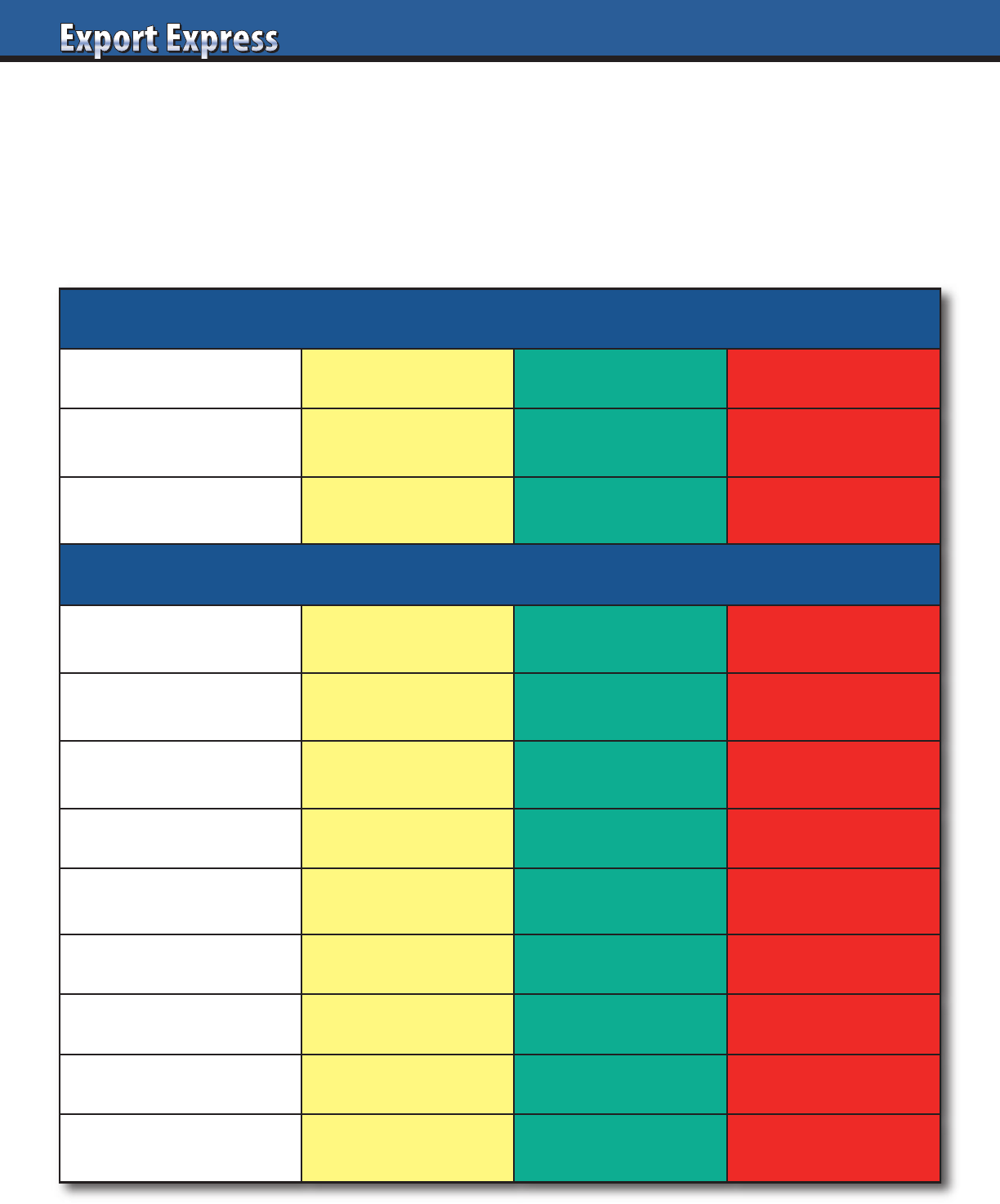
84
Distributor Selection Road Map
Export Solutions Performs Distributor Search in 96 Countries
Most companies maintain diverse distributor networks: A mix of large and small distributors, category
specialists, and those focusing on brands from your home country. Export Solutions recommends performing
a distributor model analysis of your current distributors to determine which type of distributor is delivering
“Best in Class” results. An important consideration is your brand ambition and investment level for a country
when evaluating distributor performance. The results of your distributor model assessment can be used to
guide new distributor selection or upgrade your current distributor network. Export Solutions can help!
Brand Ambition
Country Importance Strategic Priority Opportunistic
Brand Market
Share Objective
Leader Player Niche
Brand Investment Model Mass Marketing 10% of Sales Dead Net Price
Distributor Selection Criteria
Preferred
Distributor Size
Large Medium Small
Channel Specialization Supermarkets Foodservice Pharmacy
Category Specialization All Food
Confectionery
& Snack
Beverage
Gourmet Natural Food Health & Beauty
Ethnic Food Frozen/Chilled Household/Non Food
Country Specialization USA France Germany
Italy Spain United Kingdom
Asia Latin America Middle East
Benchmark Brands
(examples)
Pringles Barilla Tabasco

85
Strong consumer goods distributors are
deluged with representation inquiries
from around the world. The emails are
usually supplemented by a product
catalog and promise to mail a price list!
In a best case scenario, this type of
approach may lead to a request for more
information from a good distributor.
More likely, the distributor will skip
your inquiry and move on to the next
opportunity in his mailbox. Listed below
are Export Solutions tips for “breaking
through the clutter” and providing
the right information to generate
excitement and interest from the
distributor community.
1. What is your Brand USP
(Unique Selling Proposition)?
USP defines your competitive edge
versus all other brands battling for the
same shelf space. The USP can revolve
around quality, value, assortment, or
packaging. However, you need to
validate your claims. For example, a
statement such as “tastes better than
competitors A & B” should be supported
by market research of consumers or blind
tests of a sufficient panel group that backs
your quality claim. Similarly, a retail price
review can demonstrate a “better value”
position. Your USP must also pass the
litmus test: Is your USP relevant to the
purchaser and consumer? For example,
you might offer the only coffee with
orange and lemon flavors, but is anyone
really looking for this product?
2. Have you Done your homework
on my Market?
The food/consumer goods industry is
relatively transparent. Typically, brand
owners simply need to visit the leading
supermarket chains to obtain a
“snapshot”of local category assortment,
pricing and merchandising practices.
The assortment and shelf space allocation
will provide clues regarding consumer
preferences from a taste/usage
standpoint and potential gaps in the
market. Syndicated data providers such
as Nielsen and Euromonitor supply
reams of data tracking category sales and
trends. New brand representation offers
to distributors that demonstrate a degree
of understanding of local category market
conditions will always receive an
appreciative response.
3. What Will the Brand Owner Invest?
The most important consideration after
the USP definition! A distributor believes
that he needs the right financial spend
levels to aid him in achieving the results
that he is capable of. The correct spend
level usually reflects an appropriate
mix of trade development funds (listing
fees/shelf space/flier participation)
and consumer awareness activities
(sampling/pr, etc.) The brand owner
must acknowledge that there are fixed
fees to enter virtually every market.
Some distributors are willing to split
these fees. It’s usually not enough to
case rate spending unless you have a very
strong proposition. Bottom line: If you are
unwilling to invest in your brand…why
should the distributor invest his time
and resources building your brand?
4. Where Has your Brand Been Successful?
Your track record at building brands
counts! Share your record proudly,
particularly if the target country or
retailer are well known or reside in
an adjacent country. On the other hand,
a “Made in the USA” success story may
not be impactful if you don’t intend to
duplicate the conditions that brought
you success such as local production
and measurable marketing investments.
5. How Tough is the Job to Launch your Brand?
Are you attempting to enter a competitive
category dominated by heavy spending
multi-nationals? Or are you aiming at
an attractive niche? What are the brand
owners expectations in terms of product
availability and sales volume?
6. Can the Distributor Make Money
with your Brand?
Distributors seek to obtain a fair profit
for their activities to support your brand.
Profit must be measured in dollars
contributed versus percent of sales.
Distributors rarely make money during
year one of an introduction as they
allocate a disproportionate share of their
resources to launch a brand. On the other
hand, new brands in current categories
for the distributor can bring new profits
with minimal incremental effort. Globally
recognized brands bring prestige to a
distributor’s portfolio and may serve as
a magnet to attract other brands. Brand
owners must present a convincing case to
the distributor on the incremental profits
that your company can deliver to the
distributor’s bottom line.
Brand Owners: What Every Distributor Wants to Know
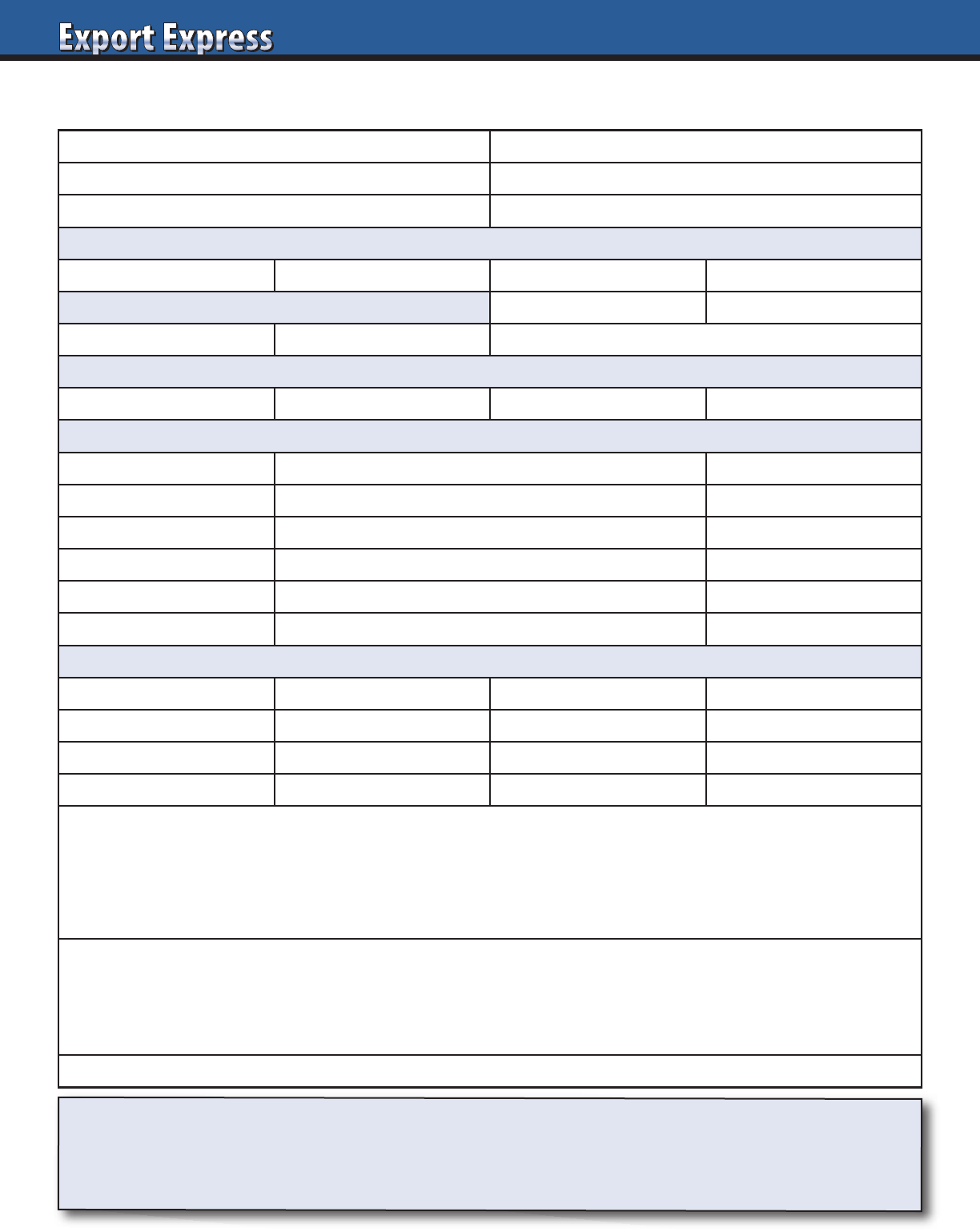
8686
Export Solutions recommends creating your own one page Export Distributor fact sheet template. Insist that all candidates
complete the template 100 percent prior to a phone interview or trade show meeting. Pay particular attention to the annual
sales number, brands represented and manufacturer references. Qualified candidates will enthusiastically complete these
sections. “Pretenders” or time wasters will leave these sections blank or disappear saving you time and money!
Export Distributor Data Sheet:___________________________________
Key Contact: Telephone:
Web Site: Email:
Annual Sales: Total Employees:
Employees, by Function:
Key Account Sales Logistics Marketing Merchandising
Company Owned Warehouse: Yes No
If Yes Warehouse Size: Location:
Channel Coverage (percent sales by channel):
Supermarket Convenience Foodservice Other
Top Five Manufacturer Clients:
Company Name Brands Represented Years Service
1
2
3
4
5
Manufacturer references:
Company Name Contact Name Contact Telephone Contact Email
1
2
3
Why are you interested in distributing our brand?
Why is your company the best candidate to represent our brand in the market?
Feel free to attach your company credentials presentation.
(Distributor Name)
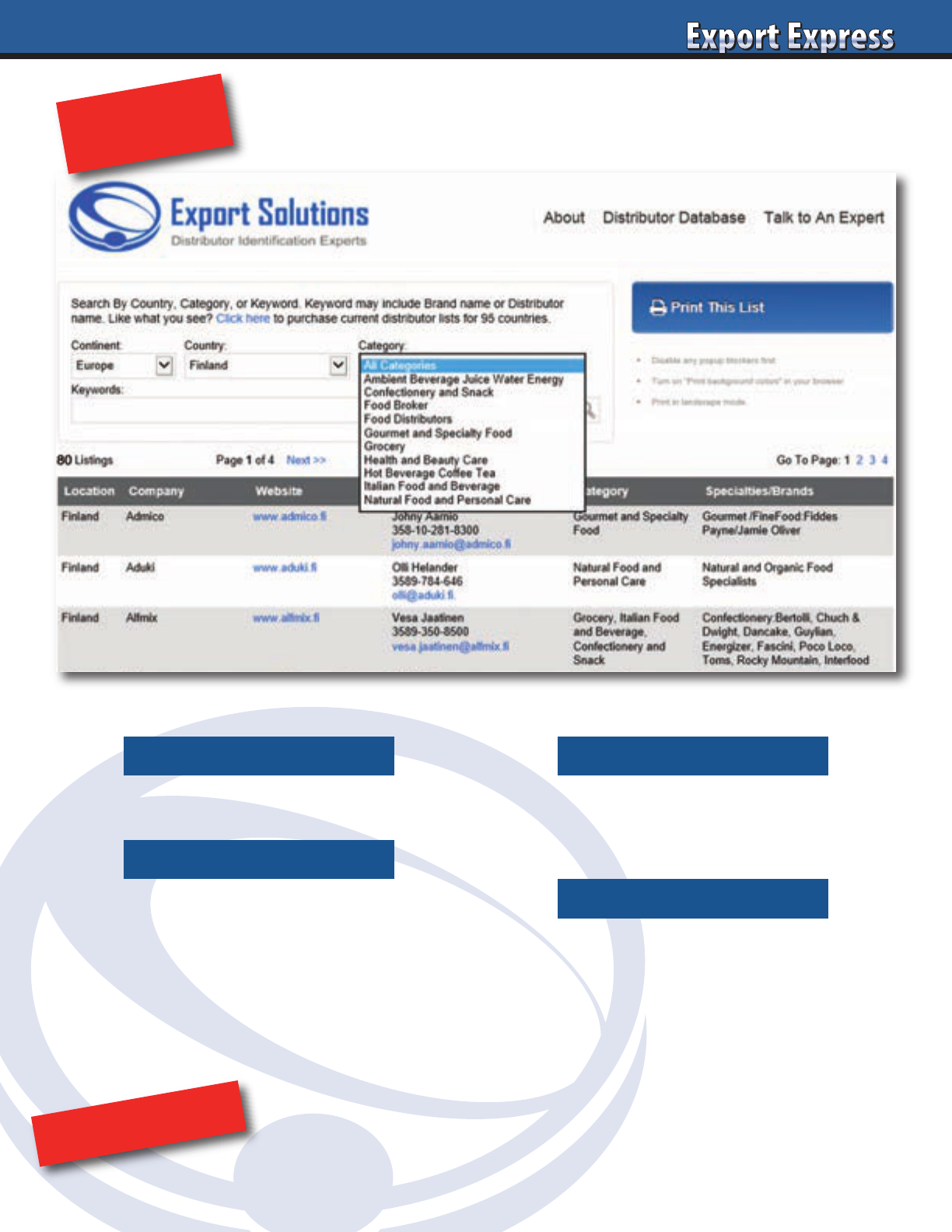
87
Coverage: 96 countries and 9,200 distributors
Confectionery & Snack
Gourmet/Ethnic Foods
Beverage (Ambient & Hot)
USA, German, UK, Italian Food
Health & Beauty
Tracking Distributors for more than 300
of the world’s most famous brands.
Example 1: Who are Beverage Distributors
in Germany?
Example 2: Who is the Pringles Distributor
in Saudi Arabia?
NEW!
ORDER NOW!
Distributor Search Made Simple
87
Search by Brand NameSearch by Country
Search By Category
Combo Search
www.exportsolutions.com
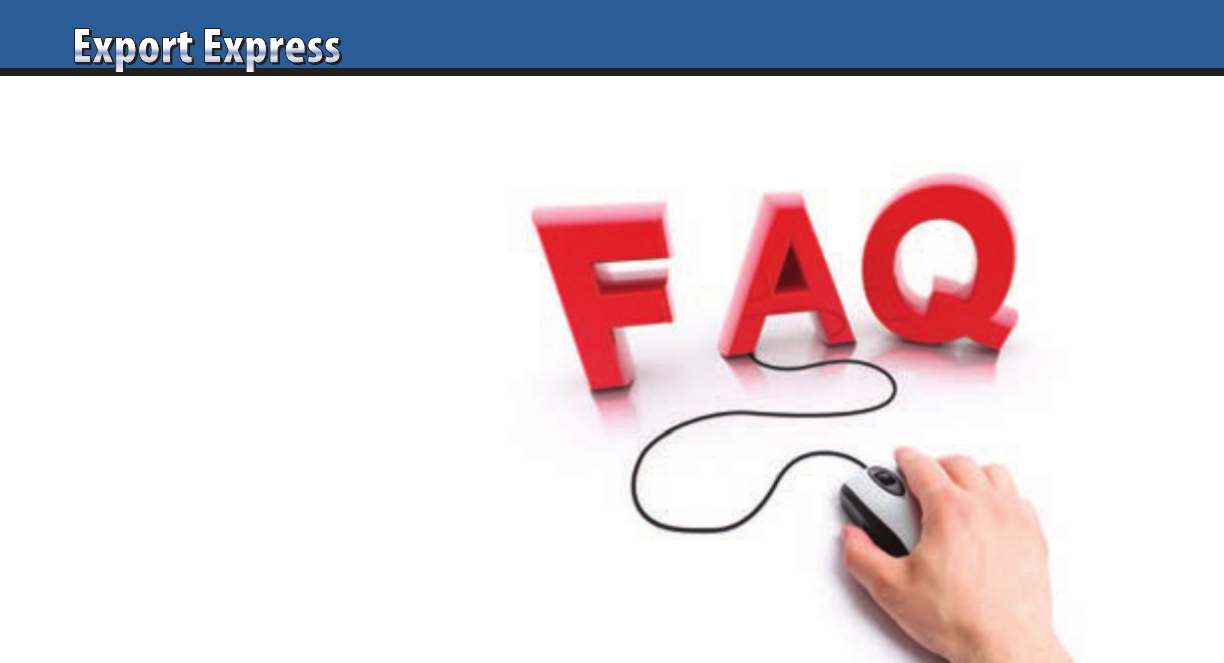
88
Why did you create the distributor database?
Export Managers dedicate a lot of time
to networking, always searching for good
distributor recommendations. We waste
precious time at trade shows speaking to
“pretenders” with no hope of adequately
representing our brands. I thought that
the supermarket industry could benefit
from a global distributor database to
instantly find the leading distributors
in any country.
How did you compile the distributor database?
Export Solutions sources distributor
candidates using six specific strategies.
This includes having access to the global
distributor lists of more than 300 brands
and store checks in at least 25 countries
per year.
How accurate is the contact data?
Export Solutions distributor database is
updated every day! Distributor company
names, web sites, and specialization
rarely change. This makes the database
98% accurate at the company level. The
distributors’ key contact for new product
inquiries and their email addresses may
change as a result of job moves. Email
address accuracy ranges from 80-90
percent depending on the country. We
employ three separate mechanisms to
keep up to date with changes.
What’s new?
Our database has expanded to
96 countries and 9,200 distributors. It’s
now searchable, supplying country and
category filter inputs or brand names! We
also offer 90 day access if you purchase a
country or category list. This allows you
to work online and enjoy “one click
access” to distributors’ web sites.
Naturally, we prefer that you purchase
an annual subscription with unlimited
access to the entire database for one year.
What is the difference between
Export Solutions distributor database
and other “lists?”
1. Created by industry export
professionals, not directory aggregators
or other online companies with no
relevant food/consumer goods
industry experience.
2. Each distributor is personally validated
by Greg Seminara. Distributors can not
self register or pay to be in our database.
We know the difference between a “best
in class” distributor and a “one man show.”
3. Our distributor database is designed
for manufacturers of branded products
normally sold through supermarkets,
pharmacies, and food service channels.
We do not include distributors of
commodities or ingredients.
4. Call us! Our specialization is
distributor search, with 300+ projects
completed. Contact us for a free copy
of our Distributor Search Guide.
5. Our database is searchable by country,
category specialization, brand name, or
combination of all three filters.
Which type of companies use our database?
Database clients range from small start-
ups to the largest companies in food
and consumer goods. Export Solutions
database has had more than 3,000 clients
including brand owners from all over
the world. Leading government trade
organizations from USA, Italy, Germany,
and Brasil also develop special
agreements to gain access.
What product categories are covered?
Distributors include specialists for
branded food products, confectionery
& snacks, beverage, natural foods,
gourmet products, ethnic food, health
and beauty care products, household
products, and general merchandise. We
offer oustanding coverage of Italian Food
distributors. Many distributors can
handle any product that is normally
sold through Supermarkets, Convenience,
Foodservice/Catering, or Pharmacy
trade channels.
What are best practices in getting the most
productivity from the database?
Successful companies use the database
to screen companies to develop a top 5 list
of high potential candidates. They send
a short introductory email with a web
link to their company site. Then, the
export manager follows up with a
phone call within 48 hours. The database
is an excellent tool to invite potential
candidates to an international trade
show like Sial, Anuga, ISM or Sweets
and Snacks. Note: mass mailing
distributors usually generates less
than desirable results.
Does Export Solutions provide any additional
information on the distributors?
Export Solutions knows many of the
distributors in our database. Clients of
our Premium Subscription or Talk to An
Export Expert Services can gain access
to our insights via phone on the best
distributor candidates in any of the
96 countries we cover.
How do I access the distributor database?
Visit www.exportsolutions.com and click
the distributor database page. You can
place a subscription or country or
category access into a shopping cart.
Register and check out via credit card.
The process takes two minutes and we
automatically send you an invoice.
FAQ’s – Distributor Database

89
Every export manger has performed the
time consuming function of reaching out
to potential distributor candidates in a
new country. The process is usually
successful, but requires patience and
perseverance. Top distributors are
overwhelmed with new representation
inquiries. These requests must compete
for attention with the hundreds of emails
in the distributors inbox from his existing
brands. Export Solutions has worked on
more than 300 distributor search projects
across 96 countries. Below are our Best
Practices for contacting new distributors.
Email Plus Phone Call
Email candidates a short, fact based, note.
You may receive an immediate response
from a few hungry and motivated
candidates. More likely scenario is the
need for an immediate phone follow-up.
Work with the contact’s assistant to
schedule a phone meeting or ask to speak
with the person in charge of “important
new business” projects. Periodically, I
will also contact a distributor through
LinkedIn, as that often routes through a
different email address. Lack of response
after several attempts means that the
distributor is not interested. On the other
hand, you must persevere as frequently
the boss may be busy or not glued to
email like the rest of us.
Avoid Mass Mailing
Distributors recognize an email blast from
miles away, guaranteeing a low response
rate. Better to send a personal email,
mentioning the contact’s name, how you
found him and your rationale for contact.
i.e., “we are looking for a partner with a
strong track record building other USA
brands.” Target distributors which may
be a good fit based upon your investment
level and brand ambitions. For example,
large power distributors prefer brands
with strong marketing plans, while
smaller distributors appear more open
to pioneering promising new products
without giant spending budgets.
Company Credentials Information
Do not bombard a candidate with
attachments and PDFs of lovely
brochures prepared by an ad agency.
First, many people automatically delete
emails with attachments from people
they don’t know. Send PowerPoints
and project details only after you have
established contact.
What Distributors Want to Know
Distributors want to know who you
are: what is the size of your company,
brand USP (why are you different?)
international success, and plans
(investment strategy) for their market.
Distributors’ mindset is to quickly
calculate how much money they can
make representing your brand and how
tough will it be to sell to their customers!
Market Visit
Distributor response will be improved
if you request an introductory meeting
at their office. This demonstrates that
you are serious about the project and
interested in brand building, not just
selling a few containers. Try to visit at
least three distributors on your trip, more
if it is a large country or you anticipate a
“tough sell.” Schedule your visit at least
6-8 weeks in advance to guarantee
distributor availability.
Distributor Search Guide – Export Solutions
Export Solutions’ web site contains a
free Distributor Search Guide. This guide
is jammed with strategies, ideas, and
templates to guide each step of the
distributor search process. Export
Solutions completes distributor search
projects for leading brands worldwide.
Contacting New Distributor Candidates – Best Practices
Sample Introductory Email
Subject: New Business Opportunity – CerealCo* – USA
Dear Alexander:
CerealCo is a popular cereal brand from the USA.
Founded in 1960, 2022 sales will exceed $300 million
dollars. Our point of difference is that CerealCo offers
high quality gluten-free and organic cereals popular
with many modern consumers. CerealCo exports to
25 countries, including several in Asia.
We are now beginning the process of considering
partners for Indonesia. I understand that you have a
successful track record building other well known USA
grocery brands. Can we arrange an introductory web
meeting for Wednesday at 900 am? I am based in
Atlanta, Georgia, -12 hours versus Jakarta.
For more information, visit our web site at
www.cerealco.com
Kind regards,
Greg Seminara
Export Manager
gseminara@exportsolutions.com
(001)-404-255-8387
*Note: CerealCo is a fictitious company. Any resemblance to an
actual cereal company is coincidental.
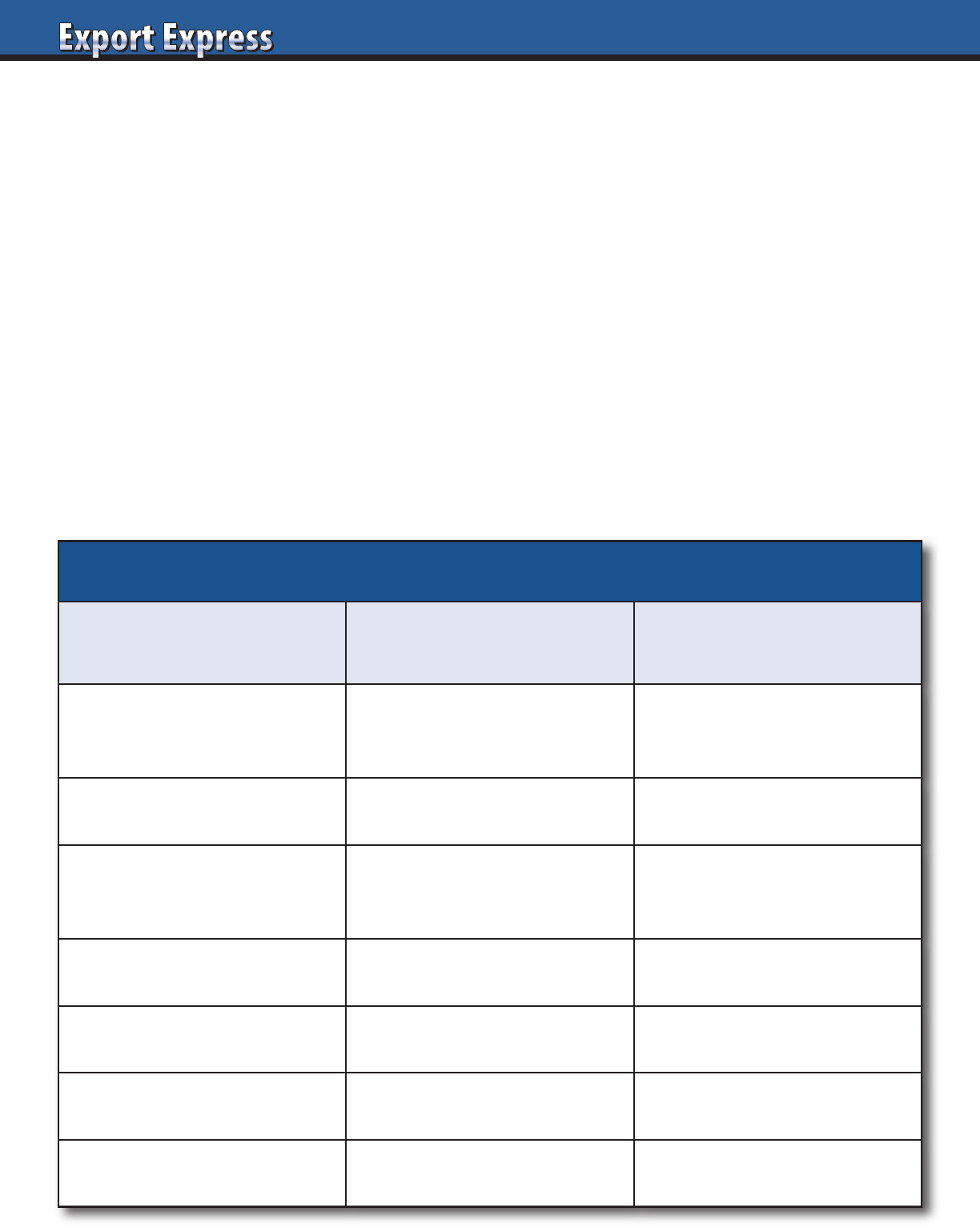
90
Annual Sales:
$300 million US dollars in 2022
History:
CerealCo founded in 1960…62 years old
Core Product Portfolio:
Breakfast Cereals – “Leader in Organic/Gluten-Free Cereals”
Web Site:
www.cerealco.com
International Overview:
Direct sales to 25+ countries. Indirect sales to 50+ countries.
2021 International sales + 25%!
Southeast Asia Status:
CerealCo products available across Asia through a hybrid model
of partnerships, distributors and indirect sales through USA
consolidators. Current net sales of roughly $2 million dollars
in Asia Pacific.
CerealCo Objective:
Align with a distributor with strong brand building capabilities.
Develop a collaborative plan to grow business to comparable
levels to of our successful business in other Asia Pacific countries.
August Market Visit
CerealCo will visit Jakarta the week of August 1.
We will visit stores and meet potential partners to discuss
CerealCo plans.
*Note: CerealCo is a fictitious company. Any resemblance to an actual
cereal company is coincidental.
Company Fact Sheet (add your logo)
CerealCo* Summary – Indonesia Example
Best Practices – Contacting New Distributors
Do Don’t
Email Content
Short introductory email.
Company facts plus web link.
Lengthy email with
generic claims on
“why your brand is the best.”
Email Delivery
Send on Monday.
Distributor has week to review.
Send on Friday.
Email lost over the weekend.
Email Timing
Should arrive to distributor
at 2:00 pm his time.
After the “morning rush.”
8:00 am/9:00 am emails are
reviewed quickly and deleted.
Phone Contact
Start calling 24 hours
after initial email.
Wait a week to call.
Attachments
No attachments on first email.
Web link only.
Send PowerPoints or
pricing on first email.
Follow-Up
Constantly, if you believe
it’s a good candidate.
Wait for distributor to
contact you.
In Country Meeting
Best opportunity to review
your brand proposition.
Create relationship without
market visit.

91
Distributor interviews can be compared to a first
date. There is no second date after a bad first date,
even if both parties are interested in each other. On
the other hand, a good distributor first interview
can lead to a lifelong relationship. Listed below
are Export Solutions’ ten tips on enhancing the
productivity of your distributor interview process.
1. Schedule Interview With Four to Six Weeks Lead Time
This allows you to program several candiate
interviews on your preferred timeline. Long
lead times enhance the chance of distributor
senior management availability and provide
sufficient time for motivated distributors to
research your category.
2. Meeting Agenda
Send a meeting agenda three weeks in advance
of meeting. Typical discussion topics include
Distributor credentials, organization model,
coverage by channel, success stories, category
insights, and distributor margin philosophy.
3. Store Visits – Pre-Interview
Export Solutions always conducts independent
store visits prior to our distributor interviews. This
supplies a snapshot of distributor’s performance for other
international brands. It also permits us to quickly become
familiar with local category dynamics, competitive activity,
and pricing.
4. Distributor Assessment Grid/Questions
Prepare an assessment grid template highlighting and weighting
core assessment areas prior to your first interview. Create a list
of potential questions to be asked during the meetings. Export
Solutions provides free sample Distributor Assessment grids and
“10 Questions for Every Distributor Interview” on our web site.
5. Distributor Presentation: Template or Tailored?
A key indicator of distributor enthusiasm is whether they created
a personal, tailored presentation for your meeting or swapped
brand logos and provided their “standard pitch.” Best in class
presentations allocate equal time for Distributor’s CEO,
functional heads, and your proposed first point of contact.
6. Your Company Presentation
Be prepared to share a 10-15 page presentation on your company
credentials. Stick to the key facts: company metrics, product
point of difference, export success stories, and plans for the
market. Bring plenty of samples for everyone to try. Note that the
distributor will ask for your presentation, so keep it brief as you
do not want a lengthy strategic presentation in the hands of a
distributor that is not selected.
7. Tour Distributor’s Office and Warehouse
Would you buy a house without visiting it? Distributor offices
and warehouses offer valuable clues to distributor activity, head
count, size, and professionalism. Your quick inspection will
validate that the distributor’s activities match claims from
their presentation.
8. What’s Their Plan?
A core question in a positive interview is “What would the
distributor’s plan be if we awarded them the business starting
next Monday?” This provides insights on their plans, timelines,
and process for transitioning and building new brands.
9. What Do You Like About Us?
A good way to measure distributor interest is to ask their
feedback on your opportunity towards the end of the meeting.
Framing the question from a positive point of view allows the
distributor to express interest or concerns.
10. Provide Homework Assignment
Conclude each positive meeting with a request for distributor to
provide a deeper category assessment and a suggested entry or
transition plan. Distributors should supply references for five of
their existing clients. An important insight will be the quality and
response time for completing the “homework.”
Ten Tips: Distributor Interview Preparation and Insights
Need more information? Visit www.exportsolutions.com.
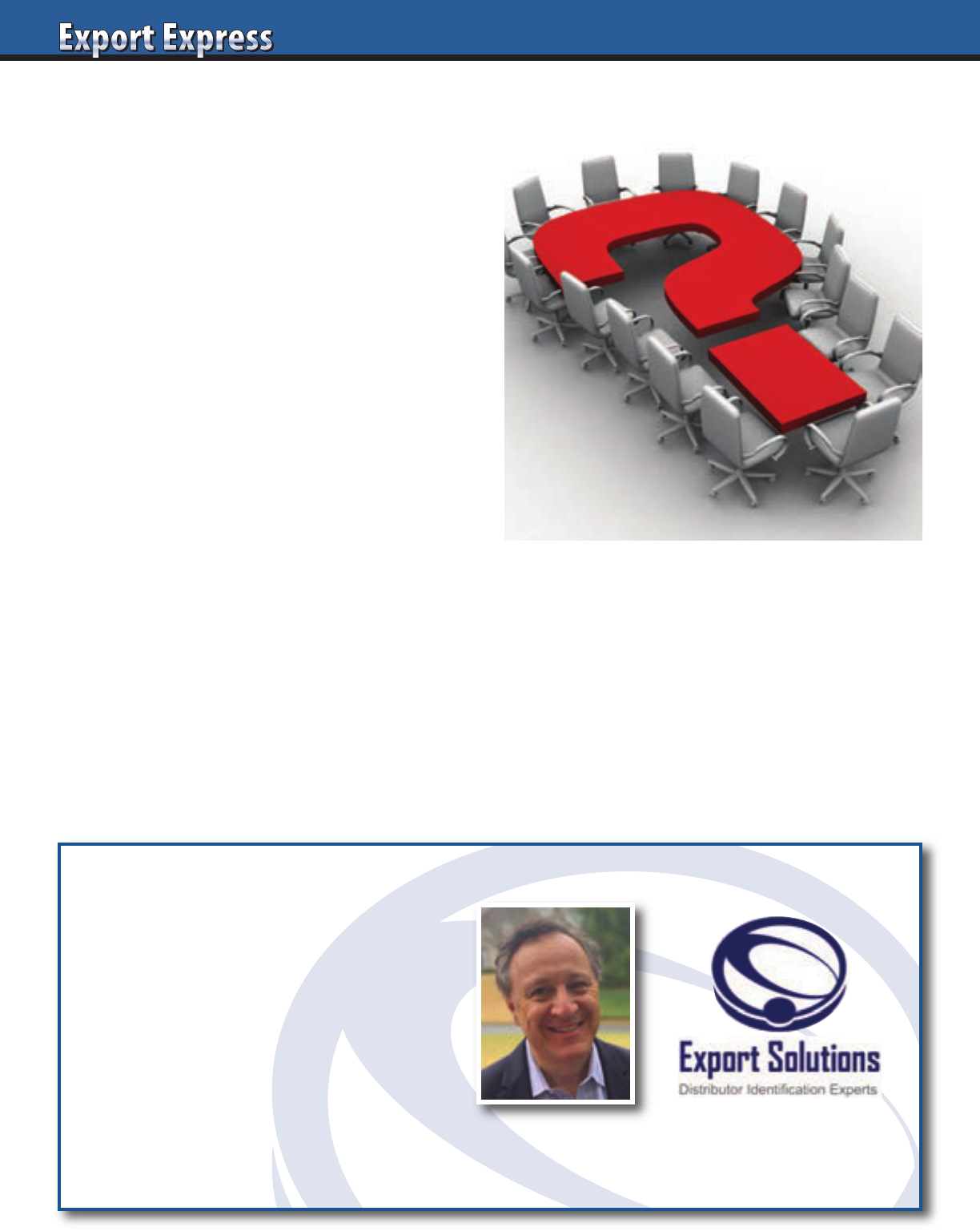
92
10 Questions for Every Distributor Interview
1.Company History
How long have you been in business? Who are the owners?
How many direct, “payrolled” employees do you have?
Approximate annual sales volume?
2. Company Brand Portfolio
What are your top 10 companies/brands represented?
For which channels do you represent each brand?
How long have you represented each brand? Can you
provide senior level references at each “brand owner”?
3. Key Account Buyers
Who is the buyer for our category at the largest retailers in
your market? What other brands do you sell to our buyer?
How frequently do you visit each major customer?
4. New Product Launch Success Story
Provide a recent example of a new brand launch success story.
Key retailer acceptance? Cost of entry? How long did it take?
Key elements of the success strategy?
5. Creative Selling
Provide an example where you took an assigned
marketing/brand support budget and created a successful
local program. How do you measure success?
6. Retail Servicing
How many full time employees do you have visiting retail
stores? Are they located countrywide or just in the capital city?
How do you measure a “good store” in terms of brand presence
versus a “bad store”? Describe your retail reporting system.
7. People
Who would be our point of first contact? Would our contact also
“sell” our brands to major accounts? What other brands is our
contact responsible for? How do we insure that we get our fair
share of attention from your sales force?
8. Business Planning Model
What would your action plan be if we made an agreement to
start with your company? First steps? 90 Day Plan? Reporting?
9. Cost to Serve
How do you model your distributor margin? Range of margin
for our brands? Are you open to promotional spending
split (50/50)?
10. Enthusiasm for our Company
Why is our brand a good match for your company?
Why are you the best partner in the market for our brand?
What commitment are you willing to make?
Talk to an Expert
• International Strategy Road Map
• Fix Problem Markets
• Entry Plans
• Find Distributors in 96 Countries
• Export Workshops
• Motivational Meeting Speaker
Contact Greg Seminara at (001)-404-255-8387 to discuss your business development project.
www.exportsolutions.com
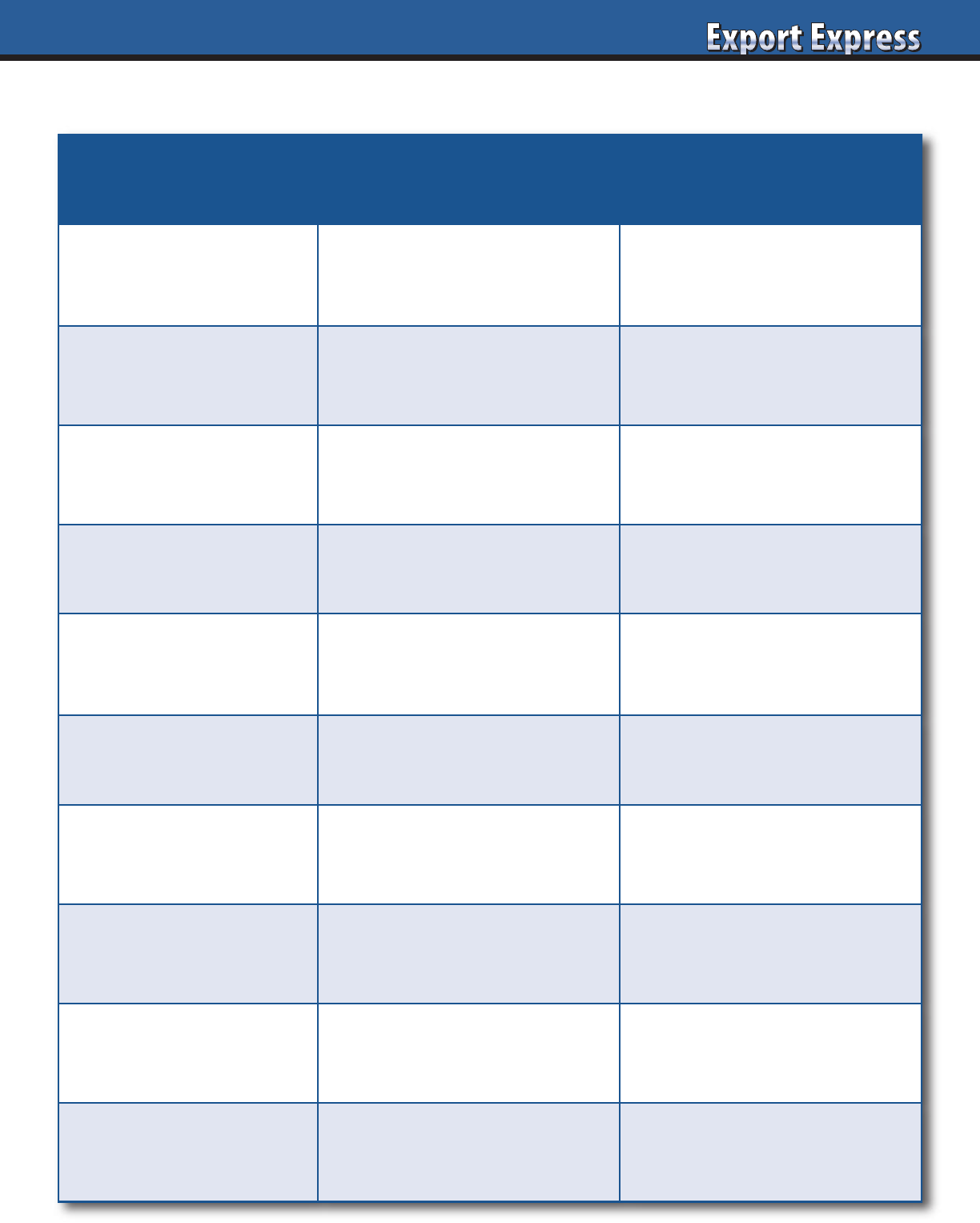
9393
Distributor Search Best Practices
Activity Bad Practice Best Practice
Distributor Profile No portfolio synergies.
Representing similar size,
premium brands from your
aisle/country.
Candidate Model
Agent or third party not based
in destination country.
Distributor of international,
third party brands.
Web Site None! Watch out.
Modern/informative site.
Lists current companies
handled.
Candidate Selection Evaluate one candidate only.
Consider 3-5 candidates,
depending on complexity.
First Contact
Random solicitation by
unknown company.
Trade show or formal phone
meeting with respected
distributor.
Market Visit
Start partnership without
market visit.
Local assessment: office
meeting, warehouse inspection.
Store Check
No store check to validate
distributor capabilities.
Full day store check to measure
results for existing brands.
Reference Check
No financial or commercial
checks.
Check current principals plus
financial institutions (D & B).
Year I Plan No plan. “Buy and ReSell.”
Logical plan with targets,
activities, timelines, costs.
Price Calculation
Sell at dead net price.
Arbitrary mark-up.
Transparent price calculation
from factory to store shelf.
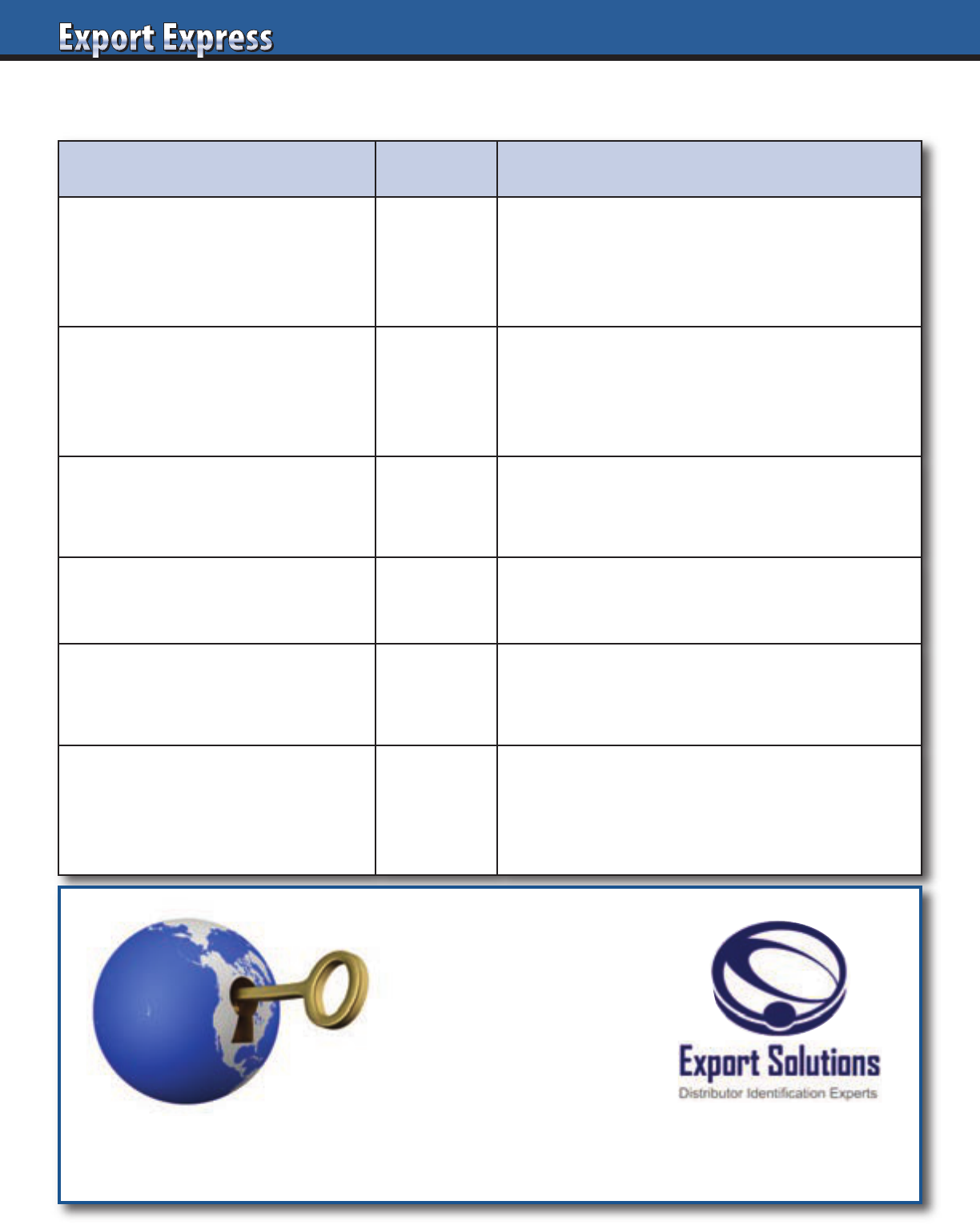
94
Criteria (weighting) Rating Evaluation Factors
Corporate Credentials 30%
Size, sales force, logistics, # employees.
Reputation (reference check existing brands).
National coverage.
Multi-channel coverage.
Category Expertise 20%
Sells brands in my category.
Shelf space for existing brands.
Current brands selling to target retailer.
Category analysis and insights.
Brand Building 15%
Ideas to build or launch my brand?
Marketing plan, cost, timing.
Success stories.
Cost to Serve 15%
Fair, transparent model relative to size
of business, brand investment, and
work required.
Enthusiasm for
My Brand 20%
Advance preparation, CEO involvement.
Follow-up on commitments.
Alignment with your vision.
X Factors: People, Admin.,
Professionalism, etc.
+/-
CPG/FMCG background for leaders.
Efficiency of scheduling meeting.
Office environment.
Do you enjoy the people?
Rating System
Rating Score
Excellent 5
Very Good 4
Average 3
Fair 2
Poor 1
Contact Greg Seminara at (001)-404-255-8387 to discuss your distributor search project.
www.exportsolutions.com
Export Solutions Distributor Assessment Grid
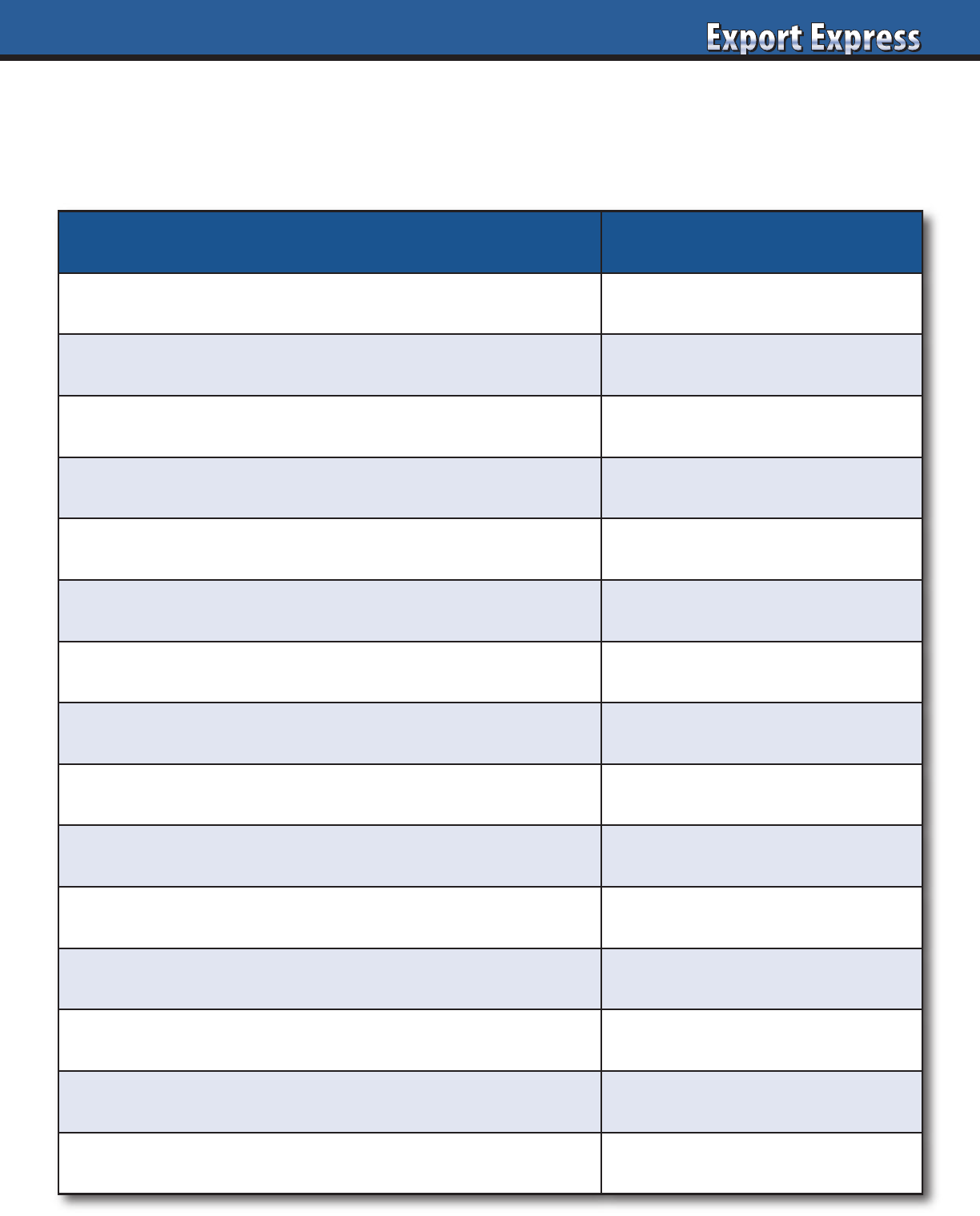
9595
Customer Relationship Assessment
All distributors claim strong relationships with their biggest customers. Below is Export Solutions’ template
for evaluating distributor key account relationships. Best way to evaluate distributor relationships? Your
company’s market share and volume growth at the customer versus the balance of the market
!
Assessment Criteria Rating: (10 = Best)
Distributor viewed as an important supplier to the retailer/buyer
Open to bringing brand owner to customer meetings.
Ability to schedule buyer/CEO meetings outside the office.
Can negotiate standard listing fees and other program costs.
Pricing: access to price coordinator. Ability to make changes.
Shelf: access to decision maker. Space in excess of market share.
Merchandising Flier/Catalog: Ability to get prime feature space.
Relationship/access to retailer owners, senior executives.
Problem solving: rapid response? Emergency orders etc.
Payment terms.
Access to retailer movement data.
Category captain or “advisor” for my category.
Vendor awards?
Knowledge of retailers systems. “How to get things done.”
Sales results versus overall market and retailers internal growth.
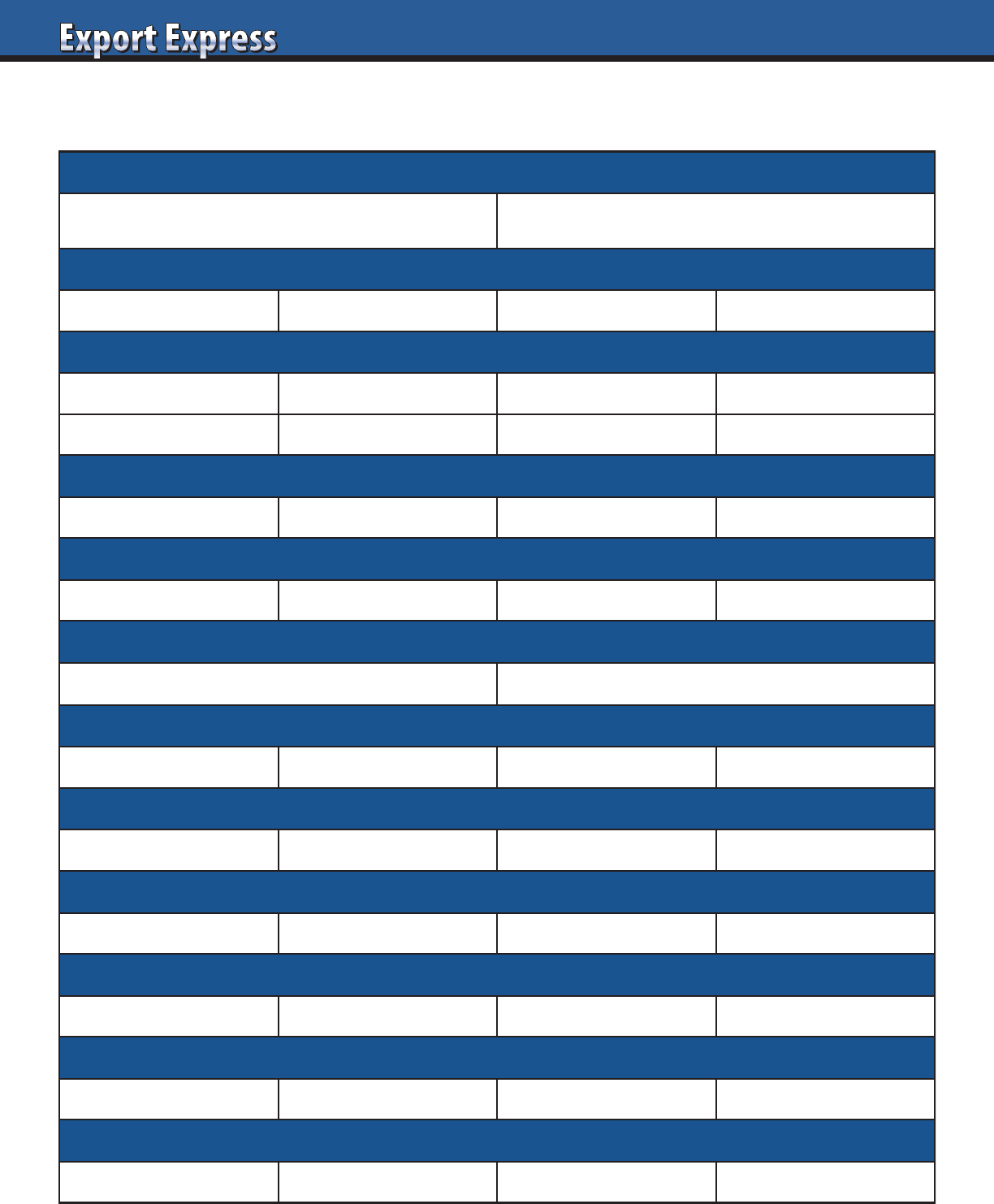
96
Category Review Template* – page 1
(Estimate: Source info from Store Checks, Retailers, Nielsen, Euromonitor)
*Note: please provide your best estimate
Category Sales: Total, all channels, all customers
Retail Value _______________________________ Wholesale value___________________________
Category Sales: Percent by Segment
Segment A _________ Segment B _________ Segment C _________ Segment D _________
Category Sales: Percent by Channel
Supermarket _________ Convenience _________ Discount _________ Pharmacy _________
Wholesalers _________ Cash & Carry _________ E Commerce _________ Other _________
Category Peak Seasonality
Summer _________ Winter _________ Holiday _________ None _________
Category Sales: Top 4 Customers
Customer 1 _________ Customer 2 _________ Customer 3 _________ Customer 4 _________
Category Sales: Percent National Brand versus Private Label
National Brand _________ Private Label _________
Category Sales: Percent by Brand
Brand A _________ Brand B _________ Brand C _________ Brand D _________
Category Sales: Percent by Region
Region A _________ Region B _________ Region C _________ Region D _________
Category Sales: Market share (value) Top 4 Brands
Brand 1 _________ Brand 2 _________ Brand 3 _________ Brand 4 _________
Category Sales: Market share (units) Top 4 Brands
Brand 1 _________ Brand 2 _________ Brand 3 _________ Brand 4 _________
Category Sales: Top 4 SKU’s/Items
Item 1 _________ Item 2 _________ Item 3 _________ Item 4 _________
Category Sales: Top 4 Pack Sizes
Pack Size 1 _________ Pack Size 2 _________ Pack Size 3 _________ Pack Size 4 _________
96
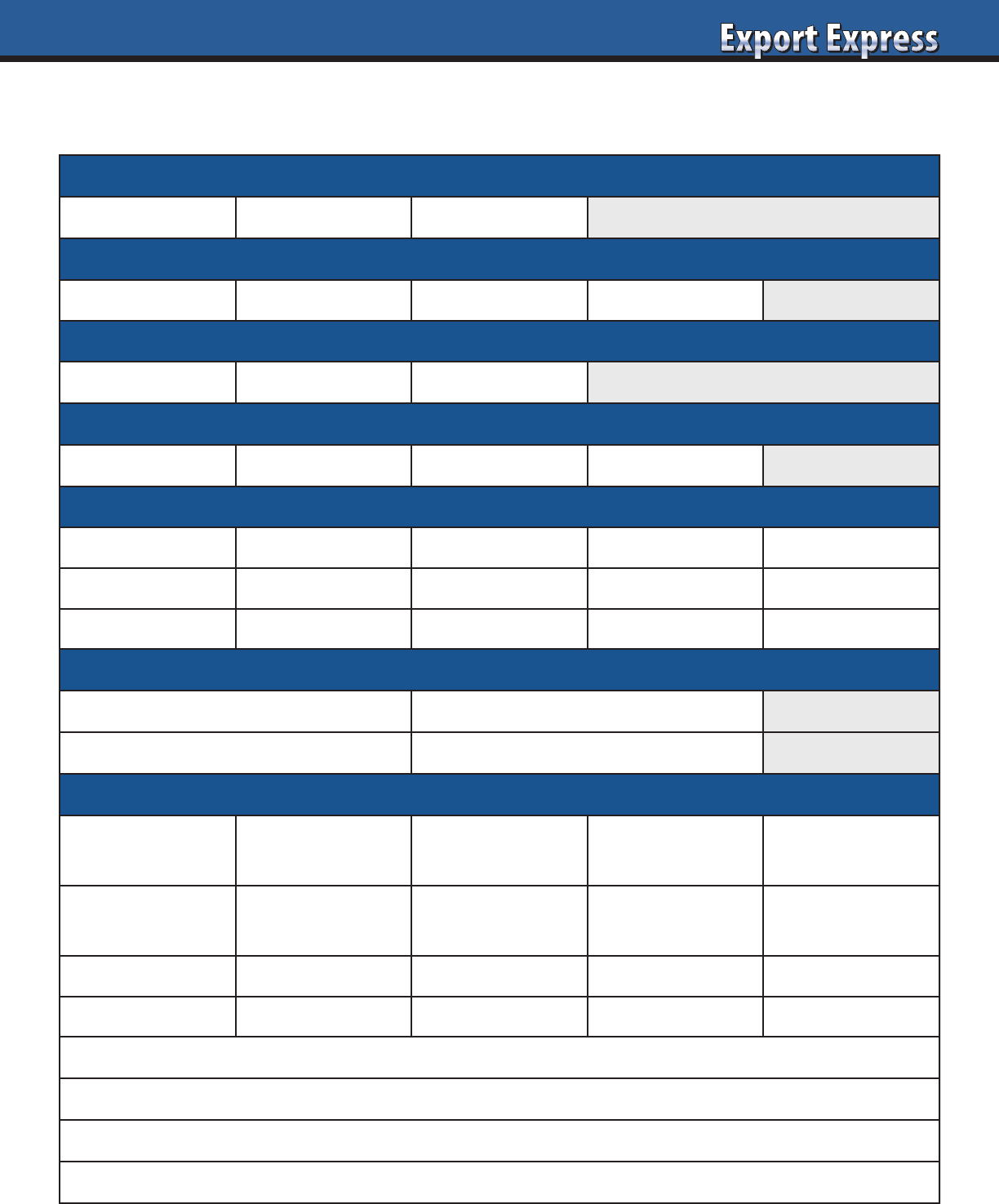
97
Category Review Template* – page 2
(Estimate: Source info from Store Checks, Retailers, Nielsen, Euromonitor)
*Note: please provide your best estimate
Category Size (circle)
Mass Standard Niche
Category Sales Growth (circle)
High 10 % + Average: 3-5 % Flat Declining
Buyer Interest (circle)
High Medium Low
Category Development (circle)
New High Growth Mature Declining
Retail Prices: Top 15 SKU’s/Items at number 1 customer
Item 1 _________ Item 4 _________ Item 7 _________ Item 10 _________ Item 13 _________
Item 2 _________ Item 5 _________ Item 8 _________ Item 11 _________ Item 14 _________
Item 3 _________ Item 6 _________ Item 9 _________ Item 12 _________ Item 15 _________
Shelf Space: Provide Photo’s/Planograms
Typical Section Size: Supermarket # Items: Average supermarket
Adjacent Category 1 Adjacent Category 2
Merchandising (circle)
Typical Percent
Price Reduction
10% 20% 30% Other
Store Flier
Participation
weekly monthly seasonal never
Category displays weekly monthly seasonal never
Special Packs Bonus Packs Pre-Price Free Gift Other
What activity drives incremental category sales?
Category Insights: What’s hot?
Category Insights: What’s not selling well?
Category Summary/Other Insights
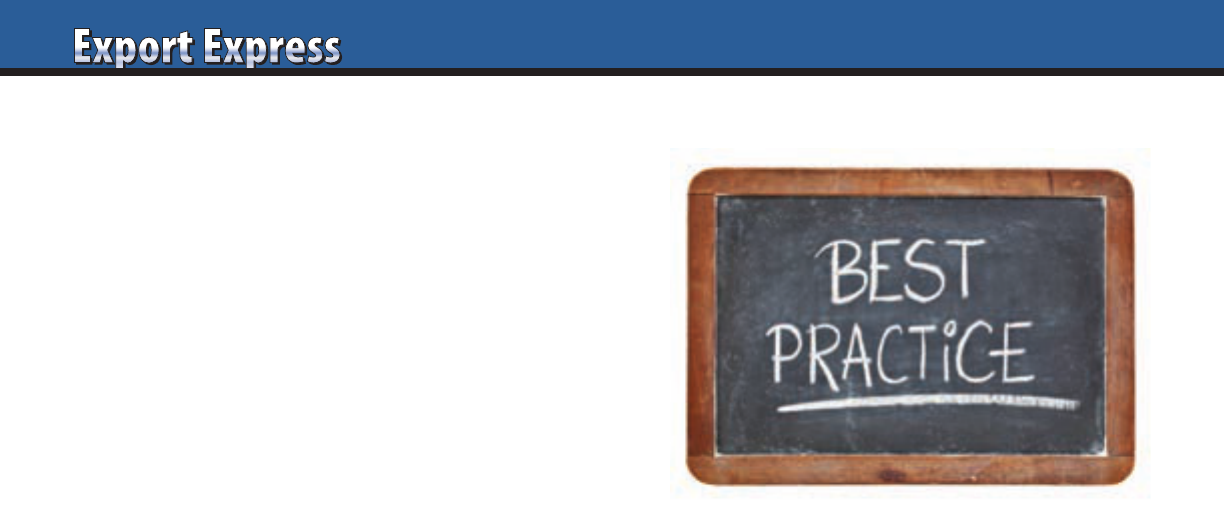
9898
Have you ever experienced an incredible
first meeting with a distributor? Strong
alignment, good fit, everyone smiling,
timelines agreed. Then, nothing happens!
The export manager may take up to six
months to translate his outlook from
“done deal” to “dead deal.” There are
two reasons why this occurs.
First,distributors are positive, competitive
athletes, always striving to win new
business. However, in some cases,
the distributors wake up after time to
reflect and decide they really weren’t
that interested in the brand after all.
Failure also results when a strong
first personal meeting at a trade show
or distributors office is followed by
a relationship buried in email
communication, with no personal touch.
Below are Export Solutions’ Ten Tips on
converting promising new business leads
into tangible business partnerships.
1. Zoom/Teams – Don’t Depend on Email
Motivated distributors still return
phone calls, but frequently receive up
to 200 emails a day, many from existing
brand partners. Top distributors’ business
days are captured by a continuous flow
of meetings with customers, principals,
and their own employees. Best bet is to
call a potential partner or set up Zoom
meetings. Email is okay for routine
correspondence, but too easy to ignore
or delete.
2. Follow Up Immediately & Frequently
Time slips away, as Export Managers
focus on existing businesses and
“problems of the day.” One tip is to put
regular follow up reminders on your
computer calendar.
3. Focus on 10 C’s: Category Review,
Calculation, Cost of Plan, Compliance,
Contract, etc.
Described below are critical elements
to translate a “lead” into shipments.
Category Review: How does your
category look in target country? Category
size, competition,pricing,margins, and
merchandising activity.
Calculation: What is the distributor’s
proposed calculation from your factory
gate to the store shelf? What are standard
costs like duties and taxes? What are
flexible or negotiable like trade discounts
and distributor margin?
Cost of Plan: Each brand needs a plan to
gain market entry. This includes key
account “sell in,”
followed by consumer
and trade promotion
activities. Look at the
distributor’s proposed
plan, as well as several
options with different
price tags.
Compliance: Many
countries feature a
product registration
process and labeling
requirements. In some
countries, this step is
easy with automatic
compliance for a USA or
European brand. Or a
simple solution with a small distributor
applied sticker. In other countries like
Japan or Indonesia, plan on one year or
more to navigate the complex process.
Contract: “Ready, Set, Go” can be
delayed by 3-6 months due to contract
negotiations. Company lawyers demand
20 page agreements in English that even
the Brits can’t understand. Distributors
prefer two page letters of understanding
or a handshake deal. Do what is right
for your business, but expect delays
and frustration.
4. Request References
A good idea is to quickly request
distributor references from other brands
they handle. Motivated distributors will
send impressive references right away.
Also, have your credit department run
a Dun and Bradstreet or Equifax report
as soon as possible. Many trade show
meetings are with “pretenders” who state
exaggerated claims and are ultimately too
small to handle your brand. Better to
discover this sooner versus later.
5. Move Beyond the Distributor Owner/MD
The distributor owner “writes the
checks,” but frequently serves as a
“bottleneck.” The key is to quickly get
your brand assigned to a “worker” whose
task is to move your project through the
system and produce an order!
6. Establish Realistic Timelines
Sync with category review dates and
avoid holiday periods. Update timelines
frequently. New distributor relationships
always take longer. Plan on six months
from first meeting to first shipment.
Be pleasantly surprised if things
move quicker.
7. Distributor Response Time
Signals Interest Level
How often do you check your emails?
Probably every hour. When I work on
distributor search projects for well known
brands like Pringles, Tabasco, or Barilla,
distributor response is lightening fast.
Motivated distributors will chase you
if they are interested because they are
anxious to start selling your brand!
8. Establish Regular Checkpoint Calls
I suggest every two weeks at a minimum.
Use a common document of priorities,
action steps, and due dates.
9. Visit the Distributor
It’s amazing the amount of progress
that will be made during a meeting at the
distributor’s office. Also, the distributor
will work hard in advance of your visit
as your project moves up the priority list
and they want to guarantee a favorable
impression. A visit to the distributor’s
market signals your commitment. Beware
if the distributor is reluctant to schedule
your visit. Either he has changed his
mind about a partnership or his office
and capabilities do not match the bold
promises made at the initial trade
show meeting.
10. Parallel Path Two Candidates per Country
A favorable first meeting represents an
excellent start. However, there are still
many steps (think 10 C’s in point 3)
before you sign a contract and receive
your first order. Always keep two
candidates in the process, in case your top
choice disappoints. This can be tough, but
represents a better option than needing to
start the entire process over again.
Ten Tips: Converting Promising Leads to New Partnerships
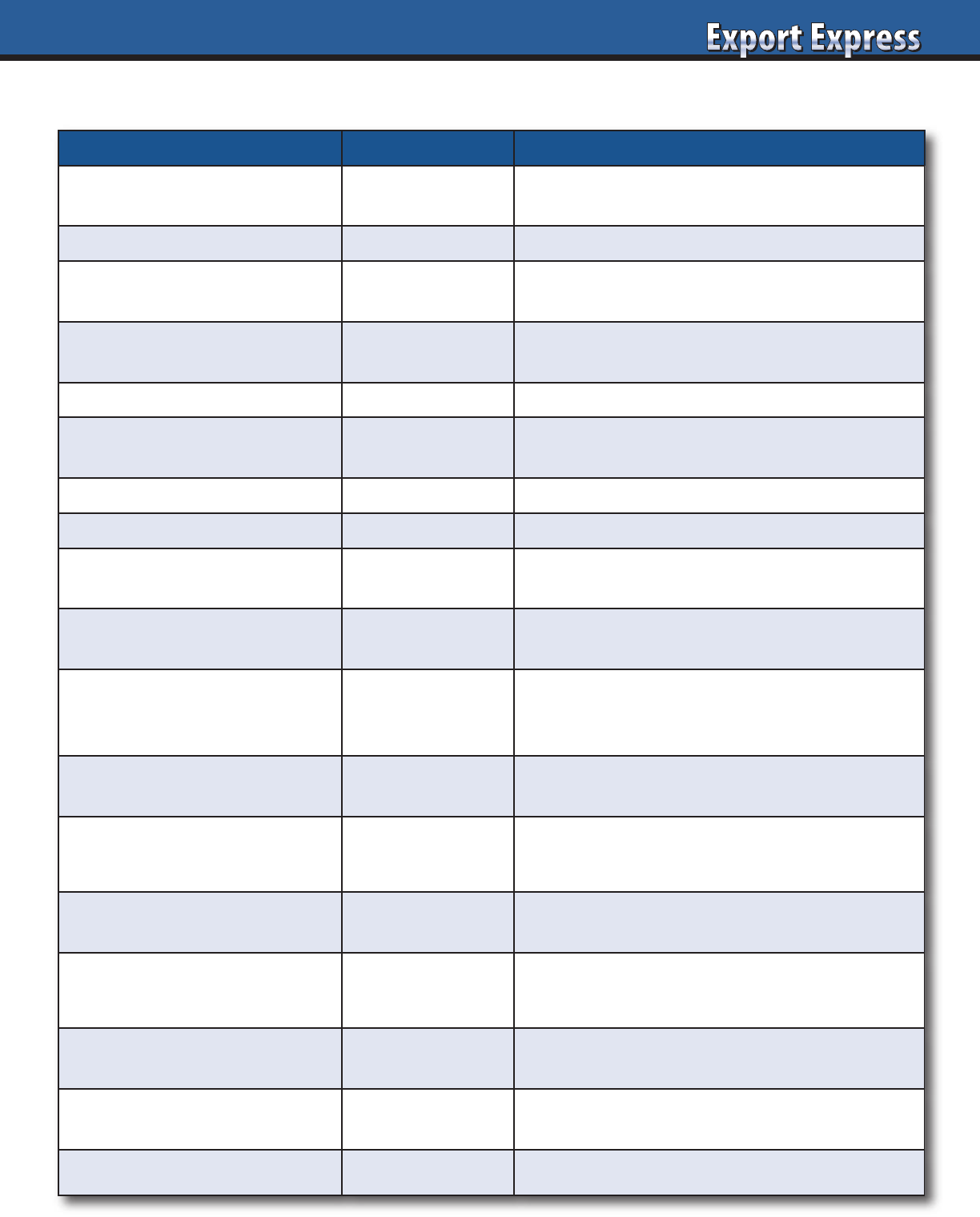
99
Price Calculation Worksheet
Item Amount Comments
List Price (factory or port)
Compare to your domestic list price?
Avoid diverting risk.
Exchange rate Watch bank rate vs. distributor rate.
Freight (sea, truck or rail)
Target full containers.
Consolidation is costly.
Duties
Apply correct Harmonized (HS) code.
Confirm Free Trade Agreements.
Customs clearance, insurance Money and time!
Inland freight: port to distributor
Translate actual costs to case rate.
Avoid flat percentage rates.
Landed Cost
Product Stickering Select countries.
Listing Fees
Flat fee. One time only.
Usually not in calculation.
Marketing fund accrual
Typically, 10-20% of list price.
Part of calculation or manufacturers price.
Distributor Margin
Normal range: 15-35%.
Depends on size, complexity of brand, services,
and “what trade spend is included.”
Other Distributor Fees
Should be part of distributor margin.
Avoid hidden profit centers.
Price to Retailer
Fair and transparent model.
Incentives for large customers, extra performance.
Retailer promotions, incentives,
rebates
10 – 20% depending on the country.
Other Retailer Fees
At times for merchandising or central distribution.
Should be allocated from distributor margin.
Retailer Margin
Global average: 28%
Range: 15% -45% based upon category, brand.
Sales Tax/VAT
Included in price in many countries.
USA sales tax is on top of shelf price.
Consumer shelf price Everyday prices and promotional prices.

100
Picking the right distributor is not an exact
science. I know that each of us experiences
moments of frustration when we question,
“why did we ever pick that distributor?”
Believe me, an equal number of examples
exist where a distributor may share the same
emotion about your company! Frequently,
a partnership is christened by a positive
distributor interview or enthusiastic meeting
at a trade show. Everyone is always in a
hurry to negotiate prices and a contract and
secure the first order. However, in many cases the decision to work together is cemented
without a formal business plan where expectations, road map, and KPI’s are established.
Unfortunately, one year later both parties may find themselves pointing fingers at each
other due to disappointing results.
I recently completed a distributor search project in the Middle East. We interviewed a
number of good candidates and identified two with high potential. Last month, I was
notified by the export manager that he selected one of the candidates. I supported his
decision, but questioned how the plan proposals for the two distributors compared?
The vague response confirmed no plans, just that he liked one distributor better.
This year, another project brought me to a country where a new distributor had been
appointed less than one year earlier. Initial results were severely below expectations.
The first question I asked the brand owner related to the reconciliation versus the
original one-year business plan. What happened? In this case, there was general
understanding about the direction of the partnership, but never alignment around
a one-page scorecard with KPIs and a logical road map.
Launching a new distributor relationship is like the birth of a child. A mother rarely
leaves the side of a baby, providing comfort, safety, and nutrition until the infant is
healthy and able to survive without constant oversight. The same philosophy must
apply to a distributor partnership. During the first few months, there must be frequent
communication, care and visibility from the supplier with the new “brand parents.”
This approach results in a healthy brand. Too many times, I see a new distributor
appointed without anyone from the manufacturer committed to visit the country
for the sales launch meeting or conduct a retail sales audit within the first sixty days.
Parents bring their newborn to the doctor frequently for checkups.
Listed below are Export Solutions’ tips on creating a clear annual plan for each country
and distributor partner.
1. Select new distributors based upon the quality of their year one plan:
targeted listings, volume forecast, and retail penetration.
What is their written commitment and timeline for achievement?
2. Current distributors should also have a confirmed one page plan.
Merchandising events, new listing targets, spending, and shipment targets.
Many brand owners treat distributors as good customers which is a smart approach.
The distributor is paying your invoice, not a retailer. Successful distributor partnerships
thrive when both parties are aligned and committed to a simple, one-page plan.
Looking for a sample format? I’ve prepared a one-page business plan template that
is freely available in the Export Tips section of my web site or simply email me.
What is your annual plan for each country?
www.exportsolutions.com
Greg Seminara
gseminara@exportsolutions.com
404-255-8387
“Spend Time Selling to Distributors versus Searching for Distributors”
What is the Plan?
Strategic Services
Contact Us for
Export Solutions
1. Identify Best in Class
Distributors: 96 Countries
2. Best Practices
Export Strategy
3. Distributor Management
Workshops
4. Export 101:
Let’s Get Started
5. New Market
Prioritization
and Launch Plan
6. Personal Distributor
Introductions:
96 Countries
7. Walmart International
8. Distributor Contracts,
Margins, and Fees
9. Meeting Speaker
10. International
Strategy Expert
Strategic Services
Contact Us for
Export Solutions
1. Identify Best in Class
Distributors: 96 Countries
2. Best Practices
Export Strategy
3. Distributor Management
Workshops
4. Export 101:
Let’s Get Started
5. New Market
Prioritization
and Launch Plan
6. Personal Distributor
Introductions:
96 Countries
7. Walmart International
8. Distributor Contracts,
Margins, and Fees
9. Meeting Speaker
10. International
Strategy Expert
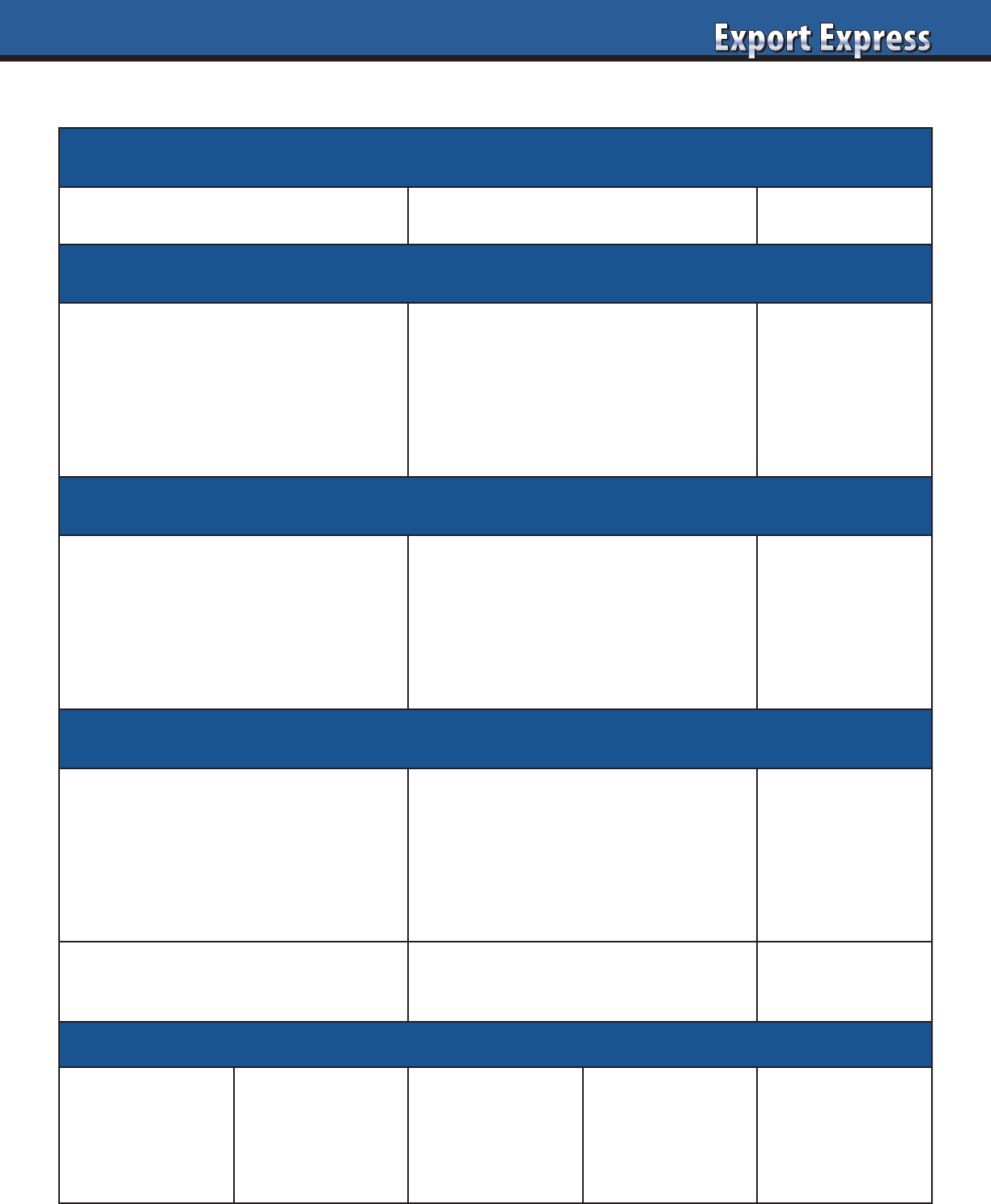
101
Launch Plan Proposal – Year One*
Brand Objective
Volume: _______________ Wtd. Distribution: _______________ Share: ________
Consumer Marketing Activities
Activity
1.
2.
3.
Rationale Cost
Trade Marketing Activities
Activity
1.
2
3.
Volume Cost
Listing Fees
Customer
1.
2.
3.
# SKUs, Space, Promotion Support Cost
Total Year One Volume Total Year One Cost Wtd. Distribution
Distribution Achieved with Above Spend Level
Customer
1.
2.
3.
Stores % Country # SKUs Volume (annual)
*Feel free to attach other pages to support your recommended launch plan.
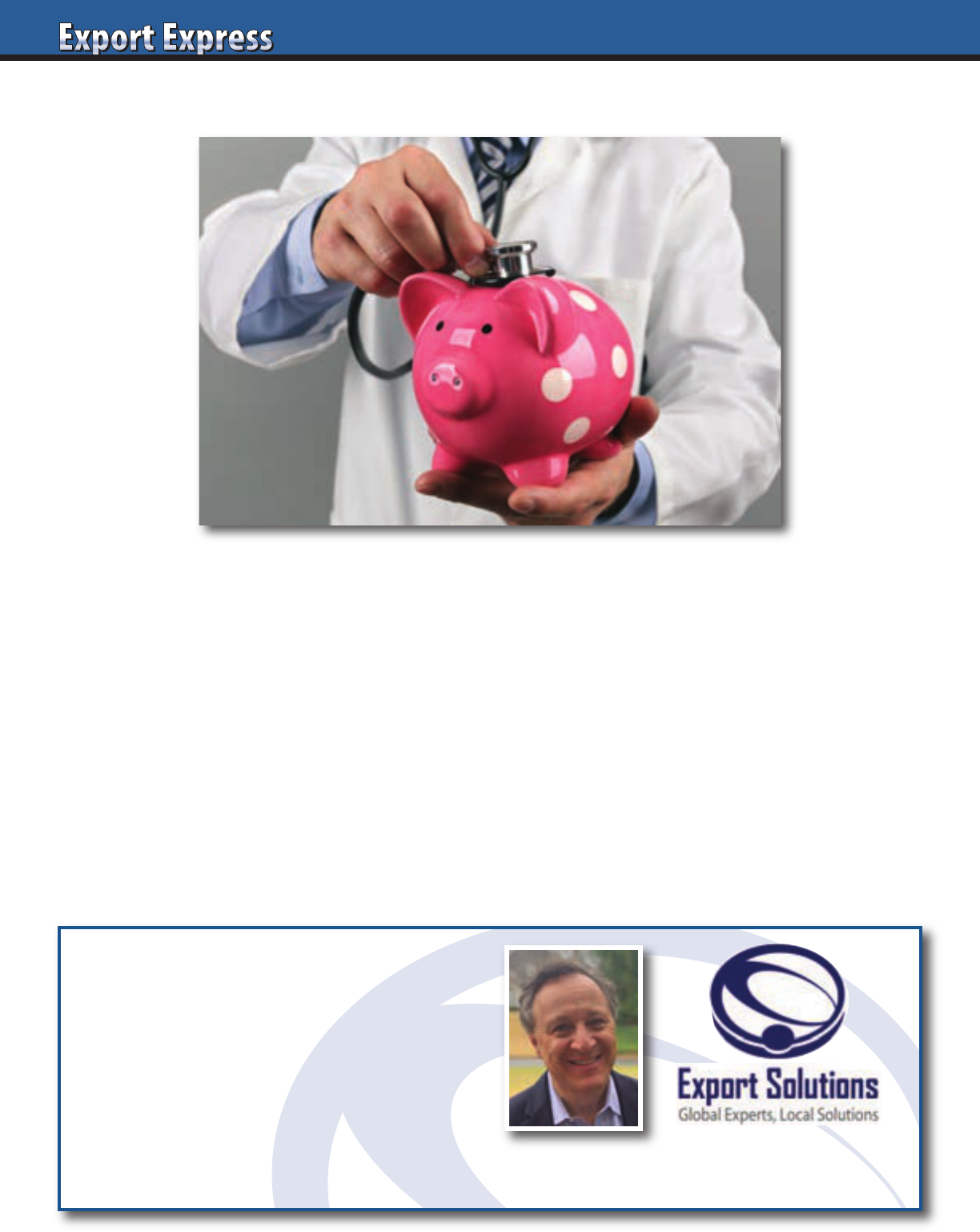
102102
Does Your Distributor Network Need A Check Up?
Export Solutions Can Help!
• Distributor Network Assessments
• Motivational Speeches
• International Strategy
• Find Distributors in 96 Countries
Contact Greg Seminara at gseminara@exportsolutions.com or (001)-404-255-8387.
www.exportsolutions.com
Exporters manage distributor networks extending to 20, 50, 70 countries or more!
Every company has a few distributors that under perform.
“Under achievers” prevent us from attaining our personal objectives.
Distributor Network Check Up
• Independent assessment from Export Solutions
• Establish methodology for ranking Best in Class distributors and “Laggards”
• Supply strategies for recognizing top distributors and upgrading
the bottom performers
• Benchmark external brands from your category
• Practical and “action oriented” approach
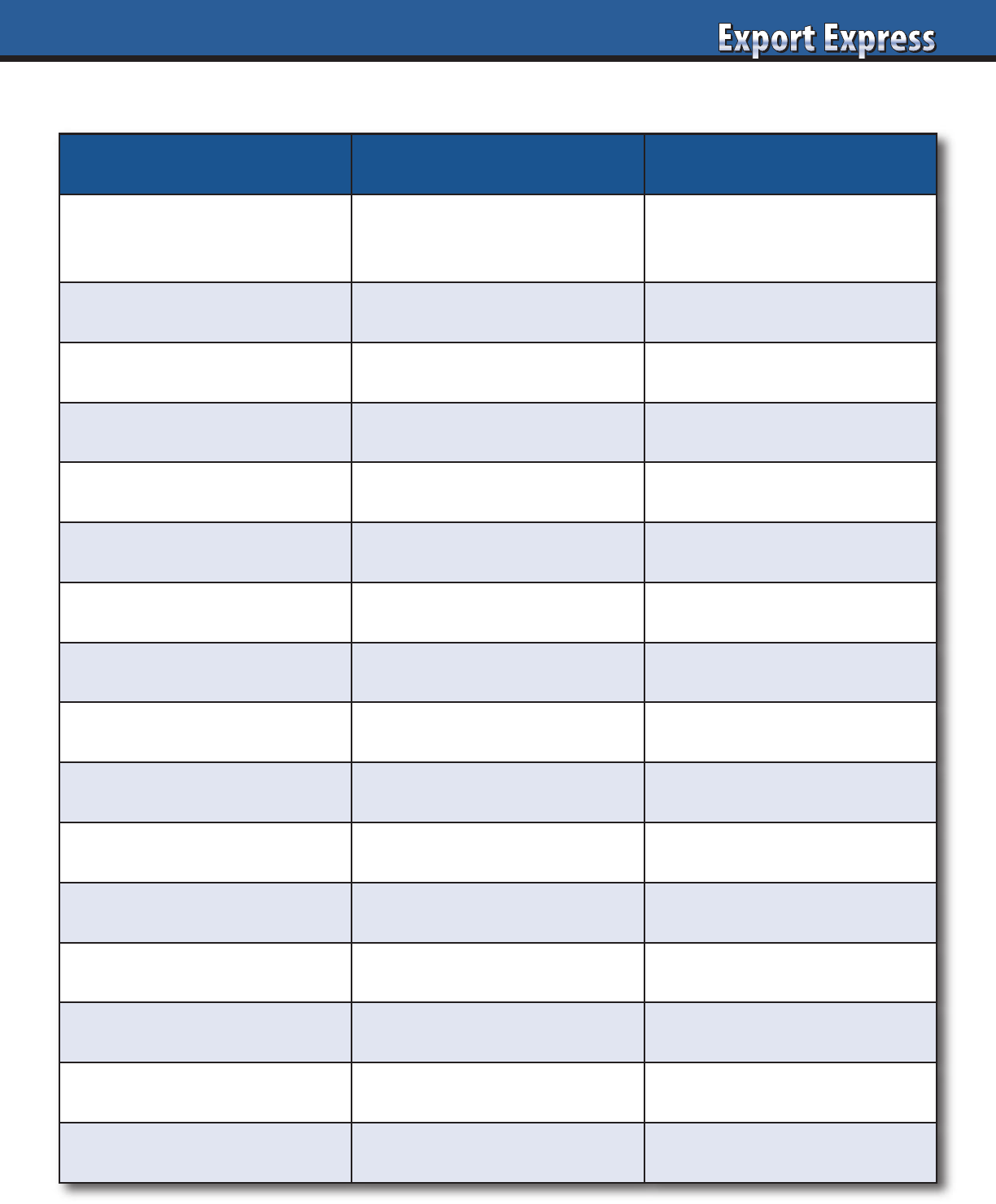
103
New Country Launch – How Long It Takes
* Some activities may be completed concurrently
Minimum Typical
Research Distributor
Candidates, Schedule
Meetings with Lead Time
2 weeks 4-6 weeks
Distributor Meetings 2 days 1 week
Post Meeting Due Diligence 1 week 4 -8 weeks
Distributor Appointment 1 week 4-8 weeks
Labeling Compliance already compliant 12-26 weeks
Product Registration* 1 week 4 -12 weeks
Business Plan Development* 1 week 4 weeks
Contract/Agreement* 1 week 4-8 weeks
Initial Order Arrives 3 weeks 4- 8 weeks
Key Account Calls 1 week 2- 4 weeks
Key Account Acceptance 1 week 4-8 weeks
Retail Placement 2 weeks 4-8 weeks
Marketing Starts 1 week after retail availability 4 - 8 weeks
Consumer Sales
Repeat Purchase
Total 6 Months One Year
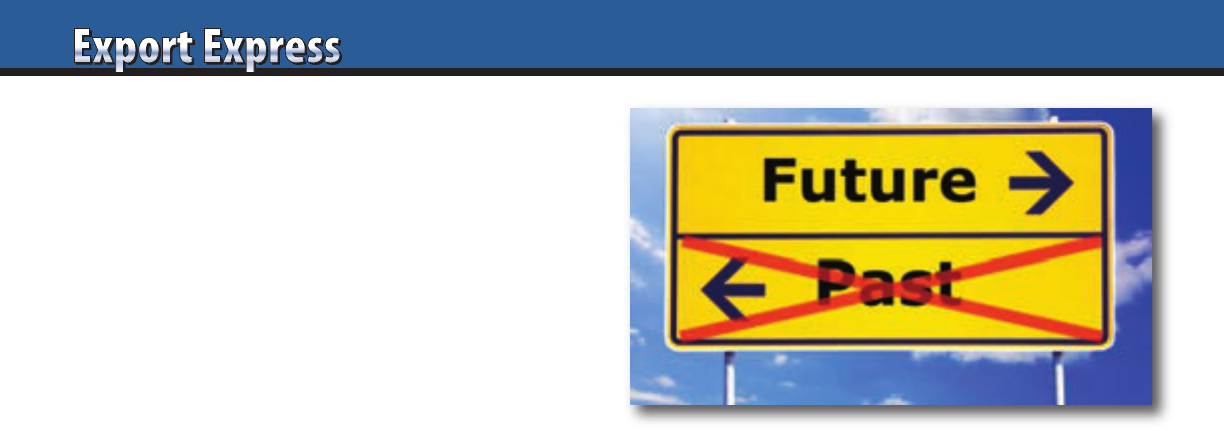
104
Changing distributors is a messy business, filled with hurt
feelings, business disruption, and legal implications. The good
news is that when you have transitioned to a new distributor,
you will benefit from the enthusiasm and commitment of a highly
motivated new partner. Recapped below are Export Solutions
Ten Tips for managing the process of changing distributors.
1. Secure Agreement on Distributor Change
from your Senior Management
In many cases, a terminated distributor will reach out to your
company president or owner to appeal your decision. It makes
sense to brief your management on the situation and your
rationale for the change. If they are not aligned with your point
of view, better to learn in advance of creating a disturbance with
a distributor termination notice that could be retracted.
2. Long Term Distributor vs. Short Term Distributor?
Your approach at handling the process will vary based upon
the length of time of your partnership. Dissolving Long term
relationships (5 years or more) requires careful handling,
documentation of situation, and consideration of marketplace
repercussions. Ending short term partnerships is usually less
complex, as it is normally clear that mutual objectives are not
being met.
3. Probation Period
Putting a distributor on probation sends a warning signal
that termination is possible. Normally, probation periods last
3-6 months and include specific objectives to achieve during
the target period. This approach gives the distributor a “second
chance” to meet expected standards. Termination following a
probation period reduces the risk of a distributor complaining
that “he didn’t know that your company was that unhappy
with his performance.”
4. Check Your Contract
Distributor contracts outline termination process and procedures.
The contract will guide required steps to make a distributor
change. Contract terms are negotiable, particularly when a
distributor relationship is ending by mutual consent. In certain
cases, there may not be a contract which naturally provides a
brand owner greater flexibility. On the other hand, you still must
consider local laws and business practices which may be in place,
even without a contract.
5. Review Local Laws
Many countries have well defined laws regarding termination
of distributors, brokers or “agents.” These laws often dictate a
compensation formula for payments due to the distributor. The
legal rationale relates to the concept that the distributor invested
his own resources to build awareness and “good will” for your
brand in his country and must be compensated for this
investment. Puerto Rico’s Law 75 applies even when there is no
contract signed and only one direct shipment to a local Puerto
Rico distributor or agent.
6. Document Inventory in the Supply Chain
This includes current inventory, orders en route, and pending
orders. One of the biggest issues in any distributor change revolves
around inventory management. Angry terminated distributors may
attempt to “forward buy” or fill the market with discounted goods.
Or they may refuse to transfer inventory to the new distributor.
I have also seen cases where the old distributor attempts to transfer
damaged or outdated inventory to the new distributor.
7. Conduct New Distributor Identification Activities
These should be in process or completed prior to termination of
the under-performing distributor. This will allow you to minimize
the time between termination notification and transition to a new
distributor. It is likely that your current distributor may learn that
you are “interviewing the market” to understand alternatives.
This is all part of the probation process and may further stimulate
the distributor to ramp up his performance levels.
8. Minimize Notification Periods – Contract Buy Out?
Contracts may specify a 3 month to one year notification period
for a terminated distributor. A Brand owner should not want a
terminated partner representing his business any longer than
they have to. The risk to the brand is too high. I prefer 1-2 month
transition period, even if a brand owner is required to “buy out”
the last few months of a contract. It is better for everyone to move
on for a fresh start as quickly as possible.
9. Trade Notification Strategy
It is likely that some customers will be upset with a decision to
make a distributor change. The good news is that “they will get
over it.” On the other hand, it is important to identify potential
sensitive accounts and for the brand owner and the new account
handler to have a prepared response for an unhappy customer.
10. Fast Start Program – Six Months
Your new distributor will be highly motivated to get off to a fast
start to make a strong initial impression. We need to balance this
desire to run fast to “sell” with the critical steps of focusing on
the fundamentals: Sufficient inventory throughout the supply
chain, update new vendor information in customer’s order
management system, education of the sales force on product
benefits etc. “Crawl, Walk, Run.” Normally, the process takes six
months to successfully complete a transition to a new distributor.
Future
Distributor change used to represent a challenging proposition
due to the lack of information on alternate distributor candidates.
Export Solutions database tracks over 9,200 distributors in
96 countries. This translates to an average of around 85 different
distributors for each market. This has eased the process of
identifying alternate candidates when distributor change is being
considered or required. Visit www.exportsolutions.com/distributor
Directory.aspx for more information.
Ten Tips – Changing Distributors:
“The Right Way”
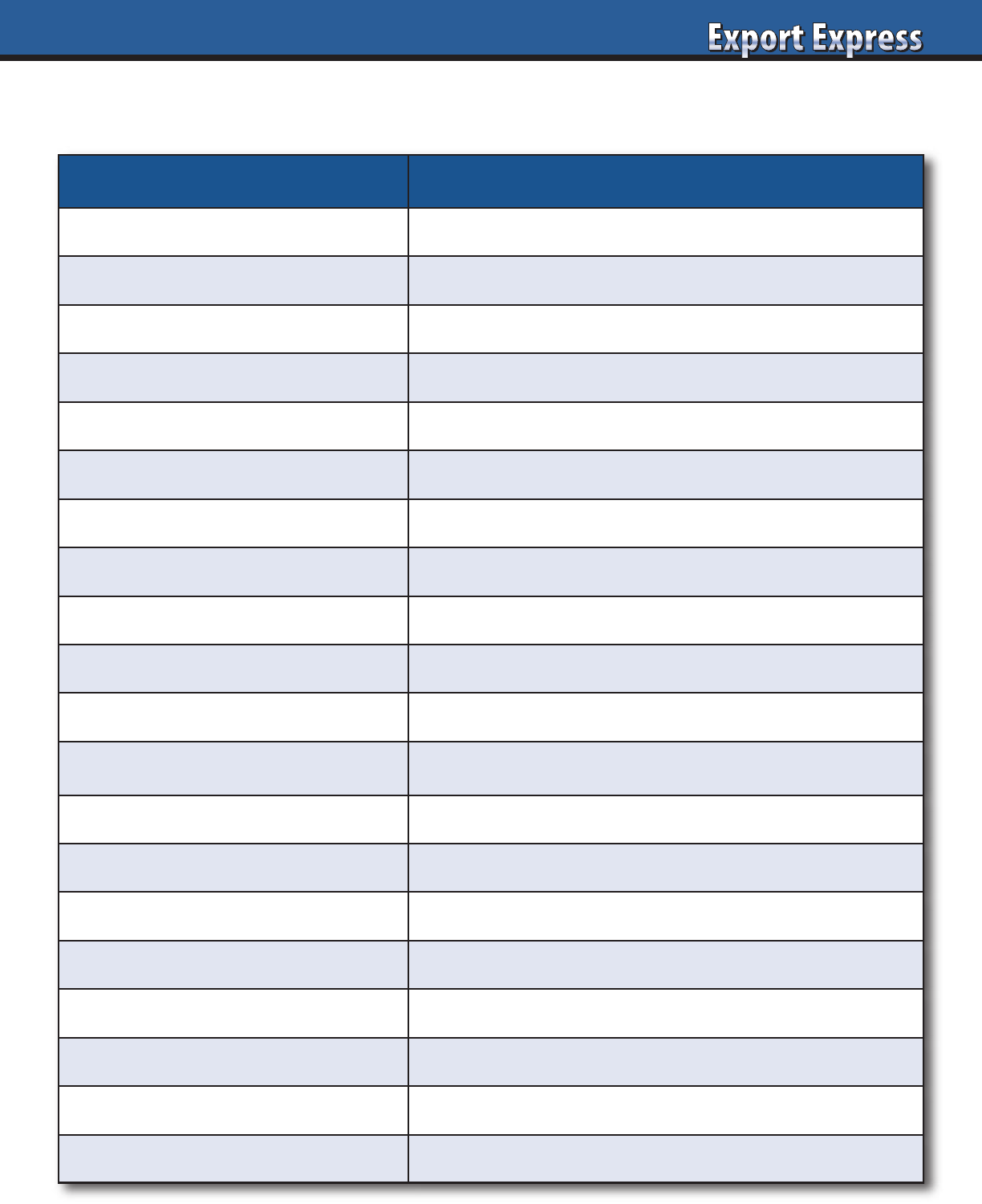
105
20 Tips to Accelerate a Mature Business
Activity Strategy
Creative Promotions
Retailer specific events. Offer fresh ideas.
Distributor Brand Manager
Upgrade talent. Secure “A” players on your business.
Pricing
More profit through higher volume at lower price?
Country Manager
Hire local manager or assign HQ person for 3-6 months.
Local Production or Copacker
Lower cost structure with added complexity.
Brand Ambassadors
Hire team with “brand uniform” to sample at local events.
White Space – Distribution
Fill voids on retailer listing map: Top 10 customers.
Social Media
Partner with influencers. Targeted local investments.
New KPIs
New measures: Listing maps, shelf placement, etc.
E-commerce Development
Invest to lead in this emerging channel.
In-Store Visibility
Educate and measure team on in-store presence goals.
Sampling, Sampling, Sampling
Aggressive distribution of free sample size.
Distributor Team Linkage
Zoom/Teams contact with Key Account Managers, etc.
Launch NPD Innovation
Excite team to launch innovation “The Right Way.”
Distributor CEO
Treat CEO as VIP. Create special relationship.
Sponsorship
Support local events and retailer charities.
Sales Contest
Excite and motivate retail sales team.
Alternate Channel Focus
Small shops, foodservice, duty free, drug stores.
High Spend Test
Will heavy up marketing or trade discounts drive sales?
Distributor Change
Motivated new team, high energy to solve old problems.
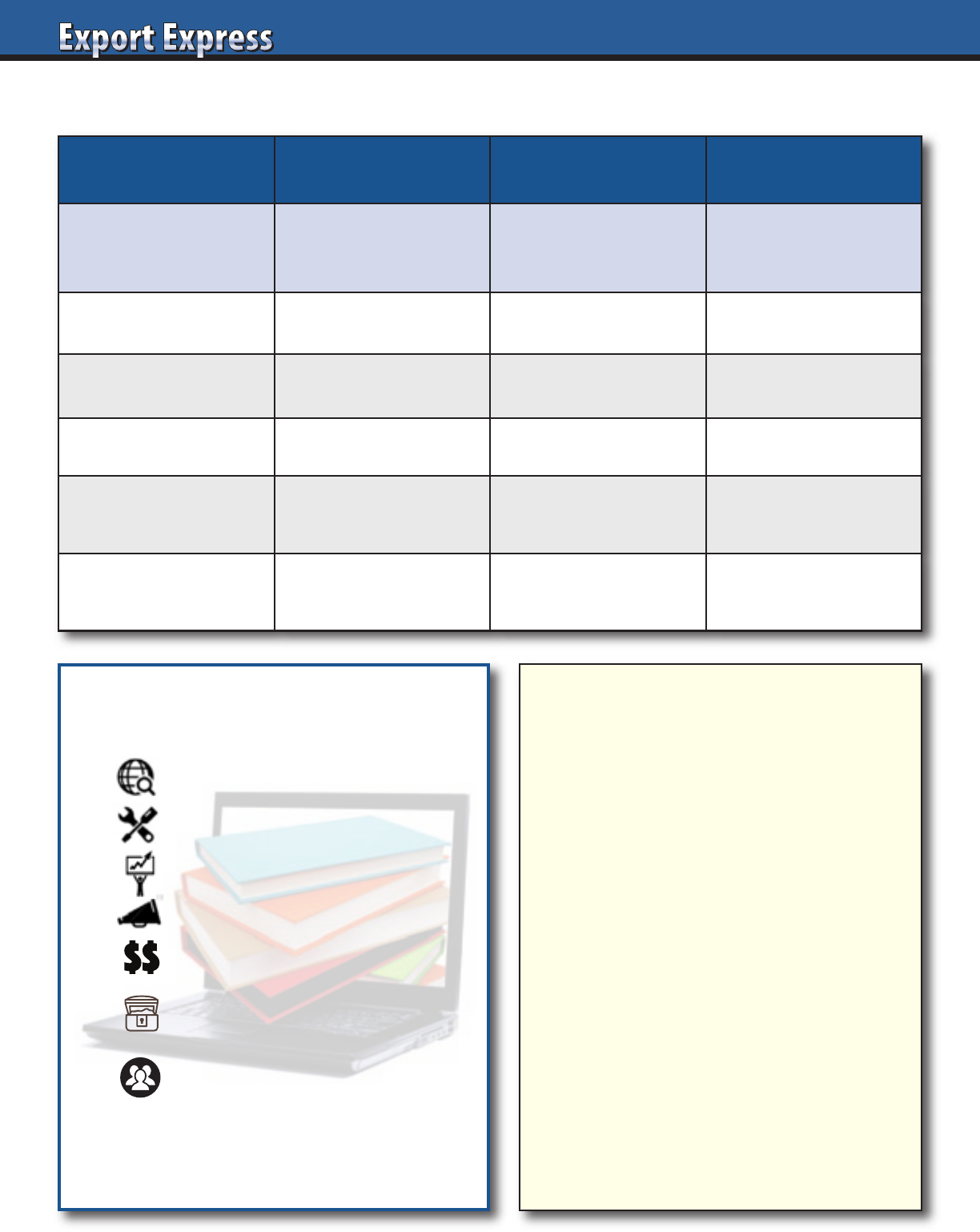
Distributor Trader Buyer
Services
Brand Builder of
third party brands
Buys and sells
products
Purchases direct
for supermarkets
Joint Business Plan Core No No
Retail Merchandising Yes No Shelf stocking only
Consumer Promotion Yes No Price reduction only
Focus Brand Building Short Term Profit
Lower prices through
Direct purchase
Issues
Many brands
needing attention
A local Distributor
handles most work
How to sell
to other market retailers?
Your Partners: Brand Builders vs. Buyers?
106
Six Steps Before You Hire
a New Distributor
3
Reference Check with their existing
brand owners
3
Store visit to view in-store presence
for current brands handled
3
Call at least one retail buyer for
a reference check
3
Conduct a credit check through
Dun & Bradstreet
3
Search local legal records for lawsuits
against the company or owner
3
Secure independent local legal input
to the validity of your contract
Create Your Own
Export Library
All Guides available free at
www.exportsolutions.com
in the Export Tips section.
Distributor Search Guide
Export Handbook
Selling to USA Handbook
Distributor Management Guide
Finance & Logistics
Export Treasure Chest
My Favorite Templates & Forms
People Power
Strong Teams Build Great Brands

107
10 C’s
1. Case
Manufacturer supplies a business case
confirming brand “aspirations” for the
country: Key items in portfolio, estimated
base pricing, volume/market share
expectations, and investment model.
2. Category Review
Distributor supplies a local review
of category competitors, pricing,
and merchandising practices.
3. Capabilities
Distributor shares detailed organizational
capability and customer coverage.
Could include references from existing
suppliers represented. An important step
when there are two or more candidates
under consideration.
4. Commitment and Costs
What is the Year 1 Plan and Forecast?
Targeted listings, marketing activities,
launch budget and volume estimate
associated with the spending plan.
5. Calculation – Value Chain
Line by line, build up from port to retail store
shelf. Include currency assumptions.
6. Compliance
Highlight product registration and
label requirements. Typical timelines
for compliance?
7. Captain of Team
Who will be our day-to-day brand manager or
first point of contact? Which senior executive
will serve as our “Brand Champion?”
8. Contract
Options include formal contract, letter
of understanding, or handshake deal.
Begin this process early!
9. Consumer Marketing
What are planned activities to generate
consumer trial and repeat purchases?
Trade marketing, consumer marketing,
social media, etc.
10.Calendar /Close
Distributor supplies a detailed timeline
of all activities. When can we expect first
order and delivery to support launch?
Frequent checkpoint calls or meetings.
From First Meeting to First Order – Cooperation Model
Export Solutions answers the question, “where do we go from here?”
Cooperation Model describes the follow up process from positive initial meeting to launch plan strategy.
Contact Greg Seminara at greg@exportsolutions.com
for a free copy of our Distributor Cooperation Model Guide.
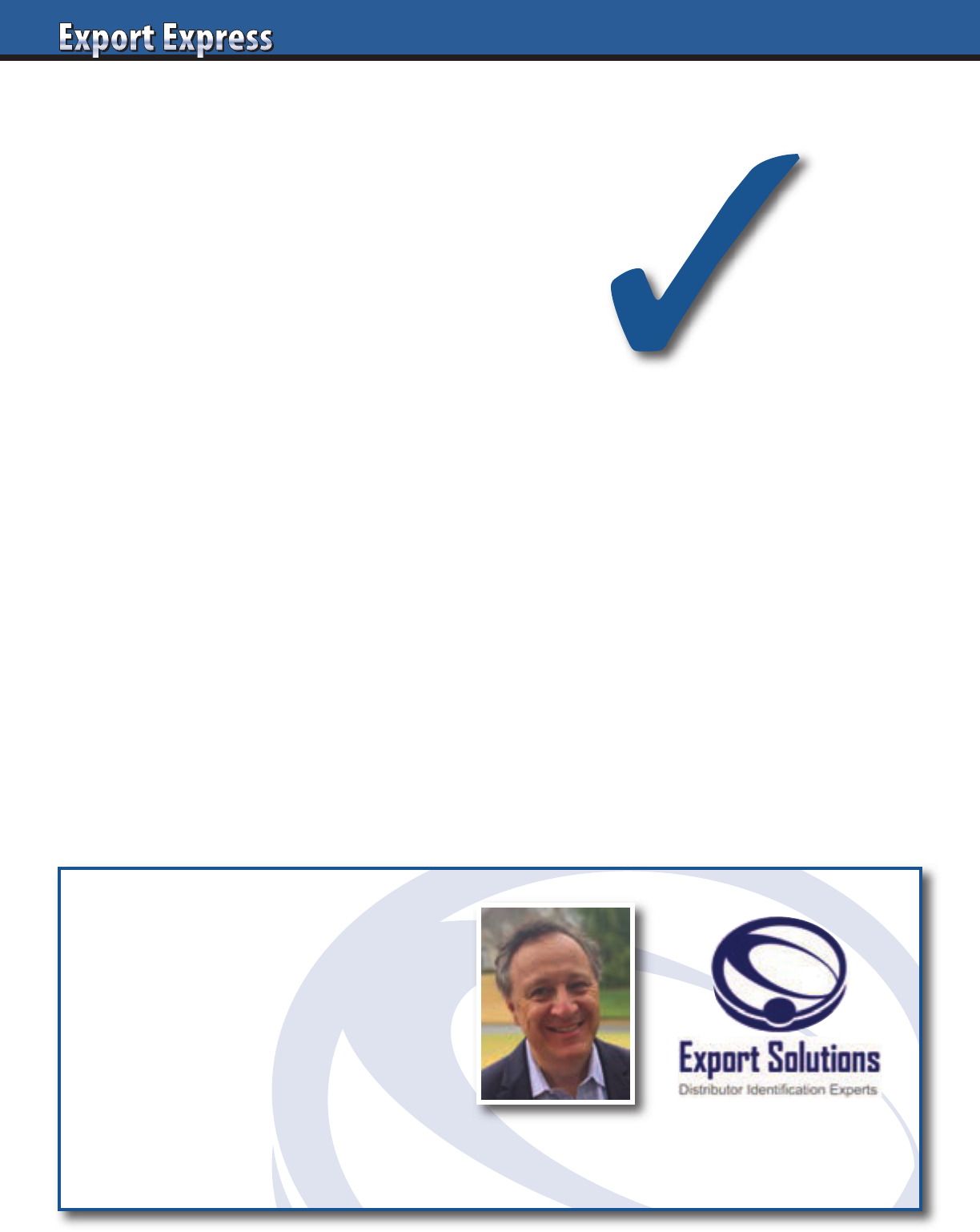
108
Export Solutions’ New Distributor Checklist
____ Contract/Agreement
____ Price Calculation Model
____ Business Plan: objectives, marketing,
spending, key dates
____ Category Review: Pricing, Shelf,
Assortment, Merchandising
____ Label Compliance
____ Shelf Life
____ Order Lead Time
____ Minimum Order
____ Pick up Point
____ Payment Terms
____ Payment Currency
____ Damage Policy
____ Product Registration
____ Forecast: Year 1
____ Pipeline Order & Inventory
____ Brand Facts
____ Product Samples
____ Appointment Letter
____ Brand Specifications in System:
Distributor & Customers
____ Training: Key Account Managers,
Retail, Administrative Staff, Warehouse
____ In Store Standards: Pricing, Shelf
Management, Merchandising
____ FAQ’s/Handling Common Objections
____ Key Account Presentation
____ Customer Appointment Dates
____ Category/Business Review:
Tailored to Each Key Account
____ Retail Sales Contest
____ Checkpoint Calls
____ Market Audit Date
____ Reporting: Track Distribution, Pricing,
Shelf Positioning, Merchandising, etc.
Talk to an Expert
• Find Distributors in 96 Countries
• International Strategy Road Map
• Fix Problem Markets
• Entry Plans
• Export Workshops
• Motivational Meeting Speaker
Contact Greg Seminara at (001)-404-255-8387 to discuss your business development project.
www.exportsolutions.com
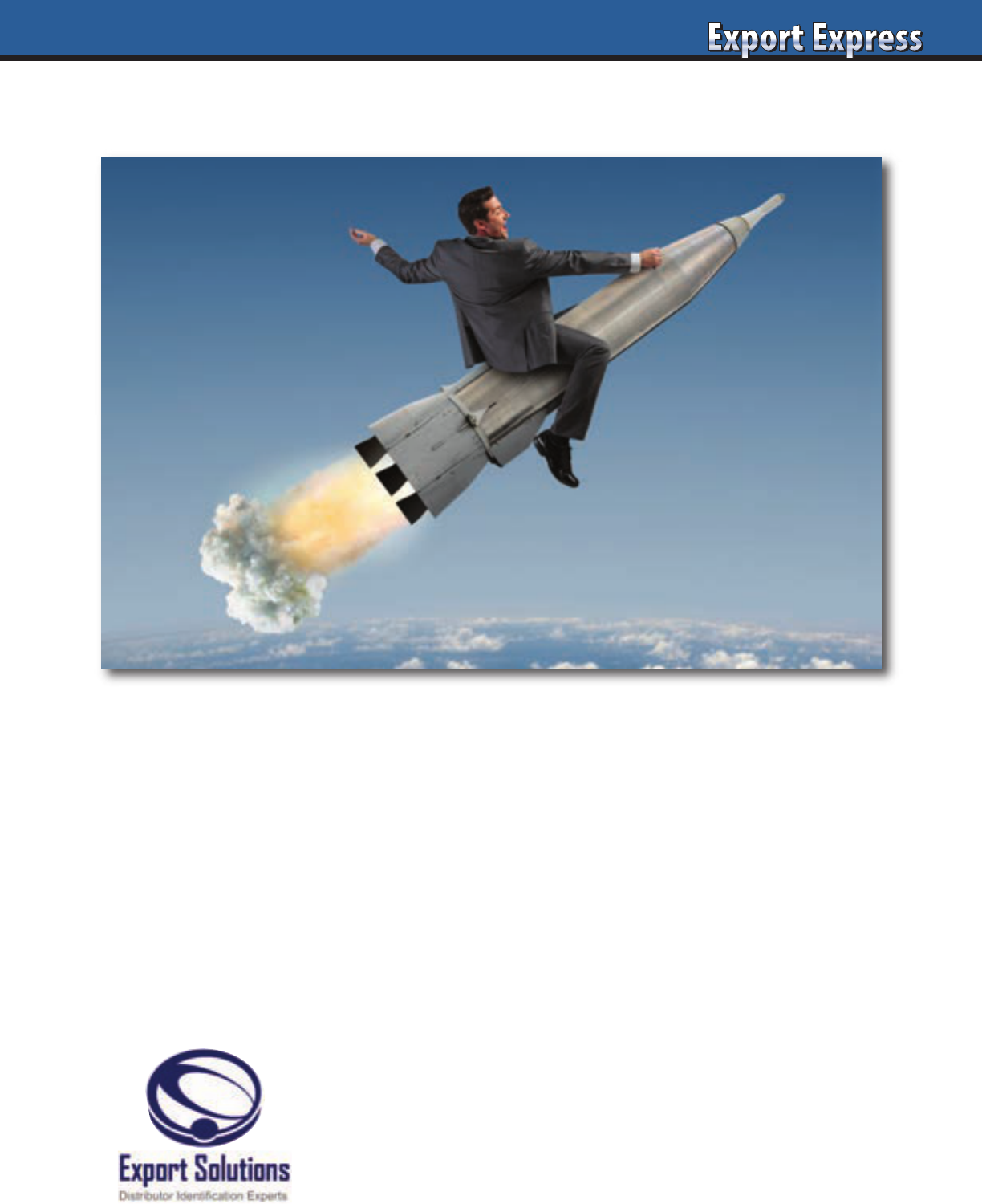
Export Accelerator
Contact Us for Distributor Search Help in 96 Countries
Greg Seminara • greg@exportsolutions.com
“Spend time Selling to Distributors versus
Searching for Distributors”
109
Why have Barilla, Pringles, Nature Valley, Starbucks, Duracell,
Nestlé, Tabasco, Pepperidge Farm, and other leaders used
Export Solutions as a distributor search consultant?
• Powerful distributor network: owner of industry database
9,200 distributors – 96 countries
• Professional 10 step due diligence process
• Results! We make Export Managers’ lives easier!
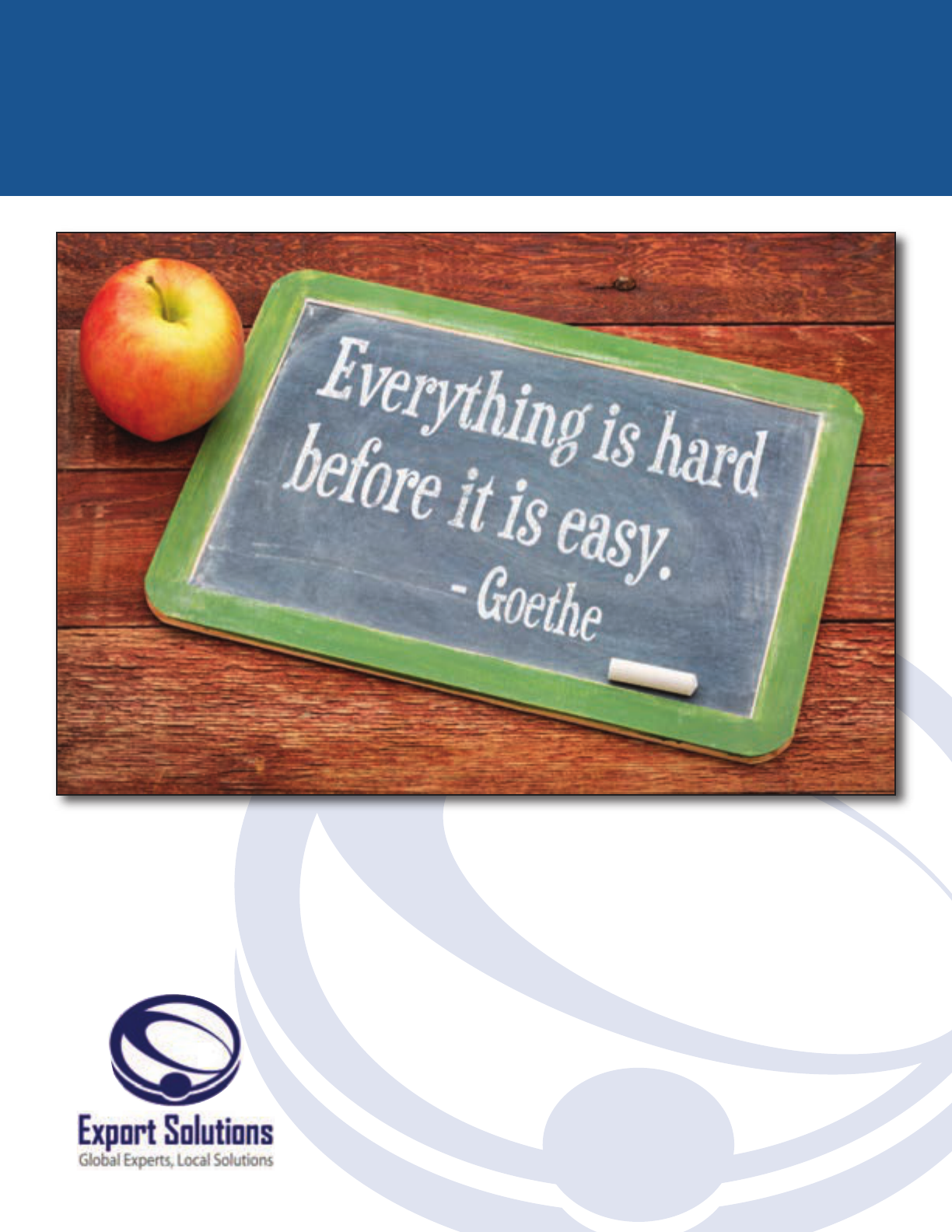
Are You Ready for Export?
Are You Ready for Export?
Export Boot Camp
by Greg Seminara
There are 196 countries in the world.
How many are you selling to?
110

Dear Greg
“I am very grateful for the excellent training we were able to set up with your support in Parma last
month. The program proved extremely helpful, rich with insights and experiences that we were
striving to deliver to our key people in international markets.
The session allowed us to cover broad & strategic issues, such as country segmentation &
prioritization, as well as very specific and practical issues, such as the distributors’ business models,
drivers of distributors’ performance and how that can be influenced by the brand owner, to how to
improve performance in the “moment of truth,” with the “more in the store” section.
I therefore wish to take the occasion to thank you again for your important contribution, and am
also very glad to mention that, as we do for all trainings done in the Barilla Lab Learning Center, your
program was subject to a post evaluation from all participants, and that it scored among the highest
programs taken in these past few years.”
Barilla
Director, Export Markets
“At our ESMA annual convention – the summit of the distributor industry in FMCG in Europe – we
share thoughts and invite speakers of significance. Greg Seminara was invited to speak about his view
on the development of distributors and the elements in the marketing mix of relevance to this business
sector. Greg impressed his audience with his vast knowledge, his ability to communicate and some
clear thoughts about the drivers behind results. The feedback to his speech was excellent and
participants highlighted his hands-on understanding about our business.“
CEO – ESMA
European Sales & Marketing Association
About Greg Seminara
Greg Seminara founded Export Solutions in 2004 after a career with Procter
& Gamble, Clorox, and the leading USA Food Broker. This included positions
based in the USA, Saudi Arabia, and Argentina. Credentials include:
• Creator of industry distributor database: 96 countries, 9,200 distributors
Categories: Confectionery/Snack, Gourmet/Ethnic, Beverage, Italian Foods
• Author/Publisher of Export Express Newsletter (circulation: 9,900)
• Author/Publisher: Export Strategy Guide, Distributor Search Guide, Selling to the
USA, Distributor Management Guide, 300 Tips for Export Managers, and more than
200 articles on export development and selling through distributors.
• Completed 400+ Distributor Search projects in 48 countries - 5 continents
Testimonial
Testimonial
Export Boot Camp Overview
• One day program to get your company Export Ready
• 8 Export Development & Distributor Management Modules
• 25 Common Export Problems work session
• 150 Export topics available for tailored workshop
• Includes annual subscription to Export Solutions Distributor Database
111

Sample Boot Camp Agenda
Topic Core Themes
Strategic Export Development
• Country Prioritization
• Entering Emerging Markets
• Different Partner/Spending Models
Export Ready
• Best Product Prospects
• Labeling/Registration
• Government Resources
Finding New Distributors
• 10 Step Distributor Search Process
• Best In Class distributor versus Average
Distributor Economics • Distributor Financial Model/Watch-Outs
Creating Your Export Plan
• Developing a target country list
and action plan
Export Plan Implementation • Distributor contact plan and technique
25 Common Export Problems • Anticipating and handling issues
Dear Greg,
“We would like take this opportunity to thank you for the good quality result of the export
development seminar hosted by Italia del Gusto. The workshop has received an enthusiastic response
from all the participants. We have really appreciated your expert information on core topics of strategic
export development, distributor identification, and getting more out of current partner relationships.
Based on the seminar’s success, we look forward to further collaboration.”
General Director, Consorzio ITALIA DEL GUSTO
Italia Del Gusto is a consortium of many of the leading food & beverage brands of Italy: Auricchio, Bauli, Barilla,
Bolton Group, Colussi, Filippo Berio, Lavazza, Ponti, San Benedetto
Testimonials
112
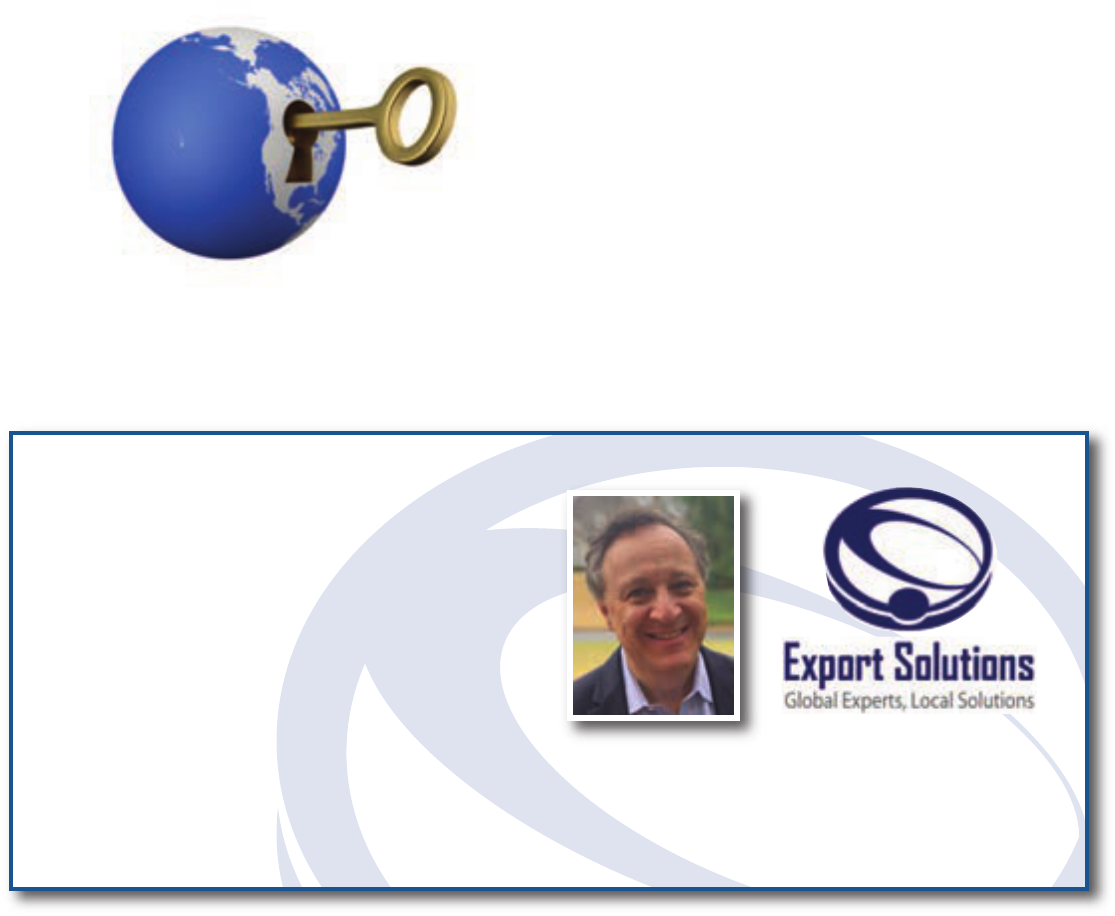
• Boot Camp produces realistic Export Development plan:
Priority Countries, Distributor Candidates, Pricing, Launch Strategy.
• Participants may include export manager or your entire team.
• Includes annual subscription to Export Solutions Distributor Database.
Export Solutions database covers 96 countries and 9,200 distributors of supermarket brands.
• Program offered to companies of all sizes. Export provides new, incremental sales
in high growth countries with large populations.
• Basic Boot Camp fee is $3,500. Extra travel fee may apply.
• Options for ongoing export support.
• Contact Greg Seminara at gseminara@exportsolutions.com for more details.
Export Solutions Can Help!
• Export Workshops
• Motivational Speeches
• International Strategy
• Find Distributors in 96 Countries
Contact Greg Seminara at gseminara@exportsolutions.com or (001)-404-255-8387.
www.exportsolutions.com
Export Boot Camp Details
Your Key
to
New
Export
Sales
113
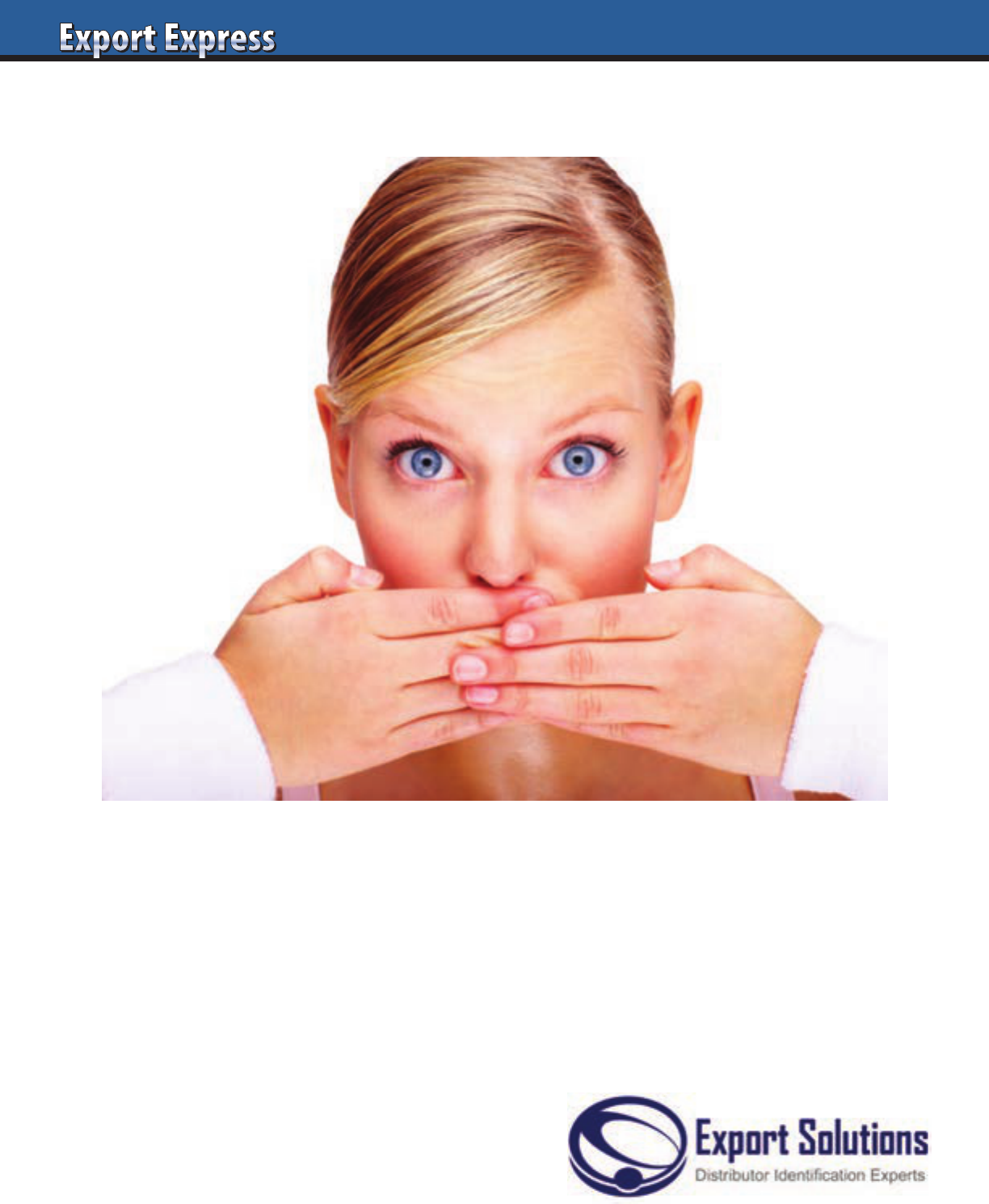
114
Don’t Tell Your Boss!
Finding qualified new distributors is tough! Export Solutions makes life a little
easier with our time saving distributor database.
• Coverage: 96 Countries. 9,200+ distributors of food, beverage, and snack
products. Includes 2,713 snack and 3,276 international food distributors.
• New: 1,397 worldwide distributors specializing in Italian Food products.
• Annual subscription to the database costs less than the price of one business trip.
• 3,000 brand owners and government trade organizations use Export Solutions’
database to “fill in the gaps” in their export coverage map.
“Spend time Selling to Distributors
versus Searching for Distributors”
www.exportsolutions.com

